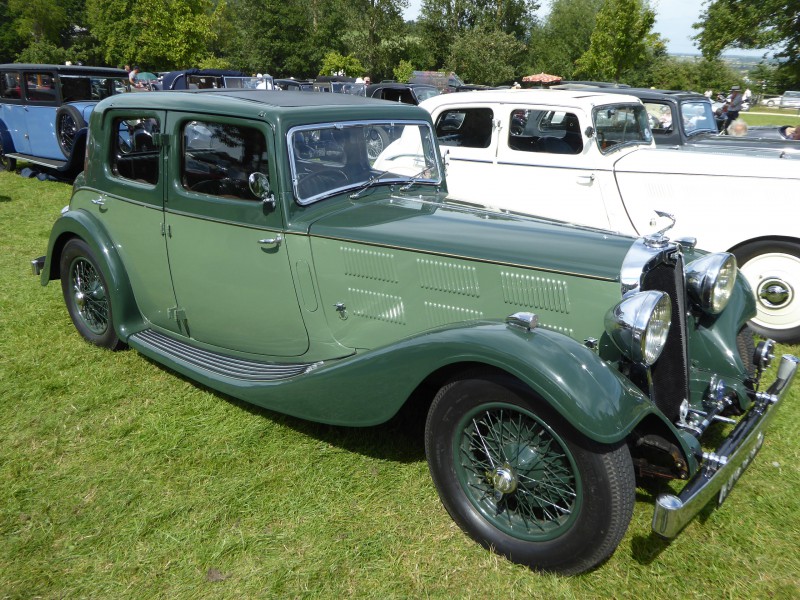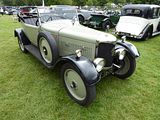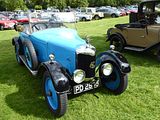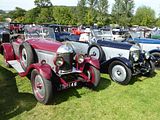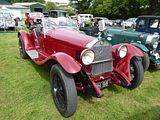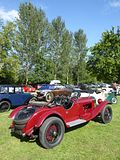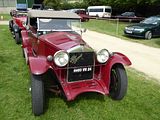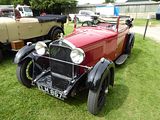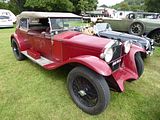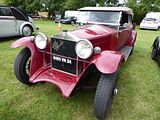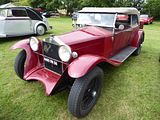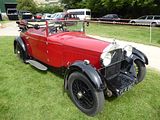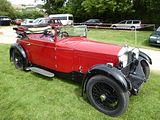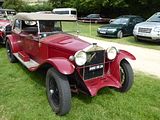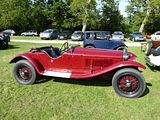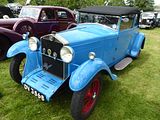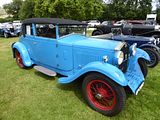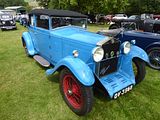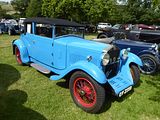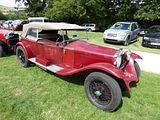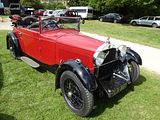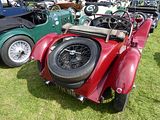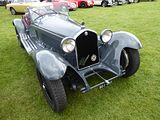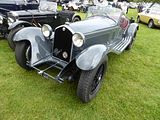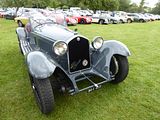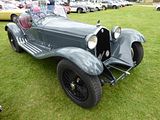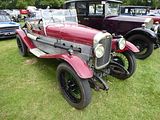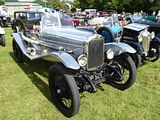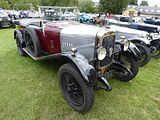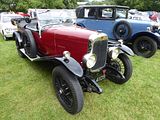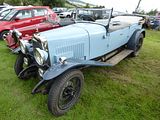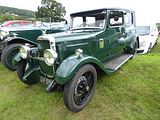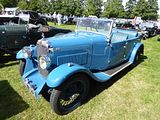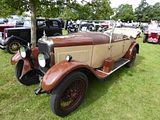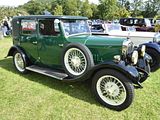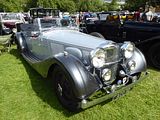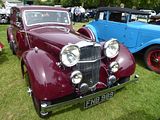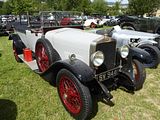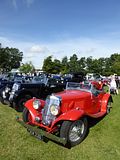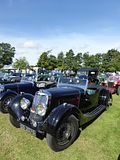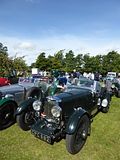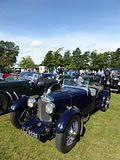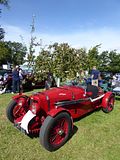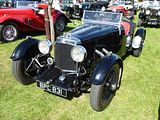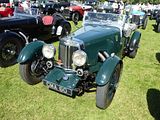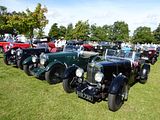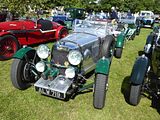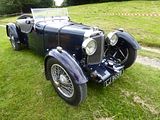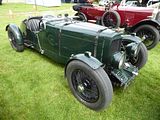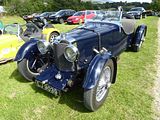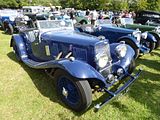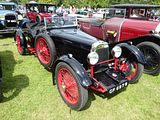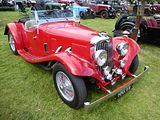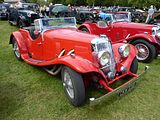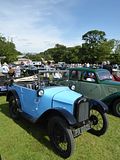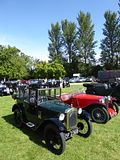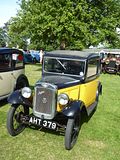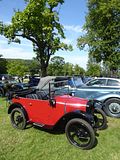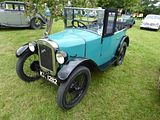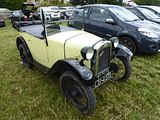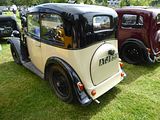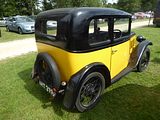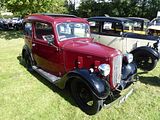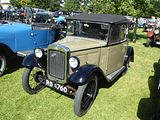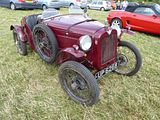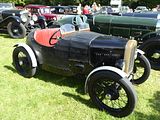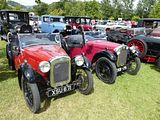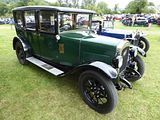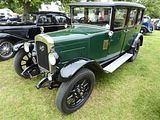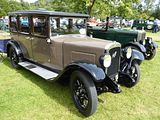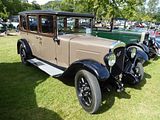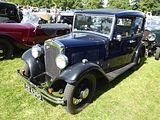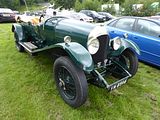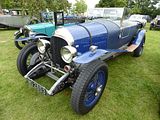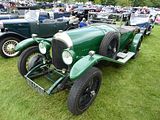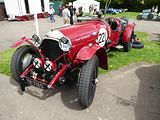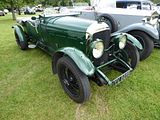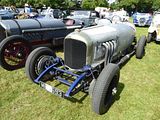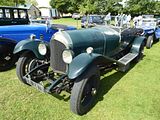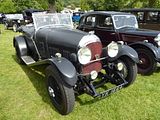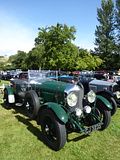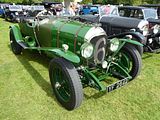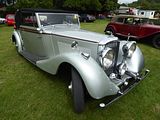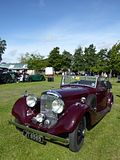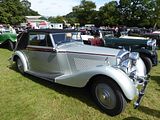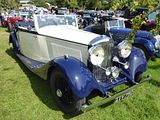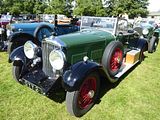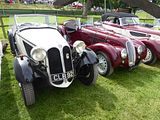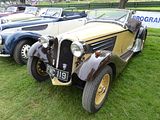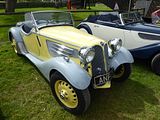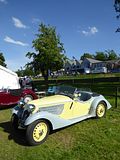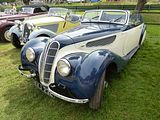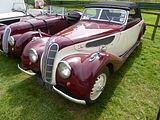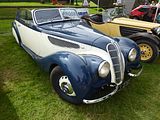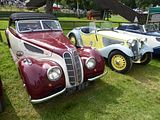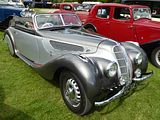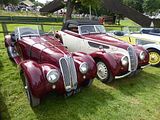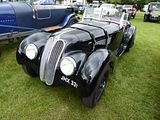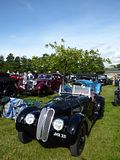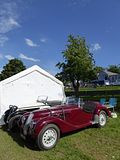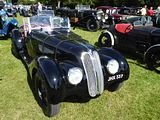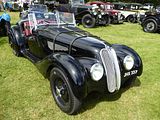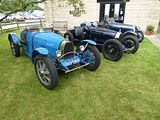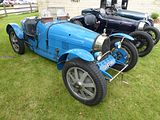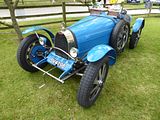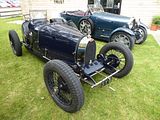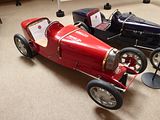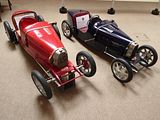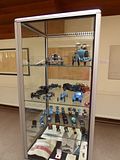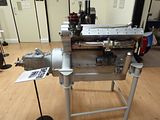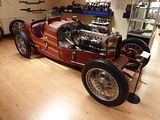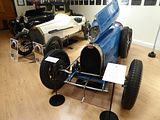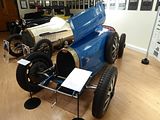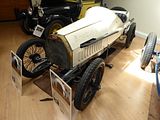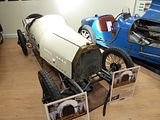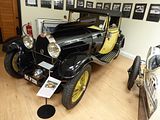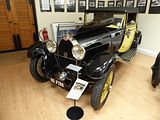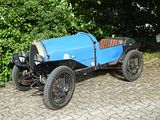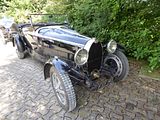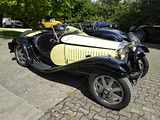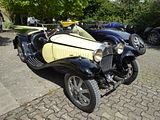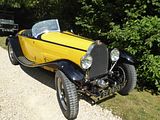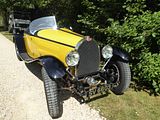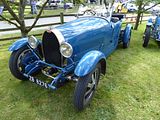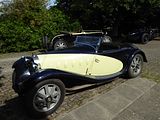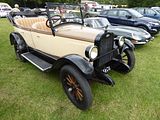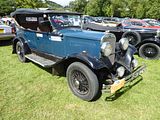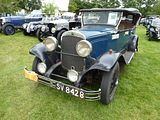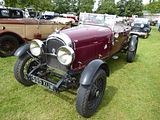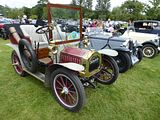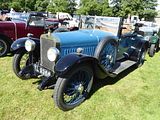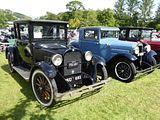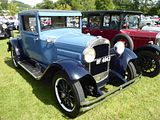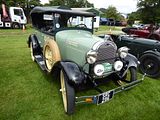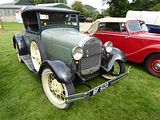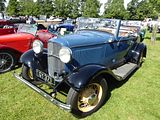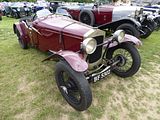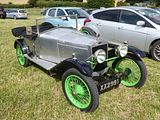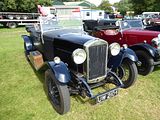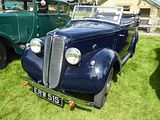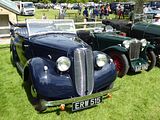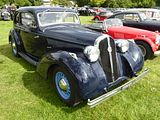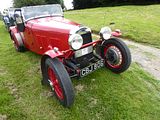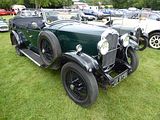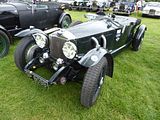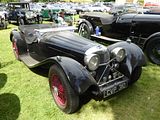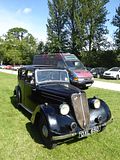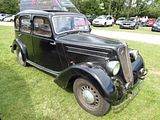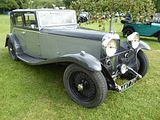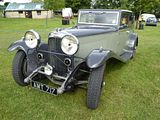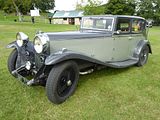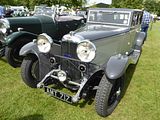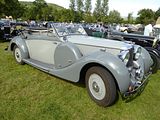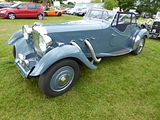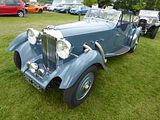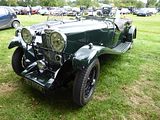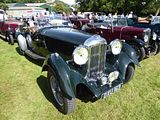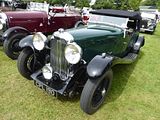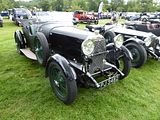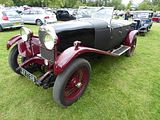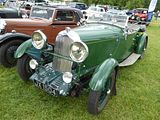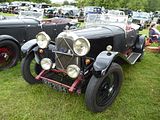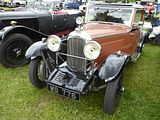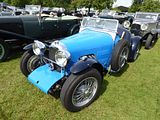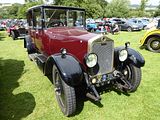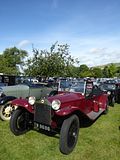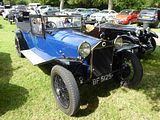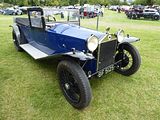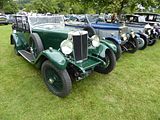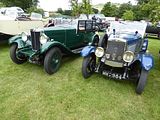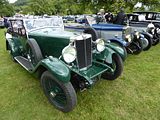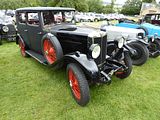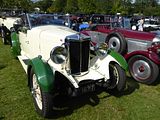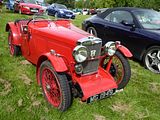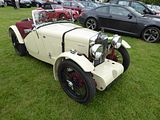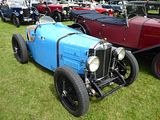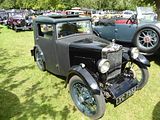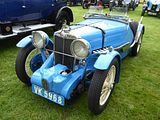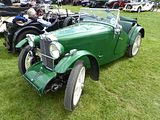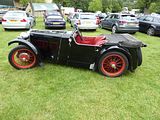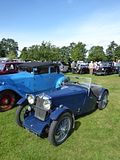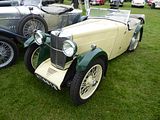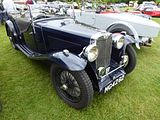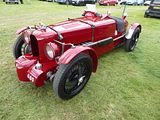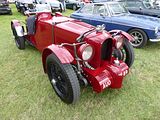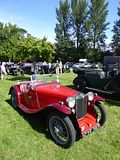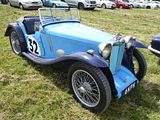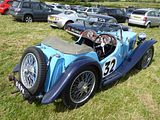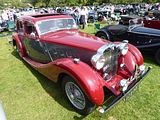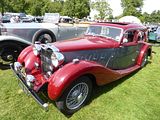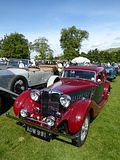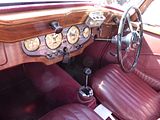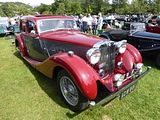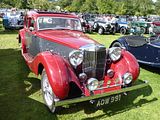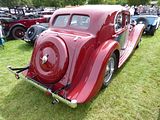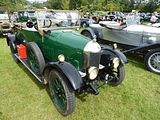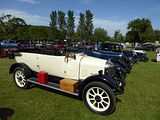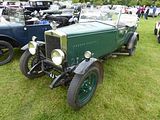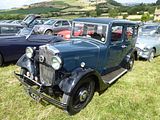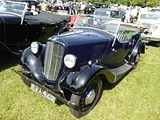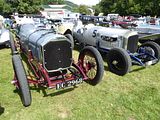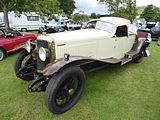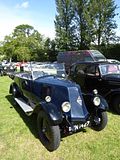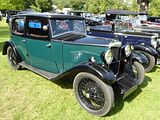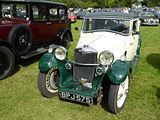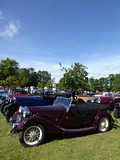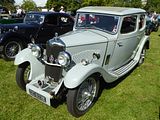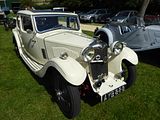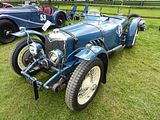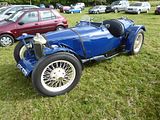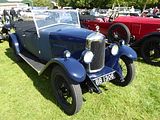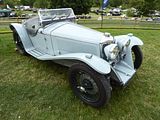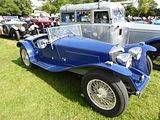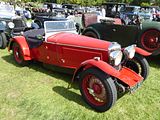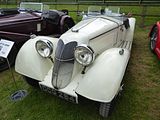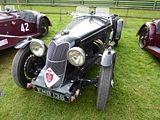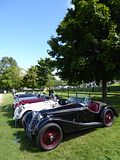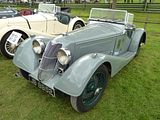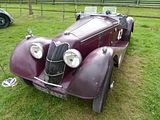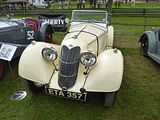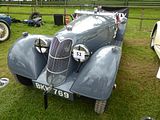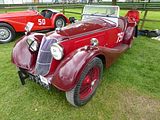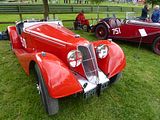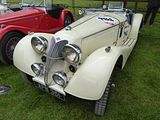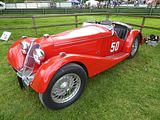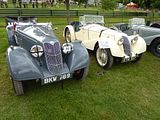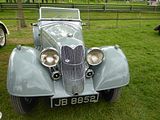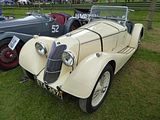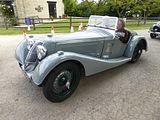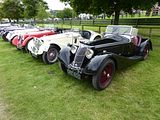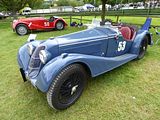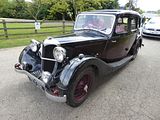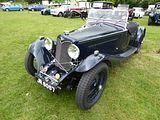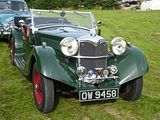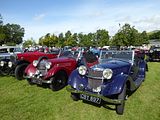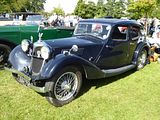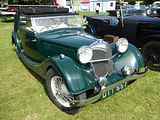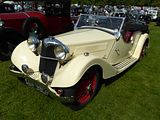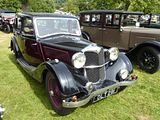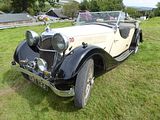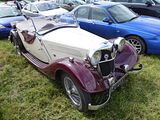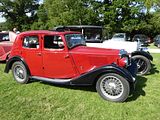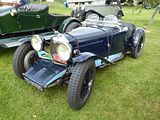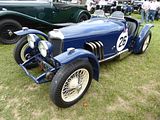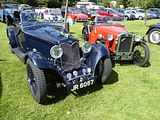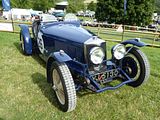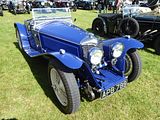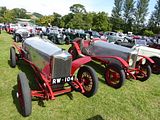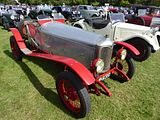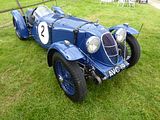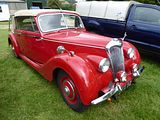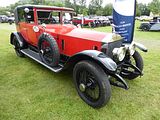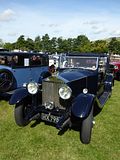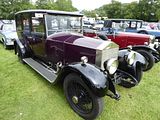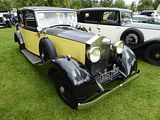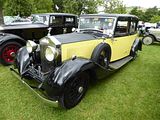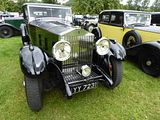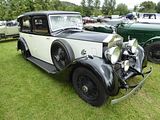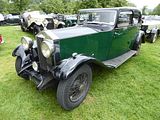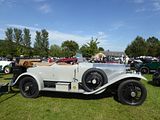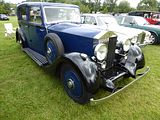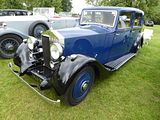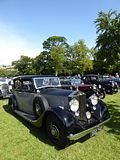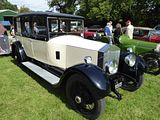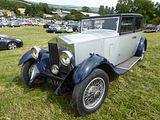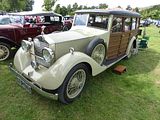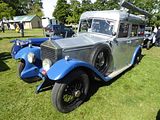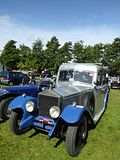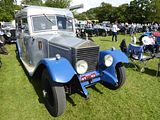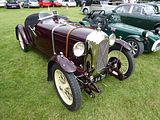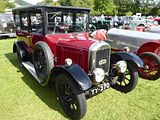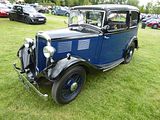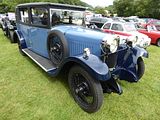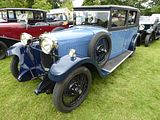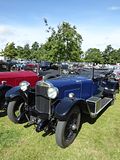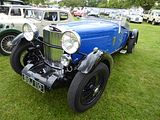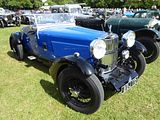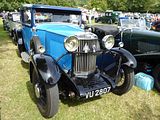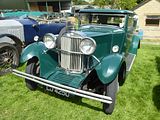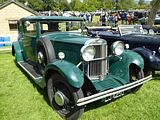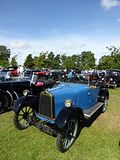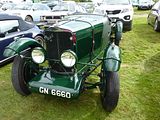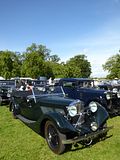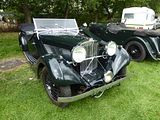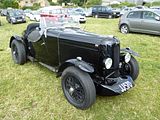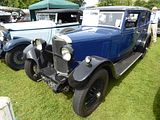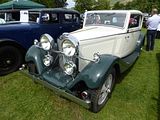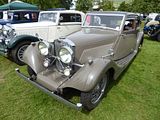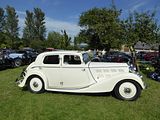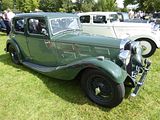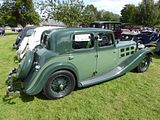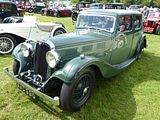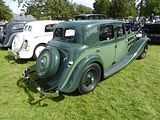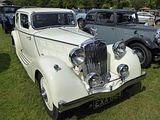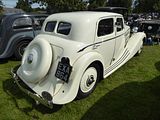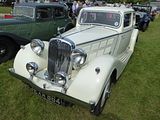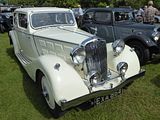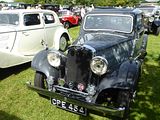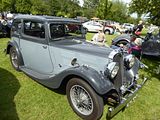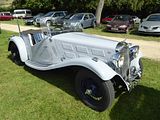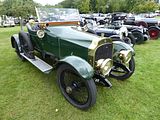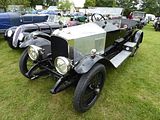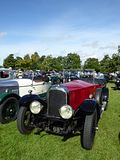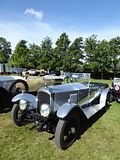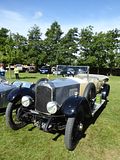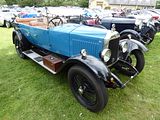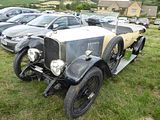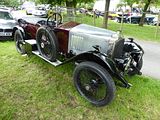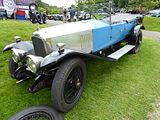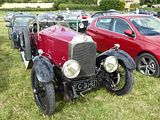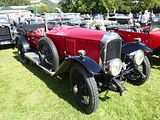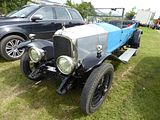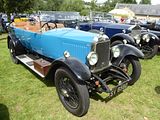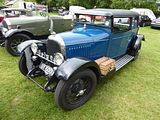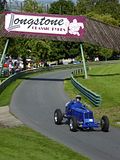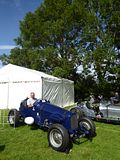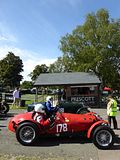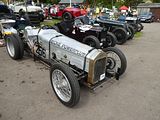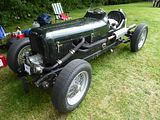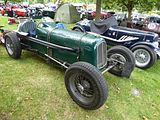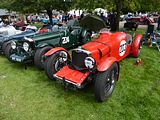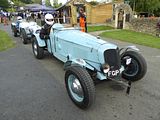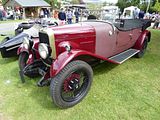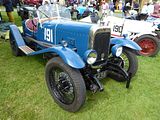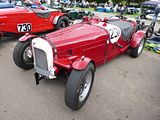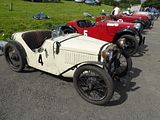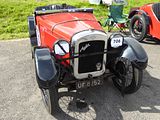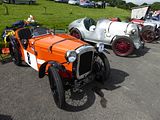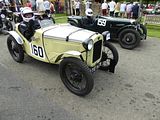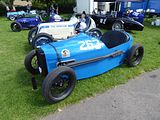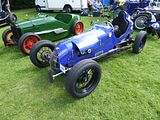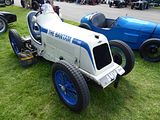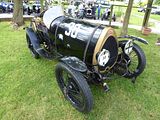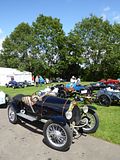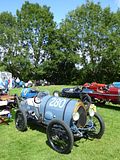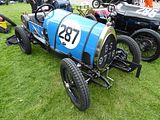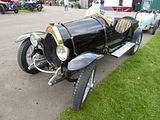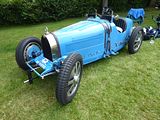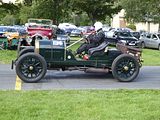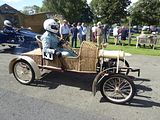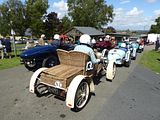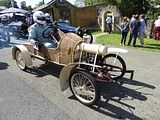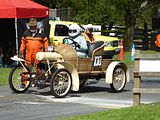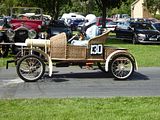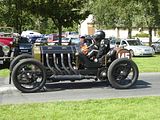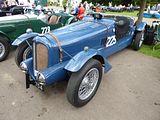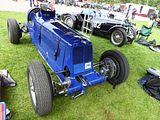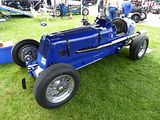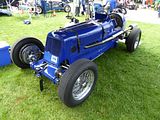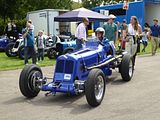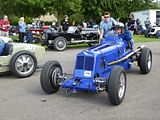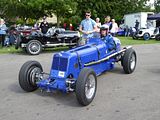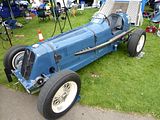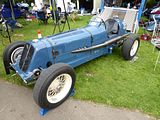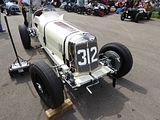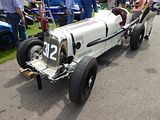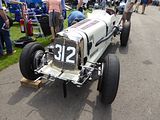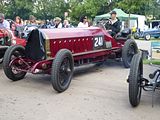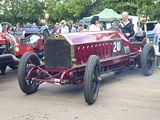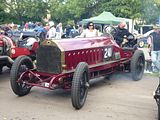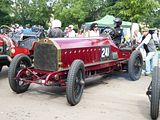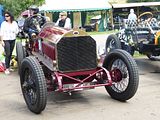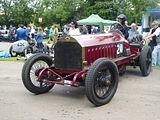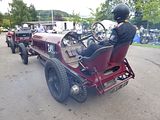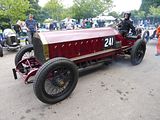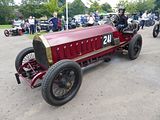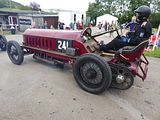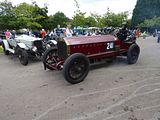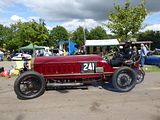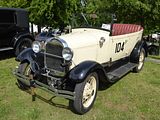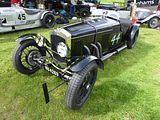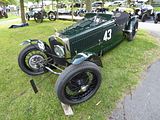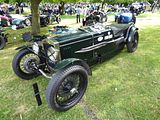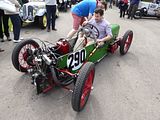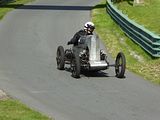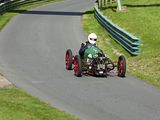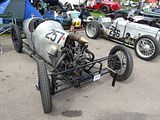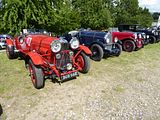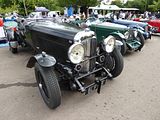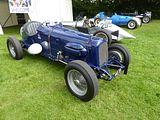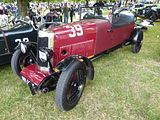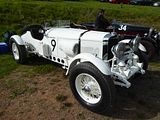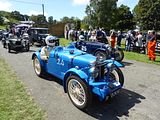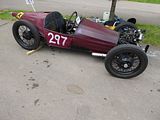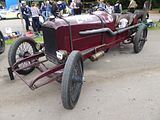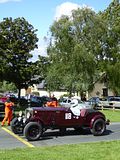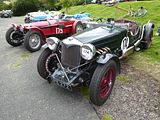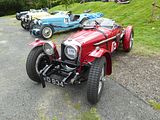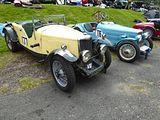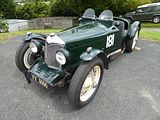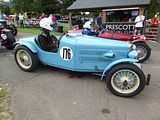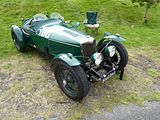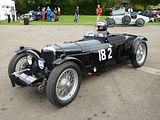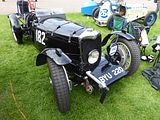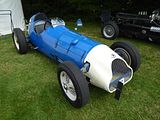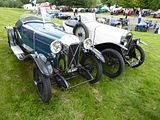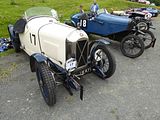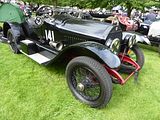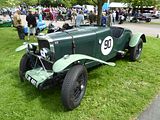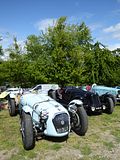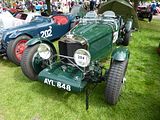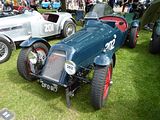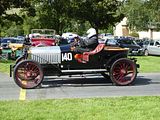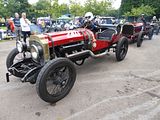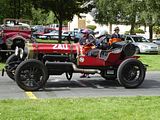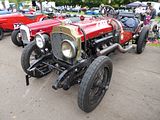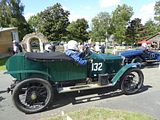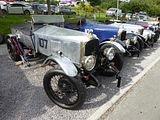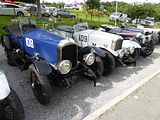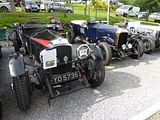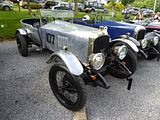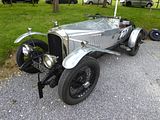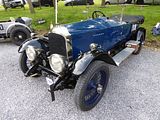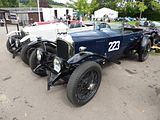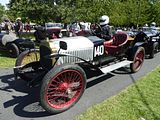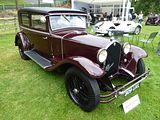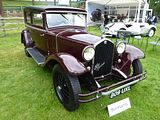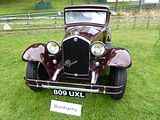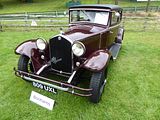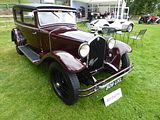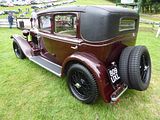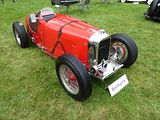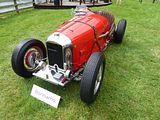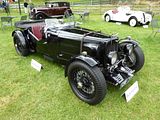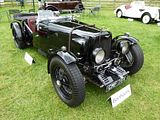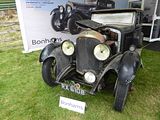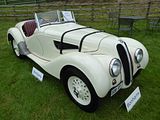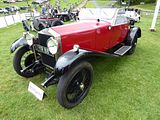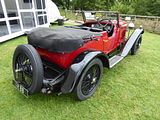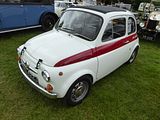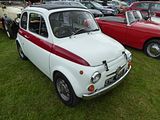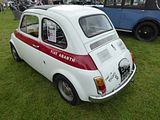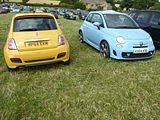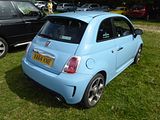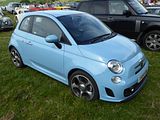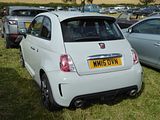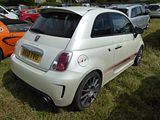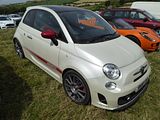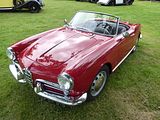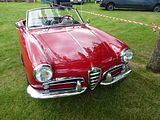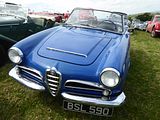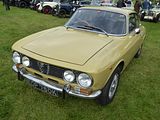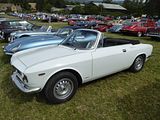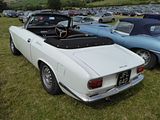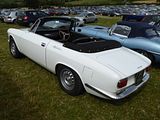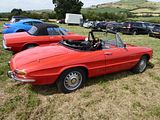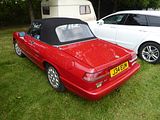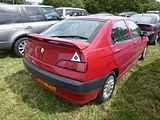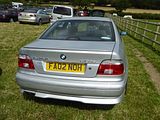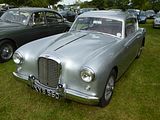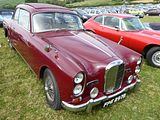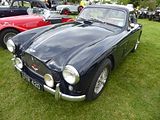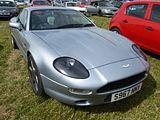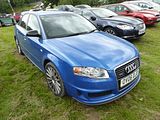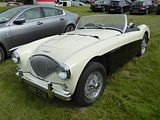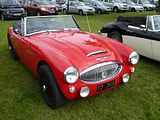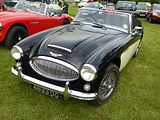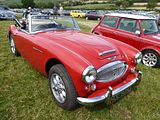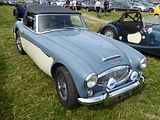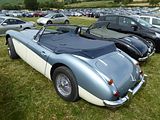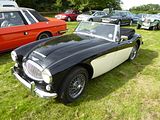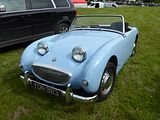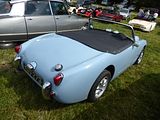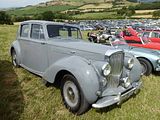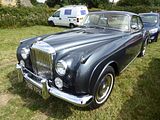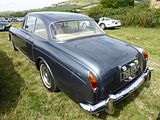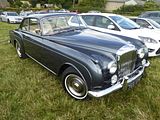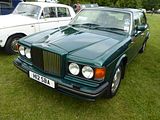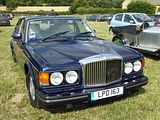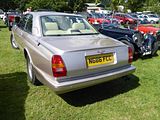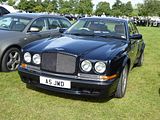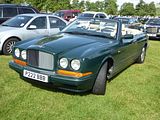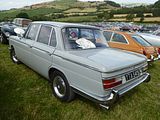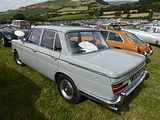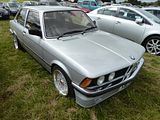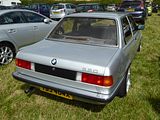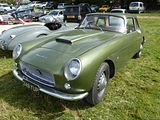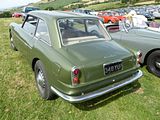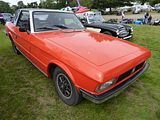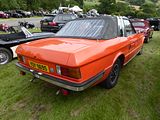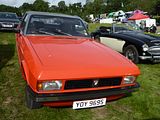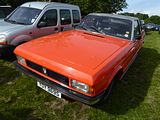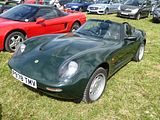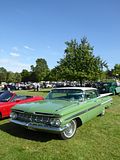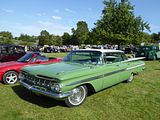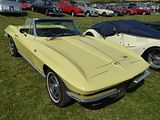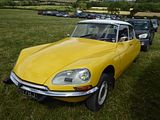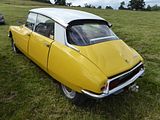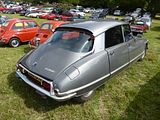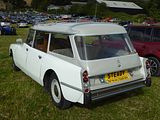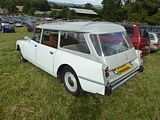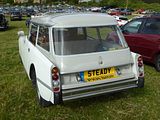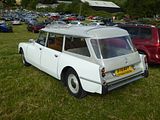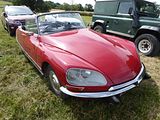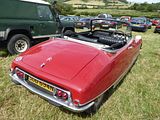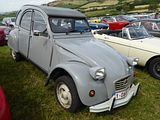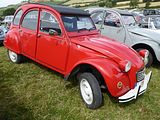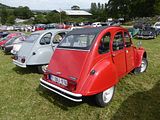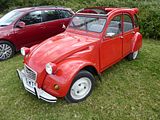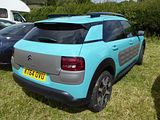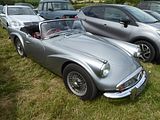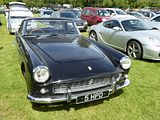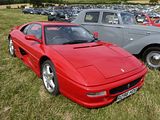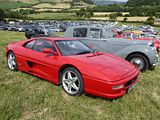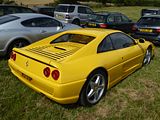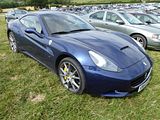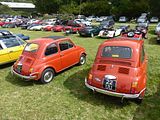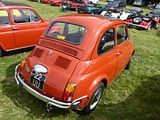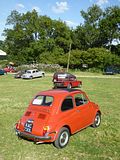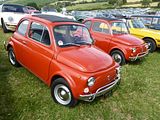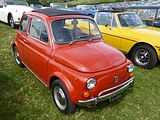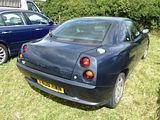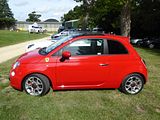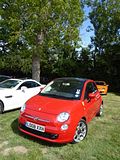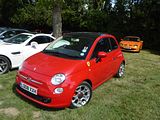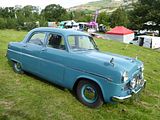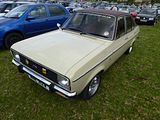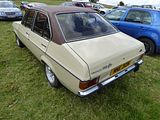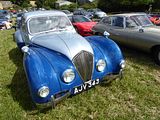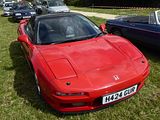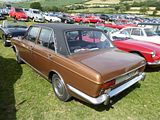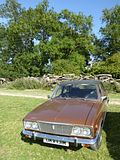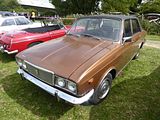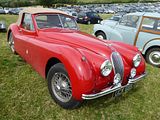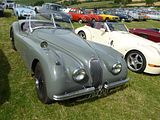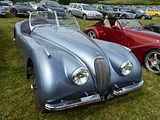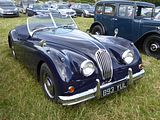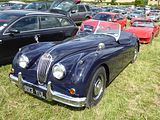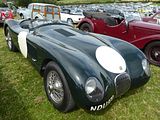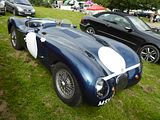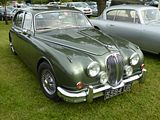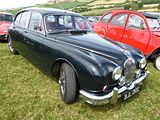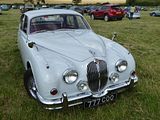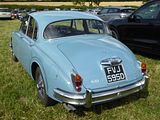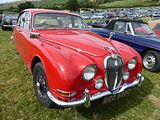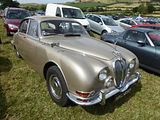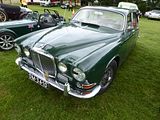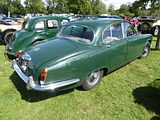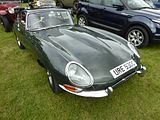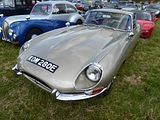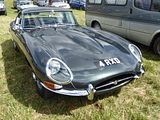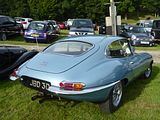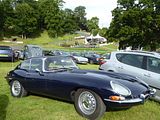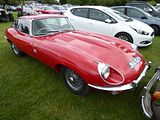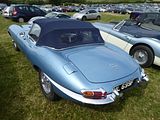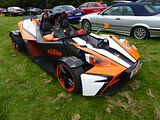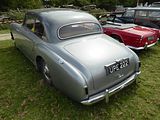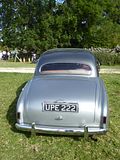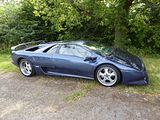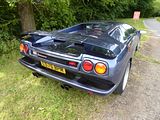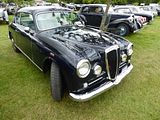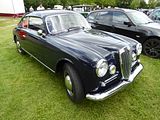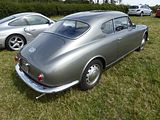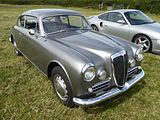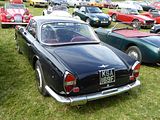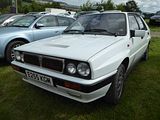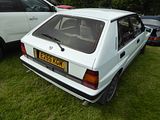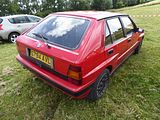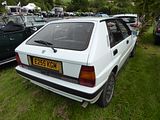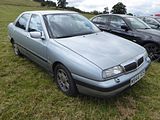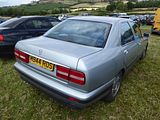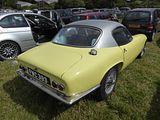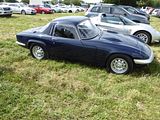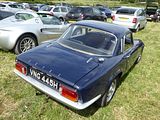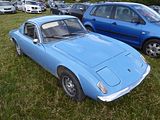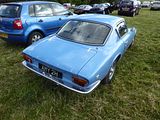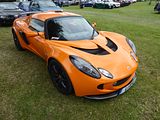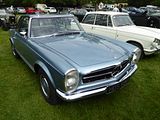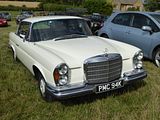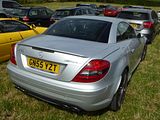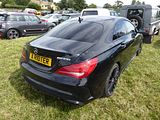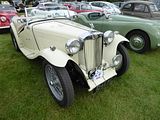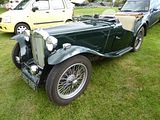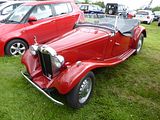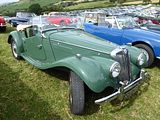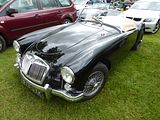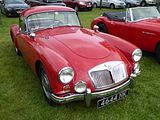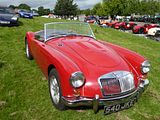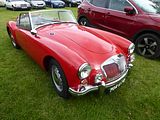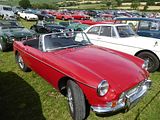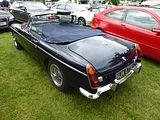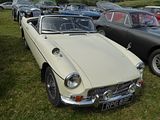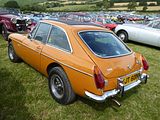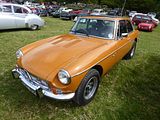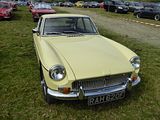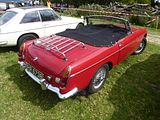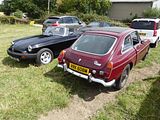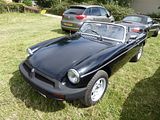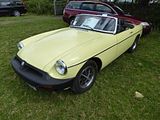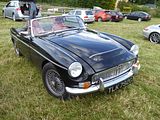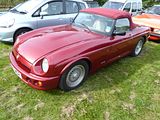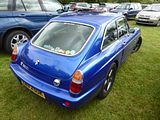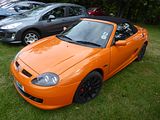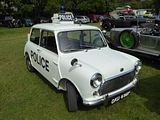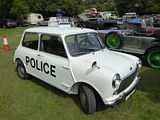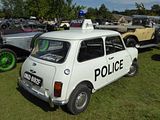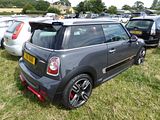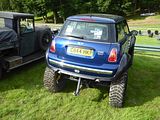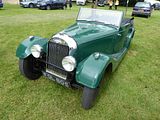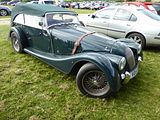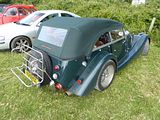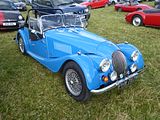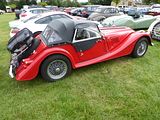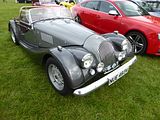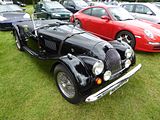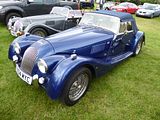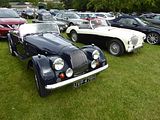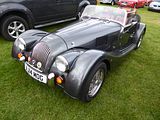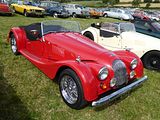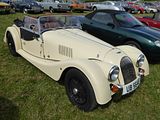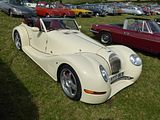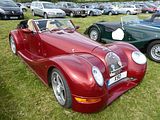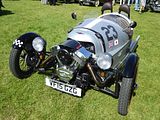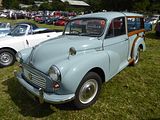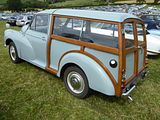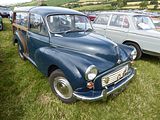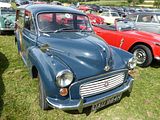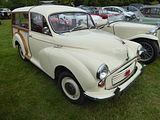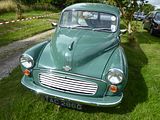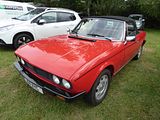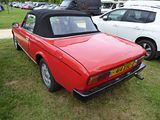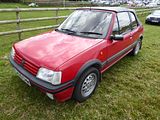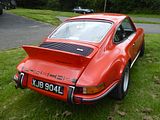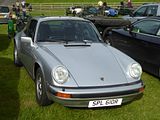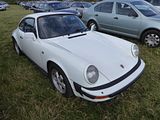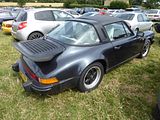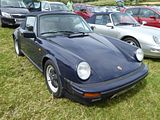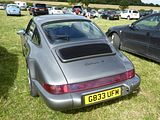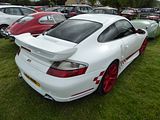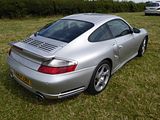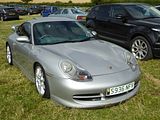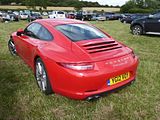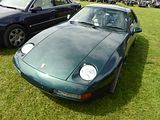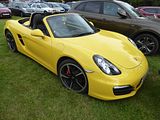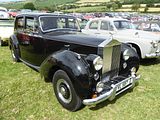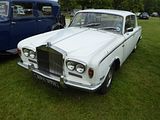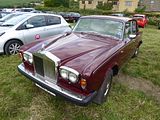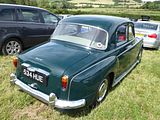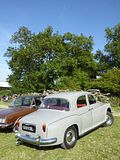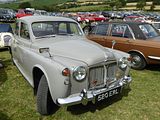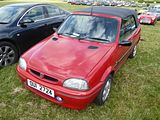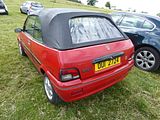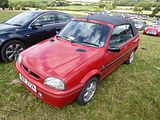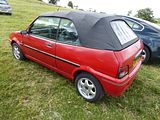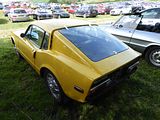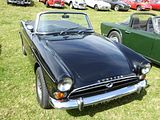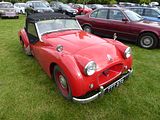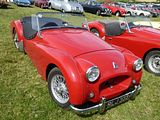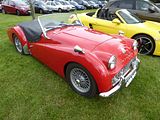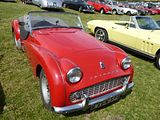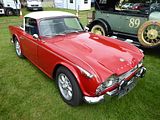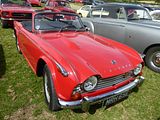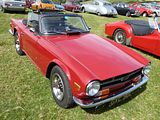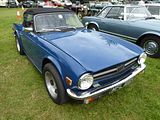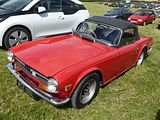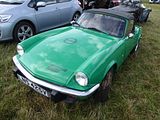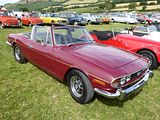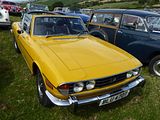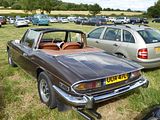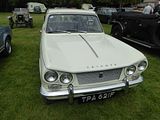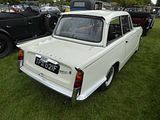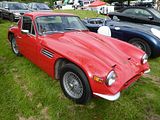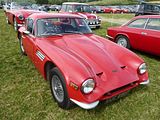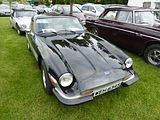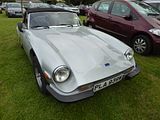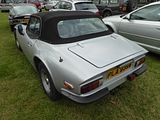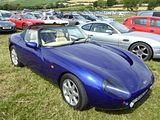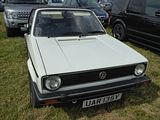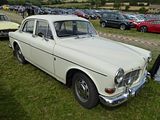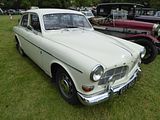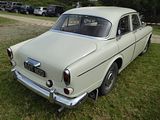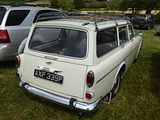Vintage and Veteran cars, generally defined as those made in the period up to 1939, can be seen at many an event in the UK, but usually only in relatively small numbers. If you want to see a lot of cars of this era, then you are well-advised to look out for one of the events organised by the VSCC (Vintage Sports Car Club), and from their extensive program that runs throughout the year, the very biggest gathering of the lot takes place at Prescott Hill, an iconic location on the edge of the Cotswolds, five or so miles north of Cheltenham. The VSCC was founded in 1934, and celebrated their 80th anniversary at their annual Prescott meeting last year, with a three-day event instead of the more usual weekend gathering, and it attracted both a huge number of pre-war cars and enthusiasts who came to see them parked up and in action. For 2015, the 72nd time that the VSCC has visited Prescott, the annual meet was back to being held over just two days, but once again, members turned out in vast numbers, with the Orchard almost completely filled by cars, the youngest of which was now 74 years old, as well as Paddock replete with cars of the same age lined up ready to compete on the hill, with well over 200 entrants. It’s one of my favourite events of the year, and unlike previous years when it has clashed with the Wilton House Supercars event, this time there was nothing else competing for my presence, so I was able to spend two whole days taking it all in. Here is what I so enjoyed.
PRE WAR DISPLAY CARS
On the Saturday, pre-war cars filled at least half of the Orchard, and on the Sunday, they filled it completely. And almost every single one arrived, having been driven to Prescott, from all over the country, as opposed to being trailered on site. Talking to some of the owners, it is clear that many had travelled significant distances, determined that they would both enjoy the drive and the chance of letting other people see their car, as well as taking advantage of the opportunity to catch up with old friends. And clearly, many of the owners have known each other for a very long time, judging by some of the conversations you hear. Some clearly come to see the cars and the hill climbing, but plenty of others treat this more as a social occasion, and the expansive picnics that they set up and enjoy over an extended lunchtime are clear evidence that it is the setting and the chance to see people that they only catch up with a few times, or even just once a year constitute reason enough to travel. Although many of the cars depicted here are ones I have seen in previous years at this event, there are plenty that do not feature in my photos from any of the past several years that I have been attending. There was a huge variety from familiar marques and models as well as some that were particularly rare and a few brands that required work with Google after the event to try to learn more about them.
AC
With a curved grille that is not unlike that of the better known Bullnose Morris, the AC 12hp of 1920 – 1927 was offered with 1.5 litre and 2 litre engines. Around 1800 were made. A couple of them were on show here.
ALFA ROMEO
It is always a pleasure to see classic Alfa models – among my favourite cars of all time – and there were several here. Among them was the fabulous 1929 6C 1750 Touring Zagato that Mike Hurst has owned for over 50 years, which he brings to plenty of events in the south west. It was joined by a car with a 4 door body and one with the less commonly seen James Young coachwork.
Joining them was this fabulous 1933 8C 2300 Corto Touring Spider, belonging to Paul Gregory. Heart of this car, which followed the 6 cylinder 6C 1750 cars, was its 8 cylinder engine, hence the 8C name. designed by Vittorio Jano, this straight 8 unit was Alfa Romeo’s primary racing engine from its introduction in 1931 to its retirement in 1939. In addition to the two-seater sports cars it was used in the world’s first genuine single-seat Grand Prix racing car, the Monoposto ‘Tipo B’ – P3 from 1932 onwards. In its later development it powered such vehicles as the twin-engined 1935 6.3-litre Bimotore, the 1935 3.8-litre Monoposto 8C 35 Type C, and the Alfa Romeo 8C 2900B Mille Miglia Roadster. It also powered top-of-the-range coach-built production models, including a Touring Spider and Touring Berlinetta. The 8C 2300 was the first model to use it, appearing in 1931. It enjoyed huge success racing. The 8C 2300 Spider, driven by Tazio Nuvolari won the 1931 and 1932 Targa Florio race in Sicily, the 1931 Italian Grand Prix victory at Monza gave the “Monza” name to the twin seater GP car, a shortened version of the Spider. The Alfa Romeo factory often added the name of events won to the name of a car. So, the 8C 2300 tipo Le Mans’ was the sport version of the ‘8C 2300’, with a super-charged engine. It had a successful debut in the 1931 Eireann Cup driven by Henry Birkin. It won the 24 Hours of Le Mans in 1931 (Howe-Birkin); 1932 (Chinetti-Sommer); 1933 (Nuvolari-Sommer) and 1934 (Chinetti-Etancelin). Initially, Alfa Romeo announced that the 8C was not to be sold to private owners, but by autumn 1931 Alfa sold it as a rolling chassis in Lungo (long) or Corto (short) form with prices starting at over £1000. The chassis were fitted with bodies from a selection of Italian coach-builders (Carrozzeria) such as Zagato, Carrozzeria Touring, Carrozzeria Castagna, Pininfarina and Brianza, even though Alfa Romeo did make bodies. Some chassis were clothed by coach-builders such as Graber, Worblaufen and Tuscher of Switzerland and Figoni of France. Alfa Romeo also had a practice of rebodying cars for clients, and some racing vehicles were sold rebodied as road vehicles. Some of the famous first owners include Baroness Maud Thyssen of the Thyssen family, the owner of the aircraft and now scooter company Piaggio Andrea Piaggio, Raymond Sommer, and Tazio Nuvolari. This car has quite some history as it has been a Diplomat’s super car and a playboy’s racer in it’s life and has been brought back to it’s former glory from an Arizona barn find box of bits. It was finished just ahead of and shown at the GRRC in September 2014. Born as a long-chassis cabriolet with body by Castagna it was powered by a supercharged 2.3-litre straight eight. It was owned by an Italian diplomat who took it to America with him, where it was sold to the playboy racer Tommy Lee. Subsequent owners weren’t respectful of its Italian power-plant, which was replaced with a Cadillac V8, generally destroying the car! It also had 400 holes drilled in the chassis to lighten it. The beautiful Alfa became a hybrid hot rod, not an uncommon fate in the US at the time. It was subsequently hidden away in shed in Tucson, Arizona, until a chance “˜barn find” by an American enthusiast who stripped out all the original Alfa parts. He was just about to pass them over to renowned Alfa specialist Jim Stokes in Waterlooville for restoration when the American owner was shot dead by his janitor! Paul bought the parts and had them shipped over to Jim, who commenced rebuilding and restoring it in 2011. According to the GRRC website, Paul had had Alfas for years but had always hankered after an 8C, all that held him back was the cost. This project was the only affordable way according to Paul. The car has been recreated as a replica of a Touring of Milan-bodied open tourer 8C“ not how chassis 229 began it’s life, but period correct. Paul ensured its accuracy by photographing and carefully measuring an original Touring-bodied 8C in Italy. It is not a matching numbers car. as it has a Jim Stokes engine (the original is in an 8C in Australia), the body has been made in Britain and the chassis holes are now filled, but with the weld marks showing, to preserve the history of this car. As a Jim Stokes car (a world leading 8C engineer) the car has a fascinating story, great quality with a great exhaust note. It is indeed a very special thing. And the best thing is that Paul uses it wherever possible, and had taken it to numerous events since completion of the rebuild. Fabulous!
ALVIS
Earliest of the Alvis models here – and there were lots – were the 12/50, a popular light car from the 1920s.
There were several later Alvis models, too, including an SA20.
ANSALDO
1923 6A Torpedo
ASTON MARTIN
There was a great collection of Aston-Martin models from the 1930s, with the International, le Mans, Mark II and 15/98 all on show, many of them grouped together to make an interesting display.
There was also a rather earlier model here.
AUSTIN
There were, unsurprisingly, plenty of examples of the Austin Seven, ranging from early cars to some of the various different versions produced right throughout the 1930s.
Slightly confusingly, the Six was a much larger car, as it was named after the number of cylinders rather than the horsepower, unlike the car that was branded Seven which was so named because of its HP rating. The Austin Twelve was introduced in 1921. It was the second of Herbert Austin’s post World War I models and was in many ways a scaled-down version of his Austin Twenty, introduced in 1919. The slower than expected sales of the Twenty brought about this divergence from his intended one-model policy. The Twelve was announced at the beginning of November 1921 after Austin’s company had been in receivership for six months. Twelve refers to its fiscal horse power (12.8) rather than its bhp which was 20 and later 27. The long-stroke engines encouraged by the tax regime, 72 x 102 later 72 x 114.5, had much greater low-speed torque than the bhp rating suggests. Initially available as a tourer, by 1922 three body styles were offered: the four-seat tourer, the two/four-seater (both at £550) and the coupé at £675. The car enjoyed success throughout the vintage era with annual sales peaking at 14,000 in 1927. While the mechanical specification changed little (the engine increased from 1661 cc to 1861 cc in 1926), many body styles were offered with saloons becoming more popular as the twenties drew to a close. The car continued in the Austin catalogue and as a taxi option until 1939. The last cars were produced for the War Department in 1940. After the early thirties the car was referred to by the public as the Heavy Twelve to distinguish it from the other, newer, 12HP cars in the Austin catalogue Light Twelve-Four, Light Twelve-Six etc. and received some updating. The artillery style wheels were replaced by wire wheels in 1933 and coil ignition replaced the magneto in 1935. The gearbox was provided with synchromesh between its top two ratios in 1934. The factory catalogued body range was steadily updated with the last of the no longer fashionable Weymann style fabric-covered cars in 1931 and no open tourers after 1934.
There was also a 1934 Ten here, a model which Austin had launched in 1932, to plug the gap between the diminutive Seven and the larger Twelve models in their range which had been updated in early 1931. The Ten became the marque’s best seller and was produced, in a number of different versions through to 1947. A number of improvements were made to the car in the months following launch, but it was for 1937 when the first really big change came about with the launch of the almost streamlined Cambridge saloon and Conway cabriolet. Compared with the preceding cars, the passengers and engine were positioned much further forward, the back seat now being rather forward of the back axle. There were six side windows like the Sherborne and the quarter lights were fixed. Again like the Sherborne the forward doors opened rearwards. At the back there was now a compartment large enough to take a trunk as well as more luggage on the open compartment door when it was let down. A new smoother single plate spring-drive clutch was now fitted, the two friction rings carried by the centre plate were held apart by leaf springs. Other changes included Girling brakes with wedge and roller shoe expansion and balance lever compensation using operating rods in tension with automatic compensation between front and rear brakes all four of which might be applied by hand or foot. Drums were now 9 inches diameter. 16-inch steel disc wheels replaced the 18-inch wires Top speed from the 1141cc engine rose to 60 miles per hour.
BENTLEY
Oldest of the models present were a number of the 3 and 4.5 litre cars that were produced in the 1920s and which epitomise the classic Bentley to many people. The 3 Litre was the company’s first model, first shown in 1919 and made available to customers’ coachbuilders from 1921 to 1929. It was conceived for racing. The Bentley was very much larger than the 1368 cc Bugattis that dominated racing at the time, but double the size of engine and strength compensated for the extra weight. The 4000 lb (1800 kg) car won the 24 Hours of Le Mans in 1924, with drivers John Duff and Frank Clement, and again in 1927, this time in Super Sports form, with drivers S. C. H. “Sammy” Davis and Dudley Benjafield. Its weight, size, and speed prompted Ettore Bugatti to call it “the fastest lorry in the world.” The 3 Litre was delivered as a running chassis to the coachbuilder of the buyer’s choice. Bentley referred many customers to their near neighbour Vanden Plas for bodies. Dealers might order a short cost-saving run of identical bodies to their own distinctive design. Most bodies took the simplest and cheapest form, tourers, but as it was all “custom” coachwork there was plenty of variation. The 2,996 cc straight-4 engine was designed by ex-Royal Flying Corps engineer Clive Gallop and was technically very advanced for its time. It was one of the first production car engines with 4 valves per cylinder, dry-sump lubrication and an overhead camshaft. The four valve SOHC Hemi design, with a bevel-geared shaft drive for the camshaft, was based on the pre-war 1914 Mercedes Daimler M93654 racing engine. Just before the outbreak of the war Mercedes had placed one of the winning Grand Prix cars in their London showroom in Long Acre. At the suggestion of W.O. Bentley, then being commissioned in the Royal Naval Air Service, the vehicle was confiscated in 1915 by the British army, dismantled at Rolls-Royce and subjected to scrutiny. A notable difference to both the Mercedes and the aero engines was the cast-iron monobloc design, and the fully Aluminium enclosed camshaft, which greatly contributed to its durability. But having the valve-head and block in one-piece made for a complicated and labour intensive casting and machining. This was a feature shared during that time by the Bugattis which the car was later to compete with. The engine was also among the first with two spark plugs per cylinder, pent-roof combustion chambers, and twin carburettors. It was extremely undersquare, optimised for low-end torque, with a bore of 80 mm and a stroke of 149 mm. Untuned power output was around 70 hp, allowing the 3 Litre to reach 80 mph. he Speed Model could reach 90 mph; the Super Sports could exceed 100 mph. A four-speed gearbox was fitted. Only the rear wheels had brakes until 1924, when four-wheel brakes were introduced. There were three main variants of the 3 litre and they became known by the colours commonly used on the radiator badge. There was a definite rule controlling badge colours but astonishingly it has since been established that given “special circumstances” the factory would indeed supply a “wrong” colour. Blue label was the standard model with 117.5 in wheelbase from 1921 to 1929 or long 130.0 in wheelbase from 1923 to 1929. The Red label used a 5.3:1 high compression engine in the 117.5 in wheelbase chassis and was made from 1924 to 1929. The Green label was made between 1924 and 1929 and was the high performance model with 6.3:1 compression ratio and short 108 in wheelbase chassis. 100 mph performance was guaranteed. As well as 3 Experimental cars, Bentley produced 1088 examples of the 3 litre, and the Speed Model numbered 513 and there were 18 Super Sports.
Bentley replaced the 3 Litre with a more powerful car by increasing its engine displacement to 4.5 litres. As before, Bentley supplied an engine and chassis and it was up to the buyer to arrange for their new chassis to be fitted with one of a number of body styles, most of which were saloons or tourers. Very few have survived with their four-seater coachwork intact. WO Bentley had found that success in motorsport was great publicity for the brand, and he was particularly attracted to the 2 Hours of Le Mans endurance race, the inaugural running of which took place 26–27 May 1923, attracting many drivers, mostly French. There were two foreign competitors in the first race, Frank Clement and Canadian John Duff, the latter winning the 1924 competition in his personal car, a Bentley 3 Litre. This success helped Bentley sell cars, but was not repeated, so after two years without success, Bentley convened a group of wealthy British men, “united by their love of insouciance, elegant tailoring, and a need for speed,” to renew Bentley’s success. Both drivers and mechanics, these men, later nicknamed the “Bentley Boys”, drove Bentley automobiles to victory in several races between 1927 and 1931, including four consecutive wins at the 24 Hours of Le Mans, and forged the brands reputation. It was within this context that, in 1927, Bentley developed the Bentley 4½ Litre. Two cylinders were removed from the 6½ Litre model, reducing the displacement to 4.4 litres. At the time, the 3 Litre and the 6½ Litre were already available, but the 3 Litre was an outdated, under-powered model and the 6½ Litre’s image was tarnished by poor tyre performance. Sir Henry “Tim” Birkin, described as “the greatest British driver of his day” by W. O. Bentley, was one of the Bentley Boys. He refused to adhere strictly to Bentley’s assertion that increasing displacement is always preferable to forced induction. Birkin, aided by a former Bentley mechanic, decided to produce a series of five supercharged models for the competition at the 24 Hours of Le Mans; thus the 4½ litre Blower Bentley was born. The first supercharged Bentley had been a 3-litre FR5189 which had been supercharged at the Cricklewood factory in the winter of 1926/7. The Bentley Blower No.1 was officially presented in 1929 at the British International Motor Show at Olympia, London. The 55 copies were built to comply with 24 Hours of Le Mans regulations. Birkin arranged for the construction of the supercharged cars having received approval from Bentley chairman and majority shareholder Woolf Barnato and financing from wealthy horse racing enthusiast Dorothy Paget. Development and construction of the supercharged Bentleys was done in a workshop in Welwyn by Amherst Villiers, who also provided the superchargers. W.O. Bentley was hostile to forced induction and believed that “to supercharge a Bentley engine was to pervert its design and corrupt its performance.” However, having lost control of the company he founded to Barnato, he could not halt Birkin’s project. Although the Bentley 4½ Litre was heavy, weighing 1,625 kg (3,583 lb), and spacious, with a length of 172 in and a wheelbase of 130.0 in, it remained well-balanced and steered nimbly. The manual transmission, however, required skill, as its four gears were unsynchronised. The robustness of the 4½ Litre’s latticed chassis, made of steel and reinforced with ties, was needed to support the heavy cast iron inline-four engine. The engine was “resolutely modern” for the time. The displacement was 4,398 cc. Two SU carburettors and dual ignition with Bosch magnetos were fitted. The engine produced 110 hp for the touring model and 130 hp for the racing model. The engine speed was limited to 4,000 rpm. A single overhead camshaft actuated four valves per cylinder, inclined at 30 degrees. This was a technically advanced design at a time where most cars used only two valves per cylinder. The camshaft was driven by bevel gears on a vertical shaft at the front of the engine, as on the 3 Litre engine. The essential difference between the Bentley 4½ Litre and the Blower was the addition of a Roots-type supercharger to the Blower engine by engineer Amherst Villiers, who had also produced the supercharger. W. O. Bentley, as chief engineer of the company he had founded, refused to allow the engine to be modified to incorporate the supercharger. As a result, the supercharger was placed at the end of the crankshaft, in front of the radiator. This gave the Blower Bentley an easily recognisable appearance and also increased the car’s understeer due to the additional weight at the front. A guard protected the two carburettors located at the compressor intake. Similar protection was used, both in the 4½ Litre and the Blower, for the fuel tank at the rear, because a flying stone punctured the 3 Litre of Frank Clement and John Duff during the first 24 Hours of Le Mans, which contributed to their defeat. The crankshaft, pistons and lubrication system were special to the Blower engine. It produced 175 hp at 3,500 rpm for the touring model and 240 hp at 4,200 rpm for the racing version, which was more power than the Bentley 6½ Litre developed. Between 1927 and 1931 the Bentley 4½ Litre competed in several competitions, primarily the 24 Hours of Le Mans. The first was the Old Mother Gun at the 1927 24 Hours of Le Mans, driven as a prototype before production. Favoured to win, it instead crashed and did not finish. Its performance was sufficient for Bentley to decide to start production and deliver the first models the same year. Far from being the most powerful in the competitions, the 4½ Litre of Woolf Barnato and Bernard Rubin, raced neck and neck against Charles Weymann’s Stutz Blackhawk DV16, setting a new record average speed of 69 mph; Tim Birkin and Jean Chassagne finished fifth. The next year, three 4½ Litres finished second, third, and fourth behind another Bentley, the Speed Six, which possessed two more cylinders.The naturally aspirated 4½ Litre was noted for its good reliability. The supercharged models were not; the two Blower models entered in the 1930 24 Hours of Le Mans by Dorothy Paget, one of which was co-driven by Tim Birkin, did not complete the race. In 1930, Birkin finished second in the French Grand Prix at the Circuit de Pau behind a Bugatti Type 35. Ettore Bugatti, annoyed by the performance of Bentley, called the 4½ Litre the “fastest lorry in the world.” The Type 35 is much lighter and consumes much less petrol. Blower Bentleys consume 4 litres per minute at full speed. In November 1931, after selling 720 copies of the 4½ Litre – 655 naturally aspirated and 55 supercharged – in three different models (Tourer, Drophead Coupé and Sporting Four Seater, Bentley was forced to sell his company to Rolls-Royce for £125,175, a victim of the recession that hit Europe following the Wall Street Crash of 1929.
There were a number of examples of what are known as the “Derby” models. These were produced after the acquisition of Bentley by Rolls-Royce, in 1934, at which point the focus of the brand shifted to the production of large and elegant tourers. The cars retained the famous curved radiator shape based on earlier Bentley models, but in all meaningful respects they were clearly Rolls-Royces. Although disappointing some traditional customers, they were well received by many others and even W.O. Bentley himself was reported as saying that he would “rather own this Bentley than any other car produced under that name.” The Rolls-Royce Engineer in charge of the development project, Ernest Hives (later Lord Hives), underlined the Rolls-Royce modus operandi in a memo addressed to company staff “our recommendation is that we should make the car as good as we know how and then charge accordingly.” At a time when the Ford 8 could be purchased new for £100, an early Bentley 3½ Litre cost around £1,500 (equivalent to £6400 vs. £96,000 today), putting it beyond the reach of all but the wealthiest consumers. Despite not being a car of remarkable outright performance, the car’s unique blend of style and grace proved popular with the inter-war elite and it was advertised under the legend the silent sports car. Over 70% of the cars built between 1933 and 1939 were said to have still been in existence 70 years later. Although chassis production ceased in 1939, a number of cars were still being bodied and delivered during 1940. The last few were delivered and first registered in 1941. The 3.5 litre came first. Based on an experimental Rolls-Royce project “Peregrine” which was to have had a supercharged 2¾ litre engine, the 3½ Litre was finally fitted with a less adventurous engine developed from Rolls’ straight-6 fitted to the Rolls-Royce 20/25. The Bentley variant featured a higher compression ratio, sportier camshaft profile and two SU carburettors on a crossflow cylinder head. Actual power output was roughly 110 bhp at 4500 rpm, allowing the car to reach 90 mph. The engine displaced 3669 cc with a 82.5 mm bore and 114.3 mm stroke. A 4-speed manual transmission with synchromesh on 3rd and 4th, 4-wheel leaf spring suspension, and 4-wheel servo-assisted mechanical brakes were all common with other Rolls-Royce models. The chassis was manufactured from nickel steel, and featured a “double-dropped” layout to gain vertical space for the axles and thus keep the profiles of the cars low. The strong chassis needed no diagonal cross-bracing, and was very light in comparison to the chassis built by its contemporary competitors, weighing in at 2,510 pounds (1,140 kg) in driveable form ready for delivery to the customer’s chosen coachbuilder. 1177 of the 3½ Litre cars were built, with about half of them being bodied by Park Ward, with the remainder “dressed” by other coachbuilders like Barker, Carlton, Freestone & Webb, Gurney Nutting, Hooper, Mann Egerton, Mulliner (both Arthur and H J), Rippon, Thrupp & Maberly, James Young, Vanden Plas and Windovers in England; Figoni et Falaschi, Kellner, Saoutchik and Vanvooren in Paris; and smaller concerns elsewhere in UK and Europe. Beginning in March, 1936, a 4¼ Litre version of the car was offered as replacement for the 3½ Litre, in order to offset the increasing weight of coachwork and maintain the car’s sporting image in the face of stiff competition. The engine was bored to 3½ in (88.9 mm) for a total of 4257cc. From 1938 the MR and MX series cars featured Marles steering and an overdrive gearbox. The model was replaced in 1939 by the MkV, but some cars were still finished and delivered during 1940-1941. 1234 4¼ Litre cars were built, with Park Ward remaining the most popular coachbuilder. Many cars were bodied in steel rather than the previous, more expensive, aluminium over ash frame construction.
Special
BMW
On the Sunday, there was a very impressive display put on by the Historic BMW Car Club. No doubt the inspiration for this was the fact the Club had attended this event in 2014, in celebration of 80 years of the agreement which saw BMW’s marketed and sold in the UK by Frazer Nash. It was popular, both among owners and attendees, so the same space was allocated again, and whilst there were not quite as many cars present in 2015 as there had been the year before, there was still an interesting assembly of historic Frazer-Nash BMWs. Frazer Nash was, of course, a marque in its own right, making small chain driven sports cars, with proprietary engines which enjoyed much sporting success, including the prestigious Coupe des Alpes. By the mid 1930s, though, their design with beam axles and a channel section chassis was limiting their performance. Things came to a head in 1934, when immediately after their cars were beaten in the 1934 Coupe des Alpes by a trio of BMW 315 2 seaters, the then Company owner, manager and works driver, HJ Aldington, went straight to the BMW factory in Munich to negotiate the importation of right hand drive versions of the cars which had defeated his own. An agreement was struck and announced in December 1934 for the cars to be called Frazer Nash BMWs. Aldington brought back a 315 two seater sports cars to the UK, still in left hand drive form. Registered BMP844, this was one of the actual Alpine Trial Team cars. Many more 315s and the outwardly similar 319s would follow, and several of these were on show.
Although it was the 2 seater sports 315 that had piqued HJ Aldington’s interest, there were plenty of other models in the range, which, ironically, had grown largely as a result of the Bavarian company making British cars under licence, with the Austin Seven based Dixi some years earlier. The first right hand drive cars that came in were the 315 and 319 saloon models, These looked the same and were supplied with a mix of 1.5 and 2.0 litre engines, some with two and some with three carburettors, all with iron heads and vertical valves.
By this time production of the chain driven Frazer Nash cars had ceased as the advantages of BMW’s design were indisputable, with outstanding ride and road holding for their day. This was thanks to a stiff tubular chassis, independent front suspension and rack and pinion steering. The early cars – 315, 319 and 329 – had cable brakes and a 6 volt electrical system. Later models had a box chassis with semi-elliptic rear springs. Many of the early cars had aluminium panels over ash frames, but later cars would have all steel bodies. All had the benefit of a foot operated one-shot chassis oil lubrication system. The cars were very advanced compared to what else was on the market at the time, but they were expensive. Even so, more than 700 cars were brought into the UK before the Second World War. During the 1930s, new models continued to be added to the range, with the 326 Saloon and the 327/80 drophead coupe being particularly stylish. Around 60 cars came to the UK in chassis form and were bodied by various English coachbuilders, in particular Abbots of Farnham, Whittingham & Webb with a 326 Saloon by Freestone & Webb and a 320 Saloon by Midland Motor Bodies. These English bodies came in both open and closed versions. A 326 with Freestone & Webb body was present in this display along with a couple of regular 326 saloons and several of the 327/80 Cabriolets.
Also here was the 328, a sports car made between 1936 and 1940, with the body design credited to Peter Szymanowski, who became BMW chief of design after World War II (although technically the car was designed by Fritz Fiedler). It had a 1971cc straight 6 OHV engine and 3 solec carburettors which gave it an output of 79 bhp at 5000 rpm, and a top speed of 150 km/h, making this relatively light car ideal for motorsport. The 328 was introduced at the Eifelrennen race at the Nürburgring in 1936, where Ernst Henne drove it to win the 2.0 litre class. The 328 had more than 100 class wins in 1937, including the RAC Tourist Trophy, the Österreichische Alpenfahrt, and the La Turbie hillclimb. In 1938, the 328 won its class at Le Mans, the RAC Tourist Trophy, the Alpine Rally, and the Mille Miglia. The 328 won the RAC Rally in 1939 and came in fifth overall and first in class in the 1939 24 Hours of Le Mans. The car continued its competition career after the war, with Frank Pratt winning the 1948 Australian Grand Prix driving a 328.
Also to be seen was a 319 which I come across at almost every Prescott meet which was the Longstone tyres facility having new rubber fitted.
BUGATTI
Prescott is the home to the Bugatti Owners Club, and there is a fabulous museum on site which contains all manner of things, ranging from complete cars, to engines, as well as drawings and other historical documents. Parked up outside, on the Saturday were a trio of Types 35, 37 and 43.
On show inside were a couple of the Type 52, these were small half scale Bugatti Type 35 electric racing cars, made for children. About 90 examples were produced at the Molsheim factory between 1927 and 1936, and the cars were frequently used both as playthings and for more serious racing among the children of the European elite. The number 52 was probably given by the late Hugh Conway and was never used by the factory. The factory always referred to the car as Baby. The first example of a Type 52 was built for Ettore’s son, five-year-old Roland, and was first shown at an exhibition in Milan. The Type 52 was powered by a single 12 volt electric motor with front and reverse. Braking was done by way of expanding wooden shoes at the front and rear drums. The car was originally just 1200 mm (47.2 in) between the wheels, but this was expanded to 1350 mm (53.1 in) when it was found that even children had difficulty with leg room. The car was about 1800mm long overall with a 625 mm (24.6 in) track width. In previous years, a whole number of these have been assembled and there was even a race along part of the track, but this time, they were purely a static exhibit indoors.
There were plenty of other interesting displays of Bugatti’s history in the museum.
Three cars were contained inside: a Type 37, a 15, and the car known as the “Lydia” Type 40.
Type 13 Brescia
There were plenty more Bugatti models on show on the Sunday including the Types 44 and 46.
CHEVROLET
This is a 1926 Chevrolet Superior. The Superior was launched in 1923, manufactured by Chevrolet for four years with a different series per year. The 1923 model was known as the Series B, the 1924 model was the Series F, for 1925 it was known as the Series K and the 1926 Superior was known as the Series V. It was replaced in 1927 by the Series AA Capitol. All Superior models were powered by a 2.8 litre 4-cylinder engine generating 26 hp @ 2000 rpm, and shared the 103 in wheelbase. The cheapest complete model, which was the Superior Roadster, cost $510 in 1926, while the range-topping model, the Superior Sedan, sold for $825. It was also possible to buy a chassis; the Commercial chassis cost $425, while the Express Truck chassis cost $525. This chassis was shared with other GM products at the time, including Cadillac, Buick, Oldsmobile, Oakland and GMC products, introducing the “A-body”, “B-body” and “C-body”. This policy of sharing mechanicals across multiple brand led to the General Motors Companion Make Program in the 1920s. Starting with leadership under Mr. Sloan, GM instituted visual styling changes for each yearly series.
CHRYSLER
This 1928 4.1 litre has had an interesting life, having competed in the Paris to Peking rally.
This 1929 Chrysler 75 B6-70, first registered in the UK in 1949
CITROEN
1934 saw the introduction of the Rosalie’s mould-shattering successor, the front-wheel-drive semi-monocoque Citroën Traction Avant. The Traction endured a troubled and prolonged birth process, however, and was part of an ambitious investment programme which involved, also in 1934, the bankruptcy of the business, and its acquisition by Citroën’s principal creditor. The patron himself died in 1935. In this troubled situation, availability of the larger Rosalies (although re-engined with a turned-around version of the new Traction’s OHV four-cylinder engines) continued till 1938: it is only through the distorting prism of subsequent events that its reputation has been diminished when set against the technical brilliance of its successor. There were three examples of the Traction Avant here. Produced for over 20 years, many different versions were made during that time, all with the same styling outline, but with power outputs ranging from 7 to 15CV, and different wheelbases, as well as some with Coupe and Convertible body styles. There was even one model with a large opening tailgate, the Commerciale. The only one to be seen here this time was an 11CV Traction Avant Cabriolet.
DE DION
De Dion-Bouton was a French automobile and railcar manufacturer operating from 1883 to 1932. The company was founded in 1881 by the Marquis Jules-Albert de Dion, Georges Bouton, and Bouton’s brother-in-law Charles Trépardoux after De Dion saw a toy locomotive in a store window and asked the toymakers to build another. Engineers Bouton and Trépardoux had been making a starvation living on scientific toys at a shop in the Passage de Léon, close to the “rue de la Chapelle” in Paris. Trépardoux had long dreamed of building a steam car, but neither could afford it. De Dion, already inspired by steam, though in the form of rail locomotives, and with plenty of money, agreed, and De Dion, Bouton et Trépardoux was formed in Paris in 1883. This became the De Dion-Bouton automobile company, the world’s largest automobile manufacturer for a time, becoming well known for their quality, reliability, and durability. Before 1883 was over they had set up shop in larger premises in the Passage de Léon, Paris, tried and dropped steam engines for boats, and produced a steam car. With the boiler and engine mounted at the front, driving the front wheels by belts and steering with the rear, it burned to the ground on trials. They built a second, La Marquise, the next year, with a more conventional steering and rear-wheel drive, capable of seating four. The Marquis de Dion entered one of these in an 1887 trial, “Europe’s first motoring competition”, the brainchild of one M. Fossier of cycling magazine Le Vélocipède. Evidently, the promotion was insufficient, for the De Dion was the sole entrant, but it completed the course, with de Dion at the tiller, and was clocked at 60 km/h (37 mph). This must be taken with considerable care; the first official land speed record, set in 1898, was 63.15 km/h (39.24 mph). The vehicle survives, in road-worthy condition, and has been a regular entry in the London to Brighton Veteran Car Run. Following this singular success, the company offered steam tricycles with boilers between the front wheels and two-cylinder engines. They were built in small numbers, evidently a favourite of young playboys, before being joined by a larger tractor, able to pull trailers (what has been called a “steam drag”). This larger vehicle introduced the so-called De Dion or “dead” axle; an axle beam carried the weight of the vehicle with the non weight-bearing driveshafts or drive chains articulated separately alongside it.(footnote: The live axle carries the weight by a rigid tube around the driveshaft, both parts fastened together.) On July 22,1894, Paris–Rouen race, it averaged 18.7 km/h (11.6 mph) over the 126 km (78 mi) route, but was disqualified for needing both a driver and a stoker. Two more cars were made in 1885 followed by a series of lightweight two-cylinder tricars, which from 1892 had Michelin pneumatic tyres. In 1893, steam tractors were introduced which were designed to tow horse type carriages for passengers or freight (sometimes called “steam drags”) and these used an innovative axle design which would become known as the De Dion tube,where the location and drive function of the axle are separated. The company manufactured steam buses and trucks until 1904. Trepardoux, staunchly supporting steam, resigned in 1894 as the company turned to internal combustion vehicles.The steam car remained in production more or less unchanged for ten years more.Already by 1889, de Dion was becoming convinced the future lay in the internal combustion engine, and the company had even built a ten-cylinder two-row rotary. After Trépardoux resigned in 1894, the company became De Dion, Bouton et Compagnie. For 1895, Bouton created a new 137 cc one-cylinder engine with trembler coil ignition. Proving troublesome at its designed speed of 900 rpm (throwing bearings and running rough),when Bouton increased the revs, the problems vanished; in trials, it hit an unheard of 3500 rpm, and was usually run at 2,000 rpm, a limit imposed by its atmospheric valves and surface carburettor. Both inlet and exhaust valves were overhead and a flywheel was fitted to each end of the crankshaft. This engine was fitted behind the rear axle of a tricycle frame bought in from Decauville, fitted with the new Michelin pneumatic tyres. It showed superb performance, and went on the market in 1896 with the engine enlarged to 1¼ CV 185 cc, with 1¾ CV in 1897. By the time production of the petite voiture tricar stopped in 1901, it had 2¾ CV, while racers had as much as 8 CV, In 1898, Louis Renault had a De Dion-Bouton modified with fixed drive shaft and ring and pinion gear, making “perhaps the first hot rod in history”. The same year, the tricar was joined by a four-wheeler and in 1900 by a vis a vis voiturette, the Model D, with its 3¾ CV 402 cc single-cylinder engine under the seat and drive to the rear wheels through a two-speed gearbox. This curious design had the passenger facing the driver, who sat in the rear seat. The voiturette had one inestimable advantage: the expanding clutches of the gearbox were operated by a lever on the steering column. The Model D was developed through Models E, G, I, and J, with 6 CV by 1902, when the 8 CV Model K rear-entry phaeton appeared, with front-end styling resembling the contemporary Renault. Until World War I, De Dion-Boutons had an unusual decelerator pedal which reduced engine speed and ultimately applied a transmission brake. In 1902, the Model O introduced three speeds, which was standard for all De Dion-Boutons in 1904. A small number of electric cars were also made in 1901. In 1900, De Dion-Bouton was the largest automobile manufacturer in the world, producing 400 cars and 3,200 engines. The company soon began producing engines and licences for other automobile companies with an estimate of 150 makes using them. Production was so great, it proved impossible to test every engine; if it failed on the bench, it was simply disassembled. Every engine was being made by hand; the assembly line had not yet been introduced. By 1904 some 40,000 engines had been supplied across Europe. That year, De Dion-Bouton’s factory at Quai National (now Quai de Dion-Bouton), Puteaux, employed 1,300 and produced more than 2,000 cars, all also by hand. The engine moved to the front in 1903 in the Populaire with 700 or 942 cc engines, the latter being powerful enough to allow trucks to be added to cars, and by the end of the year reverse gear had also appeared. It was joined by the 6 CV 864 cc Types N and Q (the latter a low-priced K), the 8 CV R, and their first multi-cylinder model, the two-cylinder 1728 cc 12CV S, followed in 1904 by the four-cylinder 2,545 cc 15 CV Type AD and 24 CV AI. The cars were also getting more and more conventional in styling, with the radiator moving in front of the engine and the clutch changing from hand lever to pedal. A pair of works 10 CV De Dion-Boutons, in the hands of Cormier and Collignon, ran in the 1907 Peking to Paris rally, without success. Bouvier St. Chaffray did no better in the New York to Paris in 1908. That year, De Dion-Bouton peaked as a manufacturer. The company became the first to make a successful mass-produced V8 engine, a 35 CV 6,107 cc CJ in 1910, followed by a 7.8 litre and a 14.7 litre for the U.S., as well as by a 3,534 cc Type CN in 1912. (They trailed Ader in racing the 1906 Adams, which used an Antoinette aircraft engine.) This would be the company’s last innovation. During World War I the company made gun parts, armoured vehicles, and aircraft engines, as well as cars and trucks. The company produced an anti-aircraft version of the French 75mm field gun, the Canon de 75 modèle 1897, mounted on a V8-powered De Dion-Bouton truck for the French Army between 1913 and 1918. In Dublin during the Easter Rising of 1916, which opened the Irish War of Independence, The O’Rahilly drove his De Dion Bouton up to the Irish HQ in O’Connell Street, and, discovering that the Rising he had planned and trained soldiers for and then tried to prevent, was actually going on, he drove it into a barricade, walked into the GPO and said: “I’ve helped to wind the clock, I’ve come to hear it strike.” He was killed in a heroic charge against a machine gun nest in Moore Street days later. A famous photograph shows the skeleton of the car in its barricade. The company stagnated after World War I. The V8 continued to appear until 1923, and in spite of new models with front-wheel brakes, the factory closed for much of 1927. On reopening two models were listed, the Type LA with a 1,982 cc 4 cylinder overhead valve, aluminium-piston engine, and the Type LB with a 2,496 cc -8. The latter was very expensive and sales were few, despite growth to 3 litres in 1930. A rumoured takeover by Peugeot or Mercedes did not materialise, leading to the end of passenger car production in 1932. Small numbers of commercial vehicles were made until 1950; the last vehicles to carry the De Dion badge were licence-made Land Rovers in the early 1950s. The company name was bought by a motorcycle maker in 1955.
DELAGE
A 1925 Delage DISS, a six cylinder sports-luxury car.
ESSEX
A marque that many will never have heard of, there were a couple of their cars here, one of them a 1929 Essex Super Six Coupe, and the black one, a Two Door Sedan. First set up in 1918, the Essex was to be a product of the “Essex Motor Company,” which actually was a wholly owned entity of Hudson’s. Essex Motors went so far as to lease the Studebaker auto factory in Detroit for production of the car. By 1922 the Essex Motor Company was dissolved and the Essex officially became what it was all along, a product of Hudson, with production continuing until 1933. Essex cars were designed to be moderately priced, affordable to the average family. Proving durable, their capabilities were checked upon and confirmed by AAA and the United States Postal Service. In 1919 an Essex completed a 50-hour, 3,037.4 miles endurance test in Cincinnati, Ohio, at an average speed of 60.75 miles per hour. The early Essex cars also captured many hill climb records. In a special Essex race car, Glen Shultz won the 1923 Pikes Peak Hill Climb. Initially Essex marketed a line of touring cars (open four-door cars with canvas tops), which was the most popular body style of cars in production at the time. While Essex added an enclosed sedan in 1920, it was the introduction of the 1922 closed coach, priced at $1,495 , $300 above that of the touring car. By 1925 the coach was priced below that of the touring car. While Henry Ford is credited with inventing the affordable car, it was Essex that made the enclosed car affordable. In 1928, the big news was the use of four-wheel mechanical brakes. Essex boasted “piano hinge doors” which were exceptionally strong. An advertisement shows a man fully supported by an open door to demonstrate the strength of the hinge. By 1929, the Essex was third in U.S. sales, behind Ford and Chevrolet.. Essex sales remained strong into 1931 before sales began to trend downward. For 1932 a redesigned Essex debuted and was named the Essex-Terraplane, a play on the word aeroplane. For 1934 the Essex name was no more and the car carried on as the Terraplane.
FORD
Ford did eventually replace the long-running Model T with an all new model. To emphasise the fact that it was a new-beginning for the company, they called it Model A. It was introduced in 1927, and was produced for 5 years, with a vast array of different body styles, and several of them were to be seen here.
In an effort to offer something that none of their competitors were doing, Ford made real waves when they announced that the replacement for the Model A would be available with a V8 engine. Rather than call it the Model B. it was known, rather imaginatively as the V8. This is a V8 2 door Tourer.
FRAZER NASH
There were plenty of Frazer-Nash cars here.
HILLMAN
This one, a Fourteen, dates from 1929. In the early 1920s Hillman had concentrated on smaller cars with the 10 and 11 hp models but with their 14 horsepower car they entered the larger sized class taking on the Austin 12 hp and Humber 14/40. The new Hillman was priced at £345 for the saloon, undercutting the Austin which sold for £455, it was advertised as “the car that costs less than it should”. It was produced between 1925 and 1930 and around 11,000 were built.
A more familiar model name is the Minx, as Hillman used this for nearly 40 years on their family cars. The original Minx was announced to the forewarned (in August) public 1 October 1931. It was straightforward and conventional with a pressed-steel body on separate chassis and 30 bhp 1185 cc engine producing cushioned power. It was upgraded with a four-speed transmission in 1934 and a styling upgrade, most noticeably a slightly V-shaped grille. For 1935 the range was similar except that synchromesh was added to all forward gears and this Minx became the first mass-produced car with an all synchromesh gearbox. it was designed by Rootes’ technical director Captain John Samuel Irving (1880-1953) designer of Sunbeam aero engines and Sunbeam’s Golden Arrow in conjunction with Alfred Herbert Wilde, (1891-1930) recently chief engineer of Standard and designer of the Standard Nine. The 1936 model had a new name, the Minx Magnificent, and a restyle with a much more rounded body. The chassis was stiffened and the engine moved forwards to give more passenger room. The rear panel, previously vertical, was now set at a sloping angle, and the manufacturers offered the option of a folding luggage grid attached to the rear panel for “two pounds, seven shillings and sixpence” A Commer-badged estate car was added to the range. The final pre-war model was the 1938 Minx. There were no more factory-built tourers but some were made by Carbodies. The car was visually similar to the Magnificent, with a different grille, and access to the luggage boot (trunk) was external (that on the predecessor was accessed by folding down the rear seat). There were two saloon models in the range, the basic “Safety” model with simple rexine trim instead of leather, no opening front quarterlights, and less luxurious trim levels. The De Luxe model had leather trim, opening quarterlights, extra trim pads, and various other comfort benefits. The 1938 model was not the final iteration before the outbreak of war, however, as the 1939 model was considerably different mechanically, with virtually the entire drivetrain improved to the extent that few parts are interchangeable with the 1938 model. This includes gearbox, differential, half shafts, steering box, and a great many other mechanical and cosmetic changes. Even the front grille, which to the casual eye looks almost identical to the 1938 model, became a pressed alloy component rather than a composite.
HOTCHKISS
Hotchkiss cars were made between 1903 and 1955 by the French company Hotchkiss et Cie in Saint-Denis, Paris. The badge for the marque showed a pair of crossed cannons, evoking the company’s history as an arms manufacturer. The company’s first entry into car making came from orders for engine components such as crankshafts which were supplied to Panhard et Levassor, De Dion-Bouton and other pioneering companies and in 1903 they went on to make complete engines. Encouraged by two major car distributors, Mann & Overton of London and Fournier of Paris, Hotchkiss decided to start making their own range of cars and purchased a Mercedes Simplex for inspiration and Georges Terasse, previously of Mors, was taken on as designer. The first Hotchkiss car, a 17 CV four-cylinder model, appeared in 1903. The AM models were replaced by a new range in 1933 with a new naming system. The 411 was an 11CV model with four-cylinder engine, the 413 a 13CV four and the 615, 617 and 620 were similar six-cylinder types. The 1936 686, which replaced the 620, was available as the high-performance Grand Sport and 1937 Paris-Nice with twin carburettors and these allowed Hotchkiss to win the Monte Carlo Rally in 1932, 1933, 1934, 1939, 1949 and 1950. The new naming scheme introduced in 1936 consisted of the number of cylinders, followed by the bore of the engine (in millimetres). After the war, car production resumed only slowly with fewer than 100 cars produced in each of 1946 and 1947, but by 1948 things were moving a little more rapidly with 460 Hotchkiss cars produced that year. This volume of output was wholly insufficient to carry the company, although truck production was a little more successful with more than 2,300 produced in 1948, and it was support from the truck volumes and from the Jeep based M201 that enabled the company to stagger on as a car producer slightly more convincingly than some of France’s other luxury car makers, at least until the mid-1950s. The cars that represented the business in the second half of the 1940s were essentially the company’s prewar designs. The 2,312 cc four-cylinder car was now branded as the Hotchkiss 864 while the six-cylinder car was badged as the Hotchkiss 680 with a 3,016 cc engine or as the Hotchkiss 686 with the 3,485 cc engine. The automobile range was modernised in 1950 and a new car, the four-door saloon Anjou, was available on the 1350 (renamed from the 486) and 2050 (686) chassis. The Anthéor cabriolet was added in 1952. In 1948 Hotchkiss had bought the rights to the Grégoire front-wheel-drive car and this car entered production in 1951 but was expensive. Sales in general were falling, and on reaching his 65th birthday in 1949 Ainsworth retired, to be succeeded in the top job by Maurice de Gary. The Peugeot family sold their interest in the company. Coupé and cabriolet versions of the Hotchkiss-Grégoire were announced in 1951, but sales did not improve, and production stopped in 1952 after only 247 were made. Hotchkiss merged with Delahaye in 1954 to become Société Hotchkiss-Delahaye, but car production stopped in 1955 to be replaced by licence built Jeeps. In 1956 the company was taken over by Brandt, a household appliance maker, to become Hotchkiss-Brandt, who were again taken over in 1966 by Thomson-Houston. Military vehicles were made until 1967 and trucks until 1971. Seen here is a 1938 car.
HRG
HRG Engineering Company also known as HRG, was a British car manufacturer based in Tolworth, Surrey. Founded in 1936 by Major Edward Halford, Guy Robins and Henry Ronald Godfrey, it took its name from the first letter of their surnames. Having raced together at Brooklands, Ron Godfrey approached Major Edward Halford in 1935 as regards the development of a new sports car. Having shown the prototype in late 1935, the company was formed in 1936 with Guy Robins formerly of Trojan joining as the third partner. Taking space at the premises of the Mid-Surrey Gear Company in Hampden Road, Norbiton, the cars were heavily influenced in their design by Godfrey’s previous long involvement — from 1909 — with both the GN company and subsequently Frazer Nash. The first Meadows-engined HRG cost £395, about half the cost of the 1.5-litre Aston Martin, and weighed almost 1000 pounds (450 kg) less. In 1938 the Company announced the 1100cc model using an OHC engine from Singer’s Bantam Nine. and then in 1939 they also started using the OHC 1500cc Singer Twelve later Singer Roadster engine in place of the old OHV Meadows unit. Post-war, the 1100 and 1500 2-seaters continued being made to the same pre-war design. HRG also commenced manufacturing the Aerodynamic model on basically the same vintage chassis. In 1950 Guy Robins left the company and S. R. Proctor joined as technical director, having been associated with Godfrey on the ill-fated Godfrey-Proctor in the 1920s. Sports car production ended in 1956 after 241 cars had been made, although the company remained in business as an engineering concern and as a development organisation for others, including Volvo. In 1965, they made a prototype Vauxhall VX 4/90-powered sports car. The company ceased trading in 1966, making a profit until the end. The factory’s racing team, Ecurie Lapin Blanc, achieved several notable successes. In the 1938 Le Mans 24-hour race. the works entry driven by Peter Clark and Marcus Chambers was the highest-placed British car (10th out of 15 finishers from 42 starters). The following year Clark and Chambers returned to win the 1.5 litre class. In 1947 Chambers took 3rd place in the Grand Prix des Frontières at Chimay, and HRG won the team prize in the Isle of Man Empire Trophy race. In 1948 Chambers was 4th at Chimay, and HRG won the team prize in the Spa 24 hour race, where team leader Peter Clark had the cars equipped with two-way radios for communication between the drivers and the pits. Innovative at the time, radio communication is common in racing today. The team prize again went to HRG at Spa the following year. Also in 1949, the 1.5 litre class at Le Mans was won for the second time by an HRG, driven on this occasion by Eric Thompson and Jack Fairman. Proving that HRGs were still competitive 59 years later, a three-car team won the 2006 Vintage Sports Car Club 2-hour team relay race at Donington Park. They raced as “Ecurie Lapin Blanc”. Of the 241 cars made, it is estimated that 225 survive.
HUMBER
INVICTA
This is a Low Chassis S Type. Invicta was founded by Noel Macklin with Oliver Lyle of the sugar family providing finance. Assembly took place in Macklin’s garage at his home at Fairmile Cottage on the main London to Portsmouth road in Cobham, Surrey. Macklin had previously tried car making with Eric-Campbell & Co Limited and his own Silver Hawk Motor Company Limited. The Invicta cars were designed to combine flexibility, the ability to accelerate from virtual standstill in top gear, with sporting performance. With the assistance of William (Willie) Watson, his mechanic from pre-World War I racing days, a prototype was built on a Bayliss-Thomas frame with Coventry Simplex engine in the stables of Macklin’s house on the western side of Cobham. The first production car, the 1925 2½ litre used a Meadows straight six, overhead-valve engine and four-speed gearbox in a chassis with semi elliptical springs all round cost from £595. Two different chassis lengths were available, 9 feet 4 inches (2.84 m) SC and 10 feet (3.0 m) LC to cater for the customer’s choice of bodywork. As demand grew a lot of the construction work went to Lenaerts and Dolphens in Barnes, London but final assembly and test remained at Fairmile. The engine grew to 3 litres in 1926 and 4½ litres in late 1928. The larger engine was used in the William Watson designed 1929 4½ litre NLC chassis available in short 9 feet 10 inches or long 10 feet 6 inches versions, but the less expensive A Type replaced the NLC in 1930. In 1930 the S-type, the best known of the company’s models, was launched at the London Motor Show. Still using the 4½ litre Meadows engine but in a low chassis slung under the rear axle. About 75 were made.
JAGUAR
Oldest Jaguar model type here was an SS100. The first of William Lyons’ open two-seater sports cars came in March 1935 with the SS 90, so called because of its claimed 90 mph top speed. This car used the 2½-litre side-valve, six-cylinder engine in a short-chassis “cut and shut” SS 1 brought down to an SS 2’s wheelbase. Just 23 were made. It was the precursor to one of the finest pre-war sports car ever made, the SS100. That car benefitted from some significant engine development work that was led by Harry Westlake, who was asked to redesign the 2½-litre 70 bhp side-valve engine to achieve 90 bhp. His answer was an overhead-valve design that produced 102 bhp and it was this engine that launched the new SS Jaguar sports and saloon cars in 1936. Shown first in the SS Jaguar 2½-litre saloon, the new car caused a sensation when it was launched at a trade luncheon for dealers and press at London’s Mayfair Hotel on 21 September 1935. The show car was in fact a prototype. Luncheon guests were asked to write down the UK price for which they thought the car would be sold and the average of their answers was £765. Even in that deflationary period, the actual price at just £395 would have been a pleasant surprise for many customers, something which characterised Jaguars for many decades to come. Whilst the new Jaguar saloon could now compete with the brand new MG SA, it was the next application of the engine that stunned everyone even more, with the launch of the legendary SS100. Named because it was a genuine 100 mph car, this open topped sports car looked as good as it was to drive. Only 198 of the 2½-litre and 116 of the 3½-litre models were made and survivors are highly prized and priced on the rare occasions when they come on the market. Such is their desirability that a number of replica models have been made over the years, with those made by Suffolk Engineering being perhaps the best known, and which are indeed hard to tell apart from an original 1930s car at a glance.
JOWETT
One of the more unusual cars of the day was this, an example of a pre-war product from the Bradford based Jowett company. Although Jowett had been building cars for some time it was not until 1936 that a model with a four cylinder engine was offered. Not one to be conventional, it was a a flat four with twin carburettors, and an engine of 1166 cc, and was called the Jowett Ten. Production of the traditional twin-cylinder models which grew to 946 cc in 1937 continued until the war intervened.
LAGONDA
There were a couple of examples of the very imposing LG6 Saloon. The LG6 was announced at the 1937 London Motor Show and would be produced up to 1940. The LG6 chassis is based on the one used on the V12 model lengthened by 3.5 in to cater for the longer engine fitted. Suspension is independent torsion bar front suspension and live rear axle with Spiral bevel gear final drive. The braking system is Lockheed hydraulic. The 4453 cc straight-six engine with pushrod operated overhead valves was bought in from Henry Meadows of Wolverhampton and previously used in the LG45 model. Drive is to the rear wheels through a single dry plate clutch and four-speed gearbox. Standard coachwork included saloon, tourer, coupé and sedanca styles. The tourer was also available in a Rapide version and this had a higher compression ratio engine but only two were sold. The car can be distinguished from the V12 by the twin long trumpet horns on either side of the radiator grille. 67 of the short chassis and 18 long chassis were made.
410 examples of the M45 were made in 1935. These cars had also had the 44530cc engine, as was seen in the LG6.
3.5 litre
This is an earlier 3 litre car from 1932. 570 of these cars were made beteween 1928 and 1934.
Earlier still is this 2 Litre sports. Even more of these were made – around 1440 – between 1926 and 1933.
This one, from 1928, has a 1450cc engine.
Rapier
LANCHESTER
LANCIA
One of the best-known of pre-war Lancia is the Lambda, an innovative car which was first shown in 1922. A number of these were present. Built in 9 series over a 10 year period, the Lambda pioneered a number of technologies that soon became commonplace in our cars. For example, it was the first car to feature a load-bearing monocoque-type body, (but without a stressed roof) and it also pioneered the use of an independent suspension (the front sliding pillar with coil springs).Vincenzo Lancia even invented a shock absorber for the car and it had excellent four wheel brakes. The narrow angle V4 engine which powered is not something which was widely copied. Approximately 11,200 Lambdas were produced. Most of them had the open Torpedo style body, but some of the last Series 8 and 9 cars had Weyman saloon bodies.
This is a 1930 Artena Berlina. The Artena was produced between 1931 and 1936, powered by a 2 litre Lancia V4 engine. There were four successive versions of the car. Lancia built approximately 1500 of the first series between autumn of 1931 through summer of 1932. During the next year the second series was produced, and the third series from Autumn 1933 till the start of 1936. The third series was available in two lengths. The 54 bhp engine was sufficient to provide a claimed maximum speed of 72 mph for each of the first three versions. Between 1940 and 1942 a further 507 Artenas were built. These modified Artenas were larger and slower than the prewar versions: they were used by senior military and political personnel, and in modified form as ambulances.
LEA FRANCIS
MG
There were several examples of the 18/80 here. These were among the earliest MG cars, and were based on the contemporary Morris Oxford, but with a range of coachbuilt bodies offered as well as the standard factory ones, and with more power than the Morris on which they were based.
The diminutive M Type Midget is a tiny sports car produced from April 1929 to 1932. It was sometimes referred to as the 8/33. Launched at the 1928 London Motor Show when the sales of the larger MG saloons was faltering because of the economic climate, the small car brought MG ownership to a new sector of the market and probably saved the company. Early cars were made in the Cowley factory, but from 1930 production had transferred to Abingdon. The M-Type was one of the first genuinely affordable sports cars to be offered by an established manufacturer, as opposed to modified versions of factory-built saloon cars and tourers. By offering a car with excellent road manners and an entertaining driving experience at a low price (the new MG cost less than double the cheapest version of the Morris Minor on which it was based) despite relatively low overall performance the M-type set the template for many of the MG products that were to follow, as well as many of the other famous British sports cars of the 20th century. The M-type was also the first MG to wear the Midget name that would be used on a succession of small sports cars until 1980. This 2-door sports car used an updated version of the four-cylinder bevel-gear driven overhead camshaft engine used in the 1928 Morris Minor and Wolseley 10 with a single SU carburettor giving 20 bhp at 4000 rpm. Drive was to the rear wheels through a three-speed non-synchromesh gearbox. The chassis was based on the one used in the 1928 Morris Minor with lowered suspension using half-elliptic springs and Hartford friction disk shock absorbers with rigid front and rear axles and bolt on wire wheels. The car had a wheelbase of 78 inches and a track of 42 inches. 1930 brought a series of improvements to the car. The Morris rod brake system, with the handbrake working on the transmission, was replaced a cable system with cross shaft coupled to the handbrake and the transmission brake deleted. Engine output was increased to 27 bhp by improving the camshaft and a four-speed gearbox was offered as an option. The doors became front-hinged. A supercharged version could be ordered from 1932, raising the top speed to 80 mph. Early bodies were fabric-covered using a wood frame; this changed to all-metal in 1931. Most cars had bodies made by Carbodies of Coventry and fitted by MG in either open two-seat or closed two-door “Sportsmans” coupé versions, but some chassis were supplied to external coachbuilders such as Jarvis. The factory even made a van version as a service vehicle. The car could reach 65 mph and return 40 miles per gallon. The open version cost £175 at launch, soon rising to £185, and the coupé cost £245. The 1932 supercharged car cost £250. The M-type had considerable sporting success, both privately and with official teams winning gold medals in the 1929 Land’s End Trial and class wins in the 1930 “Double Twelve” race at Brooklands. An entry was also made in the 1930 Le Mans 24 hour, but neither of the two cars finished. It was replaced by the J Type, and then the P Series in 1934.
This is a Midget C Type, also known as the Montlhery Midget, and what today would be known as a homologation special. The engine used a shorter stroke than the M type, to qualify the car in the 750cc sports car classes, there was a new crankshaft and there were three different engine options. Normally aspirated using the standard AA type head, normally aspirated with a cross flow AB head or blown with an AB head and 52.5bhp at 6500 revs, coupled to a four speed ENV gearbox, with brakes adjustable from the cockpit. The cars came with an engine cover strap, scuttle mounted oil supply tank and rad cowl (not on this car), quick release fillers, and fold flat screen. It sold for £295 unblown or £345 with a Powerplus supercharger, which is what was fitted to this one. 44 were made.
Next up was this J2 from 1934. The J-type was produced from 1932 to 1934. This 2-door sports car used an updated version of the overhead camshaft, crossflow engine, used in the 1928 Morris Minor and Wolseley 10 and previously fitted in the MG M-type Midget of 1929 to 1932, driving the rear wheels through a four-speed non-synchromesh gearbox. The chassis was from the D-Type with suspension by half-elliptic springs and Hartford friction shock absorbers all round with rigid front and rear axles. The car had a wheelbase of 86″ and a track of 42″. Most cars were open two-seaters, but a closed salonette version of the J1 was also made, and some chassis were supplied to external coachbuilders. The open cars can be distinguished from the M type by having cut-away tops to the doors. Small numbers of J3 and J4 models, designed for racing, were made and the J1 was the four seater model in the range, but by far the most common were the J2 models, such as this one. The 847cc engine gave the car a top speed of 65 mph, although The Autocar maanged to get nearly 20 mph more than that from a specially prepared one that they tested in 1933. The most serious of the J2’s technical failings is that has only a two-bearing crankshaft, which could break if over-revved. The overhead camshaft is driven by a vertical shaft through bevel gears, which also forms the armature of the dynamo. Thus any oil leak from the cambox seal goes into the dynamo brushgear, presenting a fire hazard. Rather than hydraulic brakes the car has Bowden cables to each drum. Although requiring no more pedal force than any other non-power-assisted drum brake if they are well maintained, the drums themselves are small, and even in period it was a common modification to replace them with larger drums from later models. Nonetheless, the car was quite popular, and at £199, was relatively affordable.
Slightly larger than these was the F Type Magna, a six-cylinder-engined car produced from October 1931 to 1932. It was also known as the 12/70. Looking for a car to fill the gap between the M-Type Midget and the 18/80, MG turned to another of the engines that had become available from William Morris’s acquisition of Wolseley. This was the 1271 cc 6-cylinder version of the overhead camshaft engine used in the 1929 MG M type Midget and previously seen in the 1930 Wolseley Hornet and had dummy side covers to disguise its origins. Fitted with 1 in twin SU carburettors it produced 37.2 bhp at 4100 rpm at first, later increased to 47 bhp by revising the valve timing. Drive was to the rear wheels through a four-speed non-synchromesh gearbox of ENV manufacture. The chassis was a 10-inch (250 mm) longer version of the one from the MG D-type with suspension by half-elliptic springs and Hartford friction shock absorbers all round with rigid front and rear axles. Wire wheels with 4.00 x 19 tyres and centre lock fixing were used. The car had a wheelbase of 94 in and a track of 42 in. With its sloping radiator and long bonnet the F-Type is an attractive car capable of reaching 70 mph. 188 of the cars were supplied in chassis form to outside coachbuilders such as Abbey, Jarvis, Stiles and Windover. The original F was restricted by only having 8-inch brake drums, which, with its 4-seat bodies, was not really adequate. Many F1 cars have subsequently been fitted with the larger F2 brakes. The four-seat tourer cost £250 and the Foursome coupé cost £289. Introduced in late 1932 the F2 was the open 2-seater car in the range. It also got much needed enhanced braking by fitting larger 12-inch drums all round. The body with straight-topped doors came from the J-Type Midget. The F3, also introduced in 1932, used the same brakes as the F2 but had the 4-seater tourer and Foursome Coupé bodies fitted. The engine cooling was improved by changing the cooling water flow.
There were a couple of examples of the N Type Magnette here, one with a special body. The N-type Magnette was produced from October 1934 to 1936. The car was developed from the K-Type and L-Type but had a new chassis that broke away in design from the simple ladder type used on the earlier cars of the 1930s being wider at the rear than the front and with the body fitted to outriggers off the main frame. The engine was a further development of the 1271 cc 6-cylinder KD series overhead camshaft engine used in the K-type and originally used in the 1930 Wolseley Hornet. Modifications were made to the cylinder block and head and fitted with twin SU carburettors it produced 56 bhp at 5500 rpm, a near 25% improvement. Drive was to the rear wheels through a four-speed non-synchromesh gearbox. The car had a wheelbase of 96 inches and a track of 45 inches. Semi elliptic leaf springs, wider and longer than those used on previous cars, were fitted all round and the body was mounted to the chassis using rubber pads. The factory-supplied body was new and taller than on earlier cars, the doors were rear hinged and featured cut-away tops. The slab type fuel tank at the rear which had featured on earlier models was no longer seen on the N-Type, being hidden in the tail. As well as the open cars, an Airline Coupé model was also available but few were sold. Some cars were supplied in chassis form to outside coachbuilders including Allingham, (actually made by Carbodies) who made a 2/4-seater where the rear seats could be closed off by a removable deck to appear like a 2-seater, and Abbey. The NB, announced in 1935, had an updated body with lower lines and vertical slats on the radiator grille. The doors were now front hinged, better seats were fitted and the instruments re-arranged with the speedometer and tachometer now having separate dials. The Airline Coupé body was still available as well. The ND was a special model using unsold MG K2 bodies fitted to the N-Type chassis probably only available in 1934. The number made is uncertain as the model does not seem to have been officially listed. The NE was the competition variant built for the 1934 Tourist Trophy race. Lightweight 2-seat bodies were fitted and the engine was further tuned to give 68 bhp at 6500 rpm. In 1935 three of the cars were fitted with P-Type style bodies and formed the Musketeer racing team which with factory support gained considerable success in various trials.
Replacing the J series cars was the 1934 PA. The PA and later PB replaced the J Type Midget. These 2-door sports cars used an updated version of the overhead camshaft, crossflow engine that was also used in the 1928 Morris Minor and Wolseley 10 as well as the J-type Midget of 1932 to 1934. It drove the rear wheels through a four-speed non-synchromesh gearbox. The chassis was a strengthened and slightly longer version of that used in the J-type with suspension by half-elliptic springs all round with rigid front and rear axles. Steering was initially by a Marles Weller and later a Bishop Cam system. The two-seat car had a wheelbase of 87″ and a track of 42″. Most cars were open two seaters, but streamlined Airline coupé bodies were also made. The P-type was also available as a four-seater, a car that suffered from a lack of power and poor rear ground clearance. Whereas J, K and L-type MGs differentiated between versions with the use of numbers, with 1 indicating a four-seater (the J1) and 2 a two-seater (the J2), this was not the case with the P-type (or its six-cylinder sister, the N-type Magnette), and there is no clue to the type in the name. The first version, the PA used an 847 cc engine similar to the one on the J-Type, but now with a 3-bearing crankshaft, larger camshaft and twin SU carburettors. It produced 36 bhp at 5,500 rpm. In 1935, a PA open two-seater cost £222. Around 2,000 PAs were made. In late 1936 the PA was replaced by the PB, which had a larger 939cc 43bhp engine and which is distinguished by a grille of vertical slats as opposed to the honeycomb pattern of the PA. 526 examples of the PB were made.
Although pre-war MG is best known for its sports cars, the Abingdon marque did head up market in the late 1930s, producing a range of cars which were aimed at competing with the emerging Jaguar saloons, and there were examples of each of the three series that resulted, an SA, the smaller VA and the later WA. All three were splendid. The two tone green 1938 MG SA Saloon. brought along by David Gregory, was a car I had seen at this event before. This time I got the chance to talk to him briefly just before he departed. As well as this car he has a now restored 1951 Riley RMA, and he bought the MG as he realised that restoration of the Riley was going to take a long time, so the MG was something of an “interim” car. It had been restored by a previous owner after it had spent 20 years – painted custard yellow – on top of the RTS Motors building in Bristol. The SA Saloon was launched as the 2 litre, and only later became known as the SA. The car had been originally planned as an advanced performance saloon to rival the likes of SS Cars (later to be known as Jaguar) and even Bentley with all independent suspension and was given the factory code of EX150 and designated the S-type. A prototype was made but with the amalgamation of MG with Morris Motors in 1935, development stopped. The Cowley drawing office picked up the project again but a much more conservative car appeared with conventional live rear and beam front axles. The SA used a tuned version of the six cylinder 2062cc Morris QPHG engine which it shared with the Wolseley Super Six but enlarged to 2288cc. The capacity was increased again to 2322cc in 1937 bringing it into line with the Wolseley 18. This was a tall engine and to allow the bonnet line to be as low as possible the twin SU carburettors had their dashpots mounted horizontally. Drive was to the live rear axle via a four speed manual gearbox with synchromesh on the top two ratios (on all but a few early models). Wire wheels were fitted and the drum brakes were hydraulically operated using a Lockheed system. A built in Jackall jacking system was fitted to the chassis. The saloon body, the only option available at the time of the car’s launch, was made in-house by Morris and was a spacious four door with traditional MG grille flanked by two large chrome plated headlights. The spare wheel was carried on the boot lid. Inside there were individual seats in front and a bench seat at the rear, all with leather covering. Much use was made of walnut for the dashboard and other trim items. A Philco radio was offered as an optional extra for 18 Guineas (£18.90). From April 1936 a Tickford drophead coupé by Salmons joined the range priced at £398, the saloon was £375, and in July coachbuilders Charlesworth offered a four door tourer at £375. The tourer originally had straight topped doors but these were replaced with front ones with cutaway tops from 1938 and at the same time the spare wheel moved to the front wing. Of the 2739 cars made, 350 were exported with Germany proving the best market. Quite a few have survived, though many are in need of restoration, and that is a costly business, as this was a complex car, and values of the car do not (yet) make this financially justifiable, which is a pity, as this is a supremely elegant car. This was one of my favourite cars of the whole event.
MORRIS
William Morris’s first car was called Oxford in recognition of its home city. It was announced in The Autocar magazine in October 1912 and production began in March 1913. Virtually all components were bought-in and assembled by Morris. It was a small car with a 1018 cc four-cylinder side-valve engine with fixed cylinder head from White & Poppe. The car got its popular name, Bullnose, from its distinctive round-topped radiator at first called the bullet nose. Most bodies were of the two-seat open-tourer type, there was also a van version, but the chassis did not allow four-seat bodies to be fitted, it was not strong enough and too short. The Bullnose de luxe was first displayed at the Olympia Motor Show which opened 7 November 1913. The standard model remained in production unchanged. The new de luxe had a longer wheelbase, 90 in, and track was now 45 in. The range of bodies was now expanded from the simple two-seater. Its front axle and steering had been re-designed to reduce “bump-steer”and its radiator capacity increased. The American engined Continental Cowley, with most other significant components US sourced, shown to the press in April 1915, had a 50 percent larger engined (1495 cc against 1018 cc), longer, wider and better equipped version of this Morris Oxford with the same “Bullnose” radiator. The Cowley’s stronger and larger construction could carry a four-passenger body. The 1919 Oxford (advertised as early as September 1918) was assembled from locally made components and now took on the rather more substantial aspect of 1915’s Cowley. Longer and stronger than the old Oxford, enough to carry five passengers, the new Oxford retained the pre-war Bullnose radiator style in its larger version. From August 1919, the Cowley became the downmarket “no frills” variant with only a 2-seater body and lighter smaller tyres. The new car’s 11.9 fiscal horsepower 1548 cc engine was made under licence in Coventry for Morris by a British branch of Hotchkiss the French ordnance company. In 1923 the engine was enlarged to 13.9 fiscal horsepower, 1802 cc.This became known as the 14/28 engine. In 1925 it got a longer wheelbase chassis to move it further from the Cowley, and four-wheel brakes. This model of the Oxford would be the basis of the first MG, the 14/28 Super Sports. A short-lived 17 hp six-cylinder variant, The F-Type Oxford Six, was displayed for the first time as a four seated cabriolet at the November 1922 Olympia Motor Show. The first open four-seater tourer was sold to Lord Redesdale. Only 50 were made and, after the initial run, they were assembled to special order. It remained available until 1926. The 2320 cc engine proved unreliable, two intense vibration periods weakened and broke crankshafts and few were sold.
This is a Morris Ten, a model that Morris announced on 1 September 1932, as the company’s offering in the important 10 hp sector of the British market. It continued through a series of variants until October 1948 when along with Morris’s Twelve and Fourteen it was replaced by the 13.5 hp Morris Oxford MO. The Ten was a new class of car for Morris now equipped with wire wheels and a new type of mud guarding—domed wings with wing side shields—it was powered by a Morris 1292 cc four-cylinder side-valve engine employing a single SU carburettor which produced 24 bhp at 3,200 rpm. The gearbox was a four-speed manual transmission unit, and Lockheed hydraulic brakes were fitted. The October 1932 Olympia Motor Show introductory prices were: chassis £127.10.0; coach-built saloon with sliding head £169.10.0; special coupé with sliding head £195.0.0. Body styles at launch in August 1932 were restricted to a saloon and two-door coupé, but a four-door tourer joined the range in December, followed in 1934 by a two-seater with dickey seat and a Traveller’s Saloon.
There was also one of the smaller Morris Eight cars here. This was produced from 1935 to 1948, inspired by the sales popularity of the similarly shaped Ford Model Y. The success of the car enabled Morris to regain its position as Britain’s largest motor manufacturer. The Eight was powered by a Morris UB series 918 cc four-cylinder side-valve engine with three bearing crankshaft and single SU carburettor with maximum power of 23.5 bhp. The gearbox was a three-speed unit with synchromesh on the top two speeds and Lockheed hydraulic brakes were fitted. Coil ignition was used in a Lucas electrical system powered by a 6 volt battery and third brush dynamo. The body which was either a saloon or open tourer was mounted on a separate channel section chassis with a 7 feet 6 inches wheelbase. The tourer could reach 58 mph and return 45 mpg; the saloons were a little slower. The chrome-plated radiator shell and honeycomb grille were dummies disguising the real one hidden behind. In September 1934 the bare chassis was offered for £95. For buyers of complete cars prices ranged from £118 for the basic two-seater to £142 for the four door saloon with “sunshine” roof and leather seats. Bumpers and indicators were £2 10 shillings (£2.50) extra. Compared with the similarly priced, but much lighter and longer established Austin 7, the 1934/35 Morris Eight was well equipped. The driver was provided with a full set of instruments including a speedometer with a built in odometer, oil pressure and fuel level gauges and an ammeter. The more modern design of the Morris was reflected in the superior performance of its hydraulically operated 8 inch drum brakes. The Morris also scored over its Ford rival by incorporating an electric windscreen wiper rather than the more old-fashioned vacuum powered equivalent, while its relatively wide 45 inch track aided directional stability on corners. The series I designation was used from June 1935 in line with other Morris models, cars made before this are known as pre-series although the official Morris Motors designation was by the model year even though they were introduced in October 1934. Of the 164,102 cars produced approximately 24,000 were tourers.
NAPIER
PANHARD-LEVASSOR
RENAULT
Only Renault on show was this one, a 1926 NN Tourer, which is to be seen quite frequently at this venue. The NN is sometimes referred to as the 6CV. Powered by a 4-cylinder 951cc engine, the NN was first presented at the 1924 Mondial de l’Automobile in Paris as the successor for Renault Type KJ and Type MT. It was in effect a lengthened version of the MT, with an extra 200 mm of wheelbase, and the addition of front-wheel brakes. The exterior design was very simple and family-oriented. Renault at this stage still positioned the radiator behind the engine, which meant that there was no grille at the front, but there were prominent “gills” on the sides of the bonnet for cooling purposes. The car reached 60 km/h (37 mph) and 150,000 cars were sold. The NN2 was introduced in 1929, a larger and heavier car. The car was replaced by the Renault Monasix, though this was a larger car and was powered by a (small) 6-cylinder engine. It was only in 1937 that the manufacturer launched a replacement model in the 6 CV class, the Juvaquatre.
RILEY
By the 1930s, Riley had a vast array of different models on offer, something which turned against the Coventry company, as the costs of doing this got somewhat out of control, leading the firm’s bankruptcy and takeover by the Nuffield Group. Sports saloons were joined by a whole array of open tourers and two seater sports car. Rileys are probably the most popular of all vintage cars, with a decent survival rate, and the number of them here is evidence of that. It takes a marque expert to identify them all exactly, so some of these are grouped together.
Many of the cars come under the label of a Riley Nine, one of the most successful light sporting cars produced by the British motor industry in the inter war period. It was made with a wide range of body styles between 1926 and 1938. The car was largely designed by two of the Riley brothers, Percy and Stanley. Stanley was responsible for the chassis, suspension and body and the older Percy designed the engine. The 1,087 cc four-cylinder engine had hemispherical combustion chambers with the valves inclined at 45 degrees in a crossflow head. To save the expense and complication of overhead camshafts, the valves were operated by two camshafts mounted high in the crankcase through short pushrods and rockers. The engine was mounted in the chassis by a rubber bushed bar that ran through the block with a further mount at the rear of the gearbox. Drive was to the rear wheels through a torque tube and spiral bevel live rear axle mounted on semi elliptic springs. At launch in July 1926 two body styles were available, a fabric bodied saloon called the Monaco at £285 and a fabric four-seat tourer for £235. The saloon could reach 60 mph (97 km/h) and give 40 mpg. Very quickly a further two bodies were offered, the San Remo, an artillery wheeled basic saloon and a two-seater plus dickie open tourer and there was also the option of steel panelling rather than fabric for the four-seater tourer. After the car’s 1926 launch, Mark 1 production actually started in 1927 at Percy’s engine factory, due to some resistance in the main works to the new design. It was such a critically acclaimed success that after fewer than a thousand cars had been produced the works quickly shut down side-valve production and tooled up for the new Nine in early 1928. This switch to the main factory coincided with several modernisations of the Mark 1 – the cone clutch was dropped, the gear lever and handbrake were moved from the right to the centre of the car and a Riley steering box was adopted, thus making the car the Mark II. The Mark III was a gentle update of the II at the end of 1928, evolving stronger wheels and a different arrangement of rods to the rear brakes. The Mark IV was a thorough re working of the Nine. Heavier Riley-made 6-stud hubs and axles replaced the bought-in five-stud items. A new cable braking system was introduced with larger drums. The range of bodies was further extended in 1929 with the Biarritz saloon which was a de-luxe version of the Monaco. The improved brakes were fitted using the Riley continuous cable system and if the cable stretched it could be adjusted from the driver’s seat. More body variants were added over the next few years and in 1934 a Preselector gearbox was offered for £27 extra. The range was slimmed down in 1935 to the Monaco saloon, Kestrel streamlined saloon and Lynx four-seat tourer as the works started gearing up for production of the new 12 hp model. In an attempt to keep costs down Riley entered into an agreement with Briggs bodies to produce a steel (non coach-built) body for a newly designed chassis. This new chassis was introduced in 1936 and incorporated such features as Girling rod operated brakes and a prop shaft final drive for the Nine (though the 12 hp variant retained the torque tube). The Briggs body was named the Merlin and was available alongside the last nine Kestrel variant, also built on the “Merlin” chassis. The Briggs body evolved through 1937 with a large boot extension to be called the Touring Saloon and an additional body style was added on the same chassis – the higher specified special series Monaco (a completely new design from the previous car). The final version (and last Nine model) was the 1938 Victor also available with 1496 cc engine. The Victor had the engine further forward to increase interior room, with the battery moved to the engine bay and smaller diameter wheels were fitted. Seen here, among others, were a 1934 Kestrel, a 1936 “Big Four” Kestrel as well as a Nine Special.
The Imp was an open-top sports version, produced from 1933 to 1935, which had a top speed of 75 mph.
More sporting looking were the Sprite models, and a special display here had a large number of them on show, celebrating the fact that it is 80 years since the car’s introduction.
Riley introduced a more powerful car, the 12/4 in 1935. From 1936 this was known as the Riley 1½-litre, and the car would be made until 1938, with saloon, touring, and sports/racing coachwork, These cars were powered by a four-cylinder 1,496 cc “12/4 Engine” with one or two Zenith carburettors. Designed by Hugh Rose, it was based on the Riley Nine engine but with some significant changes including the cylinder block and crankcase being cast as one unit. It was advanced for its day with twin camshafts mounted high in the engine block, cross flow head on some versions, and Zenith or twin SU carburettors. Production of the engine continued until 1955 and also powered the later RMA and RME. The chassis had half-elliptic leaf springs all round and drive was to the rear wheels through either a four-speed preselector or manual gearbox. Girling rod brakes were fitted. Three different wheelbases were made and two track options of 48 in on most versions or 51 in on the 1936 Adelphi, Continental and Kestrel saloons. At launch three body styles were available: the Kestrel 4 light fastback saloon, the Falcon saloon and the Lynx open tourer. In 1936 the Kestrel became a six light, the Falcon was replaced by the Adelphi six light saloon and the Continental touring saloon was introduced. Seen here were a Falcon and a Lynx.
There were also specials based on this chassis and these are a few of them.
This is a TT Sprite, one of a series of cars (of which many replicas have since been created) built to take part in the TT races in the mid 1930s. They were mainly based around a Riley 12/4 engine and chassis, but with low, sporty bodywork more similar to the Brooklands than anything seen on the larger chassis before. This series of cars spawned the 12/4 Sprite and also the 6-cylinder MPH Models. The first 6 cars were built and registered with consecutive numbers – AVC15 – AVC20. Of these, 2 used nominally 12/4 (22T) chassis, whilst 4 are recorded as having 12/4 engines. Of course, for the factory it was not difficult to swap engines between chassis, especially for the works racing team. As a result, it is quite possible that engines were swapped back and forth between chassis as needed. At least two, genuine, later models are known to exist:, plated BWK324 and CWK171. It is more than possible that more were built, with 10-12 suggested, however with the interchangeability of parts at the factory, and the need to rebuild cars after accidents, it is difficult to be precise. The history of this model has been further clouded by the range of replicas built in the last half century. The bodies were generally low slung, snug 2-seaters, with a long pointed tail housing a large fuel tank. However, as the years progressed, narrow cowled noses were added, and the bodies became rounded and more streamlined. At least one is thought to have been converted to a single seater at some point.
The Riley RM Series was the last model developed independently by Riley. RM vehicles were produced from 1945, after the Second World War, until the 1952 merger of Riley’s parent company, the Nuffield Organisation with Austin to form BMC. They were originally made in Coventry, but in 1949 production moved to the MG works at Abingdon. The RM models were marketed as the Riley 1½ Litre and the Riley 2½ Litre. There were three types of RM vehicles produced: the RMA was a large saloon, and was replaced by the updated RME, both of which had the 1.5 litre engine; the RMB was an even larger car, and was replaced by the RMF, and these cars had the 2.5 litre engine; the RMC and RMD were open topped cars produced in limited numbers, intended largely for the all important export markets, with about 500 of each being made. These were nicely produced quality cars and considered quite sporting in their day, with the sort of appeal that many years later would be inherent in a BMW. Ironically, of course, BMW now own the rights to the Riley brand. It is an RMD Drophead that was seen here.
ROLLS ROYCE
There were two distinct series of Rolls Royce models offered during the late 1920s and 1930s. Largest were the Phantom cars, which took over the from the 40/50 “Silver Ghost”, and which went through three iterations between 1926 and 1939. As ever in this period, Rolls Royce sold the chassis and engine, and the buyer then took this to their favourite coachbuilder, so there are plenty of different bodystyles that you will see these days. There were examples of the Phantom I and II here.
The smaller cars were the 20/25 and later 25/30, and there were several of these on show here.
A Rolls Royce I’d definitely not seen before was this Australian plated car. There was no information about it evident on the day, but a little research has revealed that it is based on a 1923 Rolls Royce Twenty (chassis 82K3) and that the body is a unique Australian home-made design made of flat aluminium plates, rivetted together in a functional, but inelegant, shooting brake style. The owners are apparently on a world tour, with an extended stay in Britain.
SALMSON
Salmson was a French engineering company, established by Émile Salmson as Emile Salmson, Ing. in a workshop in Paris in 1890, initially making steam-powered compressors and centrifugal pumps for railway and military purposes. Subsequently joined by engineers George Canton and Georg Unné, the company was renamed Emile Salmson & Cie, and they started building petrol-powered lifts and motors in 1896. The company became one of the first to make purpose-built aircraft engines, starting before World War I and continuing into World War II. As part of expansion plans, the company decided to start car production, deciding to use their Billancourt factory for the purpose, as directed by Emile Petit. With no direct car design expertise, they started by building the British GN cyclecar under licence, displaying six cars at the 1919 Paris Salon. In 1922 the car part of the business became a separate company, named Société des Moteurs Salmson. The first Salmson car proper used a four-cylinder engine designed by Petit with unusual valve gear: a single pushrod actuated both inlet and exhaust valves pushing to open the exhaust and pulling to open the inlet. This was used in the AL models from 1921. Later the same year the company built its first twin-overhead-cam engine, which was fitted to the 1922 D-type, although most production at first used the pushrod engine. Salmson won 550 automobile races and set ten world records between 1921-28 before closing the racing department in 1929. The S-series cars took over from the D-type, starting in 1929 and this became a long lived series. A series of models followed in the 1930s. Production resumed after the Second World War with a car that was largely the same as the pre-war model. A new design was launched in 1950, but the company was bankrupt by 1953. Renault purchased what remained in 1957.
SINGER
This is a 1925 10/26, an updated version of the Ten. The Ten was first launched in 1912 was a great success for Singer with possibly as many as 6000 being made. The engine was a four-cylinder unit of 1096 cc initially with side valves but changing to overhead valves in 1923. The three speed transmission was initially located with the rear axle but moved to the centre of the car in 1922 and from 1923 was in-unit with the engine. The chassis had rigid axles front and rear with semi-elliptic leaf springs until 1922 when they changed to quarter elliptic. Braking was on the rear wheels only. A basic version of the car was sold under the Coventry Premier brand in 1923. The Singer 10/26 had te engine was enlarged to 1308 cc and rated at 26 bhp. Four wheel brakes were added in 1926. The car could reach 50 mph (80 km/h). It was produced until 1927. Around 15,500 were made.
STANDARD
This is a Standard Nine from 1932. The “Little Nine” was a small family car produced between 1931 and 1933. It was the smallest in the range of cars offered by the company in the early-1930s, appearing some two years after the demise, in 1929, of the 9.9hp Standard Teignmouth. The 1,005 cc side-valve engine was replaced three years after launch, in 1934, when the bore was extended, the slightly larger unit now displacing 1,052cc. Claimed maximum power was 22 bhp. and was delivered to the rear wheels via a three speed gearbox. In 1936 production came to an end and the car was replaced by the more streamlined Flying Nine model.
SUNBEAM
Sunbeam made large and expensive cars in the 1910s and 1920s and there were several of these imposing beasts on show here.
TALBOT
This is a Talbot 8/18, dating from 1927. It was based on a design from the French Talbot company and was a small fast chic “utility” car, which appealed to country doctors and professional men. The lively 970 cc engine ran very sweetly. Designed in Paris its lack of a differential burst tyres, broke spring mountings and gave drivers humiliating battles at corners. It was also fifty per cent too expensive for the “utility” class. A made-in-Barlby-Road Talbot it also turned up from Acton (W & G Du Cros) with a different-shaped radiator as a locally assembled Suresnes Darracq.
The Talbot 105 was a high powered sports car developed by Talbot designer Georges Roesch. It was famously fast, described by one authority as the fastest four-seater ever to race at Brooklands. The first of the 6 cylinder Talbot cars made its debut at the London Motor Show in 1926, and at this stage it was formally named according to its fiscal and actual horsepower as the Talbot 14-45. The six-cylinder engine displaced a volume of 1,665 cc and was the basis for all Talbot engines until the Rootes takeover in 1935. The engine was repeatedly bored out further, giving rise to a succession of performance improvements. Throughout these developments, the exterior dimensions of the original 14-45 engine block remained unchanged. The 1930 London Motor Show saw the debut of the 20-70 model, bore and stroke both being increased to give an engine capacity increased to 2,276 cc. In this form the car was later called simply the Talbot 70 or 75. Higher compression ratios and power increases followed. An increase in the engine capacity, still without any change to the exterior dimensions of the engine block, yielded a cylinder displacement of 2,969 cc for the iconic Talbot 105 model. In 1931 four 105s were tuned to provide a reported 119 bhp, at 4,800 rpm. In “Brooklands trim” further tuning and in increased compression ratio of 10:1 gave rise to a claimed 125 bhp. The Talbot acquired its fame on the racing circuits, featuring prominently at Brooklands as well as gaining 3rd and 4th places at the 1930 Le Mans 24hour race. For 1931 Roesch further developed the engine enlarging it to 2,969cc and creating the Talbot 105. The 1931 Le Mans 24hour race saw a Talbot 105 in 3rd place, with prizes on the Alpine Trial in 1931 and 1932. In 1932 Talbot pulled out of racing, but a major Talbot dealer named Warwick Wright successfully ran a team of three 105s that year, and other teams operated by dealers and enthusiasts continued to race the cars at least till 1938. In 1935 Sunbeam-Talbot-Darracq fell on hard times inspite of the good sales provided by the Roesch-designed cars, and was acquired by the Rootes brothers.
TRIUMPH
Having started off producing smaller models such as the SuperSeven to compete against the market dominating Austin and Morris models, by the early 1930s, Triumph came to the conclusion that they could not really compete against these bigger selling cars, so a new strategy was conceived to offer larger and more costly cars instead. The result was the Gloria, made between 1934 and 1938. The Gloria was available in a large and complex range of sporting saloons, coupés, tourers, 2-seater sports cars, drophead coupés and golfer’s coupés. All these Glorias, apart from the final two models (1.5-Litre Saloon and Fourteen (1767 cc) Six-Light Saloon of 1937-1938) were powered by 1087 or 1232 cc four-cylinder or 1467 or 1991 cc six-cylinder Coventry Climax overhead inlet and side exhaust valve designed engines (modified and built under licence by Triumph). The chassis came in two lengths, with an extra 8 in ahead of the passenger compartment depending on whether the four- or six-cylinder engine was fitted, and had conventional non-independent suspension with semi elliptic leaf springs. The brakes were hydraulically operated using the Lockheed system with large 12 in drums. A four-speed transmission was fitted with an optional free wheel mechanism allowing “clutchless” gear changing. Synchromesh was fitted to the gearbox on the final Fourteen and 1.5-litre models. From August 1934 to 1936 the Gloria range included ‘Gloria Vitesse’ models (not to be confused with later Vitesses) which were up-rated, with twin carburettor engine and equipment, versions of the equivalent Gloria and slightly different bodywork in the case of some saloons.
VAUXHALL
Earliest Vauxhall here was this one, dating from 1913, a Model A.
There were a significant number of examples of the imposing 30/98 here. This long running car was produced from 1913 to 1927, although it is believed that only 13 30/98s were made before war intervened and these were all for selected drivers, the last of these pre war cars, built in 1915 for Percy Kidner a joint Managing Director of Vauxhall. Actual production began in 1919. Also known as the E Type, the 30/98 name is believed to have been coined because the car had an output of 30 bhp at 1,000 rpm and 98 bhp at 3,000 rpm, though another explanation is that it had an RAC horsepower rating of 30 and a cylinder bore of 98 mm. Perhaps the most likely of all is that there was then a popular but heavier slower Mercedes 38/90. However it was found, the name 30-98 looked and sounded so well and the car proved popular. The 30/98s used the earlier Prince Henry chassis, but were distinguished by having more-or-less flat rather than V-shaped radiators. Laurence Pomeroy took the Prince Henry L-head side-valve engine, bored it out 3 mm, then cold-stretched the crankshaft throws 5 mm using a steam power hammer to lengthen the stroke. The camshaft was given a new chain drive at the front of the engine, high lift cams and new tappet clearances. The Prince Henry chassis was slightly modified and the whole given a narrow alloy four-seater body, a pair of alloy wings (front mudguards) and no doors. The first 30/98 was constructed at the behest of car dealer and motor sport competitor, Joseph Higginson—inventor of the Autovac fuel lifter—who won the Shelsley Walsh hill-climb motoring competition on 7 June 1913 in his new Vauxhall, setting a hill record in the process, having in previous weeks made fastest time of the day at Waddington Pike and Aston Clinton, but these were not racing machines but fast touring cars. The exhaust made a tranquillising rumble, there was no howl, no shriek, no wail, but there was the quiet satisfaction of knowing that if stripped for action, the car could lap Brooklands at 100 mph, and its makers guaranteed that. Most of them we built with a 4 seater open tourer body, though other body styles were produced as well.
VOISIN
WOLSELEY
VSCC CARS FOR THE HILL CLIMB
As this is a VSCC organised event, then it is only VSCC cars that compete on the hill over the weekend. Many of the cars that were entered for the 2015 event were ones which I have seen in action here, and at venues such as Shelsley Walsh and Chateau Impney before, but as always. there’s also stuff which is new, or rather different, and even if the cars are familiar, the action is always entertaining, with drivers trying their very best for a class-leading time. On the Friday, which was deemed to be a separate meeting, there were eighteen clases and the Long Course was used. For the Saturday and Sunday meeting, sixteen classes were defined, ranging from the Under 750cc class, which largely covered Austin Sevens of various types, through Edwardian Cars, Standard and Modified Sports cars by engine size, and Racing Cars again by engine size. Competitors used the mornings for practice runs and the afternoon were competitive, to determine class honours. The short course, that does not take in Ettore’s tricky curves was used, so clearly times were faster than they had been on the Friday.
AC
ALLARD
Although we tend to think of Allards as dating from the late 1940s and 1950s, the marque was around pre war, too when its founder, Sydney Allard built a number of cars specifically to compete in Trials events – timed rally-like events on terrain almost impassable by wheeled vehicles. The first Allard was powered by a Ford flathead V8 in a body mostly sourced from a Bugatti racer. It used the American engine’s high torque to great effect in slow-speed competition. Further Allards were soon built to order with a variety of large, Ford-sourced engines, including Lincoln-Zephyr V12 powerplants. By the outbreak of war in 1939 twelve Allard Specials had been built. Seen here is a 1938 2 Seater Sports, with a 3850cc engine.
ALVIS
AUSTIN
With a class for cars of under 750cc, it was no surprise to find lots of the 747cc engined Austin Seven cars competing. Austin themselves produced sports versions of their baby car, called the Nippy and then as the regular cars aged, many owners removed the bodies and put something of their own design on, creating all manner of Specials, several of which were to be seen in action here.
BUGATTI
There were several examples of the distinctive Type 13 Brescia taking part. The Type 13 was the first real Bugatti car. The Bugatti automobile had been prototyped as the Type 10 in Ettore Bugatti’s basement in 1908 and 1909 while he was chief engineer at Deutz Gasmotoren Fabrik in Cologne, Germany. The Type 10 used a monobloc straight-four engine of Ettore’s own design. it was an overhead cam unit with 2 valves per cylinder, highly advanced for the time. A very-undersquare design, it had a 60 mm bore and 100 mm stroke for a total of 1131 cc. This was attached to an open roadster body with solid axles front and rear. Leaf springs suspended the front with no suspension at all in the rear. Cables operated rear drum brakes. On ending his contract with Deutz, Ettore loaded his family into the Type 10 and headed to the Alsace region, then still part of the German Empire looking for a factory to begin producing cars of his own. After World War I, Alsace became a part of France again, of course. The prototype car was preserved and nicknamed “la baignoire” (“the bathtub”) by the staff at Molsheim in later years due to its shape. Ettore restored it in 1939 and repainted it an orange-red color, earning it a new nickname, “le homard” (“the lobster”). It was moved to Bordeaux for the duration of World War II and remained there for decades before falling into private ownership. Today, the car is in California in the hands of a private collector. Upon starting operations at his new factory in Molsheim, Bugatti refined his light shaft-driven car into the Type 13 racer. This included boring the engine out to 65 mm for a total of 1368 cc. A major advance was the 4-valve head Bugatti designed — one of the first of its type ever conceived. Power output with dual Zenith Carburettors reached 30 hp at 4500 rpm, more than adequate for the 660 lb (300 kg) car. Leaf springs were now fitted all around, and the car rode on a roughly 79 in wheelbase. The new company produced five examples in 1910, and entered the French Grand Prix at Le Mans in 1911. The tiny Bugatti looked out of place at the race, but calmly took second place after seven hours of racing. World War I caused production to halt in the disputed region. Ettore took two completed Type 13 cars with him to Milan for the duration of the war, leaving the parts for three more buried near the factory. After the war, Bugatti returned, unearthed the parts, and prepared five Type 13s for racing. By the time production of the model ceased in 1920, 435 examples had been produced and the model had also formed the basis of the later Types 15, 17, 22, and 23. Most of the road cars used an 8-valve engine, though five Type 13 racers had 16-valve heads, one of the first ever produced. The road cars became known as “pur-sang” (“thoroughbred”) in keeping with Ettore Bugatti’s feelings for his designs. The car was brought back after World War I with multi-valve engines to bring fame to the marque at Brescia, which is why the model is often referred to as a Brescia Bugatti. The production “Brescia Tourer” also brought in much-needed cash.
Type 18
Also well known as a model, indeed many would tell you that this is THE classic Bugatti, is the Type 35 and there were three of these models entered: a pair of Type 35B and a single Type 35C. The Type 35 was phenomenally successful, winning over 1,000 races in its time. It took the Grand Prix World Championship in 1926 after winning 351 races and setting 47 records in the two prior years. At its height, Type 35s averaged 14 race wins per week. Bugatti won the Targa Florio for five consecutive years, from 1925 through 1929, with the Type 35. The original model, introduced at the Grand Prix of Lyon on August 3, 1924, used an evolution of the 3-valve 1991 cc overhead cam straight-8 engine first seen on the Type 29. Bore was 60 mm and stroke was 88 mm as on many previous Bugatti models. 96 examples were produced. This new powerplant featured five main bearings with an unusual ball bearing system. This allowed the engine to rev to 6000 rpm, and 90 hp was reliably produced. Solid axles with leaf springs were used front and rear, and drum brakes at back, operated by cables, were specified. Alloy wheels were a novelty, as was the hollow front axle for reduced unsprung weight. A second feature of the Type 35 that was to become a Bugatti trademark was passing the springs through the front axle rather than simply U-bolting them together as was done on their earlier cars. A less expensive version of the Type 35 appeared in May, 1925. The factory’s Type 35A name was ignored by the public, who nicknamed it “Tecla” after a famous maker of imitation jewellery. The Tecla’s engine used three plain bearings, smaller valves, and coil ignition like the Type 30. While this decreased maintenance requirements, it also reduced output. 139 of the Type 35As were sold. The Type 35C featured a Roots supercharger, despite Ettore Bugatti’s disdain for forced induction. Output was nearly 128 hp with a single Zenith carburettor. Type 35Cs won the French Grand Prix at Saint-Gaudens in 1928, and at Pau in 1930. Fifty examples left the factory. The final version of the Type 35 series was the Type 35B of 1927. Originally named Type 35TC, it shared the 2.3 litre engine of the Type 35T but added a large supercharger like the Type 35C. Output was 138 hp, and 45 examples were made. A British Racing Green Type 35B driven by William Grover-Williams won the 1929 French Grand Prix at Le Mans. The Type 35 chassis and body were reused on the Type 37 sports car. Fitted with a new 1496 cc straight-4 engine, 290 Type 37s were built. This engine was an SOHC 3-valve design and produced 60 hp The same engine went on to be used in the Type 40. There was also one Type 37 entered.
CHALMERS
CHATER LEA
Perhaps the most improbable looking competitor was this Chater Lea Duo Car/Cycle Car. Dating from 1912, it has a mere 964cc to propel it up the hill, which proved not really to be sufficient. Chater-Lea was a British bicycle, car and motor cycle maker with a nine-storey factory in Banner Street in the City of London and, from 1928, premises at Letchworth, Hertfordshire. It was founded by William Chater-Lea in 1890 to make bicycle components. It made cars between 1907 and 1922 and motorcycles from 1903 to 1935. William died in 1927 and the business was taken over by his sons John and Bernard. After vehicle production finished, the company remained trading as a component maker until 1987.
DE DIETRICH
DELAHAYE
135M
ERA
It is always a pleasure to see the ERAs competing, and on this occasion there were three of them. As they do not have the same engines, they do not actually compete in the same classes here (or elsewhere), though they do tend to be grouped together when they go up the hill. This one is R12C, a car whose complete history of R12C gets a bit tricky. The story starts with R12B, which was a 1936 works car with a 2 litre engine and in the works black colour scheme. Raymond Mays successfully hill climbed R12B at Shelsley Walsh and raced at Brooklands. In 1937, the works rebuilt R12B to C-type specification with a 1.5litre engine and a long-range fuel tank. Pat Fairfield was to be the main works driver of R12B/C for the year. After a win with R12B/C at Crystal Palace and Donington Park, Fairfield was killed in the Le Mans 24-hour sportscar race. R12B/C was successfully used by other drivers during the rest of the year. The Albi Grand Prix was won by Humphrey Cook/ Raymond Mays. The Berne Grand Prix, Switzerland and the JCC 200 mile race were won Arthur Dobson. The Brooklands Siam Trophy was won by Raymond Mays. In 1938 the car was sold to Prince Chula for “B.Bira” to drive. R12B/C was painted with a light blue body and yellow chassis and wheels of the “White Mouse” stable and made the national racing colours of Siam (Thailand). In the tradition of “White Mouse” cars, following R2B “Romulus” and R5B “Remus” R12C was named “Hanuman”. “B.Bira” used R12C to gain wins at Brooklands, Donington Park and Cork, Ireland. In 1939, “B.Bira” raced R12B/C to win the Nuffield Trophy at Donington Park. Somewhat less successfully Bira crashed R12B/C at in practice for the Coupe de la Commission Sportive at Rheims, France. Bira suffered only minor injuries but the car was badly damaged, and it is what happened next which makes history a bit more complex, for as happens with many well raced cars repair and modification keeps cars on the track but complicates their history. R12B had been modified to C-type spec. and was now repaired with the only available chassis frame (a B-type, probably from R8B left over from its rebuild up to C-type spec.) so that the cars code letter reverted to “R12B” and its name was moved on to “Hanuman II”. The spare parts from sorting out the mess were set aside – see R12C “Hanuman”, below, for what happened to them. In 1982, respected car restorer and ERA expert W.R.G. “Bill” Morris rebuilt the wreckage left over from the R12B/C “Hanuman” crash and rebuild, useing the original mangled chassis frame from R12B/C, other R12B/C parts and other period parts with any gaps filled by remanufactured parts. The result was “R12C – Hanuman” a C-type ERA as if the 1939 Rheims accident had not happened. As at the time Bill Morris owned both “R12B – Hanuman II” and “R12C – Hanuman” the question of whether one or the other or both or neither was “genuine” was a matter he would have had to fight out with himself! These days R12C is owned by Terry Crabb, and it is a regular sight at Prescott and Shelsley (and doubtless other places that I’ve not yet visited).
R4A was built in 1935 as the first ERA customer car and run by the team for Pat Fairfield. Then white painted, R4A was fitted with a 1,100cc supercharged engine. Fairfield had wins in the Mannin Beg on the Isle of Man, the Nuffield Trophy at Donington Park and the Dieppe Grand Prix Voiturette race. In early 1936 Fairfield ran the car independently including a third place in his adopted South Africa. Back in England a 1,500cc. engine was fitted. Results included second in the British Empire Trophy at Donington Park. Later in 1936 R4A returned to works support and Fairfield scored a second at the Picardy Grand Prix. In 1937 R4A was used by Fairfield as a works driver. three wins in South Africa and a third at Donington Park. The 1938 R4A reverted to a 1,100cc. engine and was sold to Norman Wilson who raced in his native South African and elsewhere. Wilson lost his life serving in the South African Air Force during the Second World War. Reg Parnell took over R4A and after the war Bob and Joan Gerard gave the car a successful career in hill climbs.
R7B was made in 1936 with a 1.5 litre engine with a white paint scheme and a chrome plated radiator for Arthur Dobson. Cyril Paul drove its first three races, until Dobson took over. 1937 saw success and the start of a string of ERA versus ERA battles with “B.Bira”. Charles Brackenbury raced R7B at Donington Park once (whilst Dobson was otherwise engaged). In 1938, the highlight of another good year was a third place in the Modena Grand Prix, Italy and sixth in the Donington Grand Prix behind the might of Auto Union and Mercedes-Benz. But in 1939, the new ERA E-type taking Dobson’s main interest with R7B being less widely used. Immediately after WW2 Leslie Brooke raced R7B widely. For a long time the car was painted red, but it was returned to white fairly recently.
FIAT
Making another appearance here was this amazing machine. Since making its public debut in mid-2014, this incredible automobile has been seen at lots of different events, and it never fails to draw a crowd. Conceived in 1905, this Fiat 20HP, to give it its full title is over 17 feet long and weighs nearly 2 tonnes. It features a vast Isotta Fraschini-designed 16.5 litre aero engine which occupies almost the entire length of the car, and was originally designed for an attempt on the World Land Speed Record 110 years ago. Fiat never actually built it in period, so in fact it has only recently been completed, albeit using all original parts. The whole thing shook when the engine was fired, and the heat generated had scorched the ground below the exhausts. Getting it up the hill required considerable skill, as the thing is not particularly manoeuverable. Fantastic!
FORD
One of the less likely entrants, perhaps, a relatively stock Model A.
FRAZER-NASH
This company was founded in 1922 by Archibald Frazer-Nash who had, with Henry Ronald Godfrey founded and run the GN cyclecar company. The company was established in Kingston upon Thames, Surrey, moving to Isleworth, Middlesex in 1929. The company entered receivership in 1927 and re-emerged as AFN Limited. The majority of AFN was acquired by H. J. (“Aldy”) Aldington in 1929 and run by the three Aldington brothers, H.J., Donald A. and William H. Aldy’s son, John Taylor (“JT”) Aldington was the last of the family owners/directors until AFN Ltd was sold to Porsche GB. The company produced around 400 of the famous chain drive models between 1924 and 1939. They were all built to order, with a surprisingly long list of different models offered during this time. Most had 1.5 litre 4 cylinder engines, and many of the models were built only in single digits, but the Fast Tourer/Super Sports and the TT Replica models were made in significant quantity. Seen here were examples of the Super Sports, TT Replica and the Ulster as well as a couple of Specials.
GN
A number of these one-off special GN cars were to be seen in action. I also think these look like the driver needs to take a whole load of brave pills before taking them anywhere near the hill!
HUDSON
Special
LAGONDA
There were a couple of the smaller Lagonda Rapier models entered. The Rapier was produced from 1934 to 1935. A few more were subsequently produced by the independent Rapier Car Company. At the heart of the car was an all new 1104 cc twin overhead camshaft four-cylinder engine. The design of this was done by a consultant Thomas Ashcroft (known as Tim) with the brief of producing “Britain’s finest 1100 cc engine”. The engine was originally intended to be cast in light alloy but to save cost it was eventually made in cast iron using the original patterns making it rather heavy. It did, however, produce 50 bhp at 5400 rpm, a very good output for the time. Production of the engine was sub-contracted to Coventry Climax. The chassis was designed by Charles King and consisted of steel sections bolted together. The engine was connected to a four-speed preselector gearbox with right-hand change lever and the Girling system rod operated brakes had large 13 in drums. Half-elliptic springs provided the suspension controlled by friction dampers. Although the original car as shown at the 1933 London Motor Show had a wheelbase of 90.75 in, in order to cater for a wider range of bodies, production cars from 1934 had this extended by 8 in to 98.75 in. The factory supplied the running chassis for £270 to customers who could then select their own coachwork. Most cars had bodies by E. D. Abbott Ltd of Farnham, Surrey. A complete car with Abbott four-seat tourer body sold for £368. Other suppliers of coachwork included John Charles, Maltby and E J Newns who made around 12, subsequently known as Eagles. The engine was just too large for use in the popular 1100 cc class so a few cars were made with 1084 cc engines. In 1935 the Lagonda company failed and was bought by Alan Good who reformed it as LG Motors (Staines) Ltd. As part of the general upheaval the rights to make the Rapier were sold to a new company Rapier Cars Ltd of Hammersmith Road, London, a premises previously used by Lagonda as their London service centre. The intention was now to sell the car complete with body and a design was produced by Ranalah. A four-seat tourer was priced at £375. Production continued until 1938 but only 46 cars were made.
LEA FRANCIS
The Hyper was a light sports car which made its first appearance in 1925 and was the car to put this Coventry marque on the map. Also called the S-type, the Hyper was the first British supercharged production car with a 1.5 litre Meadows engine, and in 1928, one of these cars won the Ulster TT, a 30-lap race on the 13.5-mile Ards circuit on the roads of Northern Ireland in the hands of legendary race car driver, Kaye Don. The race was watched by a record 250,000 spectators, and the victory placed Lea-Francis firmly on the map. There were three of these cars competing, all of them dating from 1930.
MERCEDES-BENZ
SSK
MG
MORGAN
Sue Darbyshire is a highly successful entrant in her distinctive Morgan Super Aero with a very sharp pointed rear-end, and this event was no exception, where she took second in class of 11011 – 1500cc cars, beaten only by the ERA R12C of Terry Crabb.
PEUGEOT
This is another of those cars with a huge non-automobile engine under the long bonnet. This one is of 10 litre capacity, and is fitted in a 1913 Peugeot 148.
RAILTON
1935 Light Sports model. This one has a 4.2 litre engine.
RILEY
This Nine Special is driven by James Crabb, one of a small number of much younger competitors – who I suspect gained his interest in the sport form attending with his father, Terry, who owns the ERA R12C.
Rowson
SALMSON
STUTZ
TALBOT
The 105 Series were built for motor-racing, so it was no surprise to see a number of them competing here. They bore a variety of body styles.
VAUXHALL
Another of the aero engined cars was this 12 litre Vauxhall Viper Special which dates from 1913. The chassis of this car comes from a Vauxhall C Type, and the radiator from the A Type. Originally it would have had a 4.5 litre 4 cylinder engine, but that has been replaced by an 11,778cc V8 Hispano Suiza engine. This engine was significant, as built under licence as the E4 by Wright Bros, it was the first truly reliable engine of WW1, and its meant that pilots of SE5s could get home across the Channel rather than being stationed in a field in semi-occupied France. Previously, engines had needed rebuilding after every 1 hour of flying time, so naturally everyone wanted one of these. It was very advanced for its time, all-alloy in construction with steel liners and hollow rods, and a bevel drive camshaft on each bank. There are two Scintilla magnetos, each firing a plug in each cylinder, one each side, the idea being that if one magneto fails, you still have a viable engine, and hence stayed in the air. The compression ratio is only 5:1. It was designed to run at a constant 1800 rpm, but with 2 SU carburettors, it has been dyno-ed at 300 bhp and 700 lb/ft at 1500rpm. 1800 rpm equals 120 mph in top, and the car has been clocked at 116 mph at Donington. The engine will ref a lot more than that. Around 20,000 examples of the engine were built, so there are still plenty around. The one in this car was rebuilt by the Shuttleworth Collection. According to the owner, the gearbox on this car, which comes from a Vauxhall D Type, is the weak point. It used to overheat, as well, but an extra radiator sorted that out. You see it at plenty of events in the UK. but it’s been further afield, taking part in a recreation of the Targa Florio in Sicily in 2013. Only once has it been crashed, at Angouleme, in France in 2009. It can be used as a touring car, though the fact that it does an average of 4mpg makes the range rather limited.
The Prince Henry is widely credited with being one of the first “sports cars”, and there was an example of this model competing. The Prince Henry was a higher tuned version of the Vauxhall 20 hp that had been designed in the winter of 1907-08 by then draughtsman Laurence Pomeroy (1883–1941) when the company’s chief engineer F. W. Hodges was away on holiday. The engine was of 4-cylinder monobloc design with side valves and a capacity of 3054 cc giving 40 bhp output. Known to Vauxhall as their C-10, three specially prepared cars were entered in the 1200 mile long 1910 Motor Trials named in honour of Prince Henry of Prussia. They had their engine power increased to 60 bhp at 2800 rpm and as a result of the success replicas were put on the market at £580 with the chassis code C10 and known as the Prince Henry model. These proved popular and sold quickly. and became known as Prince Henry Vauxhalls. Prince Henry cars also competed in other international trials including the 1911 St Petersburg to Sebastopol Trial and so two cars were sold to Tsar Nicholas II. A sales and support and distribution branch was opened in Moscow with good results. Hampered by the First World War the office was finally closed after the 1918 revolution. Three of these cars were entered in the RAC 2,000-mile trial and one won the speed trials at Brooklands which was part of the event as well as winning the fuel economy award for its class. This victory helped Pomeroy to be promoted to Works Manager. In 1913 the engine capacity was increased to 3969 cc and the internal designation changed to C. Production continued until 1915.
There was also a sizeable entry of the later 30/98 cars, ranging from early to late models.
BONHAMS AUCTION
World-renowned auction house, Bonhams, had a number of cars on which were to be offered for sale at the forthcoming Beaulieu and Goodwood Revival events a few weeks after this event.
This Alfa Romeo 6C 1750 Saloon with a Touring saloon body dates from 1931, having being first registered on 21st October 1931, as ‘39577 MI’ to Conte Luigi Visconte di Modrone. It was supplied by Pirola & Co, at that time a well-known Alfa Romeo dealership in Milan. In 1932 the car changed hands and was purchased by Luigi Marinoni and re-registered ‘30648 Roma’. Subsequent owners were Glaino Venturi, Ugo Curti and Mario Farina. In 1967 the car (registered ‘4714 CB’ some time in 1945) was acquired by Luigi Fusi, senior design engineer at Alfa Romeo, who subsequently became the official factory historian and author of numerous books. This car appears in several publications, most notably ‘The 6C 1750 Alfa Romeo’ by Fusi and Slater (page 32) and ‘Alfa Romeo – Milano’ by Frostick (page 29). At some point in Fusi’s ownership the Alfa was re-sprayed in its current livery, the original colour being black. On 27th February 1981, ownership changed to his Luigi’s son, Gigi. Luigi Fusi died on 27th December 1996 and it is believed that at this date the car was still owned by Gigi. The current owner acquired the Alfa in 2004, bringing it to the UK for the first time. The car has had a lot of work done to ti, including a rebuild of the engine around a new block. If only I could afford it………….
Slightly older is this 1927 Amilcar C6 Voiturette. Amilcar was founded by Andre Morel and engineer Edmond Moyet to build cyclecars with sufficient performance for Morel to realise his dream of competition success. Emile Akar, a Paris businessman, and Joseph Lamy, an executive at cyclecar maker Le Zebre, backed Morel’s and Moyet’s prototype, which was enthusiastically received. Powered by a diminutive 904cc four-cylinder sidevalve engine, Amilcar’s first model, the CC, commenced production in 1921. The CC was praised for its excellent, responsive handling and adequate power, attracting a large and loyal following and setting the pattern for future models. It also provided Morel with his desired competition success when he became the 1100cc Class champion of France in 1922. Within a couple of years Amilcar found itself at a disadvantage to Salmson, whose new twin-overhead-camshaft four was considerably more powerful, and responded with a twin-cam six. First seen in 1925 and universally admired for their low build and light weight, the Type CO (works) cars boasted supercharged engines with integral cylinder heads and exquisitely machined crankshafts running in seven main (roller) bearings. In October 1926 at the Paris Salon the company introduced a production version with detachable head, plain-bearing engine, the C6, which Autocar magazine described as ‘beautifully finished, excellently streamlined…’ Fed by a Roots-type supercharger and equipped with dry sump lubrication, the C6 engine represented state-of-the-art automotive technology, delivering a maximum power output of over 60bhp. Effectively a Grand Prix car in miniature, the exclusive, limited edition C6 was exactly what Amilcar’s sporting clientele had been asking for, though the price of 60,000 Francs placed it firmly in Bugatti Type 35A/37 territory. The C6 enjoyed considerable success against the rival Salmsons and BNCs but away from the racetrack the company was not doing so well. Its straightened circumstances led to a drastic cutback of the competitions department in 1927, though in private hands the advanced Amilcars continued racing well into the 1940s. Today, despite a production run of barely a single season, these exquisitely crafted Grand Prix voiturettes have become the quintessential Amilcar and among the most recognisable French competition cars of the Vintage era. This particular C6 was purchased by the late Bob Graves as a fresh project after he had completed another Amilcar that Bonhams were offering in the same sale. This C6 was acquired from Belgium as a complete rolling chassis and then rebuilt and improved using all the experience gained from developing the other car, ‘11032’. It has not been used anything like as extensively as the blue car, though it is known to have attended at least one Brooklands Reunion.
This Aston-Martin Ulster, one of only four Special Order 2/4 seat models dates from 1935. ‘Based on the MkII chassis, the Ulster was the apotheosis of the pre-war sporting Aston Martin. A replica of the 1934 team cars which had finished 3rd, 6th and 7th in the Ulster TT race, it was made available to amateur racers for just £750.’ Manufactured by Robert Bamford and Lionel Martin, the first Aston-Martins (the hyphen is correct for the period) rapidly established a reputation for high performance and sporting prowess in the years immediately following The Great War. Unfortunately, the management’s concentration on motor sport, while accruing invaluable publicity, distracted it from the business of manufacturing cars for sale, the result being just 50-or-so sold by 1925 when the company underwent the first of what would be many changes of ownership. The foundations were laid for the commencement of proper series production with the formation of Aston Martin Motors Ltd in 1926 under the stewardship of Augustus ‘Bert’ Bertelli and William Renwick. Bertelli was an experienced automobile engineer, having designed cars for Enfield & Allday, and an engine of his design – an overhead-camshaft four-cylinder of 1,492cc – powered the new 11.9hp Aston. Built at the firm’s new Feltham works, the first ‘new generation’ Aston Martins were displayed at the 1927 London Motor Show at Olympia. Like his predecessors, ‘Bert’ Bertelli understood the effect of competition success on Aston Martin sales and sanctioned the construction of two works racers for the 1928 season. Based on the 1½-litre road car, the duo featured dry-sump lubrication a feature that would stand them in good stead in long distance sports car events and this was carried over to the International sports model, newly introduced for 1929. Built in two wheelbase lengths (8′ 6″ and 9′ 10″) the International was manufactured between 1929 and 1932, mostly with bodies by Augustus’s brother Enrico ‘Harry’ Bertelli. The ‘Le Mans’ label was first applied to the competition version of the (1st Series) International following Aston’s class win and 5th place overall in the 1931 Le Mans race. This conceit was fully justified when the model placed 5th and 7th in the 1932 race and collected the Rudge-Whitworth Biennial Cup. It may, in fact, be the first car named after the Le Mans Race, although many others have since followed Aston Martin’s example. The early 1930s was a period of economic recession and with sales of expensive quality cars falling off, some serious rethinking had to be done at Feltham. The prudent decision was taken to redesign the International chassis using proprietary components to reduce cost. A Laycock gearbox was adopted, mounted in unit with the engine, while the worm rear axle, which had never been completely satisfactory, was replaced by an ENV spiral bevel. There was a redesigned chassis frame and many other modifications resulting in what was virtually a new car, although it carried the same coachwork and was sold as the ‘New International’. The original line-up of what would become known as the ‘2nd Series’ did not last long, the New International and two-seater Le Mans disappearing from the range before the end of 1932. That year’s Motor Show had ushered in the more familiar Le Mans 2/4-seater, which was also available on the long chassis as the Le Mans Special four-seater. Introduced in 1934, the replacement Mark II model sported a new, stronger chassis and a revised engine with counter-balanced crankshaft. Short (8′ 7″) and long (10′) wheelbase versions were built, the latter available with stylish four-seater sports saloon coachwork by Enrico Bertelli. Racing was still at the forefront of company policy under the stewardship of new owners the Sutherlands, Robert Gordon Sutherland having assumed the post of joint managing director alongside ‘Bert’ Bertelli in March 1933. For the 1934 Le Mans race, three competition cars were constructed on the new MkII chassis, the frames being copiously drilled for lightness. In the race all three works Astons were sidelined by trifling mechanical problems, prompting Bertelli to try and un-jinx the team by painting the cars previously always finished in various shades of green in Italian Racing Red. The next race on Aston Martin’s calendar was the RAC Tourist Trophy at Ards in Ulster, regulations for which stipulated standard chassis. Three new cars were built on unmodified frames and the superstitious Bertelli was duly rewarded with a 100% finishing rate. The trio finished 1st, 2nd and 3rd in class, earning Aston Martin the Team Prize. In 1935 another works car, chassis number ‘LM20’, finished 3rd overall at Le Mans, winning its class and the Rudge Cup. In October of 1934, Aston Martin exhibited the resulting spin-off model at the Olympia Motor Show, introducing it as ‘a Replica of the three cars which ran so successfully in the 1934 TT race.’ Built on the shorter of the two MkII chassis, the Ulster differed little from its more run-of-the-mill siblings, though the engine was subjected to tuning and more careful assembly. Modifications included polishing the inlet and exhaust ports, and raising the compression ratio to 9.5:1 by means of domed pistons and a ‘stepped’ cylinder head, the result of these changes being an increase in maximum power to around 85bhp. The Laystall crankshaft and the valves and valve springs were of higher specification than those of the other MkII models. Lightweight, door-less two-seater bodywork was fitted and every Ulster was guaranteed to exceed 100mph with full road equipment, a phenomenal achievement for a 1½-litre production car at that time. A serious competition machine, the Ulster abounded in mechanical refinements resulting from the factory’s years of endurance racing experience. These included painting the dashboard matte black and the radiator surround in body colour reflected early-morning sunlight had been found to be a serious problem when flat out at Le Mans and securing every chassis nut with a split pin. In his book ‘Aston Martin 1913-1947’, Inman Hunter comments: ‘If ever a car looked right for its purpose it was the Ulster, but like all Bertelli Aston-Martins, with a dry weight of 18cwt, it was absurdly heavy in comparison with Rileys, Magnettes and Nashes, so lacked their acceleration. Yet its unique qualities of stamina and superb handling earned the respect of enthusiasts all over the world.’ Of the 31 Ulsters built, including 10 team cars, 28 survive and the whereabouts of all are well known. No doubt the car’s legendary robustness played a part in this quite exceptional survival rate. Chassis number ‘D5/570/U’ was registered on 17th July 1935 with a Middlesex number, ‘CMF 764’, and two days later was delivered new to its first owner, Brooklands racer A R Alan Phipps of Exeter College, Oxford. It is one of only four Ulsters produced with special order 2/4 seat bodywork. Like all its fellows, this car is featured in Alan Archer’s definitive book on the marque ‘Aston Martin Ulsters’, published by Palawan Press (pages 279-282). Phipps had already gained experience of Brooklands racing his Le Mans model, ‘F3/274/S’, and on 19th October 1935 debuted his Ulster in the BARC’s Second October Mountain Handicap. Secretary of the Oxford University MDC, Phipps led its team at the Frazer Nash Car Club’s Donington Park on 28th March 1936 and finished 1st, winning the Stanley Cup. He followed that up with a Special Award in the High Speed Trial at the JCC Members’ Day meeting at Brooklands on 27th June. At some point during this period the car was fitted with a supercharger and it was listed in this form when entered for the 1936 Spa 24-hour race, but it failed to appear for this event. By the end of July ‘D5/570/U’ was back at the works where the engine was disassembled to investigate low oil pressure. The car was still in this dismantled state when it was sold to Bellevue Garages & Service Stations of Wandsworth Common, South London, Phipps having bought a two-seater Speed Model. He went on to race other Astons and MGs. Bellevue Garages advertised the car as a ‘1935 Aston Martin 1½-litre Ulster T.T. engine, 2-4 seater Le Mans body, fitted supercharger, one owner, colour black completely overhauled, very good acceleration, many extras, owner going abroad’. The car was subsequently advertised ‘with or without Centric supercharger’ and in 1937 was bought by well-known Brooklands competitor Harold L Bevan, a Bentley driving Le Mans participant who had been one of the founding members of the AMOC in 1935. On 26th June 1937 Bevan’s Ulster formed part of ‘Dick’ Anthony’s Aston Martin team in the LCC relay race at Brooklands, helping them to a 6th place finish. Bevan’s last known outing with ‘D5/570/U’ was on 5th September 1937 at the VSCC/AMOC Speed Trials at Croydon. The Ulster was next owned by a Dr Ferraby in London and then (in 1948) by one K Smith of Enfield. In December 1948 Smith advertised the ex-Phipps Ulster for sale in Motor Sport and in May 1950 the car was registered by John A W Parker of Hendon, North London. In June 1951, Parker entered the Ulster in the Bol d’Or 24-hour endurance race, held that year at St Germain near Paris, and despite various mechanical problems managed to finish 11th. On 28th July he was an entrant in the AMOC’s St John Horsfall Trophy Race at Silverstone. In January 1952 the Ulster was registered to William ‘Bill’ Burton, who had purchased the car to replace his written-off Le Mans. In ‘Aston Martin Ulsters’, Archer remarks: ‘The Ulster soon became one of the most familiar 1½-litre Aston Martins competing enthusiastically at the meetings of many clubs. His first AMOC St John Horsfall Trophy race was on 26th July 1952, the last on 12 July 1975; he won the Trophy in 1974.’ After 1977, Burton switched to using his Aston Martin 15/98. He retired from competition in 1987, aged 72. In December 1989, ‘D5/570/U’ was offered for sale at a UK auction where it was purchased by businessman Eddie Shah, proprietor of the Messenger Group. Marque specialist Chris Shenton then undertook a comprehensive restoration to concours standard, retaining the original body frame and panels, which was completed in 1993 at a cost of some £43,000. In June 1997 Brooks offered the Ulster for sale at its Goodwood auction (Lot 874) where it was purchased by the next owner. The car was then stored. The current owner purchased the Ulster in 2002. Further restoration was carried out by Ecurie Bertelli in 2003, which was followed by a complete engine rebuild, including a new crankshaft, con-rods and camshaft, in 2007. Including the cost of the engine rebuild, in excess of £25,000 has been spent on the Aston during the current ownership. The current owner has combined a successful racing campaign with ‘D5/570/U’ including victory in the famed St John Horsfall Trophy Race at Silverstone in 2006 with an equally successful long distance rally campaign in events such as the Scottish Malts Rally.
Estimates for this 1929 Bentley 4.5 litre Saloon with HJ Mulliner are £150 – 250K, and as you can see, this is far from in pristine condition. W O Bentley proudly debuted the new 3-litre car bearing his name on Stand 126 at the 1919 Olympia Motor Exhibition, the prototype engine having fired up for the first time just a few weeks earlier. In only mildly developed form, this was the model which was to become a legend in motor racing history and which, with its leather-strapped bonnet, classical radiator design and British Racing Green livery has become the archetypal vintage sports car. Early success in the 1922 Isle of Man Tourist Trophy, when Bentleys finished second, fourth and fifth to take the Team Prize, led to the introduction of the TT Replica (later known as the Speed Model). However, by the middle of the decade the 3-Litre’s competitiveness was on the wane and this, together with the fact that too many customers had been tempted to fit unsuitably heavy coachwork to the excellent 3-Litre chassis rather than accept the expense and complexity of Bentley’s 6½-Litre ‘Silent Six’, led to the introduction of the ‘4½’. The new 4½-Litre model effectively employed the chassis, transmission and brakes of the 3-Litre, combined with an engine that was in essence two-thirds of the six-cylinder 6½-litre unit. Thus the new four-cylinder motor retained the six’s 100x140mm bore/stroke and Bentley’s familiar four-valves-per-cylinder fixed-‘head architecture, but reverted to the front-end vertical camshaft drive of the 3-Litre. Bentley Motors lost no time in race-proving its new car. It is believed that the first prototype engine went into the 3-Litre chassis of the 1927 Le Mans practice car. Subsequently this same engine was fitted to the first production 4½-Litre chassis for that year’s Grand Prix d’Endurance at the Sarthe circuit. The original 4½-Litre car, nicknamed by the team ‘Old Mother Gun’ and driven by Frank Clement and Leslie Callingham, promptly set the fastest race lap of 73.41mph before being eliminated in the infamous ‘White House Crash’ multiple pile-up. The 4½-Litre was produced for four years, all but nine of the 665 cars being built on the 3-Litre’s ‘Long Standard’, 10′ 10½”-wheelbase chassis. Purchasers of the 4½-Litre model were, in common with those of all Vintage-period Bentleys, free to specify their preferences from a very considerable range of mechanical and electrical equipment, in addition to whatever body style and coachbuilder might be required. This remarkable 4½-Litre Bentley is one of just 657 built on the long (10′ 10½”) chassis and was delivered via Gaffikin Wilkinson & Co Ltd to one N H Player of Sonning-on-Thames on 11th February 1930. Service records show that the chassis left the factory fitted with engine number ‘PB3526’, the C-type gearbox (number ‘6771’) and an Elektron cam casing. Player commissioned the highly regarded coach builders H J Mulliner to clothe the chassis with a sporting saloon body, which was then registered ‘RX 6108’ in the UK. Player sold the Bentley to Orlando Ford of Bristol in 1931 followed by G T S Bevan of Witham, Essex also in 1931. The vendors grandfather, E J Harwood from Epsom, England purchased ‘RX 6108′ in 1935 from Bevan. When Harwood joined the Bentley Drivers’ Club in 1951 he confirmed ownership of the Bentley and was still the owner at the time he left the Club in 2005. Clare Hay in her authoritative works ‘Bentley the Vintage Years’ (1997 edition) states that there had been one owner since 1935. Whilst the Bentley Drivers Club archives do not have period images, there are many photographs on file of the Bentley on family holiday trips to Cornwall taken in the 1930s and ’40s, towing the family’s Eccles caravan. Indeed, ‘RX 6108’ is still fitted with a tow ball and carries a Caravan Club badge as well as those of the AA and BDC. In 1985 Mr Harwood parked ‘RX 6108’ in his garage as fuel consumption was becoming a concern and the car has remained there, unused, for the last 30 years which accounts substantially for its quite remarkable condition. The doors close with a pleasing click with good shuts and the entire car is in fundamentally solid and sound condition in every respect. Since discovery ‘RX 6108’ has been inspected by many Bentley specialists, all of whom have been astonished by its outstanding originality. It should be noted that the engine is seized but shows no signs of frost damage.
This 1937 BMW 328 will likely sell for a lot more than the Bentley will do. BMW’s emergence as a manufacturer of fine sporting motor cars can be traced back to the annual Eifelrennen event held at the Nürburgring on 14th June 1936, when Ernst Henne beat a field that included 1½-litre monoposto racing cars driving the prototype of what would become one of the most iconic sports cars of all time – the legendary ‘328’. The fact that this overwhelming victory had been achieved only eight years after BMW’s establishment as an automobile manufacturer is all the more remarkable. It had been the acquisition of the Dixi works at Eisenach in 1928 that provided BMW, hitherto a manufacturer of aero engines and motorcycles, with a foothold in car manufacturing. Dixi’s built-under-license version of the Austin Seven was gradually developed and improved, ending up with swing-axle suspension and overhead valves, and then in 1933 came the first true BMW – the six-cylinder 303. The latter adopted a twin-tube frame and abandoned the rear swing axles in favour of a conventional live axle, while up front there was a superior transverse-leaf IFS and rack-and-pinion steering. These features, along with the four-bearing, overhead-valve engine, would provide the basis for the more powerful and sportingly inclined models to follow. Lacking the resources of larger and longer established rivals, BMW adopted an evolutionary, ‘mix and match’ approach to model development. Thus the 328 employed the tubular chassis, transverse-leaf independent front suspension and live rear axle of the 319; the cylinder block and hydraulic brakes of the 326; and a body incorporating stylistic elements of the 319/1 Sport and 329. With the 328, BMW’s Chief Engineer Fritz Fiedler turned accepted chassis design on its head, coming up with a frame that combined lightness and stiffness in equal measure – virtues that permitted the use of relatively soft springing with all its attendant advantages. In short: the 328 was the first truly modern sports car. The 328’s six-cylinder engine featured an ingenious new cylinder head, designed by Rudolf Schleicher, which incorporated hemispherical combustion chambers and inclined valves without recourse to overhead, or twin camshafts. Instead, the Type 326, 1,971cc engine’s single, block-mounted camshaft and pushrod valve actuation were retained, thus avoiding an expensive redesign. Two rocker shafts were employed, one situated above each bank of valves, giving the engine an external appearance almost indistinguishable from that of a twin-overhead-cam design. Down-draught inlet ports contributed to the motor’s deep breathing, and its tune-ability made it a popular choice for British racing car constructors, most notably Cooper, during the 1950s. The 328 engine produced 80bhp, an exemplary output for a normally aspirated 2.0-litre unit at that time, with more available in race trim. The two door-less 328 prototypes and the first batch of cars were lightweight racers with aluminium coachwork intended to establish the model’s competition credentials before production proper got under way. Available from the late summer of 1936, the production 328s featured doors and a convertible hood, and were well equipped and very comfortable in the manner of the best Grands Routiers. On the racetrack the 328 reigned supreme, winning its class at the Mille Miglia, Le Mans, Spa 24 Hours and Britain’s Tourist Trophy. In 1940 an example fitted with special aerodynamic bodywork won the Mille Miglia outright. The most advanced sports car of its day, the 328 remained competitive for years after the war, a state of affairs that only served to further enhance its reputation, which was out of all proportion to the limited number produced. Between 1936 and 1939 only 426 BMW 328s were made, of which fewer than 200 are estimated to exist today. Details of factory records show that chassis number ‘85378’ was despatched new to BMW dealer Michel in Stuttgart on 29th April 1939. BMW Classic has also confirmed by e-mail that this particular 328 remains very original. After WW2 the BMW was imported to Sweden, probably sometime during the 1950s, finding a new home in the small town of Pajala in the far north of the country. The vendor’s late father, Hans Carl ‘Hansi’ Schwarz, the BMW’s owner for some 40-plus years, first encountered the car when he was on tour in 1965 with the immensely popular Swedish folk group, the Hootenanny Singers (featuring Björn Ulvaeus of later ABBA fame). Hansi Schwarz, already a classic-car enthusiast and proud owner of an MG TF, came across an advertisement for the 328 for sale for the price of 32000 SEK, at the time a considerable sum of money. His friends considered the price too steep but, being the automobile connoisseur that he was, Hansi could not believe his luck and promptly bought it. Apparently the car had been sitting in the barn where it was parked for quite some time. Hansi Schwarz later went on to found one of Sweden’s premier folk festivals, Visfestivalen i Västervik, as well as managing ABBA on their first few tours. The 328 was the apple of his eye and the care he took to keep the car both roadworthy and as original as possible was second to none. He had it serviced and stored in the Haledau district just north of Munich in Germany by a father-and-son business that services many of the pre-war BMWs currently on the road in Europe. The father was a chief technician at the BMW factory and subsequently taught his son everything he knew about these cars, ensuring that the love and care ‘85378’ has received throughout the years has been outstanding. At the time of his death in 2013, Hansi Schwarz was one of the world’s longest-standing BMW 328 owners, ‘85378’ having been in his care for 48 years.
This is a 1932 Frazer Nash Colmore Sports, with bodywork by Elkington. Frazer Nash was founded in 1922 by Captain Archibald Frazer-Nash, who in partnership with H R Godfrey had been producing the GN cyclecar. Designed by Godfrey and Frazer-Nash, the GN was Britain’s first and best-known cyclecar. The two young engineers set up shop initially in Hendon, North London from whence the first GN emerged in December 1910. An unusually large proportion of the car was manufactured in house and GN used proprietary JAP and Peugeot v-twin engines before commencing production of their own in 1911. The chassis was a simple ash framework in which the engine was mounted fore-and-aft, driving via a belt-drive transmission system that would continue on the later Frazer Nash. By the outbreak of The Great War, GN had sold approximately 200 cars. After the war, GN was bought by the British Gregoire Company and production moved to larger premises in Wandsworth, South West London in 1919. A steel chassis was adopted and belt final drive replaced by chains, and for the next few years the little GNs sold well. In 1922 both Frazer-Nash and Godfrey left the firm, the former to set up under his own name while the latter went on to co-found HRG. Between 1924 and 1954, when production effectively ceased, approximately 450 Frazer Nash cars were produced, of which 350 were pre-war ‘Chain Gang’ models. Of these, 85 had the most popular TT Replica style of bodywork, which was offered between March 1932 and 1939. Frazer Nash used a number of different proprietary engines, the TT Replica, for example, being fitted with the 1½-litre, four-cylinder, overhead-valve Meadows engine; the 1,660cc six-cylinder, twin-overhead-camshaft Blackburne engine; and the 1½-litre, four-cylinder, single-overhead-camshaft Gough engine. However, it should be noted that the factory undertook the manufacture of individual cars to order and various combinations of engine and chassis were produced. Although the chain drive is highly unusual, for a motor car of the period, a chain is more efficient than almost any other form of power transmission and the Frazer Nash system was one of the best. References at the time to ‘smoking or red-hot chains lying on the road’ after the rare breakage were mistaken. The reason they were handled with care was because they were dirty, and many chains lasted over 40,000 miles. With their unique form of drive, Frazer Nashes over-steered dramatically under power and it was said at the time that ‘Frazer Nashes never go round corners, they merely change direction.’ Offered here is an example of the Colmore, which was named, like many Frazer Nash models of this period, after a popular sporting trial. ‘MV 1678’ carries 3/4-seater coachwork by the London-based coachbuilder, Elkington, which held the contract to body Frazer Nash cars during the early 1930s. In 1934 this car was upgraded by the factory, which installed a Gough engine and a four-speed bevel box. It also incorporates the popular upgrade to Triumph Gloria hydraulic brakes, including back-plates and drums; fitment of which is believed to have been during John Malyan’s ownership in the 1970s. A continuation buff log book details 10246’s ownership dating back to 1950. One Alec Walker Stafford kept the car from 1950 until he sold it to Roy Davies in June 1964. It is thought that Davies carried out a restoration of the car, prior to selling to VSCC Stalwart John Malyan in 1971. 10246 was kept in Malyan’s stable and used at countless events across England before being purchased by the lady vendor’s father in 1981. The family has always referred to this car as the ‘Chain Gang’ in order to distinguish it from her father’s other Frazer Nash, a Le Mans Coupé. The ‘Chain Gang’ was much enjoyed and used by her father, Roger Joice, who is believed to have raced it on occasion. In 1983 Roger Joice was sadly killed in a motor racing accident at Silverstone, and over the next few years the Frazer Nash was little used. The vendor’s brother drove the car occasionally, using its ‘pulling power’ to impress the girls, and it was also used for family weddings more than once. In 1992 the Frazer Nash came into the lady vendor’s ownership. It has seen very little use since then apart from the odd family wedding and school sports days, but has always been maintained and given a run out every year.
Final car on show here was a 1926 OM 2.0-Litre Type 665 S3 Superba Sports. From 1933, when they became part of FIAT, OM produced commercial vehicles, but in the 1920s and early 1930s OM sports cars competed with outstanding success against the more illustrious Bugatti and Alfa Romeo marques in the major continental long distance events. The OM (Officine Meccaniche – Mechanical Workshops) company came into being in 1899 as a result of the merger of Miani, Silvestri & Co with Grondona, Comi & Co, both firms being active in the production of railway locomotives and rolling stock. OM’s involvement with car manufacturing began in 1917 when it bought the Roberto Züst factory in Brescia and the first OM car, closely resembling a Züst, appeared in 1918. Designed by the Austrian-born engineer Lucien Barratouch and introduced in 1920, the first model of wholly OM design – the Type 465 – was powered by a four-cylinder 1,325cc sidevalve engine. This was followed by two more four-cylinder models, the Types 467 and 469 (OM type nomenclature being the number of cylinders followed by the bore dimension in millimetres). The firm’s most noteworthy competition successes came in the 1927 Mille Miglia, when Ferdinando Minoia and Giuseppi Morandi headed an OM ‘1, 2, 3’, and the 1928 race when an OM finished in 2nd place overall. That car also won the 2-litre class, in which category OMs filled the next seven places! These were six-cylinder Type 665 cars but the earlier four-cylinder models won their share of honours too, with many 1,500cc class wins in the early 1920s. OM also took the team prize in the 1928 Coppa delle Alpi. The make was imported into Britain by the concessionaires, L C Rawlence & Co of Sackville Street, London W1, whose development engineer and driver, R E Oats, raced OMs to numerous victories at Brooklands. In the mid-1920s OM obtained a licence to build the Swiss firm Saurer’s diesel engines, a move that facilitated its diversification into commercial vehicle manufacture. The car side of the business had already been sold off when FIAT acquired OM, which continued as a truck and bus manufacturer until the mid-1970s when FIAT’s commercial vehicles division was reconstituted as IVECO. This OM 665 S3 carries two-seat open sports coachwork by Short Brothers of Rochester, Kent, better known as manufacturers of seaplanes. Diversifying into coachbuilding after WWI, Short had the contract to provide bodies for the Salmson 10 and was also engaged in building bus bodies, which it would eventually concentrate on. Built in 1925 and first registered in 1926, ‘YR 88’ has no surviving historical documentation prior to 1941, when the earliest of the accompanying old-style logbooks was issued. Records show that in 1950 the engine and gearbox were replaced with units dating from 1928 or later. From 1978 the car was owned by John Anthony Knight, who in 1988 sold it to Maxwell Booth. The current vendor bought the car from Mr Booth in 2009. It is understood that Mr Knight, an engineer, was a keen OM enthusiast. He carried out a comprehensive restoration of ‘YR 88’ (and another OM) during his ownership, including an engine rebuild, new radiator core and overhauled chassis, brakes, axles, springs, steering, wheels, electrics, instruments, fuel tank, windscreen, etc. In addition, the body and wings were repaired and the car re-sprayed. The next owner, Mr Booth, was another OM aficionado, collecting much of the general marque history, photographs and drawings that come with the car. According to Mr Booth’s own restorer, Larry Rose, Mr Booth continued to improve the OM during his ownership, having new seats made, the interior re-trimmed throughout, the wheels rebuilt and a new cylinder block installed (in 1990).
POST WAR CARS
Although the Vintage and Veteran cars are the definite stars of this weekend, you would be missing out on plenty of other interesting machinery if you did not take a look around the other parking areas. On the Saturday, a part of the Orchard is available for Bugatti Owners Club members, as are the slopes up on the hillside above the Paddock (for those brave enough to take a car up there and think that they will be able to get it down again!). On the Sunday, the whole of the Orchard is given over to pre=war cars, meaning that everyone has to park in the public car park, a rather rough and bumpy field with more a few hazards left behind by the cows that usually occupy it. A walk around this large field on both days revealed all manner of cars from today’s best sellers to more unusual but still contemporary machinery as well as plenty of classics and more than a few rarities. Depicted in this section of the report are some of the cars that I thought worth a photo or two, and you will note that there were a lot of those.
ABARTH
It was nice to see a “classic” Abarth here, a 595SS. Along with the visually similar, but more powerful 695SS, the 595SS was based on Fiat’s diminutive 500. For the 595 SS, Abarth increased the engine capacity to 594 cc, just under the limit for the European 600cc racing sedan class. High compression 10:1 pistons were used together with a special camshaft, a specific alloy sump, Abarth valve covers and air filter, propped up engine lid and wheels were fitted and of course the exhaust system was a special in house model. This package together with lowered suspension, flared arches and 10 inch rims amounted to what was known as the Assetto Corsa SS model. These cars have become very rare as many were crashed in competition or simply rotted away due to bad rust protection in the 70s A number of recreations have been built, but this is actually an original.
There were a number of modern Abarths here, too. the owners of none of which I recognised, from the plates. As well as a Legends Blue 595 parked next to a regular Fiat 500S, there was a Campovolo Grey car, an early car close in registration to my first one and another “plain” Campovolvo Grey car.
ALFA ROMEO
Oldest of the post-war Alfa models were a pairing of a Giulietta and a Giulia Spider. Alfa followed up the 1950 launch of the 1900 Berlina with a smaller model, the Giulietta. Known as the Type 750 and later 101 Series, the Giulietta evolved into a family of models. The first to be introduced was the Giulietta Sprint 2+2 coupé at the 1954 Turin Motor Show. Designed by Franco Scaglione at Bertone, it was produced at the coachbuilder’s Grugliasco plant near Turin. A year later, at the Turin Motor Show in April 1955, the Sprint was joined by the 4-door saloon Berlina. In mid 1955, the open two-seat Giulietta Spider, featuring convertible bodywork by Pininfarina, and it was a couple of examples of this achingly pretty car that were to be seen here. Alfa replaced the Giulietta with the Giulia in 1962, but as the Coupe and Spider were not ready, the Giulietta based models were kept in production, and renamed as Giulia. They gained a larger 1600cc engine, and this meant that the bonnet need to be raised a little to accommodate the new unit, so the easy recognition beyond Giulietta and Giulia Spiders is whether there is a flat bonnet or one with a slight hump and a vent in it.
Far more commonly seen wherever classic Alfa models are gathered are the 105 Series cars and unsurprisingly, there were plenty of examples of this very elegant design here. It dates from 1963, and evolved over a 14 year production life, with plenty of different models, though the basic design changed little. The first car was called the Alfa Romeo Giulia Sprint GT, and was revealed at a press event held at the then newly opened Arese plant on 9 September 1963, and displayed later the same month at the Frankfurt Motor Show. In its original form the Bertone body is known as scalino (step) or “step front”, because of the leading edge of the engine compartment lid which sat 1/4 an inch above the nose of the car. The Giulia Sprint GT can be distinguished from the later models by a number of features including: Exterior badging: Alfa Romeo logo on the front grille, a chrome script reading “Giulia Sprint GT” on the boot lid, and rectangular “Disegno di Bertone” badges aft of the front wheel arches; flat, chrome grille in plain, wide rectangular mesh without additional chrome bars; single-piece chrome bumpers; no overriders. Inside the cabin the padded vinyl dashboard was characterised by a concave horizontal fascia, finished in grey anti-glare crackle-effect paint. Four round instruments were inset in the fascia in front of the driver. The steering wheel was non-dished, with three aluminium spokes, a thin bakelite rim and a centre horn button. Vinyl-covered seats with cloth centres and a fully carpeted floor were standard, while leather upholstery was an extra-cost option. After initially marketing it as a four-seater, Alfa Romeo soon changed its definition of the car to a more realistic 2+2. The Giulia Sprint GT was fitted with the 1,570 cc version of Alfa Romeo’s all-aluminium twin cam inline four (78 mm bore × 82 mm stroke), which had first debuted on the 1962 Giulia Berlina. Breathing through two twin-choke Weber 40 DCOE 4 carburettors, on the Sprint GT this engine produced 105 hp at 6,000 rpm. Like all subsequent models, the Sprint GT was equipped with an all-synchromesh 5-speed manual transmission. The braking system comprised four Dunlop disc brakes and a vacuum servo. The rear brakes featured an unusual arrangement with the slave cylinders mounted on the axle tubes, operating the calipers by a system of levers and cranks. According to Alfa Romeo the car could reach a top speed of “over 180 km/h (112 mph)”. In total 21,902 Giulia Sprint GT were produced from 1963 to 1965, when the model was superseded by the Giulia Sprint GT Veloce. Of these 2,274 were right hand drive: 1,354 cars fully finished in Arese, and 920 shipped in complete knock-down kit form for foreign assembly. For 1966, the Giulia Sprint GT was replaced by the Alfa Romeo Giulia Sprint GT Veloce, which was very similar but featuring a number of improvements: a revised engine—slightly more powerful and with more torque—better interior fittings and changes to the exterior trim. Alongside the brand new 1750 Spider Veloce which shared its updated engine the Sprint GT Veloce was introduced at the 36th Geneva Motor Show in March 1966, and then tested by the international specialist press in Gardone on the Garda Lake. Production had began in 1965 and ended in 1968. The Giulia Sprint GT Veloce can be most easily distinguished from other models by the following features: badging as per Giulia Sprint GT, with the addition of round enamel badges on the C-pillar—a green Quadrifoglio (four-leaf clover) on an ivory background—and a chrome “Veloce” script on the tail panel; black mesh grille with three horizontal chrome bars; the grille heart has 7 bars instead of 6; stainless steel bumpers, as opposed to the chromed mild steel bumpers on the Giulia Sprint GT. The bumpers are the same shape, but are made in two pieces (front) and three pieces (rear) with small covers hiding the joining rivets. Inside the main changes from the Giulia Sprint GT were imitation wood dashboard fascia instead of the previous anti-glare grey finish, front seats revised to a mild “bucket” design, and a dished three aluminium spoke steering wheel, with a black rim and horn buttons through the spokes. The Veloce’s type 00536 engine, identical to the Spider 1600 Duetto’s, featured modifications compared to the Giulia Sprint GT’s type 00502—such as larger diameter exhaust valves. As a result it produced 108 hp at 6,000 rpm, an increase of 3 hp over the previous model, and significantly more torque. The top speed now exceeded 185 km/h (115 mph). Early Giulia Sprint GT Veloces featured the same Dunlop disc brake system as the Giulia Sprint GT, while later cars substituted ATE disc brakes as pioneered on the GT 1300 Junior in 1966. The ATE brakes featured an handbrake system entirely separate from the pedal brakes, using drum brakes incorporated in the rear disc castings. Though the Sprint GT Veloce’s replacement—the 1750 GT Veloce—was introduced in 1967, production continued throughout the year and thirty final cars were completed in 1968. By then total Giulia Sprint GT Veloce production amounted to 14,240 examples. 1,407 of these were right hand drive cars, and 332 right hand drive complete knock-down kits. The 1750 GT Veloce (also known as 1750 GTV) appeared in 1967 along with the 1750 Berlina sedan and 1750 Spider. The same type of engine was used to power all three versions; this rationalisation was a first for Alfa Romeo. The 1750 GTV replaced the Giulia Sprint GT Veloce and introduced many updates and modifications. Most significantly, the engine capacity was increased to 1779 cc displacement. Peak power from the engine was increased to 120 hp at 5500 rpm. The stroke was lengthened from 82 to 88.5 mm over the 1600 engine, and a reduced rev limit from 7000 rpm to 6000 rpm. Maximum torque was increased to 137 lb·ft at 3000 rpm. A higher ratio final drive was fitted (10/41 instead of 9/41) but the same gearbox ratios were retained. The result was that, on paper, the car had only slightly improved performance compared to the Giulia Sprint GT Veloce, but on the road it was much more flexible to drive and it was easier to maintain higher average speeds for fast touring. For the United States market, the 1779 cc engine was fitted with a fuel injection system made by Alfa Romeo subsidiary SPICA, to meet emission control laws that were coming into effect at the time. Fuel injection was also featured on Canadian market cars after 1971. Carburettors were retained for other markets. The chassis was also significantly modified. Tyre size went to 165/14 from 155/15 and wheel size to 5 1/2J x 14 instead of 5J x 15, giving a wider section and slightly smaller rolling diameter. The suspension geometry was also revised, and an anti-roll bar was fitted to the rear suspension. ATE disc brakes were fitted from the outset, but with bigger front discs and calipers than the ones fitted to GT 1300 Juniors and late Giulia Sprint GT Veloces. The changes resulted in significant improvements to the handling and braking, which once again made it easier for the driver to maintain high average speeds for fast touring. The 1750 GTV also departed significantly from the earlier cars externally. New nose styling eliminated the “stepped” bonnet of the Giulia Sprint GT, GTC, GTA and early GT 1300 Juniors and incorporated four headlamps. For the 1971 model year, United States market 1750 GTV’s also featured larger rear light clusters (there were no 1970 model year Alfas on the US market). Besides the chrome “1750” badge on the bootlid, there was also a round Alfa Romeo badge. Similar Quadrofoglio badges to those on the Giulia Sprint GT Veloce were fitted on C pillars, but the Quadrofoglio was coloured gold instead of green. The car also adopted the higher rear wheelarches first seen on the GT 1300 Junior. The interior was also much modified over that of earlier cars. There was a new dashboard with large speedometer and tachometer instruments in twin binnacles closer to the driver’s line of sight. The instruments were mounted at a more conventional angle, avoiding the reflections caused by the upward angled flat dash of earlier cars. Conversely, auxiliary instruments were moved to angled bezels in the centre console, further from the driver’s line of sight than before. The new seats introduced adjustable headrests which merged with the top of the seat when fully down. The window winder levers, the door release levers and the quarterlight vent knobs were also restyled. The remote release for the boot lid, located on the inside of the door opening on the B-post just under the door lock striker, was moved from the right hand side of the car to the left hand side. The location of this item was always independent of whether the car was left hand drive or right hand drive. Early (Series 1) 1750 GTV’s featured the same bumpers as the Giulia Sprint GT Veloce, with the front bumper modified to mount the indicator / sidelight units on the top of its corners, or under the bumper on US market cars. The Series 2 1750 GTV of 1970 introduced other mechanical changes, including a dual circuit braking system (split front and rear, with separate servos). The brake and clutch pedals on left hand drive cars were also of an improved pendant design, instead of the earlier floor-hinged type. On right hand drive cars the floor-hinged pedals were retained, as there was no space for the pedal box behind the carburettors. Externally, the series 2 1750 GTV is identified by new, slimmer bumpers with front and rear overriders. The combined front indicator and sidelight units were now mounted to the front panel instead of the front bumper, except again on the 1971-72 US/Canadian market cars. The interior was slightly modified, with the seats retaining the same basic outline but following a simpler design. 44,269 1750 GTVs were made before their replacement came along. That car was the 2000GTV. Introduced in 1971, together with the 2000 Berlina sedan and 2000 Spider, the 2 litre cars were replacements for the 1750 range. The engine displacement was increased to 1962 cc. Oil and radiator capacities remained unchanged. The North American market cars had fuel injection, but everyone else retained carburettors. Officially, both versions generated the same power, 130 hp at 5500 rpm. The interior trim was changed, with the most notable differences being the introduction of a separate instrument cluster, instead of the gauges installed in the dash panel in earlier cars. Externally the 2000 GTV is most easily distinguished by its grille with horizontal chrome bars, featuring protruding blocks forming the familiar Alfa heart in outline, smaller hubcaps with exposed wheel nuts, optional aluminium alloy wheels of the same size as the standard 5. 1/2J × 14 steel items, styled to the “turbina” design first seen on the alloy wheels of the Alfa Romeo Montreal, and the larger rear light clusters first fitted to United States market 1750 GTV’s were standard for all markets. From 1974 on, the 105 Series coupé models were rationalised and these external features became common to post-1974 GT 1300 Junior and GT 1600 Junior models, with only few distinguishing features marking the difference between models. 37,459 2000 GTVs were made before production ended and these days they are very sought after with prices having sky-rocketed in recent years. To be seen here were a 2000 GTV and a GT Junior.
Based on the Coupe, but with a model designation of its own, was the GTC, a stunningly pretty open topped model which was only produced for a year in 1965, in very limited numbers making them rare today with a total production of just 1000 cars in right and left hand drive versions. Only 99 were made for the British and South African market. It was based on the Giulia Sprint GT, with the cabriolet modification carried out by Touring of Milan. Besides the cabriolet top, a distinguishing feature is the dashboard finished in black instead of grey crackle. The model was badged with a script reading “Giulia Sprint GTC” on the bootlid. To restore some of the bodyshell rigidity lost by removing the fixed roof and pillars, Carrozzeria Touring added reinforcement to several areas of the bodyshell. Through the production life of the model, several modifications to the reinforcement applied were made by Touring, apparently in an effort to improve the stiffening achieved. Carrozzeria Touring was in financial trouble when the Giulia Spring GTC went into production. The company went out of business shortly after production of this model ended.
Alfa replaced the Giulia-based Spider model with an all-new design which finally made its debut in 1966 together with the Giulia Sprint GT Veloce at an event organised in Gardone Riviera. With its boat tailed styling, it quickly found favour, even before taking a starring role in the film “The Graduate”. The original 1600cc engine was replaced by a more powerful 1750cc unit at the same time as the change was made to the rest of the range, and the car continued like this until 1970, when the first significant change to the exterior styling was introduced on the 1750 Spider Veloce, with the original’s distinctive elongated round tail changed to a more conventional cut-off tail, called the “Kamm tail”, as well as improving the luggage space. Numerous other small changes took place both inside and out, such as a slightly different grille, new doorhandles, a more raked windscreen, top-hinged pedals and improved interior trim. 1971 saw the Spider Veloce get a new, larger powerplant—a 1962 cc, 132 hp unit—and consequently the name was changed from 1750 Spider Veloce to 2000 Spider Veloce. The 1600 Spider restarted production a year later as the Spider 1600 Junior, and was visually identical to the 1300. 1974 saw the introduction of the rare, factory request, Spider-Targa. Based upon the Spider, it featured a Porsche style solid rear window and lift out roof panels, all made out of black GRP type material. Less than 2,000 models of such type were ever made and was the only part solid roof Spider until the introduction of the factory crafted hard top. The 1300 and 2000 cars were modified in 1974 and 1975 respectively to include two small seats behind the front seats, becoming a “two plus two” four seater. The 1300 model was discontinued in 1977. Also, between 1974 and 1976, the early-style stainless-steel bumpers were discontinued and replaced with black, rubber-clad units to meet increasingly stringent North American crash requirements. 4,557 examples of the 1300 Junior were made and 4,848 of the 1600 Junior as well as 16,320 2000 Spider Veloces and 22,059 of 2000 Spider Veloce US version. There were also 4,027 1750 Spider Veloces produced. Examples of the Series 1 and Series 2 cars were to be seen here.
Although demand for the car in Europe dropped in the 1980s, it remained popular in the US, which meant that Alfa not only kept the car in production, but also updated a couple more times. The S4 marked the final major change to the long running Spider when it came out in 1990. Mechanically, the biggest different was the use of Bosch Motronic electronic fuel injection with an electric fan. Externally, the Spider lost its front under-bumper spoiler and the rather ungainly rear boot spoiler of the S3, and picked up 164-style rear lights stretching across the width of the car as well as plastic bumpers the same colour as the car. This also marked the first generation of the car with automatic transmission, as well as on-board diagnostics capabilities. The car had remained in production largely thanks to continued demand in North America, though this market had to wait until 1991 for the changes to appear on their cars. European markets were offered a car with a 1600cc engine and carburettors as well as the 2 litre injected unit. As with the earlier S3, the car was not sold new in the UK by Alfa Romeo, but a number of them were imported at the time, and more have found their way to the UK since. Production finally ended in 1993, with an all new model, the 916 Series Spider appearing a year later.
When it came to replacing the 33, Alfa decided that they needed not just a five door hatch, but a three door as well, just as had been offered with the AlfaSud. The three door model, the Alfa Romeo 145 (Tipo 930A) was first to appear, making its debut on static display at the April 1994 Turin Motor Show and then at the Paris Motor Show in July. A simultaneous European commercial launch was planned for 9 September, but it was delayed until October. It was only in April 1992 that work had begun on a second car, the 146 or Tipo 930B, derived from and to be sold alongside the 145; with its more traditionally Alfa Romeo style it was aimed at a different clientele, that of the outgoing Alfa Romeo 33. The 146 premiéred in November 1994 at the Bologna Motor Show and went on sale in May 1995. The two cars shared design plans and interior components from the B-pillar forwards, but with very different looking rear ends. Based, as they were, on the Fiat Group’s Tipo Due (Type Two) platform, the 145 and 146 had a unibody structure, front MacPherson strut and rear trailing arm suspensions. A peculiarity of these cars is that they were designed to be fitted with both longitudinal engines (the older Boxers) and with transverse engines (the diesels and the Twin Spark). The former were mounted in the same configuration as on the 33 or Alfasud, that is longitudinally overhanging the front axle with the gearbox towards the cabin; the latter in the conventional transverse position with the gearbox to the left side. All engines were coupled to 5-speed manual transmissions. Steering was rack and pinion, with standard hydraulic power assistance. At launch the engine line-up for both cars comprised a 1.9-litre inline-four turbo diesel and the boxer petrol engines from the 33, in 1.3 8-valve, 1.6 8-valve and range topping 1.7 16-valve flat four forms. Depending on the market, the engines were available in either or both base and better equipped L (for “Lusso”) trim levels; L trim standard equipment was richer on larger engined cars. Flagship sport models with the two-litre 16-valve Twin Spark inline-four engine from the Alfa Romeo 155 arrived a year after the début: the 145 Quadrifoglio and 146 ti. Each of the two-litre versions had a unique trim level; both included richer standard equipment than L trims, like ABS, leather-wrapped steering wheel and shifter knob and available Recaro sport seats. The 145 Quadrifoglio (145 Cloverleaf in the UK), launched at the September 1995 Frankfurt Motor Show and on sale from October,had deep body-colour side skirts with “green cloverleaf” badges and 5-hole alloy wheels. The 146 ti went on sale in February 1996. It came with painted side skirts, a boot spoiler and 12-hole alloy wheels. Two-litre cars were equipped with stiffer suspension, uprated all-disk braking system, ABS, wider, lower-profile tires and ‘quick-rack’ direct steering (also seen on the 155, GTV and Spider) which improved responsiveness, but also compromised the turning circle. The sporty suspension set-up was harsher than many others in its category at the time, but this was in line with the Fiat Group’s marketing of Alfa Romeo as a sporting brand and it is said to have resulted in class leading handling. From January 1997 all the boxer engines were phased out in favour of 1.4, 1.6 and 1.8 versions of the Twin Spark 16-valve engine. 1.8-litre cars adopted the sport chassis, steering and brakes of the Quadrifoglio/ti, and also offered some of their optional equipment such as the sport seats. At the same time the interior was updated: a new air conditioning system, a redesigned dashboard an upholstered insert were fitted. Outside changes were minor: new wheel covers and alloy wheels and a wider choice of paint colours. In late 1997 Alfa Romeo introduced the Junior, a trim level targeted at young buyers that combined the sport styling and chassis setup of the range topping models with the affordable entry-level 1.4 powertrain,later with 1.6 engine too. Based on the 1.4 L, Junior cars were distinguished by the Quadrifoglio’s side skirts with “Junior” badges, specific 15 inch alloy wheels, and by the stainless steel exhaust tip (as well as, on the 146, the boot spoiler) from the ti. A year later 1.8 and 2.0 Twin Spark engines received the updates first introduced on the Alfa Romeo 156; thanks to variable length intake manifolds the two powertrains gained 4-5 PS and reached peak torque at engine speeds some 500 rpm lower. At the Geneva Motor Show in March 1999 Alfa Romeo introduced the restyled ’99 line-up for both models. The new common rail direct injection 1.9 JTD turbo diesel replaced the 1.9 TD. The main changes outside were new, body-colour bumpers with round fog lights and narrow protection strips; the interior got new upholstery and detail trim changes such as chrome vent surrounds. Optional side airbags complemented the already available passenger and standard driver airbags. The Junior trim level was discontinued, in favour of “pack sport” option package that included side skirts, rear spoiler, alloy wheels, leather-wrapped steering wheel and sport seats, all standard features on the two-litre models. A second “pack lusso” package offered leather steering wheel, velour upholstery and mahogany wood trim. In September of the next year, at the Paris Motor Show the all-new Alfa Romeo 147 was presented Eventually, in 2000, the 145/146 cars were superseded by the all-new 147, which was a far bigger commercial success, with its acclaimed styling front end and improved quality. Still, many enthusiasts feel that it lost a little of the special feel and Alfa Romeo that the 145 had. 221,037 145s and 233,295 146s were built, There are depressingly few survivors of either model in the UK, so it was nice to see a 146 Ti model here.
ALPINA
A rare sighting, even when new, was this E39-based B10 3.3S. The B10 was launched at the March 1997 Geneva Show, and ran for just 2 years before being replaced by a more potent 3.3 litre version. It had an engine based on BMW’s 6 cylinder 2.8 litre unit, but enlarged to 3.2 litres, with lightweight Mahle pistons, modified cylinder head and combustion chamber, and a revised Siemens engine management system, all of which combined to give it an output of 260 bhp, making it almost as fast as the BMW 540i of the day. a car whose price it undercut. It was only offered with a 5 speed manual gearbox. Other Alpina changes included revised suspension, and the usual Alpina touches to the inside. A Touring version was also available. The later 3.3 model had 280 bhp from a 3.3 litre engine and the option of a Switchtronic automatic gearbox. There were also 340 bhp V8 and with the D10, diesel power E39-based models offered.
ALVIS
Definitely a rare car, this is a Graber bodied TC108G. Just 37 of these cars were made made between 1955 and 1958. The 108G came about as coachbuilders Graber of Switzerland had produced some bodies for the existing TC21 that were much more up to date than the standard offering from Mulliners. Mulliners was increasingly coming under the control of Standard Triumph, eventually being purchased by them in 1958, and the body supply had been getting difficult. Alvis’s other main supplier was Tickford and they were bought by David Brown to use for his Aston Martin company. It was therefore decided to make the Graber style the basis of a new model and the rights were bought resulting in the TC 108G. A contract was placed with bus builder Willowbrook of Loughborough. The car was only available as a two door, four seat saloon made by forming metal around a traditional wooden frame. This proved to be expensive and the deal was terminated and a new contract placed with Park Ward, the modified vehicle becoming the better known, and more common (it is a relative term!) TD21. The 2993 cc engine was uprated slightly to produce 104 bhp at 4000 rpm by modifying the cylinder head and fitting twin SU carburettors. Suspension was the same as the TC 21, independent at the front using coil springs with leaf springs at the rear.
Better known is this example of the last bodystyle which Alvis produced, a TE21. Conceived in 1956, the predecessor TD21 was quite a departure from the lovely, but rather “post-war” TC21. However, on its arrival in dealer’s showrooms, it quickly set about changing established views of the Alvis. Following the loss of coachbuilders Mulliner and Tickford (who were now tied to other companies), Alvis turned to the Swiss coachbuilder, Graber whose tradition of producing sleek, modern and very elegant saloons and dropheads proved a good fit in terms of the way Alvis saw their future. Graber first presented this new style to the Alvis board in late 1957 who were very impressed with the Swiss company’s flowing design and commissioned the body to be built on the new TD chassis. To ease logistical problems, Park Ward of London, built the Graber designed bodies in the UK. The Alvis Three Litre TD21 Series I was produced between the end of 1958 and April 1962, and was powered by the TC’s 2993 cc engine, uprated by 15bhp to 115 as a result of an improved cylinder head design and an increased compression ratio. A new four-speed gearbox from the Austin-Healey 100 was incorporated, while the suspension remained similar to the cars predecessor, independent at the front using coil springs and leaf springs at the rear, but the track was increased slightly and a front anti-roll bar added. From 1959 the all drum brake set up was changed to discs at the front retaining drums at the rear. In April 1962, the car was upgraded with four wheel Dunlop disc brakes in place of the disc/drum combination, aluminium doors, a five-speed ZF gearbox and pretty recessed spotlights either side of the grille, these improvements coming together to create the TD21 Series II. The car would be updated in 1963 to create the TE21, with its distinctive dual headlights proving a recognition point, and the later TF21, continuing in production until 1967 at which point Alvis ceased car manufacture.
ASTON MARTIN
Oldest of the post-war Astons here was this DB2/4. This was the first new post-war design, and the first car to adopt the now legendary DB naming convention, reflecting the fact that in 1947 David Brown had bought the Aston Martin and Lagonda companies and incorporated them as Aston Martin Lagonda Ltd. Lagonda’s 2.6 litre dual overhead cam, straight-six engine, more powerful than the pushrod 1.9 litre unit in the Aston Martin 2-Litre Sports, was the main objective in Brown’s acquisition of the company. W. O. Bentley had supervised the engine’s design, which was largely by William (Willie) Watson, an engineer with the pre-war Invicta company who had collaborated on Lagonda’s pre-war V12 and also designed the short-lived post-war version. Work then started on producing a new car, which was called the DB2. This new model would utilise a version of the Lagonda engine in a shortened version of the tube-frame chassis designed by Claude Hill for the Aston Martin 2-Litre Sports, with a fastback coupé body designed by Frank Feeley. Three pre-production cars were entered for the 1949 24 Hours of Le Mans. One, which would become the development car for the production DB2, had the Lagonda straight-6, while the four-cylinder Aston Martin 2-litre unit powered the other two. After six laps the Lagonda-powered car, driven by Leslie Johnson, retired with overheating caused by failure of the water pump. One of the 2-litre cars was in 4th place and running without brakes when it crashed two hours short of the finish, fatally injuring driver Pierre Maréchal. The other finished 7th, crewed by Arthur Jones and Nick Haines. A month later, the larger-engined car, driven by Leslie Johnson and Charles Brackenbury, finished 3rd in the Spa 24-hour race, where one of the 2-litre cars was driven to 5th by Nick Haines and Lance Macklin. For 1950 all three factory team cars were equipped with the Lagonda engine. At the 1950 Le Mans race the one driven by George Abecassis and Lance Macklin finished 5th, with Brackenbury and Reg Parnell bringing another home 6th, which won Aston Martin 1st and 2nd in the 3-litre class. Across the Atlantic, Briggs Cunningham drove his DB2 to 2nd in its class at the inaugural Sebring race meeting in December 1950. The factory team cars continued racing in Europe throughout 1951, including at Le Mans, where Macklin and Eric Thompson took 3rd overall, with Abecassis and Brian Shawe-Taylor 5th. David Brown soon embarked on a series of Aston Martins designed specifically for competition use, starting with the DB3. Meanwhile, the production DB2 debuted at the New York Auto Show in April 1950 and continued in production until April 1953, by which time 411 had been made. The first 49 had a chrome-framed front grille in three separate parts, and large rectangular cooling vents in the front wings. Subsequent cars had a one-piece grille with horizontal chrome slats, and no side vents. The single-piece bonnet was hinged at the front. At the rear of the fixed-head coupé (FHC) a small top-hinged lid gave access to the spare wheel, and luggage space was behind the front seats, accessible only from inside the car. Later in 1950, a Drophead Coupé (DHC) variant was introduced. At least 102 were built. In April 1950, an engine with larger carburettors, inlet camshaft the same as the exhaust (for increased duration), and higher compression ratio pistons (8.16:1) was made available. Aston Martin’s first Vantage upgrade option offered 125 hp. Initially the higher compression ratio made the engine unsuitable for the British market, as the postwar austerity measures of the early 1950s restricted UK vehicles to 72 octane “Pool petrol”. The first DB2 Vantage, LML 50/21, was delivered to, and raced by, Briggs Cunningham in the United States. A revised version of the DB2 was launched in 1953, called the DB2/4. It was available as a 2+2 hatchback, marketed as a Saloon, as a Drophead Coupé (DHC) and as a 2-seat Fixed Head Coupe. A small number of Bertone bodied spiders were commissioned by private buyers. A further update in 1957 created the Mark III, and this was produced until the launch of the DB4 in 1958.
With the DB7, produced from September 1994 to December 2004, Aston Martin made more cars from a single model than all Astons previously made, with over 7000 built. Known internally as the NPX project, the DB7 was made mostly with resources from Jaguar and had the financial backing of the Ford Motor Company, owner of Aston Martin from 1988 to 2007. The DB7’s platform was an evolution of the Jaguar XJS’s, though with many changes. The styling started life as the still-born Jaguar F type (XJ41 – coupe / XJ42 – convertible) designed by Keith Helfet. Ford cancelled this car and the general design was grafted onto an XJS platform. The styling received modest changes by Ian Callum so that it looked like an Aston Martin. The first generation Jaguar XK-8 also uses an evolution of the XJ-S/DB7 platform and the cars share a family resemblance, though the Aston Martin was significantly more expensive and rare. The prototype was complete by November 1992, and debuted at the Geneva Motor Show in March, 1993, with the car positioned as an “entry-level” model below the hand-built V8 Virage introduced a few years earlier. With production of the Virage (soon rechristened “V8” following Vantage styling revisions) continuing at Newport Pagnell, a new factory was acquired at Bloxham, Oxfordshire that had previously been used to produce the Jaguar XJ220, where every DB7 would be built throughout its production run. The DB7 and its relatives were the only Aston Martins produced in Bloxham and the only ones with a steel unit construction inherited from Jaguar . Aston Martin had traditionally used aluminium for the bodies of their cars, and models introduced after the DB7 use aluminium for the chassis as well as for many major body parts. The convertible Volante version was unveiled at the North American International Auto Show in Detroit in 1996. Both versions have a supercharged straight-six engine that produced 335 bhp and 361 lb·ft of torque. The Works Service provided a special Driving Dynamics package, which greatly enhanced performance and handling for drivers who wanted more than what the standard configuration offered. In 1999, the more powerful DB7 V12 Vantage was introduced at the Geneva Motor Show. Its 5.9 litre, 48-valve, V12 engine produced 420 bhp and 400 lb·ft of torque. It has a compression ratio of 10.3:1. Transmissions were available with either a TREMEC T-56 six speed manual or a ZF 5HP30 five speed automatic gearbox. Aston Martin claimed it had a top speed of either 186 mph with the manual gearbox or 165 mph with the automatic gearbox, and would accelerate from 0–60 mph in 4.9 seconds. It is 4,692 mm long, 1,830 mm (72.0 in) wide, 1,243 mm (48.9 in) high, with a weight of 1,800 kg (3,968.3 lb). After the launch of the Vantage, sales of the supercharged straight-6 engine DB7 had reduced considerably and so production was ended by mid-1999. In 2002, a new variant was launched, named V12 GT or V12 GTA when equipped with an automatic transmission. It was essentially an improved version of the Vantage, its V12 engine producing 435 bhp and 410 lb·ft of torque for the manual GT, although the automatic GTA retained the 420 bhp and 400 lb·ft of torque of the standard DB7 Vantage. Additionally, the GT and GTA chassis had substantially updated suspension from the DB7 Vantage models. Aesthetically, compared to the Vantage it has a mesh front grille, vents in the bonnet, a boot spoiler, an aluminium gear lever, optional carbon fibre trim and new wheels. It also has 14.0 in front and 13.0 in rear vented disc brakes made by Brembo. When being tested by Jeremy Clarkson on Top Gear in 2003, he demonstrated the car’s ability to pull away in fourth gear and continue until it hit the rev limiter: the speedometer indicated 135 mph. Production of the GT and GTA was extremely limited, as only 190 GT’s and 112 GTA’s were produced worldwide with 17 of them shipped to the US market, for a total of 302 cars.
Still a current model, and one which has sold in large numbers (by Aston standards) since its 2005 launch is the V8 Vantage.
AUDI
This is a DTM version of the Audi A4. It was a special edition model produced in 2005 to commemorate Audi’s first championship title in the 2004 German Touring Car Masters (DTM). The Audi A4 race car won everything it could that season (drivers’, manufacturers’ and teams’ titles), so quattro GmbH wanted to bring some of that sporting character back to its base model. The regular saloon Audi A4 received an engine update of 20 horsepower (from 200 hp) and featured some redesigned exterior lines: new bumper with additional air intakes, larger tailpipes, restyled diffuser and sportier suspensions. Needless to say, this model was also equipped with a revised quattro permanent all-wheel-drive system.
AUSTIN HEALEY
There were several examples of the “Big Healey” here, one of Britain’s most popular classics, in both the earlier 100 and later 3000 guises. Donald Healey had been producing a range of expensive sports cars from the 1940s, cars such as the Silverstone, the Abbott and the Farnham. For the 1952 London Motor Show, he produced a new design, which was called the Healey Hundred, based on Austin A90 mechanicals, which he intended to produce in-house at his small car company in Warwick. It was one of the stars of the 1952 Show, and it so impressed Leonard Lord, the Managing Director of Austin, who was looking for a replacement to the unsuccessful A90, that Lord struck a deal with Healey on the spot, to build it in quantity. Bodies made by Jensen Motors would be given Austin mechanical components at Austin’s Longbridge factory. The car was renamed the Austin-Healey 100, in reference to the fact that the car had a top speed of 100 mph. Production got under way in 1953, with Austin-Healey 100s being finished at Austin’s Longbridge plant alongside the A90 and based on fully trimmed and painted body/chassis units produced by Jensen in West Bromwich—in an arrangement the two companies previously had explored with the Austin A40 Sports. By early 1956, production was running at 200 cars a month, 150 of which were being sold in California. Between 1953 and 1956, 14,634 Austin-Healey 100s were produced, the vast majority of them, as was the case for most cars in this post war era, going for export. The car was replaced by an updated model in 1956, called the 100-6. It had a longer wheelbase, redesigned bodywork with an oval shaped grille, a fixed windscreen and two occasional seats added (which in 1958 became an option with the introduction of the two-seat BN6 produced in parallel with the 2+2 BN4), and the engine was replaced by one based on the six-cylinder BMC C-Series engine. In 1959, the engine capacity was increased from 2.6 to 2.9 litres and the car renamed the Austin-Healey 3000. Both 2-seat and 2+2 variants were offered. It continued in this form until production ceased in late 1967. The Big Healey, as the car became known after the 1958 launch of the much smaller Austin-Healey Sprite, is a popular classic now. You come across the 3000 models more frequently than the 100s, as they accounted for more than 60% of all Big Healey production.
There was also a nice example of the smaller stablemate, the “Frog Eye”. Known officially as the Sprite, it was announced to the press in Monte Carlo by the British Motor Corporation on 20 May 1958, just before that year’s Monaco Grand Prix. It was intended to be a low-cost model that “a chap could keep in his bike shed”, yet be the successor to the sporting versions of the pre-war Austin Seven. The Sprite was designed by the Donald Healey Motor Company, with production being undertaken at the MG factory at Abingdon. It first went on sale at a price of £669, using a tuned version of the Austin A-Series engine and as many other components from existing cars as possible to keep costs down. It was produced for a little over 3 years before being replaced by a Mark 2 version, which was then joined by a badge-engineered MG version, the Midget, reviving a model name used by MG from the late 1920s through to the mid 1950s. Enthusiasts often refer to Sprites and the later Midgets collectively as “Spridgets.” The first Sprite quickly became affectionately known as the “frogeye” in the UK and the “bugeye” in the US, because its headlights were prominently mounted on top of the bonnet, inboard of the front wings. The car’s designers had intended that the headlights could be retracted, with the lenses facing skyward when not in use; a similar arrangement was used many years later on the Porsche 928. But cost cutting by BMC led to the flip-up mechanism being deleted, therefore the headlights were simply fixed in a permanently upright position, giving the car its most distinctive feature. The body was styled by Gerry Coker, with subsequent alterations by Les Ireland following Coker’s emigration to the US in 1957. The car’s distinctive frontal styling bore a strong resemblance to the defunct American 1951 Crosley Super Sport. The problem of providing a rigid structure to an open-topped sports car was resolved by Barry Bilbie, Healey’s chassis designer, who adapted the idea provided by the Jaguar D-type, with rear suspension forces routed through the bodyshell’s floor pan. The Sprite’s chassis design was the world’s first volume-production sports car to use unitary construction, where the sheet metal body panels (apart from the bonnet) take many of the structural stresses. The original metal gauge (thickness of steel) of the rear structure specified by Bilbie was reduced by the Austin Design Office during prototype build, however during testing at MIRA (Motor Industry Research Association) distortion and deformation of the rear structure occurred and the original specification was reinstated. The two front chassis legs projecting forward from the passenger compartment mean the shell is not a full monocoque. The front sheet-metal assembly, including the bonnet (hood) and wings, was a one-piece unit, hinged from the back, that swung up to allow access to the engine compartment. The 43 bhp, 948 cc OHV engine (coded 9CC) was derived from the Austin A35 and Morris Minor 1000 models, also BMC products, but upgraded with twin 11⁄8 inch SU carburettors which gave it 43 hp at 5200 rpm and 52 lb/ft at 3300 rpm. When tested by “The Motor” magazine in 1958. It had a top speed of 82.9 mph and could accelerate from 0-60 mph in 20.5 seconds. Fuel consumption of 43 mpg was recorded. The rack and pinion steering was derived from the Morris Minor 1000 and the front suspension from the Austin A35. The front suspension was a coil spring and wishbone arrangement, with the arm of the Armstrong lever shock absorber serving as the top suspension link. The rear axle was both located and sprung by quarter-elliptic leaf springs, again with lever-arm shock absorbers and top links. There were no exterior door handles; the driver and passenger were required to reach inside to open the door. There was also no boot lid, owing to the need to retain as much structural integrity as possible, and access to the spare wheel and luggage compartment was achieved by tilting the seat-backs forward and reaching under the rear deck, a process likened to potholing by many owners, but which resulted in a large space available to store soft baggage. The BMC Competition Department entered Austin Healey Sprites in major international races and rallies, their first major success coming when John Sprinzel and Willy Cave won their class on the 1958 Alpine Rally. Private competitors also competed with much success in Sprites. Because of its affordability and practicality, the Austin Healey Sprite was developed into a formidable competition car, assuming many variants by John Sprinzel, Speedwell and WSM. The Sebring Sprite became the most iconic of the racing breed of Austin Healey Sprites. Many owners use their Austin Healey Sprites in competition today, fifty years after its introduction. 48,987 “frogeye” Sprites were made and the car remains popular to this day.
BENTLEY
Following the war, Bentley introduced a completely new car, the Mark VI. Announced in May 1946, and produced from 1946 to 1952 it was also both the first car from Rolls-Royce with all-steel coachwork and the first complete car assembled and finished at their factory. These very expensive cars were a genuine success, long-term their weakness lay in the inferior steels forced on them by government’s post-war controls. The chassis continued to be supplied to independent coachbuilders. Four-door Saloon, two-door saloon and drophead coupe models with bodies by external companies were listed by Bentley along with the Bentley-bodied saloon. This shorter wheelbase chassis and engine was a variant of the Rolls-Royce Silver Wraith of 1946 and, with the same standard steel body and a larger boot became the cautiously introduced Silver Dawn of 1949. The same extended-boot modification was made to the Mark VI body in 1952 and the result became known as the R type Bentley. The R type is regarded by some as a stop-gap before the introduction of the S series cars in 1955. As with its predecessor, a standard body was available as well as coachbuilt versions by firms including H. J. Mulliner & Co., Park Ward, Harold Radford, Freestone and Webb and others. During development it was referred to as the Bentley Mark VII; the chassis cards for these cars describe them as Bentley 7. The R Type name which is now usually applied stems from chassis series RT. The front of the saloon model was identical to the Mark VI, but the boot was almost doubled in capacity. The engine displacement was approximately 4½ litres, as fitted to later versions of the Mark VI. An automatic choke was fitted to the R-type’s carburettor. The attachment of the rear springs to the chassis was altered in detail between the Mark VI and the R Type. For buyers looking for a more distinctive car, a decreasing number had custom coachwork available from the dwindling number of UK coachbuilders. These ranged from the grand flowing lines of Freestone and Webb’s conservative, almost prewar shapes, to the practical conversions of Harold Radford which including a clamshell style tailgate and folding rear seats. All R Type models use an iron-block/aluminium-head straight-6 engine fed by twin SU Type H6 carburettors. The basic engine displaced 4,566 cc with a 92 mm bore and 114.3 mm stroke. A 4-speed manual transmission was standard with a 4-speed automatic option becoming standard on later cars. The suspension was independent at the front using coil springs with semi elliptic leaf springs at the rear. The brakes used 12.25 in drums all round and were operated hydraulically at the front and mechanically at the rear via a gearbox driven servo. Other than the radiator grilles and the carburation there was little difference between the standard Bentley R Type and the Rolls-Royce Silver Dawn. The R Type was the more popular marque, with some 2,500 units manufactured during its run to the Silver Dawn’s 760. The survival rate is not that great, as the bodies had a habit of rusting.
The S Type Saloon, a close relative of the Rolls Royce Silver Cloud, was first revealed in April 1955. It represented a complete redesign of the standard production car, the R Type (which had started off as the Mark VI). It was a more generously sized five- or six-seater saloon with the body manufactured in pressed steel with stressed skin construction, with the doors, bonnet and boot lid made of aluminium. The external appearance was very different, although the car still had the traditional radiator grille. Compared to the outgoing R Type, the new model had a three inch longer wheelbase, was lower of build without reducing headroom and with an enlarged luggage boot, softer suspension with electrically operated control of rear dampers, lighter steering and improved braking. The engine, still a clear descendants of the one originally used in the Rolls-Royce Twenty from 1922 to 1929, had its capacity increased to 4887cc, and a four-speed automatic gearbox was standard, with the ability to select individual ratios if desired, which was enough to give the Bentley a top speed of just over 100 mph and 0 – 60 acceleration times of around 13 seconds. Standard and from 1957, long wheelbase saloons were offered and some were sent to the coachbuilders for alternative bodies to be fitted. An upgrade in 1959, creating the S2, saw the installation of a new V8 engine, and in 1962, the S3 cars gained four round headlights. 3072 S Types were made, 145 of them with coachbuilt bodies as well as 35 of the long wheelbase cars, before the model was replaced by the new T Type in 1965. Seen here was a Series 2 Continental Flying Spur with HJ Mulliner body.
More recent were this pairing of Mulsanne models, the Bentley version of the Silver Spirit. Taking its name from Bentley’s motorsport history, which included five victories at the 24 Hours of Le Mans between 1924 and 1930 — the ‘Mulsanne Straight’ being the stretch of the Le Mans racecourse where cars reach their highest speeds – the car was launched in October 1980, sharing the traditional 6750 cc Rolls-Royce V8 with aluminium alloy cylinder heads with the Silver Spirit. Things got more interesting at the Geneva Motor Show in 1982 when Bentley announced the Mulsanne Turbo, which had a 50% increase in power thanks to the Garrett AiResearch turbocharger. There was the usual highly polished walnut veneered fascia, blemish-free leather and carpets and headlining of pure wool for the interior. 498 short wheelbase and 18 long wheelbase Mulsanne Turbos were built in the following three years. The Mulsanne Turbo was replaced by the Turbo R, which used a fuel injected version of the same engine. A British racing green Turbo has been used in the two James Bond stories Nobody Lives Forever and Role of Honour by John Gardner. The Mulsanne needed a refresh by 1987, so the company spiced it up with the introduction of the Mulsanne S. Although this model lacked its turbocharger, many of its other details were similar to the Turbo R, including that car’s alloy wheels and interior, and the suspension was firmed up for a more sporting ride. The rectangular headlamps from the 1980s gave way to quad round units for 1989, and the model lasted until 1992.
The success of the Mulsanne Turbo and Turbo R brought new life to Bentley, changing the position of the preceding 15 years where sales of the marque’s badge-engineered Rolls Royce cars had been only a very small percentage of the company’s sales. The obvious next step would be further to enhance the distinctive sporting nature of the Bentley brand and move away from a Bentley that was merely a re-badged Rolls Royce. Bentley appointed stylists John Heffernan and Ken Greenley to come up with ideas for a new, distinctive, Bentley coupé. The fibreglass mock up was displayed at the 1984 Geneva Motor Show in Rolls-Royce’s “Project 90″ concept of a future Bentley coupé. The concept was met with an enthusiastic reception, but the Project 90 design was largely shelved as the company began to work towards a replacement for the Rolls-Royce Corniche. During this process, Graham Hull, chief stylist in house at Rolls Royce, suggested the designs before the board for the Corniche, would suit a Bentley coupé better. From this point it was decided the Corniche could continue as it was, and efforts would once again be channelled into a new Bentley coupé. In 1986 Graham Hull produced a design rendering of a new Bentley coupé which became the Continental R. Based on the Rolls Royce SZ platform (which was an evolution of the SY platform), an aerodynamically shaped coupé body had been styled. John Heffernan and Ken Greenley were officially retained to complete the design of the Continental R. They had run the Automotive Design School at the Royal College of Art and headed up their own consultancy, International Automotive Design, based in Worthing, Southern England. Greenley and Heffernan liaised constantly throughout the styling process with Graham Hull. The interior was entirely the work of Graham Hull and the small in house styling team at Rolls Royce. The shape of the car was very different from the somewhat slab sided four door SZ Rolls-Royce and Bentley vehicles of the time and offered a much improved 0.37 coefficient of drag. The Continental R also featured roof-cut door frames, a necessity to allow easier access into the car which had a lower roof line than its 4-door contemporaries. A subtle spoiler effect was also a feature of the rear. The finished car is widely acknowledged as a very cleverly styled vehicle, disguising its huge dimensions (The Continental R is around 4” longer than a 2013 long wheelbase Mercedes S Class) and a very well proportioned, extremely attractive, car. The “Continental” designation recalls the Bentley Continental of the post-war period. The “R” was meant to recall the R Type Bentleys from the 1950s as well as the Turbo R of the 1980s and 90’s where the “R” refers to “roadholding”. 1504 Continental R and 350 Continental T models were made before production finally ceased in 2003. The revival of the Bentley marque following the introduction of the Bentley Mulsanne Turbo, and then the Continental R, is widely acknowledged to have saved Rolls Royce Motor cars and formed the groundwork which led to the buyout and parting of the Rolls Royce and Bentley brands in 1998. Bentley was once again capable of standing alone as a marque in its own right.
The Azure debuted in March 1995 at the Geneva Motor Show on the platform of the Continental R model, which had been originally launched in 1991. Production only crept to a start, with a mere nine examples finished in the first year – in 1996, after full production had started, no fewer than 251 Azures were finished. Pininfarina assisted in the two-year process of turning the Continental R into a full four-seater convertible, and also built the shell and soft-top at their factory in Italy, largely from parts sourced in the UK. Final assembly was then carried out at Crewe. A roll-bar was never considered, which necessitated extensive reinforcing of the chassis. At 210 inches in length and 5,750 pounds in weight, the Azure often surprised onlookers with its size and bulk, intended to both convey a sense of “presence” and allow for comfortable seating of four adult passengers. Power came from the company’s stalwart 6.75-litre V8, featuring a single, intercooled Garrett turbocharger and producing in the region of 360 hp – Rolls-Royce and Bentley did not give official power numbers at the time of the Azure’s introduction. By the time production began in earnest, new engine management from Zytek meant a slight power increase to 385 hp at 4,000 rpm and 553 lb·ft of torque at 2,000 rpm; power was routed to the rear wheels via a modified, General Motors sourced, four-speed automatic transmission. With a 0 – 60 time of 6.3 seconds and a top speed of 150 mph, the Azure was very fast for a car of its size, weight and poor aerodynamic profile. Owing to the limited space and workforce at Bentley’s Crewe factory, the Azure’s thick, powered convertible top was designed and manufactured by Pininfarina, which significantly added to the vehicle’s cost, which was significantly greater than the Continental R on which it was based. From 1999 through the end of production, the Azure was also available in “Mulliner” trim, which added special bespoke trim and additional equipment and allowed the buyer the option for further customisation during the build-process; pricing varied by car, as equipment could be significantly different from one to the next depending on customer requests.
BMW
Oldest of the BMWs to attract my camera was a 2000 “Neue Klasse”. During the 1950s, the BMW line-up consisted of luxury cars with displacements of two litres or greater, economy cars powered by motorcycle engines, and motorcycles. With their luxury cars becoming increasingly outdated and unprofitable and their motorcycles and economy cars becoming less attractive to an increasingly affluent society, BMW needed a car in the 1.5 to 2 litre class to become competitive. Prototypes powered by a 1.6 L engine based on one bank of the BMW OHV V8 engine were built and evaluated without a convincing result. In 1960, Herbert and Harald Quandt invested heavily in BMW, and gained a controlling interest in the company. That year, the “Neue Klasse” project was begun. Led overall by Fritz Fiedler, the project had Eberhard Wolff in charge of chassis design, Wilhelm Hofmeister in charge of styling and body engineering, and Alex von Falkenhausen in charge of engine design. The team was to produce a new car with a new engine, which BMW had not done since the 303 in 1933. The prototype was introduced in September 1961 at the Frankfurt Motor Show as the BMW 1500 four-door saloon, alongside the BMW 3200 CS, the last BMW with the OHV V8. The three-box four-door saloon was in many ways conventional, using a unitary structure and MacPherson strut front suspension which were becoming mainstream by the time of the 1500s introduction. Less conventional was the independent rear suspension, which featured coil springs and semi-trailing wishbones pivoted from a stout cross beam that also supported the differential housing. While BMW was using MacPherson struts for their first time on the New Class, they had used unit body construction on the 700 and semi-trailing arm rear suspension on the 600 and the 700. The M10 overhead camshaft engine used in the New Class was required to displace 1.5 litres initially, with the possibility to be expanded to 1.8 litres. Von Falkenhausen had earlier designed an engine prototype for possible use in the BMW 700 and used this as a starting point for the M10. The engine was canted over at 30 degrees to the right of vertical in order to allow for the low bonnet line, which also contributed to the styling of the car. The BMW 1500 entered regular production in October 1962 and was manufactured until December 1964. The M10 4-cylinder engine used oversquare dimensions of 82 mm bore and 71 mm stroke produced 80 hp in the BMW 1500. Contemporary reports praised the all-round visibility and the commanding driving position while recording that it was necessary to lean forward a little to engage first and third gears due to the long travel distance of the gear lever. The large luggage compartment was also commended. The 1500 could accelerate to 100 km/h (62 mph) in approximately 15 seconds.The performance was at the time considered lively in view of the engine size, and although the engine needed to be worked hard in order to achieve rapid progress, it ran smoothly even at speeds above 6,000 rpm. The firm suspension and correspondingly harsh ride surprised those conditioned by the BMW 501 to anticipate a more comfort-oriented suspension setup. Notable problems that developed with the 1500 included separation of the semi-trailing arm mounts from the body, rear axle failure, and gearbox problems. These were resolved in later versions of the New Class sedan. The 1500 was replaced in 1964 by the 1600, but it was still made available in markets where capacities greater than 1500 cc incurred higher tax rates. Introduced in September 1963, the BMW 1800 was the second member of the New Class family. This model had an M10 engine with a 84 mm bore and 80 mm stroke, giving a displacement of 1,773 cc. It produced 90 hp at 5,250 rpm and 96 lb·ft at 3,000 rpm. The 1800 TI (Turismo Internazionale) model featured components developed for the 1800 by the tuning company Alpina. The upgrades included dual Solex PHH side-draft carburettors and higher-compression pistons for 110 hp at 5,800 rpm and 100 lb·ft at 4,000 rpm. A homologation special, the 1800 TI/SA, was introduced in 1964. The TI/SA’s engine had dual Weber DCOE-45 carburettors and a 10.5:1 compression ratio. This engine produced 130 hp at 6,100 rpm and 106 lb·ft at 5,250 rpm. The TI/SA also had a Getrag five-speed gearbox, stronger anti-roll bars, and larger-diameter brake discs than the TI. 200 examples of the TI/SA were built and were only sold to licensed racing and sports drivers. An automatic transmission option was introduced in 1966 and in 1967 the 1800 was generally updated along with the 2000. The updates included interior changes (a modernized dashboard design and simpler door panels) as well as styling changes to the front grilles.In 1968 the 1,773 cc engine used in the 1800 was replaced by an engine with the 89 mm bore of the 2.0 litre engine and the original 71 mm stroke, which resulted in a displacement of 1,766 cc. The 1600, introduced as the replacement to the 1500 in 1964, used the 84 mm bore of the 1800 with the 1500’s 71 mm stroke, resulting in a displacement of 1,573 cc, a power output of 83 hp at 5,500 rpm and 83 lb·ft at 3,000 rpm. The 1600 was produced until early 1971. The engines from the 2000C and 2000CS coupes were used in the 4-door sedan body for the 2000 and 2000TI models. The 2000 sedan, released in 1965, used the 101 hp engine from the 2000 C. The 2000TI sedan, released in 1966, used the 121 hp engine from the 2000 CS with twin Solex PHH side-draft carburettors. Intended as an up-market version of the 1800, the 2000 featured distinct wide taillights, more exterior trim, and unique rectangular headlights. The American market 2000 sedans could not have the rectangular headlights due to government regulations. A different grille with four individual round headlights, similar to the design that BMW later used in the 2500 sedan, was offered in the US. The 2000TI retained the ‘1800’ taillights and headlights.A more luxurious 2000TI-lux (later “tilux”) featured the sporty TI engine with a more high-grade interior and accessories, including a wood dashboard and optional leather seats. In 1969, BMW introduced the 2000tii (‘touring international, injected’), BMW’s first fuel-injected model, featuring Kugelfischer mechanical fuel injection.The 2000tii produced 130 hp at 5,800 rpm and 131 lb·ft at 4,500 rpm.1,952 2000tii cars were built of this final New Class sedan model. Seen here was a 2000 model.
Also here was an E21 320. The first 3 Series was launched in 1975, as a replacement for the 02 cars. Initially sold with 4 cylinder engines, there were 1.6 (316), and 2 litre carburettor (320) and injected (320i) models available in the UK (and an 318 model on some other markets), all with a 2 door body style. The cars were well put together, but quite spartan, and the press were less convinced that the suspension could cope with all the power of the more potent models (tail-out handling was a Bad Thing in those days!). In late 1977, the 320 engine was changed to a 6 cylinder unit, and the top of the range model grew by 300cc to become the 323i, and the range continued like this with few further changes until replacemenet by the second generation E30 cars in late 1982. Expensive compared with rivals such as the Dolomite Sprint, and top spec Cortinas, the early 3 series cars sold in small numbers in the UK and are accordingly rare these days.
A brand new design, still a rarity on our roads is the electric i3.
BRISTOL
This is a very rare 406 Zagato. The Bristol 406 was produced between 1958 and 1961 by the Bristol Aeroplane Co, which later became Bristol Cars. Compared to the 405, which it replaced, the 406 saw several significant changes. The most important was that the six-cylinder engine itself was enlarged slightly in both bore and stroke to dimensions of 69 mm by 100 mm. This gave an engine displacement of 2,216 cc but the actual power of the engine was no greater than that of the 405. However, the torque was higher than the smaller engine, especially at low engine speeds. It would prove to be the last Bristol to use this engine, before switching to Chrysler V8 units. The 406 also featured Dunlop-built disc brakes on all four wheels (making it one of the first cars with four-wheel disc brakes) and a two-door saloon body Bristol were to stick with for a long period after adopting Chrysler V8 engines with the 407. The styling made the 406 more of a luxury car than a true sports saloon. It was, nevertheless, “a delight to drive”. The rear suspension of the 406 also did away with the outdated A-bracket of all previous Bristols for a more modern Watt’s linkage. The 406 was the world’s first production car to be thus equipped. However, the outdated front suspension of previous Bristols was retained and not updated until the following model with its more powerful drivetrain. A prototype with a body by Carrosserie Beutler AG of Thun in Switzerland was exhibited in 1957 in both Paris and London Motor Shows. The start of production at Filton was announced in late August 1958. Two short-wheelbase 406s, known as 406Ss, were bodied by Zagato. In all, there were only six 406s with Zagato bodies. Rather than the 105 hp of the standard cars, these received a fettled engine with 115 hp and a stainless Abarth exhaust, which combined with the considerably lighter weight to make a spirited performer out of the 406.
Also styled by Zagato was the other Bristol here, a 412. Along with the Bristol 603, it was one of two concurrent successors to the long-serving 411 that had carried Bristol Cars through from the late 1960s to the late 1970s. The 412 was the last in the continuously numbered series of Bristols beginning with Bristol 400. Whereas the 603 was a dramatically restyled version of the characteristic Bristol two-door saloon, the 412 was different in that it was a Targa-type convertible with a removable roof that could be placed in the large luggage compartment. The earliest versions of the 412 were also very unusual for a post-World War II car in that the body was made by Zagato in Italy and attached to a chassis built by Bristol Cars in Filton, England. This chassis was almost exactly the same as that of the Bristol 603, but the earliest 412s retained the Chrysler B series petrol engines 6,277 cc that had been used in the 411. However, the second series of 412, which arrived towards the end of 1977, changed to the same 5,899 cc petrol engine as that used in the Bristol 603 and later in its successor, the Bristol Britannia. The 1977 second series cars incorporated front suspension modifications to allow for the lighter engine along with a final drive ratio changed to 2.88:1.[1] Other changes included improved ventilation, redesigned seats and service intervals extended to 10,000 miles. In an effort to move into the United States market, Bristol designed a 412USA that complied with the extremely strict emissions and safety regulations of the US, with a catalytic converter and a much stronger roll bar than on the first 412. However, the company’s specialist status made exporting very difficult and most of these modified 412 models were exported to Europe and markets such as West Germany and Switzerland. An updated version of the car, called the Beaufighter, took over in 1982. Bristol have never revealed production figures, but it is fair to say that not that many 412 were ever built.
CATERHAM
Another rarity is this. a Caterham C21. The C21 was based on the mechanicals of the Caterham 7 and was intended to be a more practical version of that car with more conventional sports car styling. It was produced for the 1994 British Motor Show to celebrate 21 years of Caterham Cars manufacture of the Lotus Seven. Styled by Iain Robertson and developed by a team under Jez Coates, the aim was to have a car that offered “the chance to experience Caterham motoring in a more practical format”. The 21 was offered with a range of four-cylinder engines from 1.6 to 2.0 litres, with 115 to 230 hp.Most of these were K-Series, in 1.6 and 1.8 litre guises, Two cars were built with engines in the “Very High Performance Derivative” (VHPD) specification. The Ford Type 9 transmission, as used in the Ford Sierra, was the standard gearbox, with Caterham’s own 6-speed manual offered as an option. With the 133 hp engine tune, the base car was capable of 0-60 mph in 6.7 seconds and a top speed of 127 mph. A few cars had a 2 litre Vauxhall engine. Being almost mechanically identical to the Caterham 7, the 21 was set apart by the design of the body. Inspiration was drawn from the design of the Lotus Eleven, and the result was a curved, low-slung shape. The styling was universally well received. The car did not have wind-up windows and its door sills were high and wide, which drew some criticism from contemporary reviewers regarding the car’s practicality. Because of extra strengthening in the sills and at the front end, the chassis was 150% as rigid as that in the 7. Adjustments to the suspension gave a better ride as well. Some components were taken from mainstream models (such as the rear light clusters from the Mk1 Ford Mondeo Hatchback, door mirrors from the Rover 200, front indicators from the Suzuki Cappuccino, etc.) in addition to the Seven-based mechanical underpinnings. Several variations were created to participate in racing events. The GT editions of the 21 were successfully raced from 1999 to 2001, including the GT car run by GPS Racing winning its class in the Belcar 24hr race and resoundingly beating the Lotus Elises in that class. Caterham used the GTO car to develop the Minister R500 engine. Caterham’s final GTO car ended up with Great Lakes Caterham in Michigan, US and has now been fitted with the RST-V8 engine, now used in Caterham’s top-of the line Levante model (supercharged to 500 bhp). A single fixed-roof car, named the 21 GTO, was built to be used for racing. This car was equipped with the 230 hp engine from the Caterham 7 R500, and with it the GTO was capable of a 0–60 mph sprint in 3.8 seconds and a top speed of 153 mph. Caterham originally intended to produce 200 cars per year, but only 49 were actually made before production ceased.
CHEVROLET
Chevrolet first used the Impala name in 1958, when it was applied to a new model which sat above the Bel Air as a top of the line model. It differed from the cheaper models in the range from behind the windscreen with a longer wheelbase even though the overall length was the same, as well as upgraded trim. It proved popular, accounting for 15% of total Chevrolet sales for the year. For 1959, Chevrolet completely redesigned their entire product range, and once again there was an Impala included. Sharing bodyshells with lower-end Buicks and Oldsmobiles as well as with Pontiac, part of a GM economy move, the Chevrolet’s wheelbase 1-1/2 inches longer. Using a new X-frame chassis, the roof line was three inches lower, bodies were two inches wider, and curb weight increased. Its tailfins protruded outward, rather than upward. The taillights were a large “teardrop” design at each side and were the largest yet (and indeed, ever) seen. The Impala became a separate model in its own right, adding a four-door hardtop and four-door sedan, to the two-door Sport Coupe and convertible. Sport Coupes featured a shortened roof line and wrap-over back window. The standard engine was an inline 6, while the base V8 was the carryover 283 cu in (4,640 cc), at 185 hp Optional were a 283 cu in with 290 hp and 348 cu in (5,700 cc) V8 up to 315 hp. Standard were front and rear armrests, an electric clock, dual sliding sun visors, and crank-operated front vent windows. A contoured hooded instrument panel held deep-set gauges. A six-way power seat was a new option, as was “Speedminder”, for the driver to set a needle at a specific speed and a buzzer would sound if the pre-set was exceeded. The model continued into 1960, though there were styling changes, with the tail fins reduced somewhat, as well as a reinstatement of three round taillights on each side, a nonfunctional front air intake scoops, and a white band running along the rear bumper. The available V8s were reduced to seven, in 283-cu in or 348-cu in displacements. The Turbo-Fire 283 cu in V8 could have either 170 or 230 hp. The 348 cu in was available in 250 to 320 hp with a 350 hp Super Turbo-Thrust Special with triple two-barrel carburettors, 11.25:1 compression ratio, and dual exhausts. Fuel injection was no longer an option on full-size Chevrolets. New to the options list was speed and cruise control. Production was 490,000 units before a completely new model appeared for 1961. Right hand drive models were made in Oshawa, Ontario in Canada, for New Zealand, Australia, and South Africa which were then assembled locally from CKD or SKD kits. The right-hand drive dashboard was a mirror image of the 1959 Chevrolet panel and shared with equivalent right-hand drive Pontiac models. Australian models were assembled by hand on the GMH Holden assembly lines. Seen here is a 1959 four-door hardtop with those amazing tail fins.
There was also a second generation Corvette Convertible model here. Sometimes referred to as the C2, this was launched in 1963. This model introduced us to the name Sting Ray. It continued with fibreglass body panels, and overall, was smaller than the first generation. The car was designed by Larry Shinoda with major inspiration from a previous concept design called the “Q Corvette,” which was created by Peter Brock and Chuck Pohlmann under the styling direction of Bill Mitchell. Earlier, Mitchell had sponsored a car known as the “Mitchell Sting Ray” in 1959 because Chevrolet no longer participated in factory racing. This vehicle had the largest impact on the styling of this generation, although it had no top and did not give away what the final version of the C2 would look like. The third inspiration was a Mako Shark Mitchell had caught while deep-sea fishing. Production started for the 1963 model year and ended in 1967. The 1963 model was the first year for a Corvette coupé and it featured a distinctive tapering rear deck (a feature that later reappeared on the 1971 “Boattail” Buick Riviera) with, for 1963 only, a split rear window. The Sting Ray featured hidden headlamps, non-functional bonnet vents, and an independent rear suspension. Corvette chief engineer Zora Arkus-Duntov never liked the split rear window because it blocked rear vision, but Mitchell thought it to be a key part of the entire design. Maximum power for 1963 was 360 bhp, raised to 375 bhp in 1964. Options included electronic ignition, the breakerless magnetic pulse-triggered Delcotronic first offered on some 1963 Pontiac models. On 1964 models the decorative bonnet vents were eliminated and Duntov, the Corvette’s chief engineer, got his way with the split rear window changed to a full width window. Four-wheel disc brakes were introduced in 1965, as was a “big block” engine option: the 396 cu in (6.49 litre) V8. Side exhaust pipes were also optionally available in 1965, and continued to be offered through 1967. The introduction of the 425 bhp 396 cu in big block in 1965 spelled the beginning of the end for the Rochester fuel injection system. The 396 cu in option cost $292.70 while the fuel injected 327 cu in (5.36 litre) engine cost $538.00. Few people could justify spending $245.00 more for 50 bhp less, even though FI could deliver over 20 mpg on the highway and would keep delivering fuel despite high G-loading in corners taken at racing speeds. Another rare ’63 and ’64 option was the Z06 competition package, which offered stiffer suspension, bigger, multi-segment lined brakes with finned drums and more, only a couple hundred coupes and ONE convertible were factory-equipped this way in 1963. With only 771 fuel-injected cars built in 1965, Chevrolet discontinued the option at the end of the ’65 production, having introduced a less-expensive big block 396 engine rated at 425 hp in the middle of the production year and selling over 2,000 in just a few months. For 1966, Chevrolet introduced an even larger 427 cu in 7 litre Big Block version. Other options available on the C2 included the Wonderbar auto-tuning AM radio, AM-FM radio (mid-1963), air conditioning (late-1963), a telescopic steering wheel (1965), and headrests (1966). The Sting Ray’s independent rear suspension was successfully adapted for the new-for-1965 Chevrolet Corvair, which solved the quirky handling problems of that unique rear-engine compact. 1967 was the final year for the C2 generation. The 1967 model featured restyled bumper vents, less ornamentation, and back-up lamps which were on the inboard in 1966 were now rectangular and centrally located. The first use of all four taillights in red started in 1961 and was continued thru the C-2 line-up except for the 1966. The 1967 and subsequent models continuing on all Corvettes since. 1967 had the first L88 engine option which was rated at 430 bhp, but unofficial estimates place the actual output at 560 bhp or more. Only twenty such engines were installed at the factory. From 1967 (to 1969), the Holley triple two-barrel carburettor, or Tri-Power, was available on the 427 L89 (a $368 option, on top of the cost for the high-performance 427). Despite these changes, sales slipped over 15%, to 22,940 – 8,504 coupes and 14,436 convertibles.
CITROEN
2015 marks the 60th anniversary of the fabulous DS, and there have been a number of events during the year to mark this. Although nothing special was being promoted here, there were a number of these legendary cars here, with a DSpecial and DS20 Safari, a DS23 and a DS23 which has been converted to one of the stylish Decapotable models. It is hard to imagine just how revolutionary this car must have seemed when it was unveiled at the Paris Show in 1955. 18 years in secret development as the successor to the Traction Avant, the DS 19 stole the show, and within 15 minutes of opening, 743 orders were taken. By the end of the first day, that number had risen to 12,000. Contemporary journalists said the DS pushed the envelope in the ride vs. handling compromise possible in a motor vehicle. To a France still deep in reconstruction after the devastation of World War II, and also building its identity in the post-colonial world, the DS was a symbol of French ingenuity. It also posited the nation’s relevance in the Space Age, during the global race for technology of the Cold War. Structuralist philosopher Roland Barthes, in an essay about the car, said that it looked as if it had “fallen from the sky”. An American advertisement summarised this selling point: “It takes a special person to drive a special car”. Because they were owned by the technologically aggressive tyre manufacturer Michelin, Citroën had designed their cars around the technically superior radial tyre since 1948, and the DS was no exception. The car featured a novel hydropneumatic suspension including an automatic levelling system and variable ground clearance, developed in-house by Paul Magès. This suspension allowed the DS to travel quickly on the poor road surfaces common in France. In addition, the vehicle had power steering and a semi-automatic transmission (the transmission required no clutch pedal, but gears still had to be shifted by hand though the shift lever controlled a powered hydraulic shift mechanism in place of a mechanical linkage, and a fibreglass roof which lowered the centre of gravity and so reduced weight transfer. Inboard front brakes (as well as independent suspension) reduced unsprung weight. Different front and rear track widths and tyre sizes reduced the unequal tyre loading, which is well known to promote understeer, typical of front-engined and front-wheel drive cars. As with all French cars, the DS design was affected by the tax horsepower system, which effectively mandated very small engines. Unlike the Traction Avant predecessor, there was no top-of-range model with a powerful six-cylinder engine. Citroën had planned an air-cooled flat-6 engine for the car, but did not have the funds to put the prototype engine into production. The 1955 DS19 was 65% more expensive than the car it replaced, the Citroën Traction Avant. This did impact potential sales in a country still recovering economically from World War II, so a cheaper submodel, the Citroën ID, was introduced in 1957. The ID shared the DS’s body but was less powerful and luxurious. Although it shared the engine capacity of the DS engine (at this stage 1,911 cc), the ID provided a maximum power output of only 69 hp compared to the 75 hp claimed for the DS19. Power outputs were further differentiated in 1961 when the DS19 acquired a Weber-32 twin bodied carburettor, and the increasing availability of higher octane fuel enabled the manufacturer to increase the compression ratio from 7.5:1 to 8.5:1. A new DS19 now came with a promised 83 hp of power. The ID19 was also more traditional mechanically: it had no power steering and had conventional transmission and clutch instead of the DS’s hydraulically controlled set-up. Initially the basic ID19 was sold on the French market with a price saving of more than 25% against the DS, although the differential was reduced at the end of 1961 when the manufacturer quietly withdrew the entry level ID19 “Normale” from sale. An estate version was introduced in 1958. It was known by various names in different markets: Break in France, Safari and Estate in the UK, Wagon in the US, and Citroën Australia used the terms Safari and Station-Wagon. It had a steel roof to support the standard roof rack. ‘Familiales’ had a rear seat mounted further back in the cabin, with three folding seats between the front and rear squabs. The standard Break had two side-facing seats in the main load area at the back. During the 20 year production life, improvements were made on an ongoing basis. In September 1962, the DS was restyled with a more aerodynamically efficient nose, better ventilation and other improvements. It retained the open two headlamp appearance, but was available with an optional set of driving lights mounted on the front bumpers. A more luxurious Pallas trim came in for 1965 Named after the Greek goddess Pallas, this included comfort features such as better noise insulation, a more luxurious (and optional leather) upholstery and external trim embellishments. The cars were complex, and not always totally reliable, One of the issues that emerged during long term use was addressed with a change which came in for 1967. The original hydropneumatic system used a vegetable oil liquide hydraulique végétal (LHV), similar to that used in other cars at the time, but later switched to a synthetic fluid liquide hydraulique synthétique (LHS). Both of these had the disadvantage that they are hygroscopic, as is the case with most brake fluids. Disuse allows water to enter the hydraulic components causing deterioration and expensive maintenance work. The difficulty with hygroscopic hydraulic fluid was exacerbated in the DS/ID due to the extreme rise and fall in the fluid level in the reservoir, which went from nearly full to nearly empty when the suspension extended to maximum height and the six accumulators in the system filled with fluid. With every “inhalation” of fresh moisture- (and dust-) laden air, the fluid absorbed more water. For the 1967 model year, Citroën introduced a new mineral oil-based fluid liquide hydraulique minéral (LHM). This fluid was much less harsh on the system. LHM remained in use within Citroën until the Xantia was discontinued in 2001. LHM required completely different materials for the seals. Using either fluid in the incorrect system would completely destroy the hydraulic seals very quickly. To help avoid this problem, Citroën added a bright green dye to the LHM fluid and also painted all hydraulic elements bright green. The former LHS parts were painted black. All models, including the Safari and ID, were upgraded at the same time. The hydraulic fluid changed to the technically superior LHM (Liquide Hydraulique Minéral) in all markets except the US and Canada, where the change did not take place until January 1969, due to local regulations. Rarest and most collectable of all DS variants, a convertible was offered from 1958 until 1973. The Cabriolet d’Usine (factory convertible) were built by French carrossier Henri Chapron, for the Citroën dealer network. It was an expensive car, so only 1,365 were sold. These DS convertibles used a special frame which was reinforced on the sidemembers and rear suspension swingarm bearing box, similar to, but not identical to the Break/Safari frame.
The equally famous 2CV was also here.
The C4 Cactus is, of course, a current model. After years of rather bland Citroen cars, whose most compelling advantage seems to be the relatively low price, it was good to see something that bit distinctive added to the range with this car. It’s been on sale for a few months now, and the Cactus is starting to become evident on our roads. I think it looks great, especially in some of the more vibrant colours in which it is offered.
DAIMLER
The SP250 “Dart” was quite unlike any previous Daimler model, the marque having a history of producing a series of luxurious saloon and open topped models. But by the mid 1950s, the once proud Coventry marque was in trouble, with a range of cars which were expensive and just not selling. New models were seen as a potential way of changing things around, so shortly after being appointed Managing Director of BSA’s Automotive Division in 1956, Edward Turner was asked to design a saloon car powered by a new V8 engine. The engine drawings were finalised by March 1958 but the saloon prototype, project number DN250, was not available for examination by the committee formed in 1958 to report on the feasibility of the V8 cars. The committee’s evaluation centred on the prototypes being tested at the time, which were for the SP250 sports car project. according to the feasibility study conducted by the committee, the SP250 would generate a profit of more than £700,000 based on a projection of 1,500 cars being sold in the first year of production and 3,000 cars per year for the second and third years of production. Two-thirds of the sales of the car were expected to be in the United States. The study also determined that the body should be made from fibreglass, with shorter time to the beginning of production, tooling costs of £16,000 as opposed to £120,000 for steel bodies, and lower cost to change the styling. That meant that the car was able to be launched at the 1959 New York Show, christened the Daimler Dart. Chrysler, whose Dodge division owned the trademark for the “Dart” model name, ordered Daimler to change the name under threat of legal action. With little time to come up with a new name, Daimler used the project number, SP250, as the model number. The car certainly looked quite unlike previous Daimlers, but whether that was a good thing is less clear as the SP250 won “The Ugliest Car” via vote at that 1959 show. That was not the only problem with the car, either. The original version, later called the A-spec, could reach a speed of 120 mph, but the chassis, a “14-gauge ladder frame with cruciform bracing” based on the Triumph TR3, flexed so much that doors occasionally came open, marring its reputation. The car featured the smaller of the two hemi-head V8 engines which Edward Turner had designed. 2547cc in capacity, it was a V8, iron block, OHV unit, with a single central camshaft operated valves through short pushrods with double heavy-duty valve springs, aluminium alloy hemispherical cylinder heads, and twin SU carburettors which meant it put out 140 bhp.The manual gearbox, the first of the type used by Daimler since they started using the pre-selector type across their range in the 1930s,, was reverse-engineered from the Standard gearbox used in the Triumph TR3A. Early examples of the car were not particularly reliable. Sales were slow, initially, and Daimlers problems were compounded when, not long after they had been acquired by Jaguar, an in-house rival in the form of the E Type arrived on the scene. New bosses at Jaguar did not kill off the SP250, though, but they were immediately concerned about the chassis flex. They brought out the B-spec. version with extra outriggers on the chassis and a strengthening hoop between the A-posts. There were also other detail improvements, including an adjustable steering column. Bumpers had originally been an optional extra. With the basic specification not including full bumpers, the A-spec. cars have two short, chromium-plated ‘whiskers’ on the body on either side of the front grille and two short, vertical bumpers, or “overriders” at the rear, which were not included if the rear bumper was optioned. B-spec. and the later C-spec. cars do not have the ‘whiskers’ that A-spec. have and some do not have the optional front bumper, so there is very little front protection for these cars. A planned Coupe version of the car, the DP250 never got beyond the prototype phase, and Ogle Design’s proposal for a Coupe version was not taken up, the styling for that concept ending up forming the Reliant Scimitar GT. The SP250 ended production in 1964. Just 2,654 SP250s were produced in five years of production, far short of the projection of 3,000 per year by the second year of production. Jaguar did built a prototype replacement under project number SP252 with a neater body style but decided not to proceed with production, as they figured that the cost to build the SP252 would have been greater than that of Jaguar’s popular and more expensive E-Type, thereby creating internal competition from a product with no practical profit margin and with uncertain market acceptance. These days, surviving SP250s are viewed rather more positively than they were when new, and a certain Quentin Willson, who has owned one for many years, is particularly positive about the car’s merits.
EVANTE
The Evante was designed and invented by George Walter Robinson, with production starting in 1987 in Spalding, Lincolnshire. Engine tuning company Vegantune had been restoring Lotus Elan cars and making some improvements to them. They decided to build a complete new car and set up a separate company, Evante Cars Ltd, to make them. The car’s looks were heavily inspired by the Lotus Elan and it was powered by the Ford Kent based Vegantune VTA 1.6 and later 1.7-litre twin overhead cam engine driving the rear wheels through a gearbox originally from a Ford Sierra. The fibreglass body and carbon-fibre was mounted onto a space frame chassis with independent suspension all round. Disc brakes were fitted front and rear. The cars were intended to be available as either complete or in kit form but all cars were supplied fully built and were produced at a rate of about one a week. The bodies were well fitted out with leather seats, walnut dashboard and electric windows. Production stopped in 1991 when the original company failed but the design was bought by Fleur de Lys who specialised in making retro styled vans. They redeveloped the car to take a Ford Zetec 1.8 Litre engine but only nine more cars were made. An attempt was made to revive the car in 2001, but this was unsuccessful. Spydercars Whittlesey now own the rights to the name and the fibre glass moulds.
FERRARI
Needing series production to stabilise his company’s finances, Enzo Ferrari asked Pininfarina to design a simple and classic 250 GT coupé. After the 250 GT Boano/Ellena, Pininfarina’s Grugliasco plant expanded and now had the capacity to produce the new 250 GT Coupé Pininfarina. It was introduced at Milan in 1958, and 335 near-identical examples were built by 1960. Buyers included Prince Bertil of Sweden. The GT Coupé had simple, clean lines and a notchback look with panoramic rear window. The oval grille was replaced by a more traditional long narrow look with protruding headlights. Telescopic shock absorbers were also fitted instead of the Houdailles on previous 250s, and disc brakes were added in 1960. In line with the high-volume coupé, Pininfarina also designed a plainer 250 GT Cabriolet for series production. Introduced at the 1959 Paris Motor Show, the GT Spider sported a look similar to the GT Coupé of the previous year, including the removal of the side vents. About 212 were made.
There were a couple of examples of the F355 Berlinetta here. Launched in May 1994 as an evolution of the Ferrari 348, just about everything was changed, and improved for the F355. Design emphasis for the F355 was placed on significantly improved performance, but driveability across a wider range of speeds and in different environments such as low-speed city traffic was also addressed, as the Honda NS-X had proved that you could make a supercar that could be lived with every day. Apart from the displacement increase from 3.4 to 3.5 litres, the major difference between the V8 engine in the 348 and F355 was the introduction of a 5-valve cylinder head. This new head design allowed for better intake permeability and resulted in an engine that was considerably more powerful, producing 375 hp. The longitudinal 90° V8 engine was bored 2mm over the 348’s engine, resulting in the small increase in displacement. The F355 had a Motronic system controlling the electronic fuel injection and ignition systems, with a single spark plug per cylinder, resulting in an unusual 5 valves per cylinder configuration. This was reflected in the name, which did not follow the formula from the previous decades of engine capacity in litres followed by number of cylinders such as the 246 = 2.4 litres and 6 cylinders and the 308 of 3.0 litres and 8 cylinders. For the F355, Ferrari used engine capacity followed by the number of valves per cylinder (355 = 3.5 litres engine capacity and 5 valves per cylinder) to bring the performance advances introduced by a 5 valve per cylinder configuration into the forefront. 5. The frame was a steel monocoque with tubular steel rear sub-frame with front and rear suspensions using independent, unequal-length wishbones, coil springs over gas-filled telescopic shock absorbers with electronic control servos and anti-roll bars. The car allows selection between two damper settings, “Comfort” and “Sport”. Ferrari fitted all road-going F355 models with Pirelli tires, size 225/40ZR 18 in front and 265/40 ZR 18 in the rear. Although the F355 was equipped with power-assisted steering (intended to improve low-speed driveability relative to the outgoing 348), this could optionally be replaced with a manual steering rack setup by special order. Aerodynamic designs for the car included over 1,300 hours of wind tunnel analysis. The car incorporates a Nolder profile on the upper portion of the tail, and a fairing on the underbody that generates downforce when the car is at speed. These changes not only made the car faster but also much better to drive, restoring Ferrari to the top of the tree among its rivals. At launch, two models were available: the coupe Berlinetta and the targa topped GTS, which was identical to the Berlinetta apart from the fact that the removable “targa-style” hard top roof could be stored behind the seats. The F355 would prove to be last in the series of mid-engined Ferraris with the Flying Buttress rear window, a lineage going back to the 1965 Dino 206 GT, unveiled at the Paris Auto Show. The Spider (convertible) version came later in the year. In 1997 the Formula One style paddle gear shift electrohydraulic manual transmission was introduced with the Ferrari 355 F1 adding £6,000 to the dealer asking price. This system promised faster gearchanges and allowed the driver to keep both hands on the steering wheel, It proved to be very popular and was the beginning of the end for the manual-transmission Ferrari. Ferrari produced 4,871 road-going Berlinetta models, of which 3,829 were 6-speed and 1,042 were F1 transmissions. The Spider proved to be the second-most popular F355 model, with a total production of 3,717 units, of which 2,664 were produced with the 6-speed transmission and another 1,053 produced with the F1 transmission. A total of 2,577 GTS models were produced, with 2,048 delivered with the 6-speed transmission and another 529 with the F1 transmission. This was the last GTS targa style model produced by Ferrari. This made a total production run of 11,273 units making the F355 the most-produced Ferrari at the time, though this sales record would be surpassed by the next generation 360 and later, the F430.
Final Ferrari in the car park was a California. After a gap of some years, Ferrari added a 4 seater V8 model to the range at the 2008 Paris Motor Show, with the California. According to industry rumours, the California originally started as a concept for a new Maserati, but the resulting expense to produce the car led the Fiat Group to badge it as a Ferrari in order to justify the high cost of purchase; the company denies this, however. The California heralded a number of firsts for Ferrari: the first front engined Ferrari with a V8; te first to feature a 7-speed dual-clutch transmission; the first with a folding metal roof; the first with multi-link rear suspension; and the first with direct petrol injection. Bosch produced the direct injection system. The engine displaces 4,297 cc, and used direct injection. It delivered 453 bhp at 7,750 rpm; its maximum torque produced was 358 lbf·ft at 5,000 rpm. The resulting 106 bhp per litre of engine displacement is one of the highest for a naturally aspirated engine, as other manufacturers have used supercharging or turbocharging to reach similar power levels. Ferrari spent over 1,000 hours in the wind tunnel with a one-third-scale model of the California perfecting its aerodynamics. With the top up, the California has a drag coefficient of Cd=0.32, making it the most aerodynamic Ferrari ever made until the introduction of the F12 Berlinetta. Throughout the California’s production, only 3 cars were built with manual transmission, including one order from the UK. On 15 February 2012, Ferrari announced an upgrade, which was lighter and more powerful. Changes include reducing body weight by 30 kg (66 lb), increased power by output of 30 PS and 11 lb·ft, acceleration from 0–100 km/h (62 mph) time reduced to 3.8 seconds, introduction of Handling Speciale package and elimination of the manual transmission option. The car was released at the 2012 Geneva Motor Show as a 2012 model in Europe. To give the clients a more dynamic driving experience, an optional HS (Handling Speciale) package was developed as part of the update. It can be recognised by a silver coloured grille and ventilation blisters behind the front wheel wells. The HS package includes Delphi MagneRide magnetorheological dampers controlled by an ECU with 50% faster response time running patented Ferrari software, stiffer springs for more precise body control and a steering rack with a 9 per cent quicker steering ratio (2.3 turns lock to lock as opposed to the standard rack’s 2.5). A more substantive update came in 2014, with the launch of the California T, which remains in production. It featured new sheetmetal, a new interior, a revised chassis and a new turbocharged powertrain.
FIAT
Known as project 110, the brief for the Nuova 500 was to create a micro-car that would not only carry on the tradition of the earlier Topolino, but which would also take sales away from the ever popular Lambretta and Vespa scooters of the day. It clearly needed to be smaller than the 600 which had been released with a conventional 4 cylinder engine. Not an easy task, but development started in 1953 and by August 1954, two designs were ready to be shown to Fiat management. They selected one, and serious development began. At first the car was referred to as the 400, as it was going to have a 400cc engine, but it was soon realised that this was just too small, so a larger 500cc air-cooled engine was developed. It was signed off in January 1956, with production starting in March 1957 in advance of a June launch. Fiat’s marketing department got busy, with hundreds of the new car taking to the streets of Turin, each with a pretty girl standing through the open sunroof that was a feature of all the early cars. The press loved it. 50 units were shipped to Britain, where the car made its debut at Brands Hatch, and again the reception was enthusiastic. But the orders just did not come in. Fiat went for a hasty rethink, relaunching the car at the Turin Show later that year. power was increased from 13 to 15 bhp, and the poverty spec was lessened a little, with headlight bezels, brightwork on the side and chrome hubcaps, a Nuova500 badge on the engine cover, winding side windows (the launch cars just had opening quarterlights) and the option of a heater fan. It was enough to get sales moving. The original car was still offered, at a lower price, called the Economy. In the first year of production, 28,452 Fiat 500s were made. Over the next 19 years, the car changed little in overall appearance, but there were a number of updates with more power and equipment added. A 500 Sport was launched in August 1958, with a more powerful version of the 499cc engine. It lost the soft top, having a ridged steel roof, to increase strength of the body. It was only available in grey with a red side flash. The first major changes came in 1960 with the 500D. This looks very similar to the Nuova, but with two key differences. One is the engine size: the D features an uprated 499 cc engine producing 17 bhp as standard, an engine which would be used right through until the end of the L in 1973; and the other is the roof: the standard D roof does not fold back as far as the roof on the Nuova, though it was also available as the “Transformable” with the same roof as the Nuova. The D still featured “suicide doors”. There were larger rear light clusters, more space in the front boot thanks to a redesign of the fuel tank and new indicators under the headlights. A year later, Fiat added a light on the rear-view mirrors and a windscreen washer, but the car still lacked a fuel gauge. Sales increased from 20,900 in 1960 to 87.000 in 1961, 132,000 in 1962 and by 1964, the last year of production, they hit 194,000 units. The D was replaced in 1965 by the 500F, which finally moved the door hinges from back to the front, owing to changes in Italian safety laws. There was a deeper windscreen and thinner door pillars, which increased the height of the car by 10mm, improving visibility for the driver. The 500F ran through to 1975, from 1968 alongside the more luxurious 500L which was added to the range in 1968. The L is easy to tell apart, with its bumper overriders. The final updates created the 500R, which incorporated many changes from the 126 under the skin of the classic shape, and in this form production continued alongside the newer 126 until 1976. Seen here was a 500L.
Developed as the Tipo 175, the Coupe was introduced at the Brussels Motor Show in 1993. It is perhaps best remembered for its distinctive, angular design, with unique scalloped side panels. The body was designed by Chris Bangle from Centro Stile Fiat, while the interior was designed by Pininfarina, and the car media headlines in auto magazines during 1992 after several spy shots were taken revealing the car on test. On its launch in 1993, the Coupé was available with a four-cylinder, 2.0 litre 16V engine, in both turbo (190 PS) and normally aspirated (139 PS) versions. Both engines were later versions of Fiat’s twin-cam design and inherited from the Lancia Delta Integrale. 1996 brought in a 1.8 lire 131 PS 16V engine (not available in the UK), along with a 2.0-litre 5-cylinder 20V (147 PS), and a 5-cylinder 2.0-litre 20V turbo (220 PS). The turbocharged 16 and 20 valve versions were equipped with a very efficient Viscodrive limited-slip differential to counter the understeer that plagues most powerful front wheel drive cars. Additionally, the coupe featured independent suspension all round: at the front MacPherson struts and lower wishbones anchored to an auxiliary crossbeam, offset coil springs and anti-roll bar; at the rear, trailing arms mounted on an auxiliary subframe, coil springs and an anti-roll bar. The car was well received at launch, and the 5 cylinder engines just made it even better, with sales increasing slightly for a couple of years, but then they started to drop off, as Coupe models in general fell from favour. 1998 saw the release of the Limited Edition which featured red Brembo brake calipers at the front and standard red calipers at the back, a body kit, push-button start, six-speed gearbox, strut brace to make the chassis more rigid and Recaro seats with red leather inserts which offered better support than the standard 20VT seats. The LE was produced in Black, Red, Vinci Grey (metallic), Crono Grey and Steel Grey (metallic). The bodywork of the LE also benefitted from titanium coloured insert around the light bezels and the wing mirrors. Each Limited Edition (‘LE’) Coupé was manufactured with a badge located by the rear-view mirror which contained that car’s unique number (it is rumored that Michael Schumacher was the original owner of LE No. 0001, however when the question was raised to him personally he confirmed he had owned one, but a red one, while LE No. 0001 is a Crono Grey one). Originally a spokesman from Fiat stated only approximately 300 Limited Editions would be built. The final number was much higher, perhaps as many as 1400. This angered many of the owners of the original 300 cars and almost certainly impacted residual values. The original number however was quoted by a Fiat UK spokesman, so probably that number only applied to the UK market. The numbered plaque on every Coupe features enough space for 4 numbers. In 1998 the 2.0-litre 5-cylinder 20V got a Variable Inlet System which brought the power to 154 PS. The 2.0-litre 5-cylinder 20V Turbo received a 6-speed gearbox and a large, satin gloss push starter button. In addition, the sills of the Turbo version were colour matched with the body paintwork. Fiat also released the 2.0 litre 5 cylinder Turbo ‘Plus’. This model came with an option kit that made it virtually identical to the LE, except for minor interior design changes and without the unique identification badge of the LE. In 2000 Fiat released another special version of the Fiat Coupé. Featuring the 1.8-litre engine, it was only available throughout mainland Europe and marketed as an elegant and affordable edition. Fiat also made changes throughout the rest of the range: new seats, side skirts and wheels for the 2.0-litre 20V model, ‘Plus’ edition wheels on turbo models and Fiat manufactured seats on the ‘Plus’ that were virtually identical to the original Plus Recaro seats with the addition of extra airbags. The 2.0-litre 20V Turbo model is capable of accelerating from 0–100 km/h (0 to 62 mph) in 6.5 seconds and 6.3 seconds for the 20v Turbo Plus, with a top speed of 240 km/h (149 mph) or 250 km/h (155 mph) with later 6-speed gearbox. When production finally stopped in September 2000, a total number of 72,762 units had been produced. There are still well over 1000 units in the UK, so this is a Fiat which has proved durable as well as good to drive, and to look at.
Getting rare now is the Cinquecento, or Tipo 170 in Fiat development parlance, which was launched in December 1991, to replace the Fiat 126. It was the first Fiat model to be solely manufactured in the FSM plant in Tychy, Poland, which had been sold to Fiat by the Polish state, and where production of the Polish variant of the Fiat 126, the Polski Fiat 126p, was still running. It took 18 months before the new city car reached the UK, and its success proved that there was a market for very small cars after all, even though Renault had concluded that there was not sufficient demand for their Twingo which appeared around the same time. The Fiat sold well, and it was not long before it had a number of market rivals, such as the Ford Ka, Seat Arosa and Volkswagen Lupo. The smallest engine, intended for sale in Poland only, was a 704 cc OHV two-cylinder unit, delivering 31 bhp, an engine which was inherited from the 126p BIS. For the front-wheel drive Cinquecento, it underwent a major refurbishment (although the engine still employed a carburettor), which resulted, among other changes, in the crankshaft revolving in the opposite direction than in the 126p BIS! The bigger engine was the 903 cc 40 PS version of the veteran Fiat 100 OHV four-cylinder engine, which saw service in many small Fiat models, starting with the Fiat 850, and dating back to the initial 633 cc unit as introduced in the 1955 Fiat 600. It was fitted with single point fuel injection and was the base engine in most markets. Due to fiscal limitations, the displacement of this unit was limited to 899 cc in 1993, with a slight reduction of output, now producing 39 PS. In 1994, Fiat introduced the Cinquecento Sporting, featuring the 1108 cc SOHC FIRE 54 PS engine from the entry-level Punto of the same era, mated to a close-ratio 5 speed gearbox. Other additions were a drop in standard ride height, front anti-roll bar, 13″ alloy wheels, plus colour-coded bumpers and mirrors. The interior saw a tachometer added, along with sports seats, red seatbelts and a leather steering wheel and gear knob. It is the Sporting model which gave birth to a rallying trophy and a Group A Kit-Car version, and the Sporting is the version you see most often these days. Production of the Cinquecento ended in early 1998, when it was replaced by the Seicento.
This 500 Ferrari Dealer Edition is a limited edition model (200 units) of the 1.4 100 bhp Sport, that were initially used by Ferrari dealers as courtesy cars for owners to use while their Ferraris were being serviced. They were all painted in red body, and had aluminium pedals, red brake calipers, 16-inch wheels with 195/45 tyres, had a sports steering wheel and a few tuning and exhaust modifications. Sixty of the Ferrari edition cars were shipped to the UK.
FORD
This is a 1938 Model 81a Four Door De Luxe. This car has its origins in the V8 models of 1932. A thorough update for 1935 saw the deletion of the 4 cylinder option, so all Fords now came with the V8 engine. The model was known as the Model 48. The styling was made more modern with the grille pushed forward and made more prominent by de-emphasised and more-integrated bumpers. A major advance was a true integrated trunk on “trunkback” sedans, though the traditional “flatback” was also offered. Outdated body styles like the Victoria were also deleted for the year. Two trim lines were offered, standard and DeLuxe, across a number of body styles including a base roadster, five-window coupe, three-window coupe, Tudor and Fordor sedans in flatback or trunkback versions, a convertible sedan, a woody station wagon, and new Model 51 truck. Rumble seats were optional on coupe model. An oil pressure gauge($4) and two windshield wipers were optional. If one got the optional radio, it replaced the ash tray. The changes appealed to the market, and Ford sales pulled well ahead of rival Chevrolet with 820,000 sold. Chevrolet fought back in 1936 and outsold Ford, so it was all change again in 1937, with a new range of cars called Models 73, 74 and 77 in 1937, with a choice of a less potent 2.2 litre V8 as well as the 3.6 litre unit as well as new styling including a new V shaped grille and fared-in headlights. Further changes came on an annual basis every year for the rest of the live of this basic design, with the Models 81A and 82A in 1938, and Models 91A and 92A in 1939.. The 1938 recession hurt sales, as did Ford’s continuing of the 1937 cars, including most body panels. 1938 DeLuxe models were differentiated with a heart-shaped grille, though standard models retained the 1937 look. The fading Slantback sedan design was cancelled for good. Only a V8 was offered, either a 60 hp V8 or an 85 hp V8. A new dash was used, with recessed controls for safety. The 1938 trucks were finally updated, having continued with 1935 looks. Changes included a vertical oval grille and substantial bumpers. Seen here is a 1938 Model 81A Four Door De Luxe, a car which pops up at all manner of events across the South West of England, and beyond.
This is an early example of the Mustang Convertible, Ford’s phenomenally successful “pony car” that was launched in April 1964.
Replacing the US-inspired V8 Pilot, the Mark I Ford Consul and Zephyr models were first displayed at the Earls Court Motor Show in 1950. They were the first British cars to use in mass production the MacPherson Strut independent front suspension which is widely used today. Production began with the Consul on 1 January 1951. The first of the Zephyr range was a lengthened version of the four-cylinder 1,508 cc Consul, with a 2,262 cc six-cylinder engine producing 68 bhp Like the Consul, the Zephyr came with a three-speed gear box, controlled by a column-mounted lever. The front suspension design, based on that first seen in the Ford Vedette, employed what would later come to be known as MacPherson struts while a more conventional configuration for the rear suspension used a live axle with half-elliptic springs. The car could reach just over 80 mph and 23 mpg. The Ford Zephyr Six was available with 4-door saloon, estate and two-door convertible bodies. The convertible version was made by Carbodies and had a power-operated hood; the estate car was by Abbotts of Farnham and was sold as the Farnham.Zephyr Mark I. The example seen here was a Mark 1 Zephyr.
The squarer-styled Mark II Escort appeared in January 1975, the first production models having rolled off the production lines on 2 December 1974. Unlike the first Escort (which was developed by Ford of Britain), the second generation was developed jointly between the UK and Ford of Germany. Codenamed “Brenda” during its development, it used the same mechanical components as the Mark I. The 940 cc engine was still offered in Italy where the smaller engine attracted tax advantages, but in the other larger European markets in Europe it was unavailable. The estate and van versions used the same panelwork as the Mark I, but with the Mark II front end and interior. The car used a revised underbody, which had been introduced as a running change during the last six months production of the Mark I. Rear suspension still sat on leaf springs though some contemporaries such as the Hillman Avenger had moved on to coil springs. The car came in for criticism for its lack of oddments space, with a glove compartment only available on higher end models, and its stalk-mounted horn. The “L” and “GL” models (2-door, 4-door, estate) were in the mainstream private sector, the “Sport”, “RS Mexico”, and “RS2000” in the performance market, the “Ghia” (2-door, 4-door) for a hitherto untapped small car luxury market, and “base / Popular” models for the bottom end. Panel-van versions catered to the commercial sector. The 1598 cc engine in the 1975 1.6 Ghia produced 84 hp with 92 ft·lb torque and weighed 955 kg (2105 lb). A cosmetic update was given in 1978 with L models gaining the square headlights (previously exclusive to the GL and Ghia variants) and there was an upgrade in interior and exterior specification for some models. Underneath a wider front track was given. In 1979 and 1980 three special edition Escorts were launched: the Linnet, Harrier and Goldcrest. Production ended in Britain in August 1980, other countries following soon after. Spotted here was a 1600 Ghia.
HEALEY
Although Healey is best known in conjunction with the partnership with Austin, which produced the Austin-Healey cars of the 1950s and 1960s, in fact Donald Healey produced small numbers of cars bearing just his name in the late 1940s. This is one of them, a Tickford saloon. The car used a 4 cylinder 2,5 litre Riley engine. 222 of these were made between 1950 and 1954.
HONDA
It is now more than a quarter of a century since Honda stunned the world with a true Ferrari-beater. Its origins go back all the way to 1984, when Honda commissioned the Italian car designer Pininfarina to design the HP-X (Honda Pininfarina eXperimental), which had a mid-mounted C20A 2.0 L V6 configuration. After Honda committed to the project, management informed the engineers that the new car would have to be as fast as anything coming from Italy and Germany .The HP-X concept car evolved into a prototype called the NS-X, which stood for “New”, “Sportscar” and “eXperimental”. The NS-X prototype and eventual production model were designed by a team led by Chief Designer Ken Okuyama and Executive Chief Engineer Shigeru Uehara, who subsequently were placed in charge of the S2000 project. The original performance target for the NS-X was the Ferrari 328, and later the 348 as the design neared completion. Honda intended the NS-X to meet or exceed the performance of the Ferrari, while offering targeted reliability and a lower price point. For this reason, the 2.0L V6 of the HP-X was abandoned and replaced with a more powerful 3.0L VTEC V6 engine. The bodywork design had been specifically researched by Okuyama and Uehara after studying the 360 degree visibility inside an F-16 fighter jet cockpit. Thematically the F-16 came into play in the exterior design as well as establishing the conceptual goals of the NSX. In the F-16 and other high performance craft such as unlimited hydroplanes, single seat race cars etc. the cockpit is located far forward on the body and in front of the power plant. This “cab-forward” layout was chosen early in the NSX’s design to optimise visibility while the long tail design enhanced high speed directional stability. The NS-X was designed to showcase several Honda automotive technologies, many derived from its F1 motor-sports program. The NS-X was the first production car to feature an all-aluminium monocoque body, incorporating a revolutionary extruded aluminium alloy frame, and suspension. The use of aluminium in the body alone saved nearly 200 kg in weight over the steel equivalent, while the aluminium suspension saved an additional 20 kg; a suspension compliance pivot helped maintain wheel alignment changes at a near zero value. Other notable features included an independent, 4-channel anti-lock brake system; titanium connecting rods in the engine to permit reliable high-rpm operation; an electric power steering system; Honda’s proprietary VTEC variable valve timing system (a first in the US) and, in 1995, the first electronic throttle control fitted to a Honda. With a robust motorsports division, Honda had significant development resources at its disposal and made extensive use of them. Respected Japanese Formula One driver Satoru Nakajima, for example, was involved with Honda in the NS-X’s early on track development at Suzuka race circuit, where he performed many endurance distance duties related to chassis tuning. Brazilian Formula One World Champion Ayrton Senna, for whom Honda had powered all three of his world championship-winning Formula One race cars before his death in 1994, was considered Honda’s main innovator in convincing the company to stiffen the NSX chassis further after initially testing the car at Honda’s Suzuka GP circuit in Japan. Senna further helped refine the original NSX’s suspension tuning and handling spending a whole day test driving prototypes and reporting his findings to Honda engineers after each of the day’s five testing sessions. Senna also tested the NSX at the Nurburgring and other tracks. The suspension development program was far-ranging and took place at the Tochigi Proving Grounds, the Suzuka circuit, the 179-turn Nurburgring Course in Germany, HPCC, and Hondas newest test track in Takasu, Hokkaido. Honda automobile dealer Bobby Rahal (two-time CART PPG Cup and 1986 Indianapolis 500 champion) also participated in the car’s development. The production car made its first public appearances as the NS-X at the Chicago Auto Show in February 1989, and at the Tokyo Motor Show in October 1989 to positive reviews. Honda revised the vehicle’s name from NS-X to NSX before final production and sale. The NSX went on sale in Japan in 1990 at Honda Verno dealership sales channels, supplanting the Honda Prelude as the flagship model. The NSX was marketed under Honda’s flagship Acura luxury brand starting in 1991 in North America and Hong Kong. It sent shockwaves through the industry, as the car was considerably better than the Ferrari 348 in just about every respect. But that was not the end of the story, of course. While the NSX always was intended to be a world-class sports car, engineers had made some compromises in order to strike a suitable balance between raw performance and daily driveability. For those NSX customers seeking a no-compromise racing experience, Honda decided in 1992 to produce a version of the NSX specifically modified for superior on-track performance at the expense of customary creature comforts. Thus, the NSX Type R (or NSX-R) was born. Honda chose to use its moniker of Type R to designate the NSX-R’s race-oriented design. In 1995, a Targa model was released, the NSX-T, which allowed customers to experience fresh air thanks to two removable targa top panels. The original NSX body design received only minor modifications from Honda in the new millennium when in 2002 the original pop-up headlamps were replaced with fixed xenon HID headlamp units. There was just one of these much admired cars here.
HUMBER
The Sceptre MK III, introduced in 1967, was a derivative of the Rootes Arrow design and was the best-appointed version of this model offered by Rootes. It continued Humber’s tradition of building luxury cars and featured wood-veneer fascia, complete instrumentation, adjustable steering column, vinyl roof and extra brightwork on the wheel arches and rear panel. The MK III had a more powerful version of the 1,725 cc engine with twin carburettors giving 87 bhp. The manual-gearbox model featured either the D-type or the later J-type Laycock De Normanville overdrive, with the J-type fitted from chassis numbers L3 onwards starting in July 1972. As with all models in the Arrow range, an automatic gearbox was an option. A closer ratio G-type gearbox was fitted to later Sceptres, using the J-type overdrive. An estate car variant of the Sceptre was introduced at the London Motor Show in October 1974. It featured a built-in roof rack and a carpeted loading floor protected by metal strips and illuminated by an additional interior light. Washer and wiper were provided for the rear window, a rare feature on UK-market estate cars of the time. The Sceptre was discontinued in September 1976, along with the Humber and Hillman marque names. From that time, all models in the Chrysler UK range were branded as Chryslers. Production of the MK III totalled 43,951 units.
JAGUAR
Jaguar stunned the world with the XK120 that was the star of the Earls Court Motor Show in 1948. Seen in open two seater form, the car was a testbed and show car for the new Jaguar XK engine. The display car was the first prototype, chassis number 670001. It looked almost identical to the production cars except that the straight outer pillars of its windscreen would be curved on the production version. The roadster caused a sensation, which persuaded Jaguar founder and design boss William Lyons to put it into production. Beginning in 1948, the first 242 cars wore wood-framed open 2-seater bodies with aluminium panels. Production switched to the 112 lb heavier all-steel in early 1950. The “120” in the name referred to the aluminium car’s 120 mph top speed, which was faster with the windscreen removed. This made it the world’s fastest production car at the time of its launch. Indeed, on 30 May 1949, on the empty Ostend-Jabbeke motorway in Belgium, a prototype XK120 timed by the officials of the Royal Automobile Club of Belgium achieved an average of runs in opposing directions of 132.6 mph with the windscreen replaced by just one small aeroscreen and a catalogued alternative top gear ratio, and 135 mph with a passenger-side tonneau cover in place. In 1950 and 1951, at a banked oval track in France, XK120 roadsters averaged over 100 mph for 24 hours and over 130 mph for an hour, and in 1952 a fixed-head coupé took numerous world records for speed and distance when it averaged 100 mph for a week. Roadsters were also successful in racing and rallying. The first production roadster, chassis number 670003, was delivered to Clark Gable in 1949. The XK120 was ultimately available in two open versions, first as an open 2-seater described in the US market as the roadster (and designated OTS, for open two-seater, in America), and from 1953 as a drophead coupé (DHC); as well as a closed, or fixed head coupé (FHC) from 1951. A smaller-engined version with 2-litres and 4 cylinders, intended for the UK market, was cancelled prior to production. There were a number of the open two seater version seen here.
The XK140, seen here in Open Two Seater guise was the successor to the XK120, with a number of useful changes and upgrades over the earlier car which included more interior space, improved brakes, rack and pinion steering, increased suspension travel, and telescopic shock absorbers instead of the older lever arm design. The XK140 was introduced in late 1954 and sold as a 1955 model. Exterior changes that distinguished it from the XK120 included more substantial front and rear bumpers with overriders, and flashing turn signals (operated by a switch on the dash) above the front bumper. The grille remained the same size but became a one-piece cast unit with fewer, and broader, vertical bar, making it easy to tell an XK140 apart from an XK120. The Jaguar badge was incorporated into the grille surround. A chrome trim strip ran along the centre of the bonnet and boot lid. An emblem on the boot lid contained the words “Winner Le Mans 1951–3”. The interior was made more comfortable for taller drivers by moving the engine, firewall and dash forward to give 3 inches more legroom. Two 6-volt batteries, one in each front wing were fitted to the Fixed Head Coupe, but Drop Heads and the Open Two Seater had a single 12-volt battery. This was installed in the front wing on the passenger side (e.g. In the left wing on right hand drive cars and in the right wing on left hand drive). The XK140 was powered by the Jaguar XK engine with the Special Equipment modifications from the XK120, which raised the specified power by 10 bhp to 190 bhp gross at 5500 rpm, as standard. The C-Type cylinder head, carried over from the XK120 catalogue, and producing 210 bhp ross at 5750 rpm, was optional equipment. When fitted with the C-type head, 2-inch sand-cast H8 carburettors, heavier torsion bars and twin exhaust pipes, the car was designated XK140 SE in the UK and XK140 MC in North America. In 1956 the XK140 became the first Jaguar sports car to be offered with automatic transmission. As with the XK120, wire wheels and dual exhausts were options, and most XK140s imported into the United States had wire wheels. Cars with the standard disc wheels had spats over the rear wheel opening. When leaving the factory it originally fitted either 6.00 × 16 inch crossply tyres or you could specify 185VR16 Pirelli Cinturato CA67 as a radial option on either 16 × 5K½ solid wheels or 16 × 5K (special equipment) wire wheels. The Roadster (designated OTS – Open Two Seater – in America) had a light canvas top that folded out of sight behind the seats. The interior was trimmed in leather and leatherette, including the dash. Like the XK120 Roadster, the XK140 version had removable canvas and plastic side curtains on light alloy barchetta-type doors, and a tonneau cover. The door tops and scuttle panel were cut back by two inches compared to the XK120, to allow a more modern positioning of the steering wheel. The angle of the front face of the doors (A-Post) was changed from 45 degrees to 90 degrees, to make access easier. The Drophead Coupé (DHC) had a bulkier lined canvas top that lowered onto the body behind the seats, a fixed windscreen integral with the body (the Roadster’s screen was removable), wind-up side windows, and a small rear seat. It also had a walnut-veneered dashboard and door cappings. The Fixed Head Coupé (FHC) shared the DHC’s interior trim and rear seat. The prototype Fixed Head Coupe retained the XK120 Fixed Head roof-profile, with the front wings and doors the same as the Drophead. In production, the roof was lengthened with the screen being placed further forward, shorter front wings, and longer doors. This resulted in more interior space, and more legroom. The XK140 was replaced by the XK150 in March 1957.
The C-Type was built specifically for the race track . It used the running gear of the contemporary road-proven XK120 clothed in a lightweight tubular frame, devised by William Heynes, and clothed in an aerodynamic aluminium body designed by Malcolm Sayer. The road-going XK120’s 3.4-litre twin-cam, straight-6 engine produced between 160 and 180 bhp, but when installed in the C-Type, it was originally tuned to around 205 bhp. Early C-Types were fitted with SU carburettors and drum brakes. Later C-Types, from mid 1953, were more powerful, using triple twin-choke Weber carburettors and high-lift camshafts. They were also lighter, and braking performance was improved with disc brakes on all four wheels, which were something of a novelty at the time, though their adoption started to spread quite quickly after Jaguar had used them. The lightweight, multi-tubular, triangulated frame was designed by William Heynes. Malcolm Sayer designed the aerodynamic body. Made of aluminium in the barchetta style, it is devoid of road-going items such as carpets, weather equipment and exterior door handles. The C-Type was successful in racing, most notably at the Le Mans 24 hours race, which it won twice. In 1951 the car won at its first attempt. The factory entered three, whose driver pairings were Stirling Moss and Jack Fairman, Leslie Johnson and triple Mille Miglia winner Clemente Biondetti, and the eventual winners, Peter Walker and Peter Whitehead. The Walker-Whitehead car was the only factory entry to finish, the other two retiring with lack of oil pressure. A privately entered XK120, owned by Robert Lawrie, co-driven by Ivan Waller, also completed the race, finishing 11th. In 1952 Jaguar, worried by a report about the speed of the Mercedes-Benz 300SLs that would run at Le Mans, modified the C-Type’s aerodynamics to increase the top speed. However, the consequent rearrangement of the cooling system made the cars vulnerable to overheating, and all three retired from the race. The Peter Whitehead-Ian Stewart and Tony Rolt/Duncan Hamilton cars blew head gaskets, and the Stirling Moss-Peter Walker car, the only one not overheating having had a full-sized radiator hurriedly fitted, lost oil pressure after a mechanical breakage. Testing by Norman Dewis at MIRA after the race proved that the overheating was caused more by the revisions to the cooling system than by the altered aerodynamics: the water pump pulley was undersized, so it was spinning too fast and causing cavitation; also the header tank was in front of the passenger-side bulkhead, far from the radiator, and the tubing diameter was too small at 7/8 inch. With the pump pulley enlarged, and the tubing increased to 1 1/4 inch, the problem was eliminated. The main drawback of the new body shape was that it reduced downforce on the tail to the extent that it caused lift and directional instability at speeds over 120 mph on the Mulsanne Straight. These cars had chassis numbers XKC 001, 002 and 011. The first two were dismantled at the factory, and the third survives in normal C-type form. In 1953 C-Types won again, and also placed second and fourth. This time the body was in thinner, lighter aluminium and the original twin H8 sand cast SU carburettors were replaced by three DCO3 40mm Webers, which helped boost power to 220 bhp. Further weight was saved by using a rubber bag fuel tank, lighter electrical equipment and thinner gauge steel for some of the chassis tubes . Duncan Hamilton and Tony Rolt won the race at 105.85 mph (170.35 km/h) – the first time Le Mans had been won at an average of over 100 miles per hour. 1954, the C-Type’s final year at Le Mans, saw a fourth place by the Ecurie Francorchamps entry driven by Roger Laurent and Jacques Swaters. Between 19951 and 1953, a total of 53 C-Types were built, 43 of which were sold to private owners mainly in the US. When new, the car sold for about $6,000, approximately twice the price of an XK120. Genuine cars have increased in value massively in recent years, however buyers do need to be aware that replicas have been produced by a number of companies, though even these are far from cheap to buy these days. Cars with true racing provenance are well into the millions now. A C-Type once owned and raced by Phil Hill sold at an American auction in August 2009 for $2,530,000 and another C-type was sold at the Pebble Beach auction in 2012 for $3,725,000, More recently an unrestored C-Type that raced at Le Mans has sold for £5,715,580, during the Grand Prix Historique race meeting in Monaco. In August 2015, an ex-Ecurie Ecosse Lightweight C-type, chassis XKC052 and the second of only three works lightweights, driven by Peter Whitehead and Ian Stewart to fourth at the 1953 Le Mans 24 Hours, fetched £8.4 million at auction in California.
Launched at the 1950 London Motor Show as the successor to the Jaguar Mark V, the new car was called the Mark VII because there was already a Bentley Mark VI on the market. A version of the Jaguar Mark V with the XK engine had been designated as the Mark VI, but it is thought that only two were built. The Mark VII chassis came from the Jaguar Mark V and the wheelbase remained the same at 10 feet, but the new model’s body looked more streamlined, with integrated headlights and mudguards, a two-piece windscreen, and longer rear overhang. As on the Mark V, the rear wheels were partially covered by removable spats. Whereas the Mark V had a prewar engine originally developed by the Standard Motor Company, the Mark VII was powered by the newly developed XK engine, which had first been seen in the 1948 XK120. The 3442 cc straight-six provided 160 bhp, the same as in the XK120. Published performance figures for the Mark VII were based on the standard 8:1 compression ratio, but as this was unsuitable for the UK market’s low-octane Pool petrol, an engine with a lower compression ratio of 7:1 engine was optional. British motoring magazines tested the car’s performance with the higher compression ratio, using the Ostend to Brussels autoroute in Belgium, where 80 octane fuel was available. In 1952, The Motor recorded a top speed of 101 mph, 0–60 mph in 13.7 seconds and returned 17.6 miles per imperial gallon. These were impressive figures for the time, and were one reason why the car was popular in motorsport as well as on the road. When the car was being developed Jaguar thought it would find most of its customers overseas, mainly because UK car tax at that time penalised buyers of larger-engined cars. However it went into production just as Britain’s postwar economic austerity began to ease, and in 1951 the car’s enthusiastic reception in both the British and American markets prompted Jaguar to relocate production to larger premises, at the Browns Lane plant, which had been built for wartime production as a shadow factory and was now available for immediate use. By the time the Mark VII was upgraded to M specification in 1954, 20,908 had been produced. Launched at the London Motor Show in October 1954, the Mark VII M continued with the same capacity and 8:1 compression ratio, uprated to 190 bhp. A four-speed manual gearbox was standard, while the Borg Warner automatic, introduced in 1953 and hitherto available only on exported Mark VIIs, now became optional for British buyers. Distinguishing the Mark VII M from its predecessor, circular grilles over the horns were installed below the headlights in place of the former integrated auxiliary lamps, which were moved slightly further apart and mounted on the bumper. Both bumpers now wrapped further around the sides of the car. In 1956, with the advent of the Suez Crisis Britain anticipated fuel rationing, and bubble cars appeared on the streets. Jaguar switched focus to their smaller saloons (the Mark I 2.4 had been introduced in 1955), and neither the Mark VII M nor any of its increasingly powerful but fuel-thirsty successors would match the production volumes of the original Jaguar Mark VII. Nevertheless, before it was superseded by the Mark VIII, the Mark VII M achieved 10,061 sales during its two-year production run. The Mark VII was succeeded by the Mark VIII and the Mark IX, both of which are visually very similar to the Mark VII.
Jaguar launched the Mark IX in 1959, as a replacement for the previous Mark VIII. The early versions were identical in exterior appearance to the Mark VIII except for the addition of a chrome “Mk IX” badge to the boot lid. Later versions had a larger tail-lamp assembly with the addition of an amber section for traffic indication, visually similar to the tail-lights of the smaller Mark 2 Jaguar sedan. By the time the Mark IX reached the market, it was quite an old design, as it was based on the Mark VII which had been first seen in 1950. The Mark VII chassis came from the even earlier Jaguar Mark V but whilst the wheelbase remained the same at 10 feet, the new model’s body looked more streamlined, with integrated headlights and mudguards, a two-piece windscreen, and longer rear overhang. As on the Mark V, the rear wheels were partially covered by removable spats. Whereas the Mark V had a prewar engine originally developed by the Standard Motor Company, the Mark VII was powered by the newly developed XK engine, which had first been seen in the 1948 XK120, with the 3442 cc straight-six providing 160 bhp, the same as in the XK120. Published performance figures for the Mark VII were based on the standard 8:1 compression ratio, but as this was unsuitable for the UK market’s low-octane Pool petrol, an engine with a lower compression ratio of 7:1 engine was optional. British motoring magazines tested the car’s performance with the higher compression ratio, using the Ostend to Brussels autoroute in Belgium, where 80 octane fuel was available. In 1952, The Motor recorded a top speed of 101 mph, 0–60 mph in 13.7 seconds and returned 17.6 miles per imperial gallon. These were impressive figures for the time, and were one reason why the car was popular in motorsport as well as on the road. When the car was being developed Jaguar thought it would find most of its customers overseas, mainly because UK car tax at that time penalised buyers of larger-engined cars. However it went into production just as Britain’s postwar economic austerity began to ease, and in 1951 the car’s enthusiastic reception in both the British and American markets prompted Jaguar to relocate production to larger premises, at the Browns Lane plant, which had been built for wartime production as a shadow factory and was now available for immediate use. By the time the Mark VII was upgraded to M specification in 1954, 20,908 had been produced. Launched at the London Motor Show in October 1954, the Mark VII M continued with the same capacity and 8:1 compression ratio, uprated to 190 bhp. A four-speed manual gearbox was standard, while the Borg Warner automatic, introduced in 1953 and hitherto available only on exported Mark VIIs, now became optional for British buyers. Distinguishing the Mark VII M from its predecessor, circular grilles over the horns were installed below the headlights in place of the former integrated auxiliary lamps, which were moved slightly further apart and mounted on the bumper. Both bumpers now wrapped further around the sides of the car. In 1956, with the advent of the Suez Crisis Britain anticipated fuel rationing, and bubble cars appeared on the streets. Jaguar switched focus to their smaller saloons (the Mark I 2.4 had been introduced in 1955), and neither the Mark VII M nor any of its increasingly powerful but fuel-thirsty successors would match the production volumes of the original Jaguar Mark VII. Nevertheless, before it was superseded by the Mark VIII, the Mark VII M achieved 10,061 sales during its two-year production run. The Mark VII was succeeded by the Mark VIII i 1956, and although this looked very similar, there were plenty of detailed differences, The interior fittings were more luxurious than those of the Mark VII. Distinguishing visually between the models is facilitated by changes to the front grille, the driving or fog lamps being moved from the front panel to the horizontal panel between bumper and front panel, larger rear lamps and most obviously a curved chrome trim strip below the waistline which allowed the factory to offer a variety of two-tone paint schemes. In addition the new car had rear spats that were cut back to display more of the rear wheels and featured a one-piece slightly curved windscreen, where the Mark VII had incorporated a two-piece front screen of flat glass. Just 6227 examples were made before the introduction of the Mark IX. The new car had a larger 3.8 litre 190 bhp version of the XK engine Standard transmission was a four-speed manual system: options included overdrive, but most cars were built with a Borg Warner three-speed automatic box. The Mark IX was the first production Jaguar to offer four-wheel servo-assisted Dunlop disc brakes and recirculating ball power steering, which were now standard equipment. The brake system included a vacuum reserve tank to preserve braking in the event that the engine stalled. On models with automatic transmission, the brakes were equipped with an electromagnetic valve that maintained brake pressure at rest when the brake pedal was released to prevent the car from rolling back on an incline, hence its name “Hill Holder”. The Hill Holder was often troublesome (failing to release the brakes when the accelerator was depressed) and was disconnected on most cars without ill effect. The power steering was driven by a Hobourn-Eaton pump, operating at 600-650 psi. It was attached to the back of the generator and allowed the steering to be geared up to 3.5 turns lock-to-lock as against the 4.5 turns for the Mark VII and VIII models. The sunshine roof became a standard fitting for the UK market. The interior was in the same luxurious mode with extensive use of leather, walnut wood trim and deep pile carpet. A range of single and duo-tone paint schemes was offered.
10,009 examples of the Mark IX were made before its replacement in 1961 by the lower and more contemporary-styled Mark X.
One of the most loved Jaguars of all time, both when it was new, and still now, is the Mark 2 saloon. Many will tell you that it is not the 3 Series BMW that “invented” the “compact sports saloon” car class, but this model, which dates back to 1959. A thorough revision of the small Jaguar saloon that had joined the range in 1955, the Mark 2 was notable in that it was the first car to use the Arabic numeral in its name, as opposed to the Roman numerals of the larger Jaguar models. At launch, the earlier model which had hitherto been known by its engine size was christened the Mark 1. Although clearly based on that car, the updated car looked significantly different, with an increase of 18% in cabin glass area greatly improving visibility. The car was re-engineered above the waistline. Slender front pillars allowed a wider windscreen and the rear window almost wrapped around to the enlarged side windows now with the familiar Jaguar D-shape above the back door and fully chromed frames for all the side windows. The radiator grille was amended and larger side, tail and fog lamps repositioned. Inside a new heating system was fitted and ducted to the rear compartment (although still notoriously ineffective). There was an improved instrument layout that became standard for all Jaguar cars until the XJ Series II of 1973. As well as the familiar 2.4 and 3.4 litre engines, what made this car particularly special was that it was also offered with the potent 220 bhp 3.8 litre unit that was fitted to the XK150 and which would later see service in the E Type. This gave the car a 0 – 60 time of around 8.5 seconds and a top speed of 125 mph. No wonder that the Mark 2 became popular as a get-away car for the criminal fraternity, and to keep up with and catch them, many police forces bought the car as well. With revised suspension and standard four wheel disc brakes, the car was effective on the track, taking plenty of class wins when new, and it is still popular in historic racing circles today. The quickest and most successful private entries came from John Coombs, a man with significant race experience who operated a large Jaguar dealership in Guildford. Coombs would undertake modifications to meet the demands of his customers, so not all the cars that he worked on are the same. Jaguar replaced the Mark 2 with simplified and slightly more cheaply finished 240 and 340 models, as an interim measure until an all-new model was ready to take over from them. The 3.8 litre disappeared from the range at this time, but in the 7 years it had been in production, it had been the best seller of the range, with around 30,000 cars produced, as compared to 28,666 of the 3.4 litre and 25,741 of the 2.4 litre model.
There were also a couple of examples of the S Type here. Having made 2 significant new car launches in 1961 at the top of the range, with the gargantuan Mark X and the E Type, for their next new model, Jaguar turned their attention lower down, believing that the Mark 2, based on design which had first launched in 1955 would need updating to keep it competitive. Sir William Lyons believed that the car would need to adopt some of the innovations that had been seen on the Mark X and the E Type, such as Jaguar’s new independent rear suspension and the triple SU carburettor version of the 3.8-litre XK engine Accordingly work started on a call which was codenamed “Utah Mk III”, (the Mark 2 having been “Utah Mk II”) and which made its public debut as the S Type. Both time and budget were limited, so rather than being an all new car, the S Type was a major redevelopment of the Mark 2. It used a mid-scale version of the Mark X independent rear suspension to replace the Mark 2’s live rear axle and featured revised styling, with the changes more obvious at the back with a longer tail giving more boot space. rear bodywork, with only minor changes to the front and a slightly flattened roofline, which is one reason why a lot of people have trouble distinguishing the car from its smaller brother. A more luxurious interior was fitted, with greater use of burr walnut and leather than was to be found in the Mark 2 The S Type was available with either 3.4 or 3.8-litre XK engines but only in twin carburettor form because the triple carburettor setup would not fit into what was essentially still the Mark 2 engine bay. By the time of the S Type’s release in 1963, the Mark 2 was still selling strongly, despite its age, whereas the Mark X was selling less well than had been hoped, especially in its intended market of the USA, so Sir William decided to retain all three models in the Jaguar range concurrently. Sales of the S Type were relatively modest throughout its 6 year production life, with 9928 of the 3.4 litre and 15.065 of the 3.8 litre cars made.
This is a 420 Saloon, which along with its Daimler Sovereign equivalent was introduced at the October 1966 London Motor Show and produced for two years as the ultimate expression of a series of “compact sporting saloons” offered by Jaguar throughout that decade, all of which shared the same wheelbase. Developed from the Jaguar S-Type, the 420 cost around £200 more than that model and effectively ended buyer interest in it, although the S-Type continued to be sold alongside the 420/Sovereign until both were supplanted by the Jaguar XJ6 late in 1968. With the smaller Mark 2 cars also still offered, it meant that Jaguar had a range of cars that had all started off with that 2.4 litre of 1955. The reason why Jaguar added yet another model were that sales of the much larger Mark X were disappointing; the car being widely seen as being too big and cumbersome and a smaller car with similar standards of technical sophistication and luxury was thought could be more successful. Furthermore, demands for more luxurious features were adding weight, forcing the drive towards a 4.2-litre-engined compact saloon. It was thought that a combination of the 4.2-litre engine with the compact saloon body would have market appeal, and it was also noted that aesthetic objections to the controversially styled S-Type were known to be harming its sales. In styling terms, the 420/Sovereign was essentially an S-Type with that car’s curvaceous nose made much more linear, the better to match its rear styling (which was not altered). Contouring around its four lamps was relatively subtle, with small peaks over each, and its flat frontage sloped forward slightly. The square grille with central divider matched that of the 420G, (the new name given to the Mark X at the time of the 420/Sovereign’s release). The low-set fog lamps of the Mark 2 and S-Type were replaced by a pair of inner headlamps at the same level as the main headlamps. The inner lamps were lit on main beam only. Dummy horn grilles were added below each inner headlamp to break up what would otherwise have been a large expanse of flat metal on either side of the radiator grille. The tops of the front wheel arches were flattened to match the squarer lines of the nose. The slimline bumpers dispensed with the centre dip which had characterised the bumpers of the Mark 2 and S-Type. All this was done to improve the car’s aesthetic balance compared with the S-Type and to create a family resemblance to the Mark X/420G, changes which Sir William could not afford (in either time or money) when the S-Type was designed. No attempt was made to give the 420/Sovereign the same front-hinged bonnet as the Mark X/420G and it retained a rear-hinged bonnet of similar dimensions to those of the S-Type and Mark 2. Changes to the S-Type’s interior to create the 420/Sovereign were driven mainly by safety considerations, with the wood cappings on the doors and dashboard replaced with padded Rexine and a wooden garnish rail on the tops of the door linings. The clock was relocated from the tachometer to the centre of the dashboard top rail, where it was powered by its own battery. The S-Type’s pull out map tray below the central instrument panel was not carried over although the 420 retained the same central console and under-dash parcel tray. The seats of the 420 were of slightly different proportions from the S-Type, although they appeared very similar. The 4.2-litre XK engine of the 420/Sovereign was fitted with the straight port cylinder head and 3/8-inch lift cams. Compression ratios of 7:1, 8:1 and 9:1 could be specified according to local fuel quality, the difference being obtained by varying the crown design of the pistons. The engine was fed by just two carburettors and developed a claimed 245 bhp at 5,500 rpm, which was 20 bhp less than the triple-carburettor version in the 420G and E-Type. There were a number of other mechanical refinements the 420/Sovereign over the S-Type.
Jaguar launched 2 new models in 1961. One was the gargantuan Mark X, which replaced the elderly Mark IX at the top of the saloon car range, but it is the other one which is better remembered and loved even now, more than 50 years after stunning the world at the 1961 Geneva Show. That car, of course, is the famous E Type, considered by many to be Sir William Lyons’ greatest achievement. Not only did the car having stop-you-in-your-tracks gorgeous styling, but it had explosive performance (even if the 150 mph that was achieved in The Autocar’s Road Test is now known to have been with a little “help”), but it was the price that amazed people more than anything else. Whilst out of reach for most people, who could barely afford any new car, it was massively cheaper than contemporary Aston Martins and Ferraris, its market rivals. It was not perfect, though, and over the coming years, Jaguar made constant improvements. A 2+2 model joined the initial range of Roadster and Coupe, and more powerful and larger engines came when the 3.8 litre was enlarged to 4.2 litres, before more significant styling changes came with the 1967 Series 2 and the 1971 Series 3, where new front end treatments and lights were a consequence of legislative demands of the E Type’s most important market, America. There were several of these popular classics in the car park, including Series 1, 2 and 3 Coupe models and a Series 1 4.2 Drophead.
Final Jaguar was an XKR-S, the most potent version of this luxury GT car.
JENSEN
The Jensen 541 was first exhibited at the London Motor Show in October 1953, and production started in 1954. The 541 used fibreglass bodywork mounted on a steel chassis and was fitted with a straight-six engine, three SU carburettor version of the 4-litre Austin engine and four speed transmission with optional Laycock de Normanville overdrive. The body consisted of three major mouldings and the entire front was rear hinged and could be raised for engine access. The doors were aluminium. Suspension was independent at the front using coil springs with a Panhard rod located rigid axle and leaf springs at the rear. A choice of wire spoked or steel disc wheels with centre lock fitting was offered. At first the car had servo assisted 11″ drum brakes but from 1956, the newly introduced 541 Deluxe version featured Dunlop disc brakes both front and rear—the first British four seater thus equipped. It was also a luxurious car with the well equipped interior featuring leather seats as standard. The individual seats in front separated by a high transmission tunnel and the rear seats had a small centre armrest and could also be tilted forwards to increase luggage space. Standard colours (1955) were black, ivory, imperial crimson, moonbeam grey, Boticelli blue, deep green and Tampico beige. By employing lightweight materials, Jensen managed to make the car significantly lighter than their contemporary Interceptor model, with a dry weight of 1,220 kg (2,690 lb) as against the older design’s 1,370 kg (3,020 lb). In 1957 the 541 R was introduced, and in 1960 the 541 S arrived with wider bodywork and revised grille styling. Production of the Jensen 541 ended in 1959 and the 541 S early 1963 when the range was replaced by the C-V8.
KTM
X-Bow
LAGONDA
The Lagonda 3-Litre was produced by Aston Martin Lagonda from 1953 to 1958, the second Lagonda model of the David Brown/Aston Martin era. The 3-Litre was fitted with a higher displacement 2.9 litre 140 bhp version of the twin overhead camshaft Lagonda Straight-6 engine designed by Walter Owen Bentley. Like its predecessor, the 3-Litre was available as a 4-seat 2-door coupé, built by David Brown subsidiary engineering company Tickford or as a drophead coupé produced by the same coach builders. A 4-door saloon was introduced in 1954 and the 2-door coupé was discontinued in 1956. In early 1955, the Mark II version introduced a floor-mounted gear lever. The car had a separate cruciform braced chassis and the suspension was independent all round, unusual for a car of its time, but utilising this form the previous 2.6 litre car, with the addition of a Jackall system. At the front there were coil springs and at the rear torsion bars and a swing axle. The Lockheed drum brakes, 12 in at the front and 11 in at the rear were servo assisted and steering was by a rack and pinion system with fore and aft adjustment on the steering column. The interior was luxurious with polished walnut for the dashboard and door trims and leather seats, individual in the front and a bench at the rear with a central fold down arm rest. There were also adjustable arm rests on the front doors. A heater, radio and built in hydraulic jacks were standard equipment. Single or two tone paint schemes were available. The 3-Litre was more expensive than its competitors and a total of just 270 of the three bodystyles were sold. The convertible ended production in 1957 (ca. 55 made), with the saloon following one year later.
LAMBORGHINI
At a time when the company was financed by the Swiss-based Mimran brothers, Lamborghini began development of what was codenamed Project 132 in June 1985 as a replacement for the Countach model. The brief stated that its top speed had to be at least 315 km/h (196 mph). The design of the car was contracted to Marcello Gandini, who had designed its two predecessors. When Chrysler bought the company in 1987, providing money to complete its development, its management was uncomfortable with Gandini’s designs and commissioned its design team in Detroit to execute a third extensive redesign, smoothing out the trademark’s sharp edges and corners of Gandini’s original design, and leaving him famously unimpressed. In fact, Gandini was so disappointed with the “softened” shape that he would later realise his original design in the Cizeta-Moroder V16T. The car became known as the Diablo, carrying on Lamborghini’s tradition of naming its cars after breeds of fighting bulls. The Diablo was named after a ferocious bull raised by the Duke of Veragua in the 19th century, famous for fighting an epic battle with ‘El Chicorro’ in Madrid on July 11, 1869 In the words of Top Gear presenter Jeremy Clarkson, the Diablo was designed “solely to be the biggest head-turner in the world.” The Diablo was presented to the public for sale on January 21, 1990. Its power came from a 5.7 litre 48-valve version of the existing Lamborghini V12 featuring dual overhead cams and computer-controlled multi-point fuel injection, producing a maximum output of 499 PS and 580 N·m (428 lb/ft) of torque. The vehicle could reach 100 km/h in about 4.5 seconds, with a top speed of 202 mph. The Diablo was rear-wheel drive and the engine was mid-mounted to aid its weight balance. The Diablo came better equipped than the Countach; standard features included fully adjustable seats and steering wheel, electric windows, an Alpine stereo system, and power steering from 1993 onwards. Anti-lock brakes were not initially available, although they would eventually be used. A few options were available, including a custom-moulded driver’s seat, remote CD changer and subwoofer, rear spoiler, factory fitted luggage set and an exclusive Breguet clock for the dash. The Diablo VT was introduced in 1993. Although the VT differed from the standard Diablo in a number of ways, by far the most notable change was the addition of all wheel drive, which made use of a viscous centre differential (a modified version of LM002’s 4WD system). This provided the new nomenclature for the car (VT stands for viscous traction). The new drivetrain could direct up to 25% of the torque to the front wheels to aid traction during rear wheel slip, thus significantly improving the handling characteristics of the car. Other improvements debuting on the VT included front air intakes below the driving lamps to improve brake cooling, larger intakes in the rear arches, a more ergonomic interior with a revised dashboard, electronically adjustable dampers, four-piston brake calipers, power steering, and minor engine refinements. Many of these improvements, save the four-wheel drive system, soon transferred to the base Diablo, making the cars visually nearly identical. Further updates would follow before the car gave way to the Murcielago in 2001. The Diablo sold in greater numbers than its predecessor with 2898 examples being made during its 11 year production life.
LANCIA
Designed by Vittorio Jano, the Lancia Aurelia was launched in 1950 and production lasted until the summer of 1958. The very first Aurelias were the B10 Berlinas. They used the first production V6 engine, a 60° design developed by Francesco de Virgilio who was, between 1943 and 1948 a Lancia engineer, and who worked under Jano. The first cars had a capacity of 1754 cc, and generated 56 hp. During production, capacity grew from 1.8 litres to 2.5 litres across six distinct Series. Prototype engines used a bore and stroke of 68 mm x 72 mm for 1569 cc; these were tested between 1946 and 1948. It was an all-alloy pushrod design with a single camshaft between the cylinder banks. A hemispherical combustion chamber and in-line valves were used. A single Solex or Weber carburettor completed the engine. Some uprated 1991 cc models were fitted with twin carburettors. At the rear was an innovative combination transaxle with the gearbox, clutch, differential, and inboard-mounted drum brakes. The front suspension was a sliding pillar design, with rear semi-trailing arms replaced by a de Dion tube in the Fourth series. The Aurelia was also first car to be fitted with radial tyres as standard equipment. Aurelia was named after Via Aurelia, a Roman road leading from Rome to France. The B21 version was released in 1951 with a larger 1991 cc 70 hp engine and a 2-door B20 GT coupé appeared that same year. It had a shorter wheelbase and a Ghia-designed, Pininfarina-built body. The same 1991 cc engine produced 75 hp in the B20. In all, 500 first series Aurelias were produced. This is generally believed to the first car to use the name GT, or Gran Turismo. The B20 GT Aurelia had a successful career in motorsport, too. In the 1951 Mille Miglia the 2-litre Aurelia, driven by Giovanni Bracco and Umberto Maglioli, finished 2nd beaten only by the Ferrari America. The same year it took first in class and 12th overall at LeMans. Modified Aurelias took the first three places on 1952’s Targa Florio with Felice Bonetto as the winner and another win on Lièges-Rome-Lièges of 1953. These are a pair of 2500GT Coupe models.
Replacement for the Aurelia was the Flaminia, which was launched in 1958. The first model was the Berlina, a large 4 door saloon which took much of its styling inspiration from the Florida concept car that had been shown a couple of years earlier. As was common at the time, a number of the Italian styling houses also had the chance to present Coupe and Convertible versions of the car, and during the lifetime of the model, three did so: Pininfarina, Zagato and Touring. The Pininfarina cars came first, and then several years later, Zagato and Touring produced their versions. It was Touring Coupe that was parked up here.
Although their sales only amounted to a small fraction of the total number of first generation Delta cars produced, it is the Integrale models which are best known these days, and the ones you most often see. It may be over 20 years since the last one was produced, but everyone, even youngsters, knows what they are, and just about everyone lusts after them, declaring them as a clear candidate for their Dream Garage. I know that I would certainly have one in mine! The Integrale evolved over several years, starting off as the HF Turbo 4WD that was launched in April 1986, to homologate a new rally car for Lancia who needed something to fill the void left by the cancellation of Group B from the end of 1986. The Delta HF 4X4 had a four-wheel drive system with an in-built torque-splitting action. Three differentials were used. Drive to the front wheels was linked through a free-floating differential; drive to the rear wheels was transmitted via a 56/44 front/rear torque-splitting Ferguson viscous-coupling-controlled epicyclic central differential. At the rear wheels wa a Torsen (torque sensing) rear differential. It divided the torque between the wheels according to the available grip, with a maximum lockup of 70%. The basic suspension layout of the Delta 4WD remained the same as in the rest of the two-wheel drive Delta range: MacPherson strut–type independent suspension with dual-rate dampers and helicoidal springs, with the struts and springs set slightly off-centre. The suspension mounting provided more isolation by incorporating flexible rubber links. Progressive rebound bumpers were adopted, while the damper rates, front and rear toe-in and the relative angle between springs and dampers were all altered. The steering was power-assisted rack and pinion. The car looked little different from the front wheel drive models. In September 1987, Lancia showed a more sophisticated version of the car, the Delta HF Integrale 8V. This version incorporated some of the features of the Delta HF 4WD into a road car. The engine was an 8-valve 2 litre fuel injected 4-cylinder, with balancing shafts. The HF version featured new valves, valve seats and water pump, larger water and oil radiators, more powerful cooling fan and bigger air cleaner. A larger capacity Garrett T3 turbocharger with improved air flow and bigger inter-cooler, revised settings for the electronic injection/ignition control unit and a knock sensor, boosting power output to 185 bhp at 5300 rpm and maximum torque of 224 lb/ft at 3500 rpm. The HF Integrale had permanent 4-wheel drive, a front transversely mounted engine and five-speed gearbox. An epicyclic centre differential normally split the torque 56 per cent to the front axle, 44 per cent to the rear. A Ferguson viscous coupling balanced the torque split between front and rear axles depending on road conditions and tyre grip. The Torsen rear differential further divided the torque delivered to each rear wheel according to grip available. A shorter final drive ratio (3.111 instead of 2.944 on the HF 4WD) matched the larger 6.5×15 wheels to give 24 mph/1000 rpm in fifth gear. Braking and suspension were uprated to 284 mm ventilated front discs, a larger brake master cylinder and servo, as well as revised front springs, dampers, and front struts. Next update was to change the engine from 8 valves to 16. The 16v Integrale was introduced at the 1989 Geneva Motorshow, and made a winning debut on the 1989 San Remo Rally. It featured a raised centre of the bonnet to accommodate the new 16 valve engine, as well as wider wheels and tyres and new identity badges front and rear. The torque split was changed to 47% front and 53% rear. The turbocharged 2-litre Lancia 16v engine now produced 200 bhp at 5500 rpm, for a maximum speed of 137 mph and 0–100 km/h in 5.5 seconds. Changes included larger injectors, a more responsive Garrett T3 turbocharger, a more efficient intercooler, and the ability to run on unleaded fuel without modification. The first Evoluzione cars were built at the end of 1991 and through 1992. These were to be the final homologation cars for the Lancia Rally Team; the Catalytic Evoluzione II was never rallied by the factory. The Evoluzione I had a wider track front and rear than earlier Deltas. The bodyside arches were extended and became more rounded. The wings were now made in a single pressing. The front strut top mounts were also raised, which necessitated a front strut brace. The new Integrale retained the four wheel drive layout. The engine was modified to produce 210 bhp at 5750 rpm. External changes included: new grilles in the front bumper to improve the air intake for engine compartment cooling; a redesigned bonnet with new lateral air slats to further assist underbonnet ventilation; an adjustable roof spoiler above the tailgate; new five-bolt wheels with the same design of the rally cars; and a new single exhaust pipe. Interior trim was now grey Alcantara on the Recaro seats, as fitted to the earlier 16V cars; leather and air conditioning were offered as options, as well as a leather-covered Momo steering wheel. Presented in June 1993, the second Evolution version of the Delta HF Integrale featured an updated version of the 2-litre 16-valve turbo engine to produce more power, as well as a three-way catalyst and Lambda probe. A Marelli integrated engine control system with an 8 MHz clock frequency which incorporates: timed sequential multipoint injection; self-adapting injection times; automatic idling control; engine protection strategies depending on the temperature of intaken air; Mapped ignition with two double outlet coils; Three-way catalyst and pre-catalyst with lambda probe (oxygen sensor) on the turbine outlet link; anti-evaporation system with air line for canister flushing optimised for the turbo engine; new Garrett turbocharger: water-cooled with boost-drive management i.e. boost controlled by feedback from the central control unit on the basis of revs/throttle angle; Knock control by engine block sensor and new signal handling software for spark park advance, fuel quantity injected, and turbocharging. The engine now developed 215 PS as against 210 PS on the earlier uncatalysed version and marginally more torque. The 1993 Integrale received a cosmetic and functional facelift that included. new 16″ light alloy rims with 205/45 ZR 16 tyres; body colour roof moulding to underline the connection between the roof and the Solar control windows; aluminium fuel cap and air-intake grilles on the front mudguards; red-painted cylinder head; new leather-covered three-spoke MOMO steering wheel; standard Recaro seats upholstered in beige Alcantara with diagonal stitching. In its latter years the Delta HF gave birth to a number of limited and numbered editions, differing mainly in colour, trim and equipment; some were put on general sale, while others were reserved to specific markets, clubs or selected customers.
By the time that Lancia replaced the Thema in 1994 with their new Kappa, the marque had given up on the UK market, so we were never able to buy this executive car in right hand drive form. A handful of cars have subsequently been brought into the UK. Kappa is the tenth letter of the Greek alphabet. Greek letters have frequently been used to denote Lancia models. Back in 1919, Lancia had already produced a Kappa (and its later evolutions called Dikappa and Trikappa), but these are far less known nowadays than the 1990s Kappa. In writing, Lancia often referred to the Kappa simply as the k (lower case “k”), which is fairly similar to the original Greek letter κ. The 1994 Kappa was deliberately a conversatively styled car, offered initially as a four door saloon, with a 2 door coupe and practical Pinifarina built 5 door estate being added to the range. It was built on the same platform as the Alfa 166, a car which would not appear until 5 years later, and was offered with a range of 4 cylinder Turbo and 5 cylinder 20 valve 2 litre and 24 valve V6 3 litre petrol engines and a 2.4 litre turbo diesel. It was a roomy car, with a particularly accommodating rear seat. Less appealing to many was the vast quantity of mock wood which Lancia had liberally applied to the dashboard and centre console. The car was, apparently, not bad to drive, with no trace of the torque steer which had been a feature of the Thema, and good levels of ride and handling Even so, the Kappa was not particularly popular, with only 117,216 made in total. Italy remained Kappa’s most important market, absorbing the bulk of sales. It is also worth noting that in Poland, where Fiat Auto is the biggest domestic car manufacturer, Kappas served as official government cars (replacing Themas). This boosted the Kappa’s profile in that country and gave it a peculiar cachet, which is why the Kappa enjoys a solid enthusiast base there. Production ended in mid 2000.
LOTUS
Oldest Lotus here was a splendid example of the Type 14 Elite, the first enclosed Lotus, intended for use as a road car as well as for competition purposes. An ultra-light two-seater coupé, the Elite made its debut at the 1957 London Motor Car Show, Earls Court, as chassis #1008 , following a year in development, aided by “carefully selected racing customers”, before going on sale. The Elite’s most distinctive feature was its highly innovative fibreglass monocoque construction, in which a stressed-skin GRP unibody replaced the previously separate chassis and body components. Unlike the contemporary Chevrolet Corvette, which used fibreglass for only exterior bodywork, the Elite also used this glass-reinforced plastic material for the entire load-bearing structure of the car, though the front of the monocoque incorporated a steel subframe supporting the engine and front suspension, and there was a hoop at the windscreen for mounting door hinges and jacking the car up. The first 250 body units were made by Maximar Mouldings at Pulborough, Sussex. The body construction caused numerous early problems, until manufacture was handed over to Bristol Aeroplane Company. The resultant body was both lighter, stiffer, and provided better driver protection in the event of a crash. Sadly, the full understanding of the engineering qualities of fibreglass reinforced plastic was still several years off and the suspension attachment points were regularly observed to pull out of the fibreglass structure. The weight savings allowed the Elite to achieve sports car performance from a 75 hp 1216 cc Coventry Climax FWE all-aluminium straight-4 engine with fuel consumption at 35mpg. All production Lotus Elites were powered by the FWE engine. (Popular mythology says that cars left the factory with a variety of engines, but this is incorrect.) The FWE engine, derived from a water pump engine usually found bolted to a fire truck, was used by Lucas Electric for electrical component life testing in the presence of intense vibration. The car had independent suspension all round with transverse wishbones at the front and Chapman struts at the rear. The rear struts were so long, that they poked up in the back and the tops could be seen through the rear window. The Series 2 cars, with Bristol-built bodies, had triangulated trailing radius arms for improved toe-in control. Girling disc brakes, usually without servo assistance, of 9.5 in diameter were used, inboard at the rear. When leaving the factory the Elite originally fitted Pirelli Cinturato 155HR15 tyres. Advanced aerodynamics also made a contribution, giving the car a very low drag coefficient of 0.29 – quite low even for modern cars. This accomplishment is all the more remarkable considering the engineers did not enjoy the benefits of computer-aided design or wind tunnel testing. The original Elite drawings were by Peter Kirwan-Taylor. Frank Costin (brother of Mike, one of the co-founders of Cosworth), at that time Chief Aerodynamic Engineer for the de Havilland Aircraft Company, contributed to the final design. The SE was introduced in 1960 as a higher performance variant, featuring twin SU carburettors and fabricated exhaust manifold resulting in 85 bhp, ZF gearboxes in place of the standard “cheap and nasty” MG ones, Lucas PL700 headlamps, and a silver coloured roof. The Super 95 spec, with more power, from a higher-tuned engine with raised compression and a fiercer camshaft with 5 bearings. A very few Super 100 and Super 105 cars were made with Weber carburettors, for racing use. Among its few faults was a resonant vibration at 4000 rpm (where few drivers remained, on either street or track) and poor quality control, handicapped by overly low price (thus losing money on every car produced) and, “perhaps the greatest mistake of all”, offering it as a kit, exactly the opposite of the ideal for a quality manufacturer. Many drivetrain parts were highly stressed and required regreasing at frequent intervals. When production ended in 1963, 1030 had been built, although there are sources claiming that 1,047 were produced.
The original Elan was introduced in 1962 as a roadster, although an optional hardtop was offered in 1963 and a coupé version appeared in 1965, and there were examples of all of these here. The two-seat Lotus Elan replaced the elegant, but unreliable and expensive to produce Lotus Elite. It was the first Lotus road car to use a steel backbone chassis with a fibreglass body. At 1,600 lb (726 kg), the Elan embodied the Colin Chapman minimum weight design philosophy. Initial versions of the Elan were also available as a kit to be assembled by the customer. The Elan was technologically advanced with a DOHC 1557 cc engine, 4-wheel disc brakes, rack and pinion steering, and 4-wheel independent suspension. Gordon Murray, who designed the spectacular McLaren F1 supercar, reportedly said that his only disappointment with the McLaren F1 was that he couldn’t give it the perfect steering of the Lotus Elan. This generation of the two-seater Elan was famously driven by the character Emma Peel on the 1960s British television series The Avengers. The “Lotus TwinCam” engine was based on Ford Kent Pre-Crossflow 4-cylinder 1498 cc engine, with a Harry Mundy-designed 2 valve alloy chain-driven twin-cam head. The rights to this design was later purchased by Ford, who renamed it to “Lotus-Ford Twin Cam”. It would go on to be used in a number of Ford and Lotus production and racing models. Seen here was a nice example of the Coupe.
Introduced in 1967, the Elan +2 had a longer wheelbase and two rear seats and so was intended for those Lotus customers who needed space to carry (small) people in the back, without sacrificing the same basic principles which made the Elan so appealing. A fast and agile sport coupe, a number of different engines were fitted over the years, with the later models having 130 bhp and a 5 speed gearbox at their disposal, which gave a top speed of 120 mph and 0–60 acceleration of 7.9 seconds and 0-100 mph 21.8 seconds. 5,200 Elans +2 were made, with production ceasing in 1975. Fewer than 1,200 of these cars remain on the roads today. Their relative rarity, beautiful lines, impressive performance and practicality are the main factors for the rising interest on these cars among collectors.
It is almost 20 years since Lotus launched the Elise, a model which showed a return to the core values of simplicity and light-weight which were cornerstones of Colin Chapman’s philosophy when he founded the marque in 1955. The first generation Elise was produced for just over 4 years, with a replacement model, the Series 2 arriving in October 2000. It came about as the Series 1 could not be produced beyond the 2000 model production year due to new European crash sustainability regulations. Lacking the funding to produce a replacement, Lotus needed a development partner to take a share of investment required for the new car. General Motors offered to fund the project, in return for a badged and GM-engined version of the car for their European brands, Opel and Vauxhall. The result was therefore two cars, which although looking quite different, shared much under the skin: a Series 2 Elise and the Vauxhall VX220 and Opel Speedster duo. The Series 2 Elise was a redesigned Series 1 using a slightly modified version of the Series 1 chassis to meet the new regulations, and the same K-series engine with a brand new Lotus-developed ECU. The design of the body paid homage to the earlier M250 concept, and was the first Lotus to be designed by computer. Both the Series 2 Elise and the Opel Speedster/Vauxhall VX220 were built on the same production line, in a new facility at Hethel. Both cars shared many parts, including the chassis, although they had different drive-trains and power-plants. The VX220 carried the Lotus internal model identification Lotus 116, with the code name Skipton for the launch 2.2 normally aspirated version and Tornado for the 2 litre Turbo which came out in 2004. Fitted with 17 inch over the Elise’s 16 inch front wheels, the Vauxhall/Opel version ceased production in late 2005 and was replaced by the Opel GT for February 2007, with no RHD version for the United Kingdom. The Elise lived on. and indeed is still in production now, some 15 years later, though there have been countless different versions produced in that time. Whilst the first of the Series 2 cars came with the Rover K-Series engine, and that included the 111S model which had the VVC engine technology producing 160 hp, a change came about in 2005 when Lotus started to use Toyota engines. This was initially due to Lotus’ plans to introduce the Elise to the US market, meaning that an engine was needed which would comply with US emissions regulations. The selected 1.8 litre (and later 1.6 litre) Toyota units did, and the K-series did not. that MG-Rover went out of business in 2005 and engine production ceased confirmed the need for the change. Since then, Lotus have offered us track focused Elise models like the 135R and Sport 190, with 135 bhp and 192 bhp respectively, as well as the 111R, the Sport Racer, the Elise S and Elise R. In 2008 an even more potent SC model, with 218 bhp thanks to a non-intercooled supercharger was added to the range. In February 2010, Lotus unveiled a facelifted version of the second generation Elise. The new headlights are now single units; triangular in shape they are somewhat larger than the earlier lights. The cheapest version in Europe now has a 1.6 litre engine to comply with Euro 5 emissions, with the same power output as the earlier 1.8 136bhp car. Lotus has been through some difficult times in recent years, but things are looking more optimistic again, with production numbers having risen significantly in the last couple of years, after a period when next to no cars were made. The Elise is still very much part of the range. Seen here was a Series 1 car along with an Exige.
MERCEDES-BENZ
Needing no introduction is the “Pagoda” W113 Mercedes, a supremely desirable car whose value has shot up to stratospheric levels in recent years, and looking at it, it is not hard to see why. Combing the great looks from Paul Bracq’s styling, with impeccable engineering and build quality, this is just the car for cruising along the French Riviera, in style. This was a 280SL, the final version that was produced from late 1967 until the end of production in 1971.
A late arrival, this 280SE Coupe 3.5 is a common sighting at events over quite a wide area of England, and very splendid it is too. The Mercedes range of the 1960s was quite complex, with body styles and mechanical updates proceeding at a different rate, and even by referring to the cars by their internal development codes (the “W” number), they are still quite hard to define unambiguously. In the W111 family, the Coupe was the first to appear, a replacement for the two-door W120 “Ponton” models, and work on it began in 1957. Since most of the chassis and drivetrain were to be unified with the sedan, the scope was focused on the exterior styling. Some of the mockups and prototypes show that Mercedes-Benz attempted to give the two-door car a front styling almost identical to what would be realised in the Pagoda (W113), but ultimately favoured the work of engineer Paul Bracq. The rear featured small tailfins, subtle compared to the fintails’ and evocative of the later squarish styling of the W108/W109. Production began in late 1960, with the coupe making its debut at the 75th anniversary of the opening of Mercedes-Benz Museum in Stuttgart in February of the next year. The convertible followed at the Frankfurt Auto Show a few months later. Almost identical to the coupe, its soft-top roof folded into a recess behind the rear seat and was covered by a tightly fitting leather “boot” in the same colour as the seats. Unlike the previous generation of two-door ponton series, the 220SE designation was used for both the coupe and convertible; both received the same version of the 2195 cc M127 engine. Options included a sliding sunroof for the coupe, automatic transmission, power steering, and individual rear seats. In March 1962, Mercedes-Benz released the exclusive two-door M189-powered 300SE. Like the 300 sedan, it was based on the W111 chasis but shared both Daimler’s top-range 2996 cm3 fuel-injected engine and the unique W112 chassis designation, efforts on Mercedes’ part to distance it from the maker’s modest W110 and W111 lineups and link it to the prestigious W188 300S two-door luxury sports tourer. It was distinguished by a chrome strip, and featured air suspension and a higher level of interior trim and finish. In summer of 1965, Mercedes-Benz launched replacements for both W111 and W112 sedans, the W108 and W109 respectively. With the tailfin fashion well eroded by the mid 1960s, the new design was based on the restrained W111 coupe, widened and squared off. Work on a future new chassis that would fully replace the Ponton-derived W111/W112 and W108/W109 was well under way. With a concept car of the first S-Class shown in 1967, Daimler declined to develop a two-door W108/W109 vehicle, instead continuing production of the aging W111/W112 with modest changes. The 220SE was superseded in early autumn 1965 by the 250SE, which featured the new 2496 cm3 M129 engine. Producing 150 hp. it gave the vehicle a significant improvement in top speed, to 120 mph. Visibly the only changes affected the new 14-inch rims, which came with new hub cabs and beauty rings accommodating the larger disk brakes and new rear axle from the W108 family. In November 1967 the 250 SE was superseded by the 280 SE. It was powered by the new 2778 cc M130 engine, which produced 160 hp. The top speed was hardly affected, but acceleration improved to 10.5 seconds. Inside the car received a wood veneer option on the dashboard and other minor changes, including door lock buttons and different heater levers. The hubcaps were changed yet again to a new one piece wheelcover, and the exterior mirror was changed. Despite its smaller engine, the 280 SE could outperform the early 1950s M189 powered 300 SE, resulting in the more expensive model’s retirement. The coupe and cabriolet retained their shared model model designation until replaced by a new-generation chassis in 1968. A final model was added in August 1969, the 280 SE 3.5. The car was fitted with the brand-new M116 3499 cc V8. It produced 200 hp, and had a top speed of 130 mph and a 0-100 km/h at 9.5 seconds. To accommodate the large engine, the car’s front grille was widened; front and rear bumpers were also modified with the addition of rubber strips. The rear lenses changed to a flatter cleaner design. This change was carried across the standard 280 SE. As the top of its range, the 280 SE 3.5 is seen as an ideological successor to the W112 300 SE, though it lacked the W112’s air suspension. The last 280 SE was produced in January 1971, with the 280 SE 3.5 ending in July. The total production over the decade was: 220 SEb – 16,902, 250 SE – 6,213, 280 SE – 5,187, and 280 SE 3.5 – 4,502 units. Not including 3,127 W112 300 SE models, the grand total of 2-door W111 models was 32,804 of which 7,456 were convertibles. These days the cars are much sought after and prices, especially for the convertible, are high and still rising.
Successor to the “Pagoda” range was the R107, which ran from 1971 to 1989. Although the engines were updated a number of times during this long production life, the external styling changed little. The car still looks good now. This is a 380SL.
There were a couple of AMG models from the relatively recent past: a W202 C43 and an SLK55 AMG, as well as. from the current range, a CLA45 AMG, the brutally-fast version of Mercedes’ compact saloon.
MG
The first of the T Series sports cars appeared in 1936, to replace the PB. Visually they were initially quite similar, and as was the way in the 1930s, updates came frequently, so both TA and TB models were produced before global hostilities caused production to cease. An updated TC model came out in 1945, and it proved particularly popular with Americans who took the majority of production.
Following on from the TC , the 1950 TD combined the TC’s drivetrain, a modified hypoid-geared rear axle, the MG Y-type chassis, a familiar T-type style body and independent suspension using coil springs from the MG Y-type saloon. A 1950 road-test report described as “most striking” the resulting “transformation … in the comfort of riding”. Also lifted from the company’s successful 1¼-litre YA saloon for the TD was the (still highly geared) rack and pinion steering. In addition the TD featured smaller 15-inch disc type road wheels, a left-hand drive option and standard equipment bumpers and over-riders. The car was also 5 inches wider with a track of 50 inches. For the driver the “all-weather protection” was good by the standards of the time. For night driving, instrument illumination was “effective but not dazzling, by a pale green lighting effect”. There was still no fuel gauge, but the 12 gallon tank capacity gave a range between refuelling stops of about 300 miles and a green light on the facia flashed a “warning” when the fuel level was down to about 2½ gallons. In 1950 the TD MkII Competition Model was introduced, produced alongside the standard car, with a more highly tuned engine using an 8.1:1 compression ratio giving 57 bhp at 5,500 rpm. The higher compression ratio engine was offered with export markets in mind, and would not have been suitable for the UK, where thanks to the continued operation of wartime fuel restrictions, buyers were still limited to 72 octane “Pool petrol”. The TD MkII also featured twin fuel pumps, additional Andrex dampers, and a higher ratio rear-axle. Nearly 30,000 TDs had been produced, including about 1700 Mk II models, when the series ended in 1953 with all but 1656 exported, 23,488 of them to the US alone.
Final version of the popular T Series sports car was the TF, launched on the 15 October 1953. Although it looked quite a bit different, this was really just a facelifted TD, fitted with the TD Mark II engine, headlights faired into the wings, a sloping radiator grille concealing a separate radiator, and a new pressurised cooling system along with a simulated external radiator cap. This XPAG engine’s compression ratio had been increased to 8.1:1 and extra-large valves with stronger valve springs and larger carburettors increased output to 57.5 bhp at 5,500 rpm. In mid-1954 the engine capacity was increased by 17 per cent to 1466 cc and designated XPEG. The bore was increased to 72 mm and compression raised to 8.3:1 giving 63 bhp at 5,000 rpm and a 17 per cent increase in torque. The car was now designated TF1500, and externally distinguished by a cream background enamel nameplate on both sides of the bonnet, placed just to the rear of the forward bonnet-release buttons. Production ended at chassis number TF10100 on 4 April 1955 after 9,602 TFs had been manufactured, including two prototypes and 3,400 TF1500s. A number of replica models have been built in more recent years, with the Naylor of the mid 1980s being perhaps the best known.
I am not sure today’s 1 or 3 Series driver would be that enamoured of the prospect of one of these YB Saloons as his or her daily driver, but the reality is that this was a sports saloon of its era which would have appealed to the same sort of buyer who wanted something that was a cut above a regular Morris, Ford or Hillman. The Y Series was conceived before the war. when MG had sought to supplement its popular range of ‘Midget’ sports cars with three saloons of various sizes and engine capacities. These were the “S”, “V” and “W” models, seen above and introduced in the mid 1930s. But these were large and costly machines with the SA and WA aimed at the Jaguar Saloons of the era and even the VA having an engine of 1,548 cc, so the next development was to produce another saloon, of smaller engine capacity than the “VA”. To keep costs down, the Cowley design office turned to Morris’s Ten-Four Series M saloon, which was introduced during 1938, and the smaller Eight Series E which was launched at the Earls Court Motor show the same year for componentry. The prototype “Y” Type was constructed in 1939 with an intended launch at the Earls Court Motor show, the following year. However, as a result of the hostilities the public had to wait a further eight years before production commenced. All prototypes originating from the MG Factory at Abingdon were allocated numbers prefixed by the letters EX; this practice continued until the mid-fifties. Although the prototype of the MG “Y” Type was primarily a Morris concept from Cowley, much of the ‘fleshing out’ was completed at Abingdon. As a result it was allocated the prototype number EX.166. When the car was launched, the MG Sales Literature stated “A brilliant new Member of the famous MG breed. This new One and a Quarter Litre car perpetuates the outstanding characteristics of its successful predecessors – virile acceleration, remarkable ‘road manner,’ instant response to controls, and superb braking. A ‘lively’ car, the new One and a Quarter Litre provides higher standards of performance.” The UK price of the car was £525.0.0 ex works plus purchase tax of £146.11.8d. Gerald Palmer was responsible for body styling and, in essence he took a Morris Eight Series E four-door bodyshell in pressed steel, added a swept tail and rear wings, and also a front-end MG identity in the shape of their well-known upright grille. The MG 1 1/4 Litre Saloon would retain the traditional feature of separately mounted headlights at a time when Morris was integrating headlamps into the front wing and it was also to have a separate chassis under this pressed-steel bodywork, even though the trend in the industry was towards ‘unitary construction’. The car featured an independent front suspension layout designed by Gerald Palmer and Jack Daniels (an MG draughtsman). Independent front suspension was very much the latest technology at the time and the “Y” Type became the first Nuffield product and one of the first British production cars with this feature. The separate chassis facilitated the ‘Jackall System’, which consisted of four hydraulically activated rams that were bolted to the chassis, two at the front and two at the rear. The jacks were connected to a Jackall Pump on the bulkhead that enabled the front, the back, or the entire car to be raised to facilitate a wheel change. The power unit was a single carburettor version of the 1,250 cc engine used in the latest MG-TB. This engine, the XPAG, went on to power both the MG-TC and MG-TD series. The MG Y Type saloon developed 46 bhp at 4,800 rpm, with 58.5 lb ft of torque at 2,400 rpm, the YT Tourer (with the higher lift camshaft and twin carburettors) develop 54 bhp. With the exception of only the Rover Ten, which managed 2 additional bhp, the “Y” Type had more power than other British saloons of similar size. Indeed at the time many manufacturers were still producing side valve engines. The MG “Y” Type had an extremely high standard of interior furnishing and finish, in accordance with the best British traditions. The facing surfaces of all seats were leather, as were the door pockets. The rear of the front seats were made from Rexine, a form of leathercloth, which matched the leather fronts, as were the door panels themselves. A roller blind was fitted to the rear window as an anti-glare mechanism (not a privacy screen as many think). Considerable use of wood was made in the internal trim of the “Y” Type. Door windows, front and rear screens were framed in burr walnut, the instrument panel set in bookmatched veneer offsetting the passenger side glove box. The speedometer, clock, and three-gauge cluster of oil pressure, fuel and ammeter, were set behind octagonal chrome frames, a subtle iteration of the MG badge theme later replicated in the MG TF. An open topped YT Tourer was produced but fewer than 1000 of these were made. Production of the Y Type ended in 1953, when the car was replaced by the ZA Magnette. Just 8336 were made over its 6 year life.
The MGA replaced the long running T Series sports cars and presented a complete styling break from MG’s earlier sports cars. Announced on 26 September 1955, the car was officially launched at the Frankfurt Motor Show. A total of 101,081 units were sold through the end of production in July 1962, the vast majority of the 58.750 cars made were exported. Only 5869 cars were sold on the home market, the lowest percentage of any British car. It was replaced by the MGB. The MGA design dates back to 1951, when MG designer Syd Enever created a streamlined body for George Philips’ TD Le Mans car. The problem with this car was the high seating position of the driver because of the limitations of using the TD chassis. A new chassis was designed with the side members further apart and the floor attached to the bottom rather than the top of the frame sections. A prototype was built and shown to the BMC chairman Leonard Lord. He turned down the idea of producing the new car as he had just signed a deal with Donald Healey to produce Austin-Healey cars two weeks before. Falling sales of the traditional MG models caused a change of heart, and the car, initially to be called the UA-series, was brought back. As it was so different from the older MG models it was called the MGA, the “first of a new line” to quote the contemporary advertising. There was also a new engine available, therefore the car did not have the originally intended XPAG unit but was fitted with the BMC corporate B-Series type allowing a lower bonnet line. The MGA convertible had no exterior door handles, however the coupe did. It was a body-on-frame design and used the straight-4 1489cc “B series” engine from the MG Magnette saloon driving the rear wheels through a 4-speed gearbox. Suspension was independent with coil springs and wishbones at the front and a rigid axle with semi-elliptic springs at the rear. Steering was by rack and pinion. The car was available with either wire-spoked or steel-disc road wheels. The 1489 cc engine fitted with twin H4 type SU Carburettors produced 68 hp at first, but was soon uprated to 72 hp. Lockheed hydraulic drum brakes were used on all wheels. A high-performance Twin-Cam model was added for 1958. It used a high-compression (9.9:1 later 8.3:1) DOHC aluminium cylinder head version of the B-Series engine producing 108 hp. Due to detonation problems, a 100 bhp low-compression version was introduced later. Four-wheel disc brakes by Dunlop were fitted, along with Dunlop peg drive knock-off steel wheels similar to wheels used on racing Jaguars, unique to the Twin-Cam and “DeLuxe” MGA 1600 and 1600 MkII roadsters. These wheels and chassis upgrades were used on a small number of the “DeLuxe” models built after Twin-Cam production came to a halt. Aside from the wheels, the only outside identifier was a “Twin-Cam” logo near the vent aside the bonnet. A careful look at the rear wheel vents would also reveal another feature unique to Twin-Cam and DeLuxe: those 4 wheel Dunlop disc brakes . The temperamental engine was notorious for warranty problems during the course of production, and sales dropped quickly. The engine suffered from detonation and burnt oil. Most of the problems with the Twin-Cam engine were rectified with the low-compression version, but by then the damage had been done. Many restored Twin-Cams are running more reliably today than they ever did during production. The Twin-Cam was dropped in 1960 after 2,111 had been produced. Production ended in April 1960, but had slowed to a trickle long before. In May 1959 the standard cars also received an updated engine, now at 1588 cc producing 79.5 bhp . At the front disc brakes were fitted, but drums remained in the rear. Externally the car was very similar to the 1500 with differences including: amber or white (depending on market) front turn indicators shared with white parking lamps, separate stop/tail and turn lamps in the rear, and 1600 badging on the boot and the cowl. 31,501 of these were produced in less than three years. A number of 1600 De Luxe versions were produced with leftover special wheels and four-wheel disc brakes of the departed Twin-Cam, or using complete modified Twincam chassis left redundant by the discontinuance of that model. Seventy roadsters and 12 coupés were built. The engine size was increased again to 1622 cc by increasing the bore from 75.4 mm to 76.2 mm for the 1961 Mark II MGA. The cylinder head was also revised with larger valves and re-engineered combustion chambers. Horsepower increased to 90 bhp. It also had a higher ratio 4:1 rear axle, which made for more relaxed high-speed driving. An inset grille and Morris Mini tail lamps appearing horizontally below the deck lid were the most obvious visual changes. 8,198 Mark II roadsters and 521 coupés were built. As with the 1600 De Luxe, there were also some Mark II De Luxe versions; 290 roadsters and 23 coupés were produced.
As one of Britain’s most popular classic cars, it was no surprise to find several examples of the MGB here, with cars from throughout the model’s long life, both in Roadster and MGB GT guise, as well as one of the short-lived V8 engined cars. Launched in October 1962, this car was produced for the next 18 years and it went on to become Britain’s best selling sports car. When first announced, the MGB was an innovative, modern design, with a monocoque structure instead of the traditional body-on-frame construction used on both the MGA and MG T-types and the MGB’s rival, the Triumph TR series, though components such as the brakes and suspension were developments of the earlier 1955 MGA and the B-Series engine had its origins back in 1947. The lightweight design reduced manufacturing costs while adding to overall vehicle strength, and with a 95hp 3-bearing 1798cc engine under the bonnet, performance was quite respectable with a 0–60 mph time of just over 11 seconds. The car was rather more civilised than its predecessor, with wind-up windows now fitted as standard, and a comfortable driver’s compartment offered plenty of legroom. The roadster was the first of the MGB range to be produced. The body was a pure two-seater but a small rear seat was a rare option at one point. By making better use of space the MGB was able to offer more passenger and luggage accommodation than the earlier MGA while being 3 inches shorter overall. The suspension was also softer, giving a smoother ride, and the larger engine gave a slightly higher top speed. The four-speed gearbox was an uprated version of the one used in the MGA with an optional (electrically activated) overdrive transmission. A five-bearing engine was introduced in 1964 and a number of other modifications crept into the specification. In late 1967, sufficient changes were introduced for the factory to define a Mark II model. Alterations included synchromesh on all 4 gears with revised ratios, an optional Borg-Warner automatic gearbox, a new rear axle, and an alternator in place of the dynamo with a change to a negative earth system. To accommodate the new gearboxes there were significant changes to the sheet metal in the floorpan, and a new flat-topped transmission tunnel. US market cars got a new safety padded dashboard, but the steel item continued for the rest of the world. Rostyle wheels were introduced to replace the previous pressed steel versions in 1969 and reclining seats were standardised. 1970 also saw a new front grille, recessed, in black aluminium. The more traditional-looking polished grille returned in 1973 with a black “honeycomb” insert. Further changes in 1972 were to the interior with a new fascia. To meet impact regulations, in late 1974, the chrome bumpers were replaced with new, steel-reinforced black rubber bumpers, the one at the front incorporating the grille area as well, giving a major restyling to the B’s nose, and a matching rear bumper completed the change. New US headlight height regulations also meant that the headlamps were now too low. Rather than redesign the front of the car, British Leyland raised the car’s suspension by 1-inch. This, in combination with the new, far heavier bumpers resulted in significantly poorer handling. For the 1975 model year only, the front anti-roll bar was deleted as a cost-saving measure (though still available as an option). The damage done by the British Leyland response to US legislation was partially alleviated by revisions to the suspension geometry in 1977, when a rear anti-roll bar was made standard equipment on all models. US emissions regulations also reduced horsepower. In March 1979 British Leyland started the production of black painted limited edition MGB roadsters for the US market, meant for a total of 500 examples. Due to a high demand of the limited edition model, production ended with 6682 examples. The United Kingdom received bronze painted roadsters and a silver GT model limited editions. The production run of home market limited edition MGBs was split between 421 roadsters and 579 GTs. Meanwhile, the fixed-roof MGB GT had been introduced in October 1965, and production continued until 1980, although export to the US ceased in 1974. The MGB GT sported a ground-breaking greenhouse designed by Pininfarina and launched the sporty “hatchback” style. By combining the sloping rear window with the rear deck lid, the B GT offered the utility of a station wagon while retaining the style and shape of a coupe. This new configuration was a 2+2 design with a right-angled rear bench seat and far more luggage space than in the roadster. Relatively few components differed, although the MGB GT did receive different suspension springs and anti-roll bars and a different windscreen which was more easily and inexpensively serviceable. Although acceleration of the GT was slightly slower than that of the roadster, owing to its increased weight, top speed improved by 5 mph to 105 mph because of better aerodynamics. 523,826 examples of the MGB of all model types were built, and although many of these were initially sold new in North America, a lot have been repatriated here. There were several Roadsters and MGB GT models here.
The MGC was produced as a sort of replacement for the Big Healey, though apart from sharing that car’s 3 litre straight six C Series engine, the reality is that the car was quite different and generally appealed to a different sort of customer. Or, if you look at the sales figures, you could say that it did not really appeal to anyone much, as the car struggled to find favour and buyers when new. More of a lazy grand tourer than an out and out sports car, the handling characteristics were less pleasing than in the B as the heavy engine up front did the car no favours. The market now, finally, takes a different view, though and if you want an MGC, you will have to dig surprisingly deeply into your pocket. Roadster and GT versions were offered, and there were examples of both here.
In advance of the all-new MX5 rival that was still some way off production, MG decided to re-enter the open topped sports car market in 1992 when they launched the MGR V8, which combined new body panels with the standard MGB body shell to create an updated MGB model. The suspension was only slightly updated, sharing the leaf spring rear of the MGB. The boot lid and doors were shared with the original car, as were the rear drum brakes. The engine was the 3.9-litre version of the aluminium Rover V8, similar to the one previously used in the MGB GT V8. A limited-slip differential was also fitted. The interior featured veneered burr elm woodwork and Connolly Leather. The engine produced 190 bhp at 4,750 rpm, achieving 0–60 mph in 5.9 seconds, which was fast but largely due to the rear drum brakes and rear leaf springs, the RV8 was not popular with road testers at the time. A large proportion of the limited production went to Japan – 1579 of the 2000 produced. Only 330 RV8s were sold initially in the UK, but several hundred (possibly as many as 700) of these cars were re-imported back to the UK and also Australia between 2000–2010 with a peak number of 485 registered at the DVLA in the UK. As well as a standard car, there was a one-off conversion to a car with a GT body, which I have seen before at Prescott and elsewhere a number of times.
MG re-entered the sports car market in 1995 with the launch of the MGF Two versions of this mid-engined and affordable rival to the Mazda MX5 were offered: both of which used the 1.8 litre K-Series 16-valve engine. The cheaper of the two put out 118 hp and the more costly VVC model (by dint of its variable valve control) had 143 hp. Rover Special Projects had overseen the development of the F’s design and before finalising the styling bought-in outside contractors to determine the most appropriate mechanical configuration for the new car. Steve Harper of MGA Developments produced the initial design concept in January 1991 (inspired by the Jaguar XJR-15 and the Ferrari 250LM), before Rover’s in house design team refined the concept under the leadership of Gerry McGovern. The MGF used the Hydragas suspension, a system employing interconnected fluid and gas displacers, which gave the car a surprisingly compliant ride and which could be tuned to provide excellent handling characteristics. The MG F quickly shot to the top of the affordable sports car charts in Britain and remained there until the introduction of the MG TF in 2002. The MG F underwent a facelift in Autumn of 1999 which gave the car a revised interior as well as styling tweaks and fresh alloy wheels designs. There was also the introduction of a base 1.6 version and a more powerful 160 hp variant called the Trophy 160, which had a 0-60 mph time of 6.9 seconds. It was only produced for a limited time. An automatic version with a CVT called the Steptronic was also introduced. A comprehensive update in 2002 resulted in the MG TF, named after the MG TF Midget of the 1950s. Based upon the MG F platform but heavily redesigned and re-engineered, the most significant mechanical changes were the abandonment of Hydragas suspension in favour of conventional coil springs, the new design of the air-induction system that along with new camshafts produces more power than in MG F engines, and the torsional stiffness of the body increased by 20%. Various cosmetic changes included a revised grille, redesigned front headlights, bumpers, side air-intake grills and changes to the rear boot,. The car continued to sell well. Production was suspended when MG-Rover went out of business, but resumed again in 2007 when Nanjing built a number more. These cars were called the TF LE, and it was one of those to be seen here.
MINI
This Cooper S police car is a faithful replica/restoration of a car which was indeed used in Liverpool by the local constabulary, in period.
Representing the modern MINI was this example of a first generation MINI John Cooper Works GP, the last Mk I MINI variant to be produced using the supercharged Tritec engine. This was sold as a light-weight, quasi-race-prepped John Cooper Works model, hand-finished by Bertone in Italy. It was offered as a limited-production run of 2000 cars during the 2006 model year, with 444 of those originally intended for the UK market, although ultimately, 459 were sold, even though the price was somewhat eye-watering. The GP featured more bolstered Recaro front seats but had no rear seats, which along with reduced sound-deadening, removal of the rear wash-wipe system, optional air-conditioning and radio, and other weight-reduction steps, resulted in a weight saving of around 40 kg (88 lb) compared to a Cooper S. Mechanically, it featured a less restrictive intercooler, recalibrated engine management, high-volume injector nozzles, and a freer-flowing exhaust system. Extra cooling capabilities lets the supercharged engine run longer on cooler temperatures for better track performance. This resulted in an output of 218 hp from a faster revving engine. Additionally, the car had enhanced braking, suspension, and a smooth under-body for better aerodynamics. The whole geometry of the rear axle was modified with parts from the Mini Challenge race car to enhance the handling. In place of the rear seats there is a metal bar for a stiffer chassis performance. The car also offered many unique styling points, such as the red door mirrors, a carbon fibre rear spoiler, unique body kit, bespoke, 2 kg lighter four-spoke alloy wheels, and specialised badging. Available in just one colour scheme (Thunder Blue with a Pure Silver roof), each car was individually numbered and featured a decal on the roof along with a plaque on the dashboard. Although they were costly when new, they have held their value very well, and rarely come up for sale even now, nearly 10 years after they were new.
And there was this. Cheekily baged the “One Off” (!), it would have given its owners a higher than average vantage point for action on the track, and would hopefully not have had any difficulty in getting off the rather rough and bumpy hill parking where it was to be found.
MORGAN
You always get a lot of Morgan models in the Prescott car parks and this event was no exception. As well as a couple of recent Plus 4 models, there were several older ones, as well as a 4/4, a “flat-rad” Plus 4, an Aero 8 and one of the new Three Wheeler cars.
MORRIS
No surprise to see the evergreen Morris Minor here as this is a very popular classic, with both the 2 door and the Traveller parked up. The Minor was conceived in 1941. Although the Nuffield Organization was heavily involved in war work and there was a governmental ban on civilian car production, Morris Motors’ vice chairman, Miles Thomas, wanted to prepare the ground for new products to be launched as soon as the war was over. Vic Oak, the company’s chief engineer, had already brought to Thomas’ attention a promising junior engineer, Alec Issigonis, who had been employed at Morris since 1935 and specialised in suspension design but he had frequently impressed Oak with his advanced ideas about car design in general. Issigonis had come to Oak’s particular attention with his work on the new Morris Ten, which was in development during 1936/7. This was the first Morris to use unitary construction and was conceived with independent front suspension. Issigonis designed a coil-sprung wishbone system which was later dropped on cost grounds. Although the design would later be used on the MG Y-type and many other post-war MGs the Morris Ten entered production with a front beam axle. Despite his brief being to focus on the Ten’s suspension Issigonis had also drawn up a rack and pinion steering system for the car. Like his suspension design this was not adopted but would resurface in the post-war years on the MG Y-type, but these ideas proved that he was the perfect candidate to lead the design work on a new advanced small car. With virtually all resources required for the war effort, Thomas nonetheless approved the development of a new small family car that would replace the Morris Eight. Although Oak (and Morris’ technical director, Sidney Smith) were in overall charge of the project it was Issigonis who was ultimately responsible for the design, working with only two other draughtsmen. Thomas named the project ‘Mosquito’ and ensured that it remained as secret as possible, both from the Ministry of Supply and from company founder William Morris (now Lord Nuffield), who was still chairman of Morris Motors and, it was widely expected, would not look favourably on Issigonis’ radical ideas. Issigonis’ overall concept was to produce a practical, economical and affordable car for the general public that would equal, if not surpass, the convenience and design quality of a more expensive car. In later years he summed up his approach to the Minor; that he wanted to design an economy car that “the average man would take pleasure in owning, rather than feeling of it as something he’d been sentenced to” and “people who drive small cars are the same size as those who drive large cars and they should not be expected to put up with claustrophobic interiors.” Issigonis wanted the car to be as spacious as possible for its size and comfortable to drive for inexperienced motorists. Just as he would with the Mini ten years later, he designed the Mosquito with excellent roadholding and accurate, quick steering not with any pretence of making a sports car, but to make it safe and easy to drive by all. As work proceeded, there were plenty of battle to overcome, to get Issigonis’ ideas approved, and not all of them were. The production car, called the Minor was launched at the British Motor Show at Earls Court in London on October 27, 1948. At the same show Morris also launched the new Morris Oxford and Morris Six models, plus Wolseley variants of both cars, which were scaled-up versions of the new Minor, incorporating all the same features and designed with Issigonis’ input under Vic Oak’s supervision. Thus Issigonis’ ideas and design principles underpinned the complete post-war Morris and Wolseley car ranges. The original Minor MM series was produced from 1948 until 1953. It included a pair of four-seat saloons, two-door and (from 1950) a four-door, and a convertible four-seat Tourer. The front torsion bar suspension was shared with the larger Morris Oxford MO, as was the almost-unibody construction. Although the Minor was originally designed to accept a flat-4 engine, late in the development stage it was replaced by a 918 cc side-valve inline-four engine, little changed from that fitted in the 1935 Morris 8, and producing 27.5 hp and 39 lbf·ft of torque. This little engine pushed the Minor to just 64 mph but delivered 40 mpg. Brakes were four-wheel drums. Early cars had a painted section in the centre of the bumpers to cover the widening of the production car from the prototypes. This widening of 4 inches is also visible in the creases in the bonnet. Exports to the United States began in 1949 with the headlamps removed from within the grille surround to be mounted higher on the wings to meet local safety requirements. In 1950 a four-door version was released, initially available only for export, and featuring from the start the headlamps faired into the wings rather than set lower down on either side of the grille. The raised headlight position became standard on all Minors in time for 1951. From the start, the Minor had semaphore-type turn indicators, and subsequent Minor versions persisted with these until 1961 An Autocar magazine road test in 1950 reported that these were “not of the usual self-cancelling type, but incorporate[d] a time-basis return mechanism in a switch below the facia, in front of the driver”. It was all too easy for a passenger hurriedly emerging from the front passenger seat to collide with and snap off a tardy indicator “flipper” that was still sticking out of the B-pillar, having not yet been safely returned by the time-basis return mechanism to its folded position. Another innovation towards the end of 1950 was a water pump (replacing a gravity dependent system), which permitted the manufacturer to offer an interior heater “as optional equipment”. When production of the first series ended, just over a quarter of a million had been sold, 30 per cent of them the convertible Tourer model. In 1952, the Minor line was updated with an Austin-designed 803 cc overhead valve A-series engine, replacing the original side-valve unit. The engine had been designed for the Minor’s main competition, the Austin A30, but became available as Austin and Morris were merged into the British Motor Corporation. The new engine felt stronger, though all measurements were smaller than the old. The 52 second drive to 60 mph was still calm, with 63 mph as the top speed. Fuel consumption also rose to 36 mpg. An estate version was introduced in 1952, known as the Traveller (a Morris naming tradition for estates, also seen on the Mini). The Traveller featured an external structural ash (wood) frame for the rear bodywork, with two side-hinged rear doors. The frame was varnished rather than painted and a highly visible feature of the body style. Commercial models, marketed as the Morris Quarter Ton Van and Pick-up were added in May 1953. Rear bodies of the van versions were all steel. The 4-seat convertible and saloon variants continued as well. The car was again updated in 1956 when the engine was increased in capacity to 948 cc. The two-piece split windscreen was replaced with a curved one-piece one and the rear window was enlarged. In 1961 the semaphore-style trafficators were replaced by the flashing direction indicators, these were US-style red at the rear (using the same bulb filament as the brake lamp) and white at the front (using a second brighter filament in the parking lamp bulb) which was legal in the UK and many export markets at the time (such as New Zealand). An upmarket car based on the Minor floorpan using the larger BMC B-Series engine was sold as the Riley One-Point-Five/Wolseley 1500 beginning in 1957: versions of this Wolseley/Riley variant were also produced by BMC Australia as the Morris Major and the Austin Lancer. In December 1960 the Morris Minor became the first British car to sell more than 1,000,000 units. To commemorate the achievement, a limited edition of 350 two-door Minor saloons (one for each UK Morris dealership) was produced with distinctive lilac paintwork and a white interior. Also the badge name on the side of the bonnet was modified to read “Minor 1,000,000” instead of the standard “Minor 1000”. The millionth Minor was donated to the National Union of Journalists, who planned to use it as a prize in a competition in aid of the union’s Widow and Orphan Fund. The company, at the same time, presented a celebratory Minor to London’s Great Ormond Street Hospital for Sick Children, but this car was constructed of cake.The final major upgrades to the Minor were made in 1962. Although the name Minor 1000 was retained, the changes were sufficient for the new model to be given its own ADO development number. A larger version of the existing A-Series engine had been developed in conjunction with cylinder head specialist Harry Weslake for the then new ADO16 Austin/Morris 1100 range. This new engine used a taller block than did the 948 cc unit, with increased bore and stroke bringing total capacity up to 1,098 cc. Although fuel consumption suffered moderately at 38 mpg, the Minor’s top speed increased to 77 mph with noticeable improvements in low-end torque, giving an altogether more responsive drive. Other changes included a modified dashboard layout with toggle switches, textured steel instrument binnacle, and larger convex glove box covers. A different heater completed the interior upgrade, whilst the larger combined front side/indicator light units, common to many BMC vehicles of the time, were fitted to the front wings. These now included a separate bulb and amber lens for indicators while larger tail lamp units also included amber rear flashers. During the life of the Minor 1000 model, production declined. The last Convertible/Tourer was manufactured on 18 August 1969, and the saloon models were discontinued the following year. Production of the more practical Traveller and commercial versions ceased in 1972, although examples of all models were still theoretically available from dealers with a surplus of unsold cars for a short time afterwards. 1,619,857 Minors of all variants were ultimately sold.
PEUGEOT
Cabriolet and Coupe versions of Peugeot’s 504 were launched at the 1969 Geneva Show, a few months after the debut of the Saloon. They were also styled by Pininfarina, but looked very different from the cars whose mechanical underpinnings they shared. In 1973, the newly developed “Douvrin” V6 engine, which was produced jointly with Volvo and Renault found its way under the bonnet, to create a refined grand tourer. Apart from the adoption of rubber-clad bumpers, for the 1980s, the car changed little during its production life. Neither the Coupe nor Cabrio were ever sold in the UK, though a few have been imported here over the years.
Second interesting Peugeot here was a rather nice 205 CTi. Peugeot launched their new “supermini”, the 205 in January 1983, just one day after Fiat had presented the Uno, one of the car’s principal rivals. It was an immediate hit, with smart styling and a range of engines which combined with sharp handling made it good to drive. Mindful of the success of the Golf GTi, in the class above, and how a small car with good handling could take more power, as the Mini Cooper had proved, Peugeot came up with the GTi in early 1984. The first models had a 1.6 litre XU5J engine, producing 105 PS, which was uprated in 1987 with a cylinder head with larger valves thus becoming XU5JA, which took the power output up to 115 bhp. Visually the car retained the good looks of the 3 door version of the regular models, but it featured plastic wheel arch extensions and trim, beefier front and rear bumper valances and judicious use of red badging and trim. The shell also underwent some minor changes, including larger wheel arches (to suit the larger wheels , and the suspension was redesigned and sat lower on the GTI with stiffer springs, different wishbones and a drop-linked anti-roll bar. Red was a dominant colour inside. The car was an instant hit. At the end of 1986, Peugeot followed up with a more potent model, the 1.9 GTi, whose XU9JA engine produced 128 PS. Internally the engine of this car and the 1.6 model are very similar, the main differences on 1.9 litre versions being the longer stroke, oil cooler, and some parts of the fuel injection system. The shorter stroke 1.6 litre engine is famed for being revvy and eager, while the 1.9 litre feels lazier and torquier. Outside the engine bay the main differences between the 1.6 GTi and the 1.9 GTi are half-leather seats on the 1.9 GTi vs. cloth seats and disc brakes all-round (1.9 GTi) vs. discs at the front and drum brakes at the back; as well as the 14-inch Speedline SL201 wheels on the 1.6 GTi vs. 15 inch Speedline SL299 alloys on the 1.9 GTi. The 205 is still often treated as a benchmark in group car tests of the newest GTI models or equivalent. Peugeot itself has never truly recreated this success in future GTI models, although they came very close with the highly regarded GTI-6 variant of the Peugeot 306. A cabriolet version of the 205, known as the CJ (or CT in France), was designed and partially assembled by Pininfarina of Italy. A CTi version, with the same plastic arches and wheels as the 1.6 GTI was also available. Only minor changes were made to the car in the next few years, with the most obvious visual change being the switch to grey bumpers and trim from black ones in 1990, along with revised lights. A new dashboard had been incorporated across the entire 205 range a couple of years before this. Sales of the GTI in the UK in the early 1990s were badly hit by soaring insurance premiums, brought about by high theft and ‘joyriding’ of cars of this sort. Increasingly stringent emissions regulations meant the 1.6 GTi went out of production in 1992, while the 1.9 litre was sold for a couple more years thanks to re-engineering of the engine to enable it to work properly with a catalytic converter, which dropped power to 122 bhp. Many of them had a hard life, but there are some nice original cars out there and people are starting to spend serious money in restoring them.
PORSCHE
There were lots of 911 models in the car park, as you might expect. Although the name has remained for over 50 years, the model has evolved considerably in that time, and these cars are often referred to by their internal development codes to identify some of the many variants. Several of those present were the 911 cars, with the oldest a Carrera RS. It was joined by an SC, the version which appeared in the autumn of 1977, proving that any earlier plans there had been to replace the car with the front engined 924 and 928 had been shelved. The SC followed on from the Carrera 3.0 of 1967 and 1977. It had the same 3 litre engine, with a lower compression ratio and detuned to provide 180 PS . The “SC” designation was reintroduced by Porsche for the first time since the 356 SC. No Carrera versions were produced though the 930 Turbo remained at the top of the range. Porsche’s engineers felt that the weight of the extra luxury, safety and emissions equipment on these cars was blunting performance compared to the earlier, lighter cars with the same power output, so in non-US cars, power was increased to 188 PS for 1980, then finally to 204 PS. However, cars sold in the US market retained their lower-compression 180 PS engines throughout. This enabled them to be run on lower-octane fuel. In model year 1980, Porsche offered a Weissach special edition version of the 911 SC, named after the town in Germany where Porsche has their research centre. Designated M439, it was offered in two colours with the turbo whale tail & front chin spoiler, body color-matched Fuchs alloy wheels and other convenience features as standard. 408 cars were built for North America. In 1982, a Ferry Porsche Edition was made and a total of 200 cars were sold with this cosmetic package. SCs sold in the UK could be specified with the Sport Group Package (UK) which added stiffer suspension, the rear spoiler, front rubber lip and black Fuchs wheels. In 1981 a Cabriolet concept car was shown at the Frankfurt Motor Show. Not only was the car a true convertible, but it also featured four-wheel drive, although this was dropped in the production version. The first 911 Cabriolet debuted in late 1982, as a 1983 model. This was Porsche’s first cabriolet since the 356 of the mid-1960s. It proved very popular with 4,214 sold in its introductory year, despite its premium price relative to the open-top targa. Cabriolet versions of the 911 have been offered ever since. 911 SC sales totalled 58,914 cars before the next iteration, the 3.2 Carrera, which was introduced for the 1984 model year. Coupe models outsold the Targa topped cars by a big margin. There were examples of the Cabrio and Targa here, too.
It was only really with the launch in 1989 of the 964 that a truly “new” model would appear. Designed by Benjamin Dimson in 1986, it featured significant styling revisions over previous 911 models, most prominently the more integrated bumpers. The 964 was considered to be 85% new as compared to its predecessor. The first 964s available in 1989 were all wheel drive equipped “Carrera 4” models; Porsche added the rear wheel drive Carrera 2 variant to the range in 1990. Both variants were available as a coupe, Targa or Cabriolet. The 964 Carrera was the last generation sold with the traditional removable Targa roof until the 2011 991. A new naturally aspirated engine called the M64 was used for 964 models, with a flat-6 displacement of 3.6 litres. Porsche substantially revised the suspension, replacing torsion bars with coil springs and shock absorbers. Power steering and ABS brakes were added to the 911 for the first time; both were standard. The exterior bumpers and fog lamps became flush with the car for better aerodynamics. A new electric rear spoiler raised at speeds above 50 mph and lowered down flush with the rear engine lid at lower speeds. A revised interior featured standard dual airbags beginning in 1990 for all North American production cars. A new automatic climate control system provided improved heating and cooling. Revised instrumentation housed a large set of warning lights that were tied into the car’s central warning system, alerting the driver to a possible problem or malfunction. The 964 was sold until 1993 when its place was taken by the 993. 62,172 were built. The car was not particularly well regarded by enthusiasts, with most preferring its predecessor or successor, but latterly, it has found greater favour and values are firming. Seen here was a 964 Carrera 4.
I did not spot any 993 cars, but there were a couple of 996 models, the first of the water-cooled 911s., These were high end versions, too: a GT3 RS and a Turbo.
From the follow-on 997 generation was a Turbo and there was also a 991 Carrera S here.
There was one example of the 928 model here, too. The first V8 engined Porsche, it was originally conceived to replace the 911, though as we all know, that did not happen, with the two complementing each other in the range during the 18 year life of the 928. By the late 1960s, Porsche had changed significantly as a company, and executives including owner Ferdinand Porsche were toying with the idea of adding a luxury touring car to the line-up. Managing Director Ernst Fuhrmann was also pressuring Ferdinand to approve development of the new model in light of concerns that the current flagship model at the time, the 911, was quickly reaching the limits of its potential. Slumping sales of the 911 seemed to confirm that the model was approaching the end of its economic life cycle. Fuhrmann envisioned the new range-topping model as being the best possible combination of a sports coupe and a luxury sedan, something well equipped and comfortable enough to be easily driven over long distances that also had the power, poise and handling prowess necessary to be driven like a sports car. This set it apart from the 911, which was intended to be an out-and-out sports car. Ordered by Ferdinand Porsche to come up with a production-feasible concept for his new model, Fuhrmann initiated a design study in 1971, eventually taking from the process the final specification for the 928. Several drivetrain layouts were considered during early development, including rear and mid-engined designs, but most were dismissed because of technical and/or legislative difficulties. Having the engine, transmission, catalytic converter(s) and exhaust all cramped into a small rear engine bay made emission and noise control more difficult, something Porsche was already facing problems with on the 911 and wanted to avoid. After deciding that the mid-engine layout didn’t allow enough room in the passenger compartment, a front engine/rear wheel drive layout was chosen. Porsche also may have feared that the U.S. government would soon ban the sale of rear-engined cars in response to the consumer concern over safety problems with the rear-engined Chevrolet Corvair. Porsche engineers wanted a large-displacement engine to power the 928, and prototype units were built with a 5-litre V8 producing close to 300 hp. Ferdinand Piëch wanted this car to use a 4.6-litre V10 based upon Audi’s five-cylinder engine. Several members of the Porsche board objected, chiefly because they wished for Porsche AG to maintain some separation from Volkswagen. The first two running prototypes of Porsche’s M28 V8 used one four-barrel carburettor, but this was just for initial testing. The cars were sold with the planned Bosch K-Jetronic fuel injection system. When increasing concern within the company over the pricing and availability of fuel during the oil crisis of the 1970s became an issue of contention, smaller engines were considered in the interest of fuel economy. A push began for the development of a 3.3 litre 180 hp powerplant they had drawn up designs for, but company engineers balked at this suggestion. Both sides finally settled on a 4.5 litre SOHC per bank 16-valve V8 producing 240 PS which they considered to have an acceptable compromise of performance and fuel economy. The finished car debuted at the 1977 Geneva Motor Show before going on sale later that year. Although it won early acclaim for its comfort and power, sales were slow. Base prices were much higher than that of the 911 model and the 928’s front-engined, water-cooled design put off many Porsche purists, not least because the design marked a major change in direction for Porsche started with the introduction of the Porsche 924 in 1976 which purists found hard to accept. Porsche utilised a transaxle in the 928 to help achieve 50/50 front/rear weight distribution, aiding the car’s balance. Although it weighed more than the difficult-to-handle 911, its more neutral weight balance and higher power output gave it similar performance on the track. The 928 was regarded as the more relaxing car to drive at the time. It came with either a five-speed dog leg manual transmission, or a Mercedes-Benz-derived automatic transmission, originally with three speeds, with four-speed from 1983 in North America and 1984 in other markets. More than 80% had the automatic transmission. Exact percentage of manual gearbox cars for entire production run is not known but it is believed to be between 15 and 20%. The body, styled by Wolfgang Möbius under guidance of Anatole Lapine, was mainly galvanised steel, but the doors, front fenders, and hood were aluminium in order to make the car more lightweight. It had a substantial luggage area accessed via a large hatchback. The new polyurethane elastic bumpers were integrated into the nose and tail and covered in body-coloured plastic; an unusual feature for the time that aided the car visually and reduced its drag. Porsche opted not to offer a convertible variant but several aftermarket modifiers offered convertible conversions, most notably Carelli, based in Orange County, CA. The Carelli conversions were sold as complete cars, with the conversion doubling the price of the car. A reported 12 units were made. The 928 qualified as a 2+2, having two small seats in the rear. Both rear seats could be folded down to enlarge the luggage area, and both the front and rear seats had sun visors for occupants. The rear seats are small (due to the prominent transmission hump) and have very little leg room; they are only suitable for adults on very short trips or children. The 928 was also the first vehicle in which the instrument cluster moved along with the adjustable steering wheel in order to maintain maximum instrument visibility. The 928 included several other innovations such as the “Weissach Axle”, a simple rear-wheel steering system that provides passive rear-wheel steering to increase stability while braking during a turn, and an unsleeved, silicon alloy engine block made of aluminium, which reduced weight and provided a highly durable cylinder bore. Porsche’s design and development efforts paid off during the 1978 European Car of the Year, where the 928 won ahead of the BMW 7 Series, and the Ford Granada. The 928 is the only sports car ever to have won this competition, which is regarded as proof of how advanced the 928 was, compared to its contemporaries. Porsche introduced a refreshed 928 S into the European market in 1980 model year. Externally, the S wore new front and rear spoilers and sported wider wheels and tyres than the older variant, but the main change for the 928 S was under the bonnet where a revised 4.7 litre engine was used. European versions debuted with 300 PS , and were upgraded to 310 PS for 1984, though it is rumoured that they typically made around 330 hp. From 1984 to 1986, the S model was called S2 in UK. These cars used Bosch LH-Jetronic fuel injection and purely electronic Bosch ignition, the same systems used on the later 32-valve cars, though without the pollution controls. North American-spec 1983 and 1984 S models used, among other differences, smaller valves, milder camshafts, smaller diameter intake manifolds, and additional pollution equipment in order to meet emissions regulations, and were limited to 234 hp as a result. Due to low grade fuel 16V low compression S engine was made for Australian market in 1985 model year. It had 9.3:1 compression ratio pistons instead of normal 10.4:1 but used same large intake, high lift cams, large valves etc. of other S engines. In 1982, two special models were available for different markets. 202 “Weissach Edition” cars were sold in North America. Unusual features were champagne gold metallic paint, matching brushed gold flat disc wheels, two-tone leather interior, a plaque containing the production number on the dash and the extremely collectible three-piece Porsche luggage set. It’s believed these cars were not made with S spoilers even though these were available in U.S. during this time period as part of the “Competition Group” option. The “Weissach Edition” option was also available for the US market 911 in 1980 model year and 924 in 1981 model year. 141 special “50th Jubilee” 928 S models were available outside the U.S. and Canada to celebrate the company’s 50-year existence as a car manufacturer. This model is also sometimes referred to as the “Ferry Porsche Edition” because his signature was embroidered into the front seats. It was painted meteor metallic and fitted with flat disc wheels, wine red leather and special striped fabric seat centres. Similar 911 and 924 specials were also made for world markets. Porsche updated the North American 928 S for 1985, replacing the 4.7 litre SOHC engine with a new 5.0 litre DOHC unit sporting four valves per cylinder and producing 288 hp. Seats were also updated to a new style, these cars are sometimes unofficially called S3 to distinguish them from 16-valve “S” models. European models kept a 4.7 litre engine, which was somewhat more powerful as standard, though lower 9.3:1 compression 32-valve engine together with catalytic converters became an option in some European countries and Australia for 1986. In 1986, revised suspension settings, larger brakes with 4-piston calipers and modified exhaust was installed on the 928S, marking the final changes to old body style cars. These were straight from the 928S4, which was slated to debut a few months later. These changes came starting from VIN 1001, which means that the first thousand ’86’s had the old brakes, but later cars had the later systems. This later 1986 model is sometimes referred to as a 19861⁄2 or 1986.5 because of these changes. The name is a little misleading as more than 3/4 of the 1986 production had these updates. The 928 S4 variant debuted in the second half of 1986 with an updated version of the 5.0 litre V8 producing 320 PS, sporting a new single-disc clutch in manual gearbox cars, larger torque converter in automatics and fairly significant styling updates which gave the car a cleaner, sleeker look. S4 was much closer to being a truly world car than previous models as only major differences for North American models were instrumentation in either kilometers or miles, lighting, front and rear bumper shocks and the availability of catalytic converters in many other markets. The Australian market version was only one with different horsepower rating at 300 PS due to preparation for possible low grade fuel. Even this was achieved without engine changes. A Club Sport variant which was up to 100 kg (220 lb) lighter became available to continental Europe and U.S. in 1988. This model was watered down version of the 1987 factory prototype which had a lightened body. Also in 1987 the factory made four white lightened manual gearbox S4 models for racecar drivers who were on their payroll at the time. These were close to same as later actual Club Sport models and can also be considered prototypes for it. An SE (sometimes called the S4 Sport due to model designation on rear bumper), a sort of halfway point between a normally equipped S4 and the more race-oriented Club Sport, became available to the UK. It’s generally believed these Porsche Motorsport-engined cars have more hp than the S4. They utilize parts which later became known as GT pistons, cams and engine ECU programs. Some of them had stronger, short geared manual gearbox. The automatic gearbox was not available. For the 1989 model year, a visible change inside was digital trip computer in dashboard. At the same time Australian models received the same 320 PS engine management setup as other markets. Porsche debuted the 928 GT in the late winter 1988/89 after dropping the slowly selling CS and SE. In terms of equipment, the GT was like the 928 SE, having more equipment than a Club Sport model but less than a 928 S4 to keep the weight down somewhat. It had the ZF 40% limited-slip differential as standard like the Club Sport and SE before it. Also like the CS and SE, the GT was only available with a manual gearbox. European 1989 CS and GT wheels had an RDK tyre pressure monitoring system as standard, which was also optional for the same year S4. For 1990 model year Porsche made RDK and a 0-100% variable ratio limited-slip called PSD (Porsche SperrDifferential) standard in both GT and S4 models for all markets. This system is much like the one from the 959 and gives the vehicle even more grip. In 1990 the S4 was no longer available with a manual gearbox. The S4 and GT variants were both cut at the end of 1991 model year, making way for the final version of the 928. The 928 GTS came for sale in late 1991. Changed bodywork, larger front brakes and a new, more powerful 5.4 litre 350 PS engine were the big advertised changes; what Porsche wasn’t advertising was the price. Loaded GTS models could eclipse US$100,000 in 1995, making them among the most expensive cars on the road at the time. This severely hampered sales despite the model’s high competency and long standard equipment list. Porsche discontinued the GTS model that year after shipping only 77 of them to the United States. Total worldwide production of 928s over an 18 year period was a little over 61,000 cars. Second-hand models’ value decreased as a result of generally high maintenance costs due largely to spare parts that are expensive to manufacture, with the result that there are fewer survivors than you might expect, though with values hardening, people are now spending the money required to restore these cars.
Smaller Porsches were represented by this 981 generation Boxster.
Final Porsche was a rather nice 718 Replica.
RELIANT
After concentrating its four wheeled efforts on the larger Scimitar GTE sports hatch and GTC cabrio throughout the 70s, Reliant took a different direction for their first new model for a couple of decades, with the 1984 Scimitar SS1. A small sports car that was intended to appeal to those who had previously bought cars like the MGB, the model hit a couple of obstacles straight away. For many, the rather distinctive looks of the Michelotti styling were a bit too much of a challenge, but the real problem was that automotive giant Toyota launched the MR2, with a far higher standard of build quality, a jewel like 1600cc engine and rather better standards of road holding thanks to its well-sorted mid engine compared to the SS1’s Ford 1300 and 1600cc CVH units and front engined layout. Despite an upgrade to the engine, with Nissan’s 1800cc Turbo finding its way under the bonnet, and improvements to the build quality, sales did not really improve. In 1990, the car adopted some of the styling features of the concept SS2 prototype were incorporated into a facelifted SS1 model, renamed Scimitar SST (“T” for “Towns”). More than a mere facelift, the new body was also of a very different construction. The SS1’s bodypanels were mounted on a steel framework, itself mounted to the chassis, while the SST’s body was of a “semi-monocoque” design fixed directly to the chassis. The bodywork, consisting of two large pieces (front and rear), thus did not suffer the unsightly panel gaps that were so characteristic of the SS1. The engines were Nissan’s CA18ET in the 1800Ti, producing 135 bhp and Ford’s CVH in the cheaper 1400, producing 75 bhp. The only transmission available was a five-speed manual unit.. A final upgrade which created the Sabre came in late 1992 with flared wheelarches, larger 15″ wheels and Rover K-Series engines replacing the ford units. None of this helped, as the car now had the Mazda MX5 to contend with as well, and sales remained few and far between. Reliant had initially projected sales of 2000 cars a year, but when production ceased in 1995, with the collapse of Reliant, just 1507 had been made over a 10 year period.
ROLLS ROYCE
The Silver Dawn was produced by Rolls-Royce at their Crewe works between 1949 and 1955. It was the first Rolls-Royce car to be offered with a factory built body which it shared, along with its chassis, with the Bentley Mark VI until 1952 and then the Bentley R Type until production finished in 1955. The car was first introduced as an export only model. The left hand drive manual transmission models had a column gear change, while right hand drives had a floor change by the door. Only with the R Type based model was it officially available on the home market, from October 1953. A mere 760 were produced between 1949 and 1955. Silver Dawn Series A-D had bodywork identical to the Mark VI. In 1953, with the “E” series (Chassis Number SKE2), the Silver Dawn body was modified in parallel to the Bentley Mk VI body and a large boot was added. While the Bentley Mk VI was renamed the Bentley R after this change, the Rolls Royce Silver Dawn kept its name. On the Standard Steel cars throughout the production history, all the body panels forward of the bulkhead/firewall were slightly different from those fitted to the Bentley. In 1951 the Silver Dawn was upgraded to the 4 1/2 litre engine and the full flow oil filter (Chassis Number LSFC2). In 1953 the high compression cylinder head was fitted from Chassis number SMF66 and from the same chassis number on the Bentley Mk VI type camshaft was fitted to left hand drive vehicles. Earlier models up to circa May 1954 had a different fascia (dashboard) from the Bentley Mk.VI and ‘R’ Type, and were fitted with a single exhaust system. Later models from the SRH2 chassis series had the Bentley style fascia and the twin exhaust system, as fitted to the Bentley ‘R’ Type.
There were also examples of the Silver Shadow, in both the original and later Series II guises.
ROVER
The first new car that Rover announced after the war was the P4 model, known as the 75. It was launched at the Earls Court Motor Show in September 1949, to replace all previous models and then continued in production until 1964, though the car underwent lots of change under the skin in those 15 years. Designed by Gordon Bashford, the car went into production in 1949 as the 6-cylinder 2.1-litre Rover 75. It featured unusual modern styling in stark contrast with the outdated Rover P3 model 75 which it replaced. Gone were the traditional radiator, separate headlamps and external running boards. In their place were a chromium grille, recessed headlamps and a streamlined body the whole width of the chassis. The car’s styling was derived from the then controversial 1947 Studebakers. The Rover executives purchased two such vehicles and fitted the body from one of them to a prototype P4 chassis to create a development mule. In James Taylor’s highly regarded book ‘Rover P4 – The Complete Story’ he advised that this vehicle was affectionately known as the ‘Roverbaker’ hybrid. Another, at the time minor, distinctive feature but this one did not catch-on was the centrally mounted light in the grille where most other manufacturers of good quality cars provided a pair, one fog and one driving light often separately mounted behind the bumper. Known, unkindly, as the “Cyclops eye” it was discontinued in the new grille announced 23 October 1952. The earliest cars used a more powerful version of the Rover engine from the 1948 Rover P3 75, a 2103 cc straight-6 engine now with chromium plated cylinder bores, an aluminium cylinder head with built-in induction manifold and a pair of horizontal instead of downdraught carburettors. A four-speed manual transmission was used with a column-mounted gear lever which was replaced by a floor-mounted mechanism in September 1953. At first the gearbox only had synchromesh on third and top but it was added to second gear as well in 1953. A freewheel clutch, a traditional Rover feature, was fitted to cars without overdrive until mid-1959, when it was removed from the specifications, shortly before the London Motor Show in October that year. The cars had a separate chassis with independent suspension by coil springs at the front and a live axle with half-elliptical leaf springs at the rear. The brakes on early cars were operated by a hybrid hydro-mechanical system but became fully hydraulic in 1950. Girling disc brakes replaced drums at the front from October 1959. The complete body shells were made by the Pressed Steel company and featured aluminium/magnesium alloy (Birmabright) doors, boot lid and bonnets until the final 95/110 models, which were all steel to reduce costs. The P4 series was one of the last UK cars to incorporate rear-hinged “suicide” doors. After four years of the one model policy Rover returned to a range of the one car but three different sized engines when in September 1953 they announced a four-cylinder Rover 60 and a 2.6-litre Rover 90. A year later, an enlarged 2230cc engine was installed in the 75, and an updated body was shown with a larger boot and a bigger rear window and the end of the flapping trafficators, with redesigned light clusters. Further detailed changes would follow. Announced 16 October 1956, the 105R and 105S used a high-output, 8.5:1 compression version of the 2.6 litres engine used in the 90. The higher compression was to take advantage of the higher octane fuel that had become widely available. This twin-SU carburettor engine produced 108 hp. Both 105 models also featured the exterior changes of the rest of the range announced a month earlier. The 105S featured separate front seats, a cigar lighter, chromed wheel trim rings and twin Lucas SFT 576 spotlamps. To minimise the cost of the 105R, these additional items were not standard, however they were provided on the (higher priced) 105R De Luxe. The 105R featured a “Roverdrive” automatic transmission. This unit was designed and built by Rover and at the time was the only British-built automatic transmission. Others had bought in units from American manufacturers such as Borg-Warner. This unit was actually a two-speed automatic (Emergency Low which can be selected manually and Drive) with an overdrive unit for a total of three forward gears. The 105S made do with a manual transmission and Laycock de Normanville overdrive incorporating a kick-down control. The 105S could reach a top speed of 101 mph. Production of the 105 line ended in 1958 for the 105R and 1959 for the manual transmission 105S, 10,781 had been produced, two-thirds with the manual transmission option. For 1959 the manual model was described simply as a 105 and the trim and accessory level was reduced to match the other models. In 1959, the engines were upgraded again, with the 80 replacing the 60 and the 100 replacing the 90 and the 105. The four cylinder cars were not particularly popular, though and in September they were replaced by the six cylinder 95. Final model was the 110, seen here, which took its place at the top of the range until production ceased, a few months after the very different P6 model 2000 had come along. These cars are popular classics these days and there were a couple of examples of the 100 here.
There was also an example of the larger P5n model here, a car beloved of Government Ministers, who kept the car in service long after production had ceased in 1973, thanks to an amount of stock-piling. Now a much loved classic, the P5 is a quintessentially British motor car. Launched in late 1958, it was a partial replacement for the then 10 year old P4 model, but also an extension of the Rover range further upmarket. Early cars were known as the 3 litre, as they had It was powered by a 2,995 cc straight-6 engine which used an overhead intake valve and side exhaust valve, an unusual arrangement inherited from the Rover P4. In this form, output of 115 bhp was claimed. An automatic transmission, overdrive on the manual, and Burman power steering were optional with overdrive becoming standard from May 1960. Stopping power came originally from a Girling brake system that employed 11″ drums all round ,but this was a heavy car and by the time of the London Motor Show in October 1959 Girling front-wheel power discs brakes had appeared on the front wheels. The suspension was independent at the front using wishbones and torsion bars and at the rear had a live axle with semi-elliptic leaf springs. A Mark I-A line, introduced in September 1961, featured a minor restyle with added front quarter windows, intended to “assist the dashboard ventilation”. Under the skin, the 1A featured modifications to the engine mountings and the automatic transmission and hydrosteer variable ratio power steering as an option. By 1962, when production of the original Mark I series ended, 20,963 had been produced. The Mark II version was introduced in 1962. It featured more power, 129 hp, from the same 3 litre engine and an improved suspension, while dropping the glass wind deflectors from the top of the window openings which also, on the front doors, now featured “quarterlight” windows. The most notable addition to the range was the option of the Coupé body style launched in autumn 1962. Unlike most coupés, which tend to be two-door versions of four-door saloons, this retained the four doors and was of the same width and length as the saloon, but featured a roofline lowered by two and a half inches along with thinner b-pillars, giving it the look of a hardtop. Hydrosteer was standard on the Coupe and optional on the Saloon. Production of the Mark II ended in 1965, by which time 5,482 coupés and 15,676 saloons had been produced. The Mark III was presented at the London Motor Show in October 1965, described at the time as “even more luxuriously trimmed and furnished”. It was again available in two 4-door body styles, coupé and saloon. The Mark III used the same engine as its predecessor, but it now produced 134 hp. Externally it could be distinguished by the full-length trim strip along the body and Mark III badging; internally it replaced the rear bench seat with two individually moulded rear seats, making it more comfortable to ride in for four occupants but less so for five. A total of 3,919 saloons and 2,501 coupés had been sold by the time production ended in 1967. The final iteration of the P5 appeared in September 1967. Now powered by the 3,528 cc Rover V8 engine also used in the P6 model 3500, the car was badged as the “3.5 Litre”, and commonly known as the 3½ Litre. The final letter in the “P5B” model name came from Buick, the engine’s originator. Rover did not have the budget or time to develop such engines, hence they chose to redevelop the lightweight aluminium concept Buick could not make successful. They made it considerably stronger, which added some weight but still maintained the engine’s light and compact features. The Borg Warner Type-35 automatic transmission, hydrosteer variable ratio power steering and front Lucas fog lights were now standard. Output of 160 bhp was claimed along with improved torque. When compared to its predecessor, the aluminium engine enabled the car to offer improved performance and fuel economy resulting both from the greater power and the lesser weight of the power unit. The exterior was mostly unchanged, apart from bold ‘3.5 Litre’ badging, a pair of fog lights which were added below the head lights, creating a striking 4 light array, and the fitting of chrome Rostyle wheels with black painted inserts. The P5B existed as both the 4-door coupe and saloon body style until end of production. Production ended in 1973, by when 9099 coupés and 11,501 saloons had been built.
Much more recent was this 100 Cabrio, a real rarity. The open-topped version of the Metro was launched in MPi GTi from at the Berlin Motor Show in the Autumn of 1992, as part of Rover Group’s early 90s plan to fill as many market niches as possible and one was one of a trio of Cabriolets, the others being the better known MG RV8 and the Mini Cabrio both of which followed soon after the Metro, at the Birmingham Motor Show that October. The open topped Metro was initially slated for availability in ‘early 1993’, but that dropped back to 1994 (now said to be in SLi form) because of delays. Part of the reason for this was that a key supplier, LAMM, which had done so much work on the open Mini and the Metro went bust, which made it necessary to find another supplier. Tickford was commissioned to refine the original work undertaken, and ready the cars for production. The Metro Cabriolet was initially a Rover Special Products (RSP) car, built at Longbridge, on the same basis as the Mini Cabriolet – slotted in and out of the regular model production process wherever possible, so that it benefited from proper priming and paint processes. Engineering-wise, the Cabriolet version was rather interesting. It was based upon the platform of the five-door model, and that would explain why the petrol cap was under a flap and not the simpler disc-style exposed item as used in the three-door hatchback. To strengthen the bodyshell, the lateral box sections under the front seats were widened, and that compromised rear seat legroom, as the footwells were smaller in the back. Despite the fashionable notion that the Metro/100 bodyshell lacks stiffness, this is clearly not the case as no additional metal was added to the bulk-head when in the process of becoming a cabriolet. Also, the A-pillars are standard, with a modified section forming the top windscreen edge to create the lip for the leading edge of the roof to sit against. However, there were plenty of structural modifications to the rear of the car. A double-skinned ‘parcel shelf’, specially shaped inside to bend the rear window when retracted, and three box sections to create lateral strength were added. These are not dissimilar to the roll-bar/head-restraint device on the MINI convertibles – except they’re upside down and hidden from view. This left a half-width luggage passage into the rear passenger space. The bespoke one-piece back seat jack-knifed just as in the standard car. The boot lid opened upwards on special parallelogram hinges and was a chopped-down version of the original. The fully-lined roof was designed specially and caused many problems and delays, with the original supplier having to be replaced. Consequently Rover Metro/100s have black roofs whereas facelift (post-1995) 100s have Grey hoods. All grey tops were electrically operated through one hydraulic motor feeding two raising arms. The Vynide rear window zipped open as on the MGF and TF and 200 Cabriolet, and the rear quarter light windows retract asymmetrically into the body leaving a crescent of glass visible. Strangely, though, electric front window operation was even not an option. By the time the car came to market, it was expensive. Too expensive, and the cars struggled to find buyers. To get round it, Rover found an interesting solution. Boatloads of them were shipped to Jersey, where the cars were used as rental machines, accruing very small mileages, and then when they were returned to the mainland, they could be sold as demonstrators, but without the need for VAT, as they had already been registered and hence were technically second hand. Initially, the car was supposed to be available in 1.4 Cabriolet and 1.4 16v Cabriolet form in the UK market, and 1.4 8v only in mainland Europe. A 1.1 for Europe was mooted, and a few were sold in the Netherlands. Electric operation of the roof was supposed to be an option initially, possibly standard on the 16v, and only became standard on the later grey-roof cars. The Cabriolet 8v was built to ‘S’ specification with a Renaissance fabric interior, and the 16v was a Metro GTi Cabriolet in all but name. No-one really knows how many were officially built, but it certainly was not a lot. It is thought that there could well have been only a couple of hundred of the pre-1995 Metro/100 built, with anything between 500 and 2000 of the later cars finding new homes. They were available only on back-order from Rover, and the company kept pretty quiet about the car There certainly are not many left.
SAAB
A real rarity, and a car that few people seemingly could identify, perhaps because it was never sold in the UK, was this Series 3 Sonett. Launched in 1970, this was a redesign of the Sonett V4, undertaken initially by Sergio Coggiola, but Gunnar A. Sjögren altered it to fit the existing chassis without expensive manufacturing-line changes. Hinged rear-window glass replaced the Sonett II/V4 rear compartment hatch door. With the mandate for a “bulge-less” hood, the engine compartment opening evolved into a small front pop-up panel, resulting in more limited access than in the Sonett V4. Extensive engine work required the removal of the entire front hood section. To help adapt the car to US market tastes, the Sonett III featured a floor-mounted gearlever (instead of the Sonett V4’s column change) and optional dealer-installed air conditioning. The Sonett III’s hidden headlamps were operated manually using a lever. US safety regulations required new low speed impact proof bumpers after 1972, significantly detracting from its Italian-inspired design. While the 1970 and 1971 model years initially had the same 1500 cc Ford Taunus V4 engine as the Sonett V4, emission control requirements reduced the available horsepower. The model years 1971 to 1974 of the Sonett III used the 1700 cc Ford V4, but to meet increasingly strict federal regulations, net power output remained the same as the 1500 cc engine, at 65 hp. Still, the Sonett III accelerated from 0–100 km/h (0–63 mph) in 13 seconds, and—due to a higher differential gear ratio (42 teeth on the ring gear and 9 teeth on the pinion gear) than the standard 95/96 transmission (39:8)—achieved a top speed of 165 km/h (103 mph), aided by a low 0.31 drag coefficient. Disappointing sales, especially during the 1973 oil crisis, led Saab to end production in 1974. A total of 8,368 Sonett IIIs were manufactured, all of them with left hand drive, between 1970 and 1974.
SUNBEAM
Sole post-war Sunbeam here was a Tiger, one of those cars which you just knew the market would suddenly wake up to. And if you look at asking prices of those for sale in the last few months, it would seem that this has started to happen. The Tiger was based on the Sunbeam Alpine, and was created in 1964. Designed in part by American car designer and racing driver Carroll Shelby and produced from 1964 until 1967. Shelby had carried out a similar V8 conversion on the AC Cobra, and hoped to be offered the contract to produce the Tiger at his facility in America. Rootes decided instead to contract the assembly work to Jensen at West Bromwich in England, and pay Shelby a royalty on every car produced. Two major versions of the Tiger were built: the Series I (1964–67) which was fitted with the 260 cu in (4.3 litre) Ford V8; and the Series II, of which only 633 were built in the final year of Tiger production. This had the larger Ford 289 cu in (4.7 litre) engine. Two prototype and extensively modified versions of the Series I competed in the 1964 24 Hours of Le Mans, but neither completed the race. Rootes also entered the Tiger in European rallies with some success, and for two years it was the American Hot Rod Association’s national record holder over a quarter-mile drag strip. Production ended in 1967 soon after the Rootes Group was taken over by Chrysler, who did not have a suitable engine to replace the Ford V8. Owing to the ease and affordability of modifying the Tiger, there are few surviving cars in standard form.
TOYOTA
A modern classic now, this was a nice example of the first generation MR2 sportscar.
TRIUMPH
There were lots of Triumph models here, reflecting the fondness which applies to these British classics some 32 years after the last car was made bearing the badge. Among them were several TR sports cars, of which the oldest present was a TR2.
Launched in 1955, the TR3 was an evolution of the TR2 and not a brand new model. It was powered by a 1991 cc straight-4 OHV engine initially producing 95 bhp, an increase of 5 hp over the TR2 thanks to the larger SU-H6 carburettors fitted. This was later increased to 100 bhp at 5000 rpm by the addition of a “high port” cylinder head and enlarged manifold. The four-speed manual gearbox could be supplemented by an overdrive unit on the top three ratios, electrically operated and controlled by a switch on the dashboard. In 1956 the front brakes were changed from drums to discs, the TR3 thus becoming the first British series production car to be so fitted. The TR3 was updated in 1957, with various changes of which the full width radiator grille is the easiest recognition point and the facelifted model is commonly referred to as the Triumph “TR3A”, though unlike the later TR4 series, where the “A” suffix was adopted, the cars were not badged as such and the “TR3A” name was not used officially, Other updates included exterior door handles, a lockable boot handle and the car came with a full tool kit as standard (this was an option on the TR3). The total production run of the “TR3A” was 58,236. This makes it the third best-selling TR after the TR6 and TR7. The TR3A was so successful that the original panel moulds eventually wore out and had to be replaced. In 1959 a slightly modified version came out that had raised stampings under the bonnet and boot hinges and under the door handles, as well as a redesigned rear floor section. In addition, the windscreen was attached with bolts rather than the Dzus connectors used on the early “A” models. Partly because it was produced for less time, the original TR3 sold 13,377 examples, of which 1286 were sold within the UK; the rest being exported mainly to the USA.
Successor to the TR3a, and code named “Zest” during development, the TR4 was based on the chassis and drivetrain of the previous TR sports cars, but with a modern Michelotti styled body. The TR 4 engine was carried over from the earlier TR2/3 models, but the displacement was increased from 1991cc to 2138 cc by increasing the bore size. Gradual improvements in the manifolds and cylinder head allowed for some improvements culminating in the TR4A model. The 1991 cc engine became a no-cost option for those cars destined to race in the under-two-litre classes of the day. Some cars were fitted with vane-type superchargers, as the three main bearing engine was liable to crankshaft failure if revved beyond 6,500 rpm; superchargers allowed a TR4 to produce much more horse-power and torque at relatively modest revolutions. The standard engine produced 105 bhp but, supercharged and otherwise performance-tuned, a 2.2-litre I4 version could produce in excess of 200 bhp at the flywheel. The TR4, in common with its predecessors, was fitted with a wet-sleeve engine, so that for competition use the engine’s cubic capacity could be changed by swapping the cylinder liners and pistons, allowing a competitor to race under different capacity rules (i.e. below or above 2 litres for example). Other key improvements over the TR3 included a wider track front and rear, slightly larger standard engine displacement, full synchromesh on all forward gears, and rack and pinion steering. In addition, the optional Laycock de Normanville electrically operated overdrive Laycock Overdrive could now be selected for 2nd and 3rd gear as well as 4th, effectively providing the TR4 with a seven-speed manual close ratio gearbox. The TR4 was originally fitted with 15×4.5″ disc wheels. Optional 48-lace wire wheels could be ordered painted the same colour as the car’s bodywork (rare), stove-enamelled (matte silver with chrome spinners, most common) or in matte or polished chrome finishes (originally rare, but now more commonly fitted). The most typical tyre originally fitted was 590-15 bias ply or optional radial tires. In the US at one point, American Racing alloy (magnesium and aluminium) wheels were offered as an option, in 15×5.5″ or 15×6″ size. Tyres were a problem for original owners who opted for 60-spoke wire wheels, as the correct size radial-ply tyre for the factory rims was 155-15, an odd-sized tyre at the time only available from Michelin at considerable expense. Some original TR4 sales literature says the original radial size was 165-15. The much more common 185-15 radials were too wide to be fitted safely. As a result, many owners had new and wider rims fitted and their wheels re-laced. The new TR4 body style did away with the classical cutaway door design of the previous TRs to allow for wind-down windows (in place of less convenient side-curtains), and the angular rear allowed a boot with considerable capacity for a sports car. Advanced features included the use of adjustable fascia ventilation, and the option of a unique hard top that consisted of a fixed glass rear window with an integral rollbar and a detachable, steel centre panel (aluminium for the first 500 units). This was the first such roof system on a production car and preceded by 5 years the Porsche 911/912 Targa, which has since become a generic name for this style of top. On the TR4 the rigid roof panel was replaceable with an easily folded and stowed vinyl insert and supporting frame called a Surrey Top. The entire hard top assembly is often mistakenly referred to as a Surrey Top. In original factory parts catalogues the rigid top and backlight assembly is listed as the Hard Top kit. The vinyl insert and frame are offered separately as a Surrey Top. Features such as wind-down windows were seen as a necessary step forward to meet competition and achieve good sales in the important US market, where the vast majority of TR4s were eventually sold. Dealers had concerns that buyers might not fully appreciate the new amenities, therefore a special short run of TR3As (commonly called TR3Bs) was produced in 1961 and ’62. The TR4 proved very successful and continued the rugged, “hairy-chested” image that the previous TRs had enjoyed. 40,253 cars were built during production years. Most were sold new to the US, but plenty have returned, and it is estimated that there are not far short of 900 examples of the model in the UK at present.
The next bodystyle appeared on the TR6, the first Triumph for some time not to have been styled by Michelotti. By the mid 1960s, money was tight, so when it came to replacing the TR4 and TR5 models, Triumph were forced into trying to minimise the costs of the redesign, which meant that they kept the central section of the old car, but came up with new bodywork with the front and back ends were squared off, reportedly based on a consultancy contract involving Karmann. The resulting design, which did look modern when it was unveiled in January 1969 has what is referred to as a Kamm tail, which was very common during 1970s era of cars and a feature on most Triumphs of the era. All TR6 models featured inline six-cylinder engines. For the US market the engine was carburetted, as had been the case for the US-only TR250 engine. Like the TR5, the TR6 was fuel-injected for other world markets including the United Kingdom, hence the TR6PI (petrol-injection) designation. The Lucas mechanical fuel injection system helped the home-market TR6 produce 150 bhp at model introduction. Later, the non-US TR6 variant was detuned to 125 bhp for it to be easier to drive, while the US variant continued to be carburetted with a mere 104 hp. Sadly, the Lucas injection system proved somewhat troublesome, somewhat denting the appeal of the car. The TR6 featured a four-speed manual transmission. An optional overdrive unit was a desirable feature because it gave drivers close gearing for aggressive driving with an electrically switched overdrive which could operate on second, third, and fourth gears on early models and third and fourth on later models because of constant gearbox failures in second at high revs. Both provided “long legs” for open motorways. TR6 also featured semi-trailing arm independent rear suspension, rack and pinion steering, 15-inch wheels and tyres, pile carpet on floors and trunk/boot, bucket seats, and a full complement of instrumentation. Braking was accomplished by disc brakes at the front and drum brakes at the rear. A factory steel hardtop was optional, requiring two people to fit it. TR6 construction was fundamentally old-fashioned: the body was bolted onto a frame instead of the two being integrated into a unibody structure; the TR6 dashboard was wooden (plywood with veneer). Other factory options included a rear anti-roll bar and a limited-slip differential. Some say that the car is one of Leyland’s best achievements, but a number of issues were present and remain because of poor design. As well as the fuel injection problems, other issues include a low level radiator top-up bottle and a poor hand-brake. As is the case with other cars of the era, the TR6 can suffer from rust issues, although surviving examples tend to be well-cared for. The TR6 can be prone to overheating. Many owners fit an aftermarket electric radiator fan to supplement or replace the original engine-driven fan. Also the Leyland factory option of an oil cooler existed. Despite the reliability woes, the car proved popular, selling in greater quantity than any previous TR, with 94,619 of them produced before production ended in mid 1976. Of these, 86,249 were exported and only 8,370 were sold in the UK. A significant number have since been re-imported, as there are nearly 3000 of these much loved classics on the road and a further 1300 on SORN, helped by the fact that parts and services to support ownership of a TR6 are readily available and a number of classic car owners’ clubs cater for the model.
Triumph produced a smaller and cheaper sports car, as an answer to the Austin-Healey Sprite and MG Midget in the autumn of 1962, which they called Spitfire. Based on the chassis and mechanicals of the Triumph Herald, it quickly found a strong following, with many preferring it to the BMC cars which in time would become in-house stablemates. Mark II models arrived in 1965 and a more comprehensive facelift in 1967 with the distinctive “bone in mouth” front grille necessitated by US bumper height regulations also brought changes, but it was with the Mark IV that the greatest number of alterations would come about. The Mark IV featured a completely re-designed cut-off rear end, giving a strong family resemblance to the Triumph Stag and Triumph 2000 models, both of which were also Michelotti-designed. The front end was also cleaned up, with a new bonnet pressing losing the weld lines on top of the wings from the older models, and the doors were given recessed handles and squared-off glass in the top rear corner. The interior was much improved: a proper full-width dashboard was provided, putting the instruments ahead of the driver rather than over the centre console. This was initially black plastic however was replaced with wood in 1973. An all-new hardtop was also available, with rear quarter-lights and a flatter rear screen. By far the most significant change, however, was to the rear suspension, which was de-cambered and redesigned to eliminate the unfortunate tendencies of the original swing-axle design. The Triumph GT6 and Triumph Vitesse had already been modified, and the result on all these cars was safe and progressive handling even at the limit. The 75 hp engine was now rated at 63 hp (for UK market employing the 9:1 compression ratio and twin SU HS2 carburetors; the less powerful North American version still used a single Zenith Stromberg carburettor and an 8.5:1 compression ratio) due to the German DIN system; the actual output was the same for the early Mark IV. However, it was slightly slower than the previous Mark III due to carrying more weight, and employing a taller 3.89:1 final drive as opposed to the earlier 4.11:1. The engine continued at 1296 cc, but in 1973 was modified with larger big-end bearings to rationalise production with the TR6 2.5 litre engines, which somewhat decreased its “revvy” nature; there was some detuning, to meet new emissions laws, which resulted in the new car being a little tamer. With the overall weight also increasing to 1,717 lb (779 kg) the performance dropped as a consequence, 0 to 60 mph now being achieved in 15.8 seconds and the top speed reducing to 90 mph. The overall fuel economy also dipped to 32mpg. The gearbox gained synchromesh on its bottom gear. The Mark IV went on sale in the UK at the end of 1970 with a base price of £735. In 1973 in the United States and Canada, and 1975 in the rest of the world, the 1500 engine was used to make the Spitfire 1500. Although in this final incarnation the engine was rather rougher and more prone to failure than the earlier units, torque was greatly increased by increasing the cylinder stroke to 87.5 mm (3.44 in), which made it much more drivable in traffic. While the rest of the world saw 1500s with the compression ratio reduced to 8.0:1, the American market model was fitted with a single Zenith-Stromberg carburettor and a compression ratio reduced to 7.5:1 to allow it to run on lower octane unleaded fuel, and after adding a catalytic converter and exhaust gas recirculating system, the engine only delivered 53 bhp with a slower 0–60 time of 16.3 seconds. The notable exception to this was the 1976 model year, where the compression ratio was raised to 9.1:1. This improvement was short-lived, however, as the ratio was again reduced to 7.5:1 for the remaining years of production. In the UK the 9:1 compression ratio, less restrictive emissions control equipment, and the Type HS2 SU carburettors now being replaced with larger Type HS4 models, led to the most powerful variant to date. The 1500 Spitfire now produced 71hp (DIN) at 5500 rpm, and produced 82 lb/ft of torque at 3000 rpm. Top speed was now at the magical 100 mph mark, and 0 to 60 mph was reached in 13.2 seconds. Fuel economy was reduced to 29mpg. Further improvements to the suspension followed with the 1500 included longer swing axles and a lowered spring mounting point for more negative camber and a wider rear track. The wider, lower stance gave an impressive skid pad result of 0.87g average. This put the Spitfire head and shoulders over its competition in handling. The American market Spitfire 1500 is easily identified by the big plastic over-riders and wing mounted reflectors on the front and back wings. The US specification models up to 1978 still had chrome bumpers, but on the 1979 and 1980 models these were replaced by black rubber bumpers with built-in over-riders. Chassis extensions were also fitted under the boot to support the bumpers. Detail improvements continued to be made throughout the life of the Mark IV, and included reclining seats with “chequered brushed nylon centre panels” and head restraints, introduced for domestic market cars early in 1977 along with a new set of column stalk operated minor controls (as fitted already in the TR7) replacing the old dashboard mounted knobs and switches. Also added for the model’s final years were a wood dash, hazard flashers and an electric screen washer, in place of the previous manual pump operated ones. Options such as the hard top, tonneau cover, map light and overdrive continued to be popular, but wire wheels ceased to be available. The 1980 model was the last and the heaviest of the entire run, weighing 1,875 lb (850.5 kg). Base prices for the 1980 model year was £3,631 in the UK. The last Spitfire, an Inca Yellow UK-market model with hardtop and overdrive, rolled off the assembly line at Canley in August 1980, shortly before the factory closed. It was never sold and is now displayed at the museum here at Gaydon. Seen here was 1500.
Largest Triumph model here was the Stag. Envisioned as a luxury sports car, this car was designed to compete directly with the Mercedes-Benz SL. It started as a styling experiment, cut and shaped from a 1963–4 Triumph 2000 pre-production saloon, which had also been styled by Michelotti, and loaned to him by Harry Webster, Director of Engineering at Triumph. Their agreement was that if Webster liked the design, Triumph could use the prototype as the basis of a new Triumph model. Harry Webster, who was a long time friend of Giovanni Michelotti, whom he called “Micho”, loved the design and took the prototype back to England. The end result, a two-door drop head (convertible), had little in common with the styling of its progenitor 2000, but retained the suspension and drive line. Triumph liked the Michelotti design so much that they propagated the styling lines of the Stag into the new Mark 2 2000/2500 saloon and estate. The initial Stag design was based around the saloon’s 2.5-litre six cylinder engine, but Harry Webster intended the Stag, large saloons and estate cars to use a new Triumph-designed overhead cam 2.5-litre fuel injected V8. Under the direction of Harry Webster’s successor, Spen King in 1968, the new Triumph OHC 2.5 PI V8 was enlarged to 2997 cc to increase torque. To meet emission standards in the USA, a key target market, the troublesome mechanical fuel injection was dropped in favour of dual Zenith-Stromberg 175 CDSE carburettors. A key aim of Triumph’s engineering strategy at the time was to create a family of engines of different size around a common crankshaft. This would enable the production of power plants of capacity between 1.5 and 4 litres, sharing many parts, and hence offering economies of manufacturing scale and of mechanic training. A number of iterations of this design went into production, notably a slant four-cylinder engine used in the later Triumph Dolomite and Triumph TR7, and a variant manufactured by StanPart that was initially used in the Saab 99. The Stag’s V8 was the first of these engines into production. Sometimes described as two four-cylinder engines Siamesed together, it is more correct to say that the later four-cylinder versions were half a Stag engine. It has sometimes been alleged that Triumph were instructed to use the proven all-aluminium Rover V8, originally designed by Buick, but claimed that it would not fit. Although there was a factory attempt by Triumph to fit a Rover engine, which was pronounced unsuccessful, the decision to go with the Triumph V8 was probably driven more by the wider engineering strategy and by the fact that the Buick’s different weight and torque characteristics would have entailed substantial re-engineering of the Stag when it was almost ready to go on sale. Furthermore Rover, also owned by British Leyland, could not necessarily have supplied the numbers of V8 engines to match the anticipated production of the Stag anyway. As in the Triumph 2000 model line, unitary construction was employed, as was fully independent suspension – MacPherson struts in front, semi-trailing arms at the rear. Braking was by front disc and rear drum brakes, while steering was power-assisted rack and pinion. Although other bodystyles were envisaged, these never made production, so all Stags were four-seater convertible coupés. For structural rigidity – and to meet new American rollover standards of the time – the Stag required a B-pillar “roll bar” hoop connected to the windscreen frame by a T-bar. A removable hardtop was a popular factory option for the early Stags, and was later supplied as a standard fitment. The car was launched one year late in 1970, to a warm welcome at the various international auto shows. Sadly, it rapidly acquired a reputation for mechanical unreliability, usually in the form of overheating. These problems arose from a variety of causes, all of which are now well understood, and for which solutions have been identified, but at the time, they really hurt the reputation and hence sales of the car. They ranged from late changes to the engine which gave rise to design features that were questionable from an engineering perspective, the choice of materials which necessitated the use of antifreeze all year round, the engine’s use of long, simplex roller link chains, which would first stretch and then often fail inside fewer than 25,000 miles; the arrangement of the cylinder head fixing studs, half of which were vertical and the other half at an angle causing sideways forces which caused premature failure of the cylinder head gaskets. and poor quality production from a plant troubled with industrial unrest and poor quality control. At the time, British Leyland never provided a budget sufficient to correct the few design shortcomings of the Triumph 3.0 litre OHC V8, and the dealers did not help matters. The Stag was always a relatively rare car. British Leyland had around 2,500 UK dealers when the Stag was on sale and a total of around 19,000 were sold in the UK. Thus the average dealer sold only seven or eight Stags during the car’s whole production run, or roughly one car per year. This meant that few dealers saw defective Stags often enough to recognise and diagnose the cause of the various problems. Many owners simply replaced the engine altogether, often with the Rover V8, Ford Essex V6, or even the Triumph 6-cylinder engine around which the car was originally designed. Perhaps thanks to such a reputation for its unreliable engine, only 25,877 cars were produced between 1970 and 1977. Of this number, 6780 were export models, of which 2871 went to the United States. The majority of cars were fitted with a Borg-Warner 3-speed automatic transmission. The other choice was a derivative of the ancient Triumph TR2 gearbox which had been modified and improved over the years for use in the TR series of sports cars. Other than the choice of transmissions there were very few factory-installed options. On early cars buyers could choose to have the car fitted with just the soft-top, just the hard-top (with the hood storage compartment empty) or with both. Later cars were supplied with both roofs. Three wheel styles were offered. The standard fitments were steel wheels with Rostyle “tin-plate” trims. Five-spoke alloy wheels were an option, as were a set of traditional steel spoke wheels with “knock-off”‘ hubcaps. The latter were more commonly found on Stags sold in North America on Federal Specification vehicles. Electric windows, power steering and power-assisted brakes were standard. Options included air conditioning, a luggage rack, uprated Koni shock absorbers, floor mats and Lucas Square Eight fog lamps, and a range of aftermarket products, most of which were dealer installed as optional accessories could also be fitted. Rather unusually for a 4-seat touring car, the accessory list included a sump protector plate that was never produced. This was probably included as a slightly “gimmicky” tribute to Triumph’s rallying successes. Nowadays, the Stag is seen in a very different light, with lots of very enthusiastic and knowledgeable owners who enjoy the good points of this attractive looking car and who revel in the fact that the market has not yet boosted prices into the unaffordable category, as one day will surely happen.
Three years after the launch of the Herald, Triumph created a more sporting version by putting a 1600cc 6 cylinder engine under the bonnet, calling the result the Vitesse. Handling of the early cars, on their swing axle suspension was best described as “interesting”, but Triumph worked hard to revise (tame!) it so by the time that the 2 litre models were launched in 1965, the car was rather easier to drive briskly on bendy roads. A Mark 2 version was launched in 1968, with new front end styling and other trim differences, and the model lived on until 1971. To be seen here was an early Vitesse 6.
TURNER
Turner models were produced between 1951 and 1966 by Turner Sports Car Company Limited, a company established by Jack Turner near Wolverhampton, England. As well as complete cars, Turners were available in kit form. In 1966, the company closed, after the founder had a heart attack., though the company’s demise may also have been due to the development cost of a completely new coupé model with a rear mounted Hillman Imp engine, the prototype of which was incomplete. From the late 1940s, Jack Turner built a series of one-off specials, and prepared racing cars, including building his own engines. The first cars for sale were based on one of the specials, and consisted of a chassis, independent suspension units using transverse leaf springs, and Turner’s own alloy wheels. It was up to the customer to arrange engine, transmission and body. Eight are thought to have been made. The first complete car was the Turner A30 Sports, a two seater also known as the 803 and using an 803 cc Austin A30 engine, transmission and suspension. The car featured a simple ladder frame chassis and open fibreglass 2-seater sports bodywork. As BMC would not supply components directly, they had to be purchased from dealers, that increased the price of the car. In 1956, the uprated 948 cc unit from the Austin A35 was adopted, and the model renamed Turner 950 Sports, but, apart from fully hydraulic brakes with optional front discs, was otherwise unchanged. The majority were exported mainly to the United States and South Africa. In 1960, a Turner Sports Mk II model appeared, with improved interior trim and further minor styling revisions. From 1960, the front suspension became Triumph Herald based. In 1961, as well as the Austin and Coventry Climax engines, other options were introduced, such as the Ford 105E 997 cc and 109E 1,340 cc units. Finally, in 1963, the new Ford Cortina 1,500 cc engine was also made available. About 150 Turner Sports Mk II models were made, of which this is one.
TVR
Oldest TVR model here was a Vixen. First introduced in 1967 as an evolution of the discontinued 1800S, the new Vixen used the same chassis as the outgoing car, but a significant change was the use of the 1599 cc Ford Kent engine (as found in the Ford Cortina GT), developing 88 bhp, a change necessitated by the problems TVR were having with receiving MG engine deliveries, and also in an effort to lower the price of the car. To use up remaining supplies, the first twelve Vixens built still received the MGB engine. The bodywork was also slightly revised, with the bonnet having a broad flat air intake scoop. The rear of the car with fitted with the round Cortina Mark I tail lamps. 117 of these were built before the S2 model arrived in 1968. This version was built with the longer (90 inch) wheelbase chassis, introduced on the Tuscan V8 but which TVR had now standardised to address complaints about difficulty of ingress. The bonnet was restyled again, with some early cars having a prominent central bulge, and later cars having twin intake ducts at the front corners of the bonnet. The tail lamps were updated from the round Cortina Mark I style to the newer wraparound Mark II style. Also very significant was the fact that the body was bolted (rather than bonded) to the chassis, meaning that it could be easily removed for repairs. The interior was improved, with a leather-skinned steering wheel mounted much lower than before. In a further attempt to improve the quality feel, the body was thicker and panel fit was improved. Sales were strong, with 438 of these made before the arrival of the S3, which continued to improve the car with a number of detail changes. The heat extraction vents on the bonnet were decorated with “Aeroflow” grilles borrowed from the Ford Zodiac Mark IV, and the Ford four-cylinder engine was now in the same tune as in the Ford Capri, producing 92 bhp. Instead of wire wheels, cast alloy wheels were fitted as standard. 165 of these were made before the final iteration, the S4 was launched. This was an interim model that used the TVR M Series chassis with the Vixen body shell. Apart from the chassis, there were no significant mechanical or cosmetic changes between the S3 and S4. Twenty-two were built in 1972 and one in 1973. TVR added a 1300 model to the range in late 1971. This was built in an attempt to fill an “economy” market segment for sports cars. It was powered by a 1296 cc Triumph Spitfire engine making 63 bhp, but its lacklustre performance limited its sales success. Top speed was barely 90 mph. Only fifteen were built, all in 1972. The final six of these cars were built on a M Series chassis, and the very last 1300 was also built with M Series bodywork, although it never received a “1300M” designation. Not to be confused with the later 2500M, the 2500 (marketed as the Vixen 2500 in the United States) was built between 1971 and 1972, and was designed to take advantage of the fact that the Triumph 2.5 litre inline-six engine had already been certified for US emissions standards (although only in 105 bhp form.) The final production run of the 2500 (comprising 96 cars) used the M Series chassis with Vixen-style bodywork. 385 of these cars were made.
The TVR M Series cars were built between 1972 and 1979, replacing the Vixen and Tuscan models. The styling showed a clear resemblance to the models that the M replaced, with the centre section of the car being carried forward and conceptually, the cars were little different, with a front mid-engine, rear-wheel drive layout and body-on-frame construction. The bodies themselves were built from glass-reinforced plastic (GRP). The engines were bought in, sourced from Triumph and Ford, which resulted in a number of different models being made. These included the 1600M, 2500M, 3000M, 3000S, and Taimar, as well as turbocharged versions of the 3000M, 3000S, and Taimar. The first model to start production was the 2500M in March 1972, after being built as a prototype in 1971, which had the 2500cc engine from the Triumph 2.5PI and TR6 under the bonnet. Ford engined 1600M and 3000M models followed later. The American market was financially very important to TVR, and Gerry Sagerman oversaw import and distribution of the cars within the United States from his facility on Long Island. Approximately thirty dealers sold TVRs in the eastern part of the country. John Wadman handled distribution of the cars in Canada through his business, JAG Auto Enterprises.. A small number of 5.0 litre Ford V8-powered cars were finished or converted by the TVR North America importer; these were sold as the 5000M. A total of 2,465 M Series cars were built over the nine years of production. Because of the hand-built and low-volume nature of TVR production, there are many small and often-undocumented variations between cars of the same model that arise due to component availability and minor changes in the build process. The M Series was regarded by contemporary reviewers as being loud and fast and having excellent roadholding. This came at the expense of unusual ergonomics, and heating and ventilation systems that were sometimes problematic. The first major alteration to the M Series body was the hatchback Taimar, introduced at the October 1976 British International Motor Show and using the same mechanicals as the 3000M. The name was inspired by the name of Martin’s friend’s girlfriend, Tayma. The opening hatchback alleviated the previous difficulty of manoeuvering luggage over the seats to stow it in the cargo area, and the hatch itself was opened electrically via a solenoid-actuated latch triggered by a button on the driver’s doorjamb. Over its three-year production, a total of 395 normally aspirated Taimars were built. The final body style for the M Series, an open roadster, arrived in 1978 as the TVR 3000S (marketed in some places as the “Convertible”, and referred to at least once as the “Taimar Roadster”.) Like the Taimar, the 3000S was mechanically identical to the 3000M; the body, however, had undergone significant changes. Only the nose of the car was the same as the previous coupes, as the windscreen, doors, and rear end had all been reworked. The redesign of the doors precluded the possibility of using wind-up windows, so sliding sidecurtains were instead fitted. These could be removed entirely and stowed in the boot, which, for the first time on a TVR, was a separate compartment with its own lid. The boot lid was operated electrically in a manner similar to the Taimar’s hatch. Its design was not finalised by the time the first cars entered production, so the first several cars (including the prototype) were built with no cutout for boot access. The final styling tweaks and the production of moulds for the fibreglass were done by Topolec Ltd. of Norfolk. The styling of the 3000S was revived in a somewhat modernised form later, with the 1987 introduction of the TVR S Series (although the S Series shared almost no components with the M Series cars.) The windscreen and convertible top had been adapted from those used on the Jensen-Healey roadster. Because Jensen Motors had ceased operation in 1976, the windscreen and sidecurtain designs were done by a company named Jensen Special Products, which was run by former Jensen employees. The design for the convertible top was finalised by Car Hood Company in Coventry. One of the minor undocumented variations found on M Series cars is the presence of a map light built into the upper windscreen surround of the 3000S. It appears to have been included only on a very small number of cars built near the end of the production run. When production of the 3000S ended (with 258 cars built), it cost £8,730. Reportedly, 67 of these cars were in a left-hand drive configuration, and 49 were exported to North America. There were both a Taimar and a 3000S here.
The Griffith was the first of the modern generation TVRs. First seen as a concept at the 1990 British Motor Show, it wowed the crowds sufficiently that unlike the Show Cars of precediing years, may of which were never seen again, Peter Wheeler and his small team in Blackpool immediately set about preparing it for production. It took until mid 1992 before they were ready. Like its forerunner namesakes, the Griffith 200 and Griffith 400, the modern Griffith was a lightweight (1048 kg) fibreglass-bodied, 2-door, 2-seat sports car with a V8 engine. Originally, it used a 4.0 litre 240 hp Rover V8 engine, but that could be optionally increased to a 4.3 litre 280 hp unit, with a further option of big-valve cylinder heads. In 1993, a TVR-developed 5.0 litre 340 hp version of the Rover V8 became available. All versions of the Griffith used the Lucas 14CUX engine management system and had a five-speed manual transmission. The car spawned a cheaper, and bigger-selling relative, the Chimaera, which was launched in 1993. 602 were sold in the first year and then around 250 cars a year were bought throughout the 90s, but demand started to wane, so iIn 2000, TVR announced that the Griffith production was going to end. A limited edition run of 100 Special Edition (SE) cars were built to mark the end of production. Although still very similar to the previous Griffith 500 model, the SE had a hybrid interior using the Chimaera dashboard and Cerbera seats. Noticeably, the rear lights were different along with different door mirrors, higher powered headlights and clear indicator lenses. Some also came with 16-inch wheels. Each car came with a numbered plaque in the glove box including the build number and a Special Edition Badge on its boot. All cars also had a unique signature in the boot under the carpet. The SEs were built between 2000 and 2002, with the last registered in 2003. A register of the last 100 SEs can be found at TVR Griffith 500 SE Register. These days, the Griffith remains a much loved classic and to celebrate the car, the owners have a meet called “The Griff Growl.”
VOLKSWAGEN
Classic VW models here included a Beetle and a “Type 2” MicroBus.
Final VW here was a Mark 1 Golf Cabrio. The open topped Golf came several years after the launch of the hatch models, but then lived on through the life of the Mark 2 hatch and indeed the start of Golf 3 production. It did receive some mechanical updates and the chunky bumpers provided a visual freshening. During the 1980s, there were several rivals, with the Escort Cabrio selling the most strongly, but you could also buy an open Fiat Strada, a Vauxhall Astra or if you could cope with a smaller car a Peugeot 205 CTi or even a Citroen Visa Convertible.
VOLVO
There were three examples of the “Amazon” Volvo here, a couple of 122S saloon models and a 221 Estate. Although costly when new, thanks to the UK’s Import Duty which applied to foreign car imports at the time, the Volvo of this era was surprisingly popular with UK buyers. The cars were tough, as strong success in rallying evidenced, but not that many have survived. There’s a complex history to this model, with lots of different numbers applied to the car during a 13 year production run. When introduced, the car was named the Amason (with an ‘s’), deriving from the fierce female warriors of Greek mythology, the Amazons. German motorcycle manufacturer Kreidler had already registered the name, and the two companies finally agreed that Volvo could only use the name domestically (i.e., within Sweden), modifying the spelling to Amazon. Subsequently, Volvo began its tri-digit nomenclature and the line became known as the 120 Series. Under prototype designation 1200, following the PV444’s internal designation as the 1100, the Amazon was released in the press in February 1956, with production initially set to begin in July of the same year, and deliveries commenced in August 1956 — under the now modified internal designation 120 series. The Amazon sedan’s ponton genre, three-box styling was inspired by US cars of the early 1950s, strongly resembling the Chrysler New Yorker sedan and the Chrysler 300C hardtop Coupe. According to designer Jan Wilsgaard, the Amazon’s styling was inspired by a Kaiser he saw at the Gothenburg harbour. The Amazon featured strong articulation front to rear, pronounced “shoulders”, and slight but visible tailfins. These features became inspiration for Peter Horbury when reconceiving Volvo’s design direction with the V70 after decades of rectilinear, slab-sided, boxy designs. The Amazon’s bodywork was constructed of phosphate-treated steel (to improve paint adhesion) and with heavy use of undercoating and anti-corrosive oil treatment. The Amazon shared the wheelbase, tall posture and high H-point seating of its predecessor, the PV. In 1959 Volvo became the world’s first manufacturer to provide front seat belts as standard equipment — by providing them on all Amazon models, including the export models — and later becoming the first car featuring three-point seat belts as standard equipment. The Amazon’s handbrake location, outboard of the driver’s seat, was intended to accommodate subsequent bench seat models with column shift transmissions — which never materialised. Buyers began to receive the first cars in February 1957, and initial models were two-tone red and black with light grey roof, light grey with a black roof, followed by a dark blue with grey roof in 1958. Further iterations included the 121, the base model with a single carburettor 66 bhp engine, the 122S introduced in 1958 as a performance model equipped with a dual carburettor 85 bhp engine. The estate version was introduced at the 1962 Stockholm Auto Show, and Volvo manufactured 73,000 examples between 1962 and 1969. The Amazon estate featured a two-piece tailgate, with the lower section folding down to provide a load surface and the upper section that hinged overhead. The vehicle’s rear licence plate, attached to the lower tailgate, could fold “up” such that when the tailgate was lowered and the vehicle in use, the plate was still visible. This idea was used by the original 1959 Mini. In recent years a similar arrangement was used on the tailgate of the Subaru Baja. In 1966 the Volvo PV ended production, replaced by the Amazon Favorit, a less expensive version of the Amazon, without exterior chrome trim, a passenger-side sun visor or cigarette lighter, and with a three-speed rather than four-speed transmission — available in black with red interior and later white or black with red interior. The newer Volvo 140 was becoming the company’s mainstream model, and the last of the four-door 120 saloons were produced in 1967, the year which saw the launch of the 123GT, which was a Model 130 with high-compression four-cylinder B18B engine (from the Volvo P1800), M41 gearbox, fully reclining seats, front fog and driving lights (on some markets), alternator, fender mounted mirrors, special steering wheel, dash with a shelf and tachometer, and other cosmetic upgrades. In 1969 the displacement of the old B18 engine was increased and the engine was called the B20. The last Amazon was manufactured on 3 July 1970. By the end of production, 234,653 four-door models, 359,917 two-door models and 73,220 station wagons had been produced, of which 60% were exported; a total of 667,791 vehicles.
As ever, this was a great event, with so much to see on both days, that you really do need to make a weekend of it I will be making sure I do just that in 2016.

